Early Los Angeles Historical Buildings (1925 +)
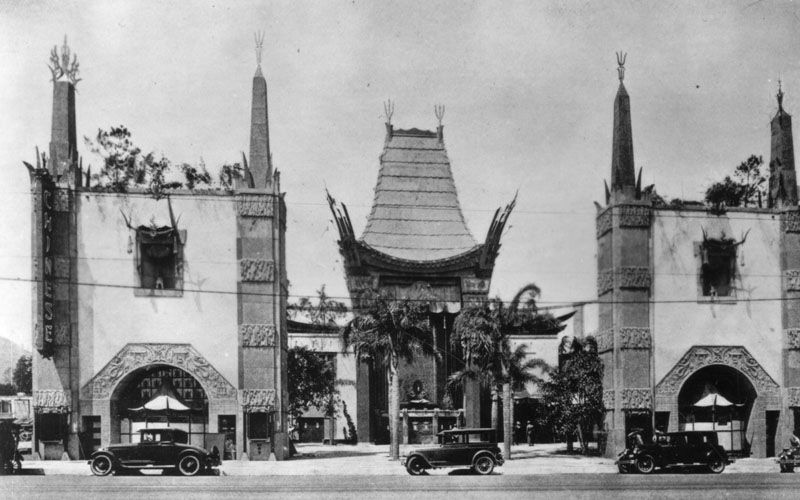 |
|
| (1927)* - View showing Grauman's Chinese Theatre on Hollywood Boulevard shortly after it opened. |
Historical Notes Grauman's Chinese Theatre opened in May 18, 1927, after a construction period of 18 months. Built to resemble a giant, red Chinese pagoda, the architecture features a huge Chinese dragon across the front, two stone lion-dogs guarding the main entrance, and the silhouettes of tiny dragons up and down the sides of the copper roof. |
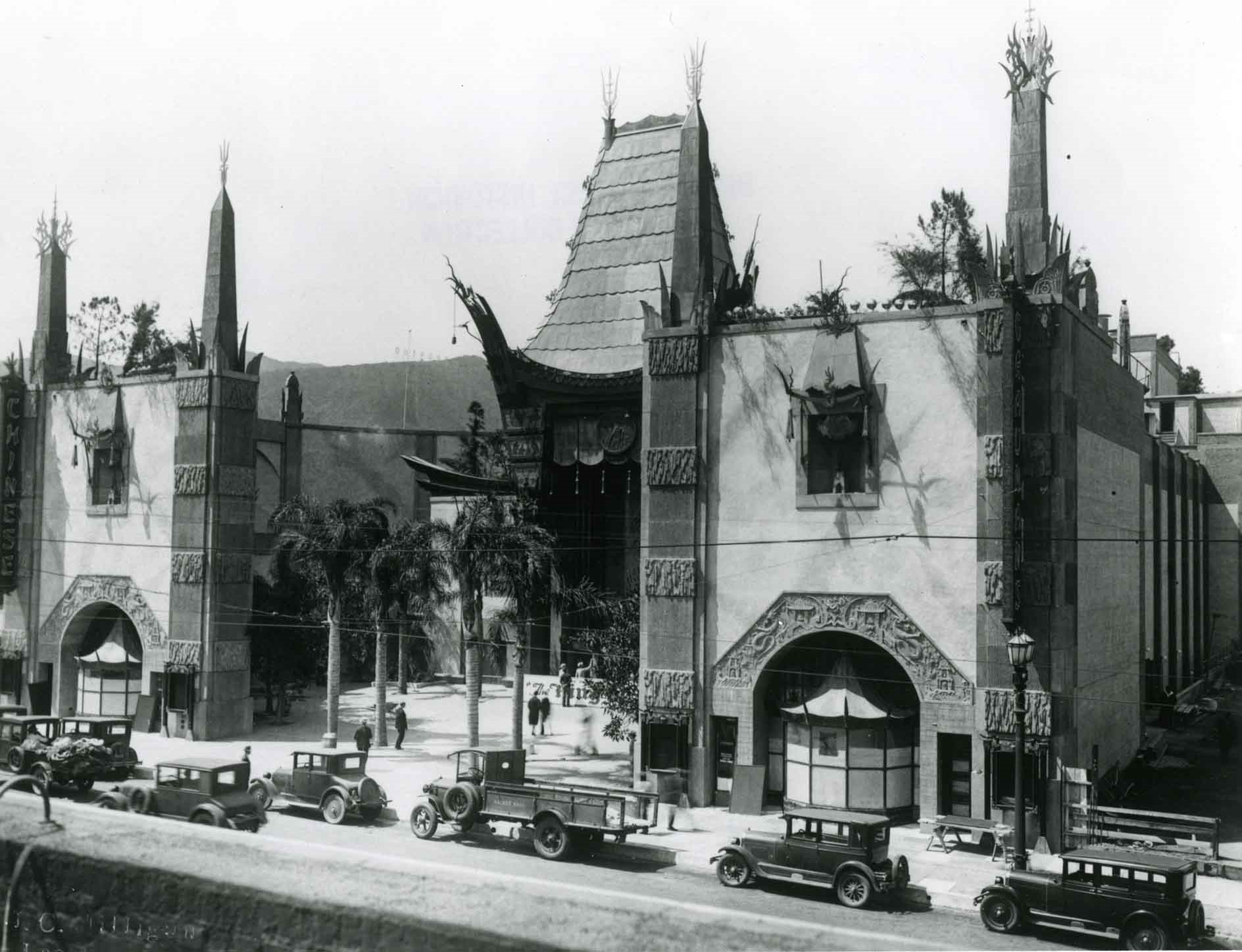 |
|
| (1927)* - View of Grauman's Chinese Theatre the year it opened, with its one-of-a-kind grandeur and décor. |
Historical Notes The theatre rises 90-feet high and two gigantic coral red columns topped by wrought iron masks hold aloft the bronze roof. Between the columns is a 30-foot high dragon carved from stone. Guarding the theatre entrance to this day are the two original giant Heaven Dogs brought from China. The large gong, above the entrance, near the roof, would ring just before the movie would start. |
 |
|
| (1927)* – Close-up view of the entrance to Grauman’s Chinese Theatre shortly after its construction. Notice there are no footprints except near the curb. Although several accounts exist regarding how the tradition began, the most widely accepted story involves silent film star Norma Talmadge accidentally stepping into wet cement while visiting her friend Sid Grauman. Inspired by this imprint, Grauman saw an opportunity to create a unique promotional feature for his theater. He invited his friends and business partners, Douglas Fairbanks and Mary Pickford, to intentionally leave their handprints and footprints in the wet cement—and the rest is history. |
Historical Notes The tradition of celebrity footprints and handprints in front of the Chinese Theatre in Hollywood began in 1927, shortly after the theater's construction. While there are several accounts of how it started, the most widely accepted story involves silent film star Norma Talmadge accidentally stepping into wet cement while visiting her friend Sid Grauman at his newly built theater. Inspired by this accidental imprint, Grauman saw an opportunity to create a unique promotional feature for his theater. He invited his friends and business partners, Douglas Fairbanks and Mary Pickford, to intentionally leave their hand and footprints in the wet cement. Grauman himself also added his prints, creating the first set of celebrity imprints in what would become known as the "Forecourt of the Stars." Alternative accounts exist, including one where Grauman claimed he accidentally stepped in wet concrete himself, giving him the idea. Another version suggests that the original "accidental" slabs were initially made at the curb on the sidewalk and remained there until 1958 when they were removed to make way for the Hollywood Walk of Fame. |
 |
|
| (1927)* - Night view shows theater lights and throngs of fans packing the streets for blocks around Grauman's Chinese Theatre. Publicity of Hollywood premiers usually brought stars and other distinguished visitors to magnificent events such as the one seen here - possibly the opening night of a movie starring Douglas Fairbanks. |
Historical Notes After his success with the Egyptian Theatre, Sid Grauman turned to Charles E. Toberman to secure a long term lease on property at 6925 Hollywood Blvd. Toberman contracted the architectural firm of Meyer & Holler (who had also designed the Egyptian) to design a "palace type theatre" of Chinese design. Grauman's Chinese Theatre was financed by Grauman, who owned a one-third interest, and his partners: Mary Pickford, Douglas Fairbanks, and Howard Schenck. The principal architect of the Chinese Theatre was Raymond M. Kennedy, of Meyer and Holler. |
 |
|
| (1933)* - Crowd at premiere of Fox Film's "Cavalcade", Grauman's Chinese Theater, Hollywood, CA, 1/12/1933. |
Historical Notes Cavalcade is a 1933 American epic pre-Code drama film directed by Frank Lloyd. The screenplay by Reginald Berkeley and Sonya Levien is based on the 1931 play of the same title by Noël Coward. The film stars Diana Wynyard and Clive Brook. |
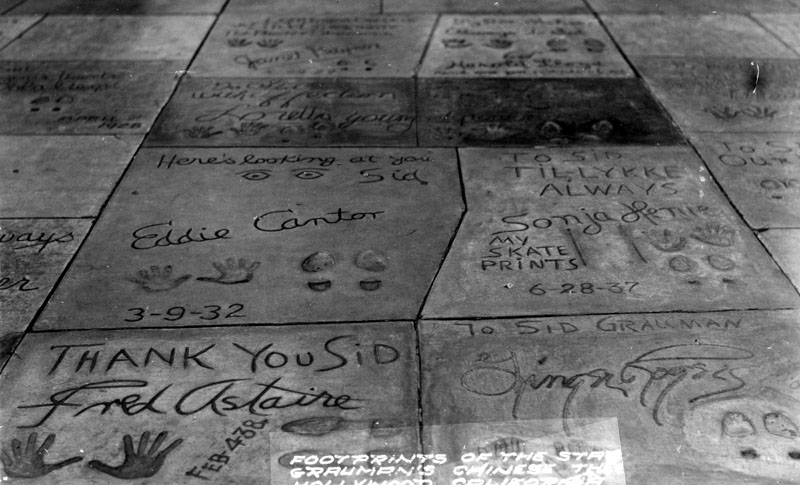 |
|
| (ca. 1930s)* - Footprints of the stars at Grauman's Chinese Theater in Hollywood. |
Historical Notes During construction, Grauman hired Jean Klossner to formulate an extremely hard concrete for the forecourt of the theatre. Klossner later became known as "Mr. Footprint," performing the footprint ceremonies from 1927 through 1957. |
 |
|
| (1927)* - View of Douglas Fairbanks putting his shoe print in the fresh concrete in front of the Grauman's Chinese Theater. Mary Pickford is by his side. |
Historical Notes Douglas Fairbanks and Mary Pickford were the inaugural celebrities to put their feet and handprints into fresh concrete at Grauman's Chinese Theater on April 30, 1927. This picture shows the two stars, exhibitor Sid Grauman, a workman, and how the event was apparently not open to the public. |
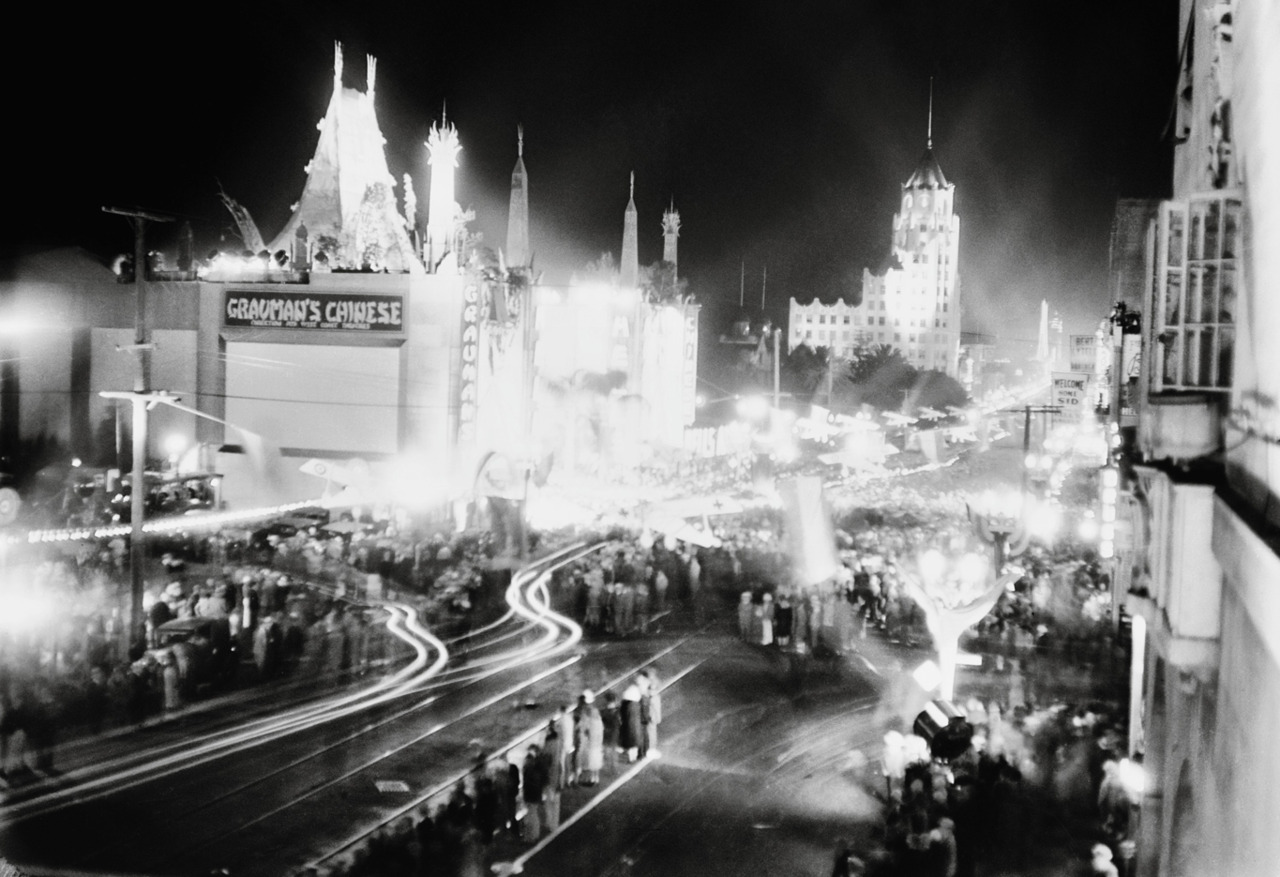 |
|
| (1930)* - The premiere of “Hell’s Angels” at Grauman’s Chinese Theatre in Hollywood as seen from the Roosevelt Hotel across the street. |
Historical Notes Hell's Angels is a 1930 American war film, directed by Howard Hughes and starring Jean Harlow, Ben Lyon, and James Hall. The film, which was produced by Hughes and written by Harry Behn and Howard Estabrook, centers on the combat pilots of World War I. Originally shot as a silent film, Hughes retooled the film over a lengthy gestation period. Most of the film is in black and white, but there is one color sequence - the only color footage of Harlow's career. Hell's Angels is now hailed as one of the first sound blockbuster action films. |
 |
|
| (1930)* - Street view of the Grauman's Chinese Theatre where the film "Hell's Angels" is playing. |
Historical Notes Producer/director Howard Hughes poured nearly $4 million into his production of “Hell’s Angels” so he wanted to make sure everybody knew about it. On May 24, 1930 he threw a premiere the likes of which Hollywood had never seen before. And for the movie’s run at Grauman's Chinese Theatre, he had the title emblazoned on the columns, just in case, you know, there was anyone left who hadn’t heard of his movie. |
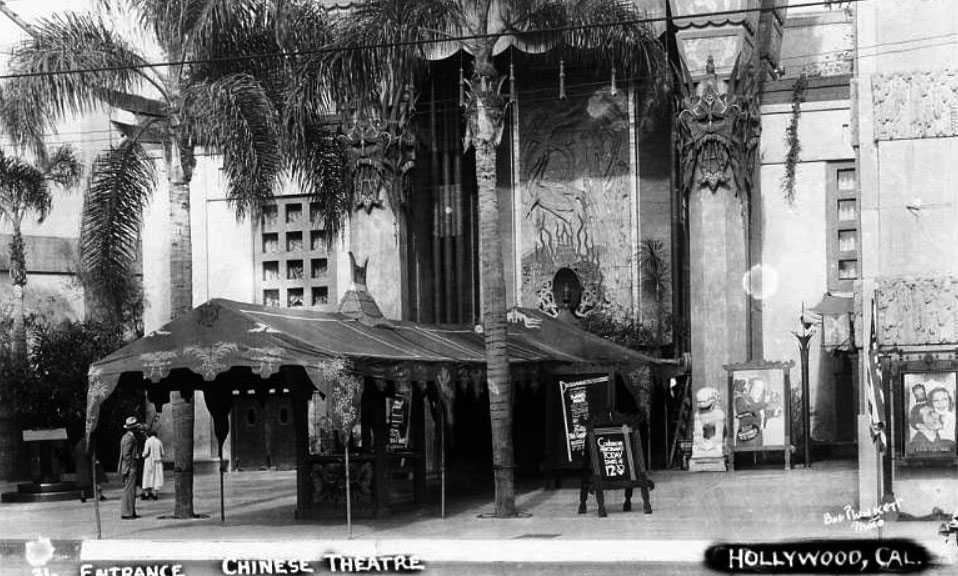 |
|
| (1934)* – Close-up postcard view showng the entrance to the Chinese Theatre with the box office installed in the forecourt. Now Playing: "The White Parade" with Loretta Young and John Boles |
Historical Notes Between 1933 and 1949 the Grauman's Chinese Theatre was in a "Golden Age," where the movies were the number-one entertainment in America, resulting in the studios who made them becoming very profitable. Grauman's Chinese, the glamourous flagship venue of the Fox West Coast Theatres chain (itself owned by 20th Century-Fox and the Skouras Brothers) and under the continuing management of Sid Grauman, played host to a large number of Fox films, rotating with product from Metro-Goldwyn-Mayer and the occasional offering from United Artists. Theatres during this time tended to play pictures from the studio who owned them (or had strong business ties to). |
 |
|
| (ca. 1940s)* - View of Grauman's Chinese Theatre, located at 6925 Hollywood Blvd., as seen from across the street. It is one of Hollywood's most beautiful theaters. |
Historical Notes All remained well until, after World War II, film attendance dropped off, then another blow: television. However, in the long run Hollywood found ways of making motion picture entertainment more attractive. People would once again return to the box office and pay admissions to see motion pictures instead of remaining home before their television sets. |
 |
|
| (1944)* – View of the Grauman's Chinese Theatre just prior to the 16th Annual Academy Awards of Merit ceremony, Thursday, March 2, 1944. |
Historical Notes Originally handed out at a formal banquet at either the Ambassador Hotel in the Cocoanut Grove or Fiesta Room, or at the Biltmore Hotel downtown, in the Sala D'Oro or Biltmore Bowl, the enormity of interest in the Oscars outgrew the formal banquet idea. When it came time to hold the ceremony in a regular theatre environment, Grauman's Chinese was the obvious choice. Widely considered Hollywood's "town hall," for the first ceremony held there on Thursday, March 2, 1944, the theatre was donated for the event by Charles Skouras, president of National Theatres, whose Fox West Coast Theatres division operated the Chinese, with Sid Grauman as the theatre's Managing Director. |
 |
|
| (1946)* - Stars arrive at Grauman's Chinese Theater for the Academy Awards presentation on March 8, 1946. |
Historical Notes This was the year that “Lost Weekend” won Best Picture, Best Director, Best Actor in a Leading Role, and Best Screenplay. If these people were hoping to see Joan Crawford, they were disappointed. She was so freaked out at the thought of losing that she pretended to be ill—and then won the Oscar for “Mildred Pierce.” |
.jpg) |
|
| (1946)* – Thousands of movie fans crowded the front of Grauman's Chinese Theater in which the Academy Awards presentation was held. This is a section of the huge crowd as they watched the parade of stars arriving at the theater on March 8, 1946. |
Historical Notes National Theatres continued to make the Chinese Theatre available to the Academy for their Awards of Merit program at no cost, in 1944, 1945 and 1946. In short time the ceremony had outgrown even Sid's Hollywood masterwork, so it moved to the 6,000 plus-seat Shrine Auditorium near downtown for 1947 and 1948. |
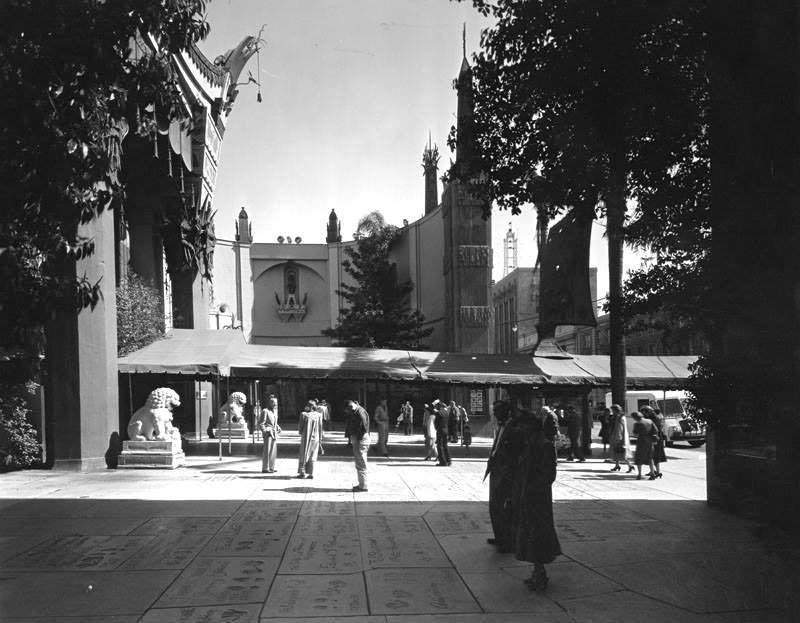 |
|
| (1950s)* – View showing the forecourt of Grauman’s Chinese Theatre where visitors are trying to find the footprints of their favorite star and marvel at how small their handprints were. Guarding the theatre entrance to this day are the two original giant Heaven Dogs brought from China. |
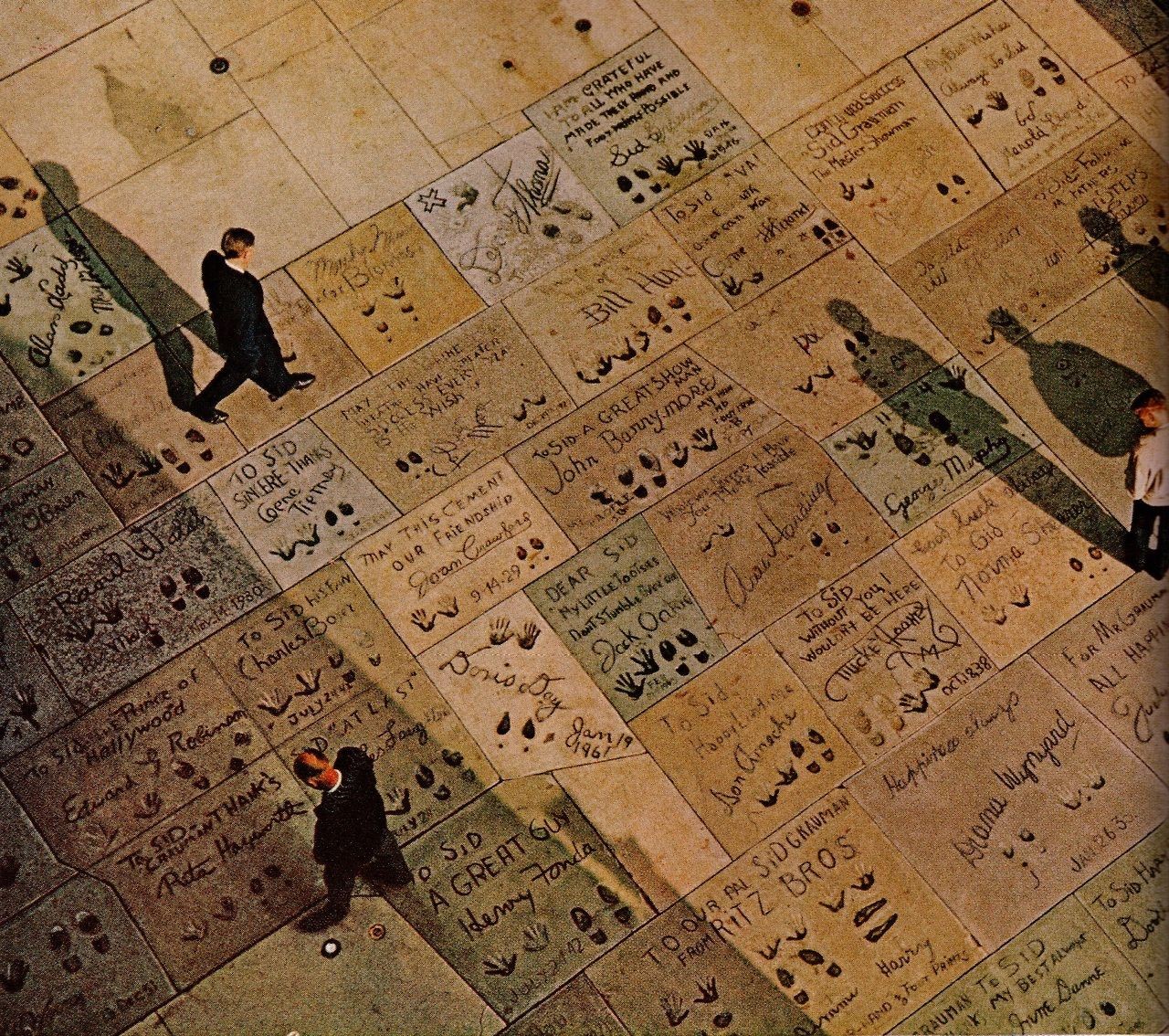 |
|
| (1962)* – Tourists admire the preserved footprints, handprints, and signatures of past movie stars on the concrete forecourt of Grauman’s Chinese Theatre. Photo Source: National Geographic. |
 |
|
| (1964)* - View of the Grauman's Chinese Theatre (now TLC Chinese Theatre) on Hollywood Boulevard, showing Walt Disney's Mary Poppins. |
Historical Notes Mary Poppins was released on August 27, 1964, to critical acclaim and commercial success. It became the highest-grossing film of 1964 and, at the time of its release, was Disney's highest-grossing film ever. It received a total of 13 Academy Awards nominations, including Best Picture – a record for any film released by Walt Disney Studios – and won five: Best Actress for Andrews, Best Film Editing, Best Original Music Score, Best Visual Effects, and Best Original Song for "Chim Chim Cher-ee". In 2013, the film was selected for preservation in the United States National Film Registry by the Library of Congress as being "culturally, historically, or aesthetically significant". Mary Poppins is considered Walt Disney's crowning live-action achievement, and is the only one of his films which earned a Best Picture nomination during his lifetime. |
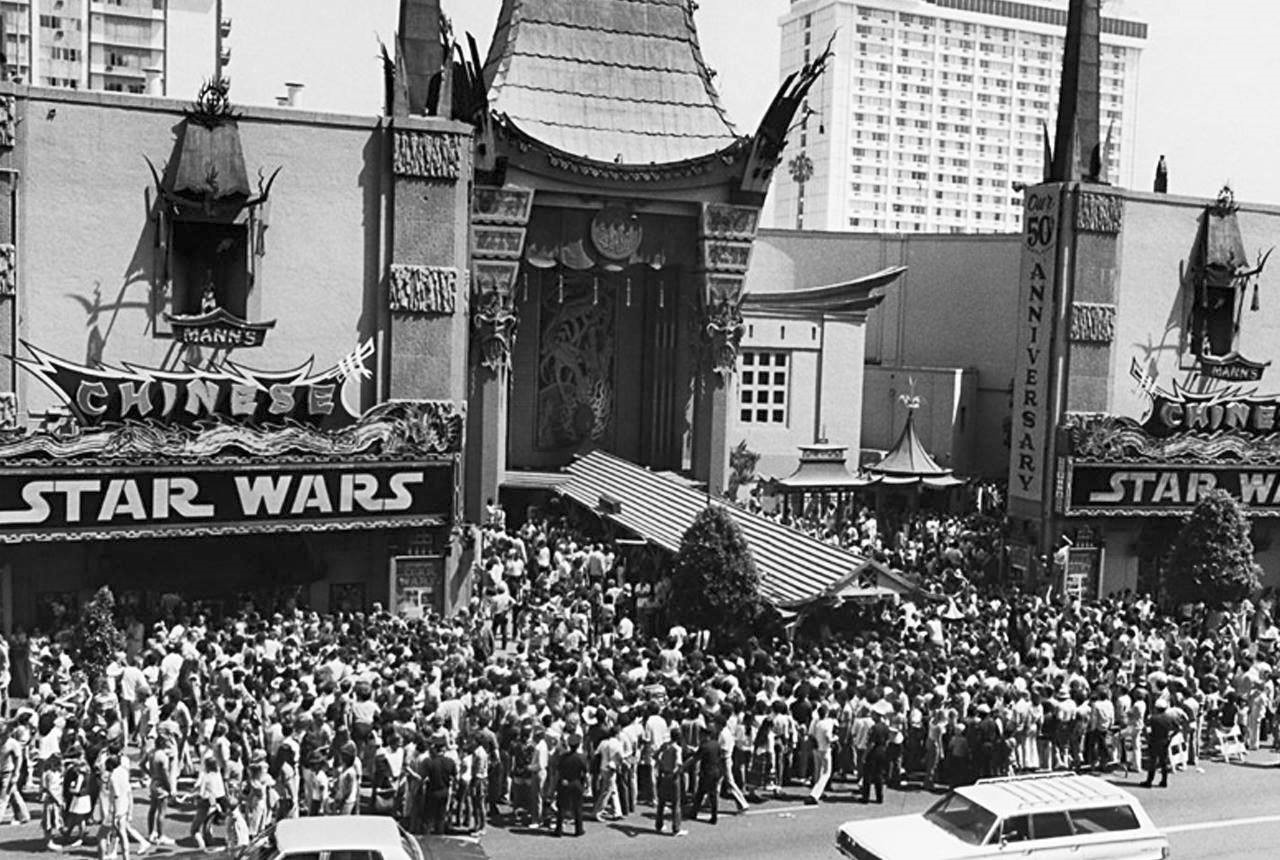 |
|
| (1977)* – Crowds gather in front of Grauman’s Chinese Theatre to get a glimpse of their favorite stars at the Star Wars preview. LA Times Archive |
Historical Notes Star Wars is an American epic space opera media franchise created by George Lucas, which began with the eponymous 1977 film and quickly became a worldwide pop-culture phenomenon. The franchise has been expanded into various films and other media, including television series, video games, novels, comic books, theme park attractions, and themed areas, comprising an all-encompassing fictional universe. The franchise holds a Guinness World Records title for the "Most successful film merchandising franchise." In 2020, the Star Wars franchise's total value was estimated at US$70 billion, and it is currently the fifth-highest-grossing media franchise of all time. |
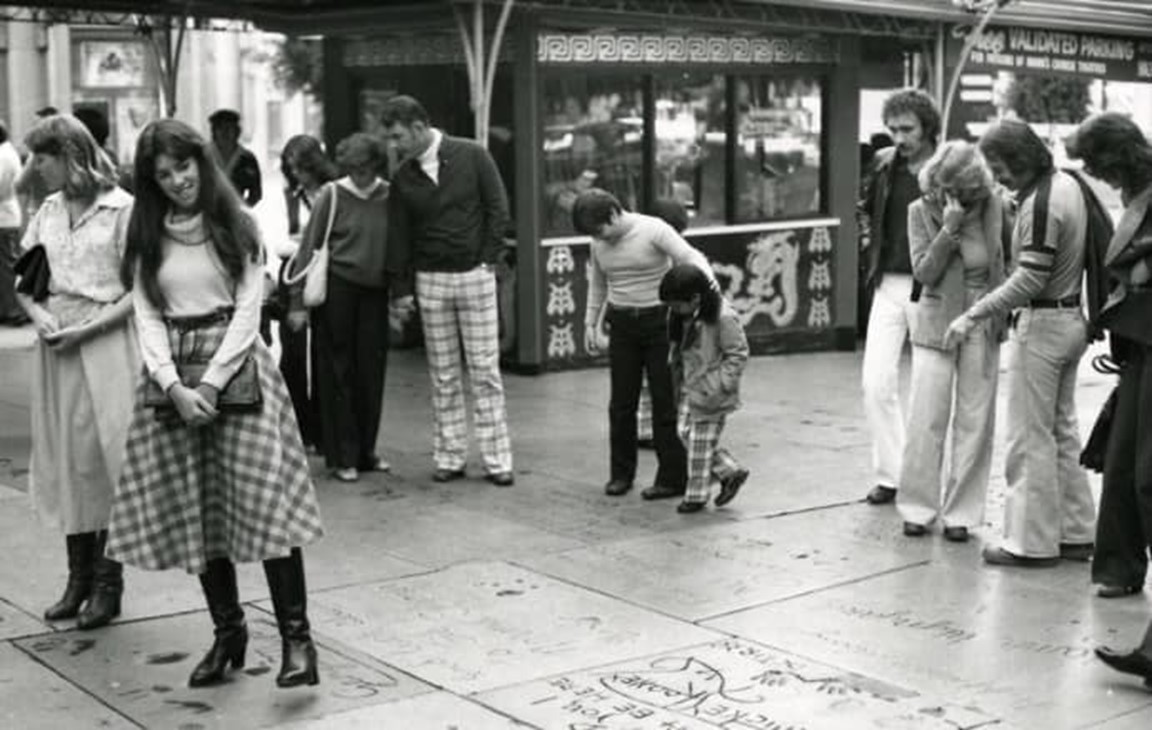 |
|
| (1985)* - Tourists looking at the hands and footprint impressions in the courtyard of the Chinese Theatre in Hollywood. |
Historical Notes While many of the late 20th and early 21st century imprints bear only the owners’ signatures, a number of the older slabs feature messages to “Sid” (Grauman). |
 |
|
| (2020)* - Exterior detail view of TCL Chinese Theatre after renovation. Photo by Howard Gray |
Historical Notes The theatre underwent a $7 million renovation in 2000-01 that upgraded amenities, uncovered long-obscured details, and restored the exterior to its original appearance. Now known as TCL Chinese Theatre, the building underwent another renovation in 2013 to provide first-run IMAX capabilities. |
 |
|
| (2014)* - Front view of the TCL Chinese Theatre on Hollywood Boulevard as it appears today. Photo by David McNew / CBS |
Historical Notes In 1968, Grauman's Chinese Theatre was dedicated LA Historic-Cultural Monument No. 55 (Click HERE to see complete listing). In 2013, the world famous Chinese Theatre teamed up with one of China’s biggest electronics manufacturers, TCL, aka “The Creative Life” in a 10-year naming rights partnership. |
Then and Now
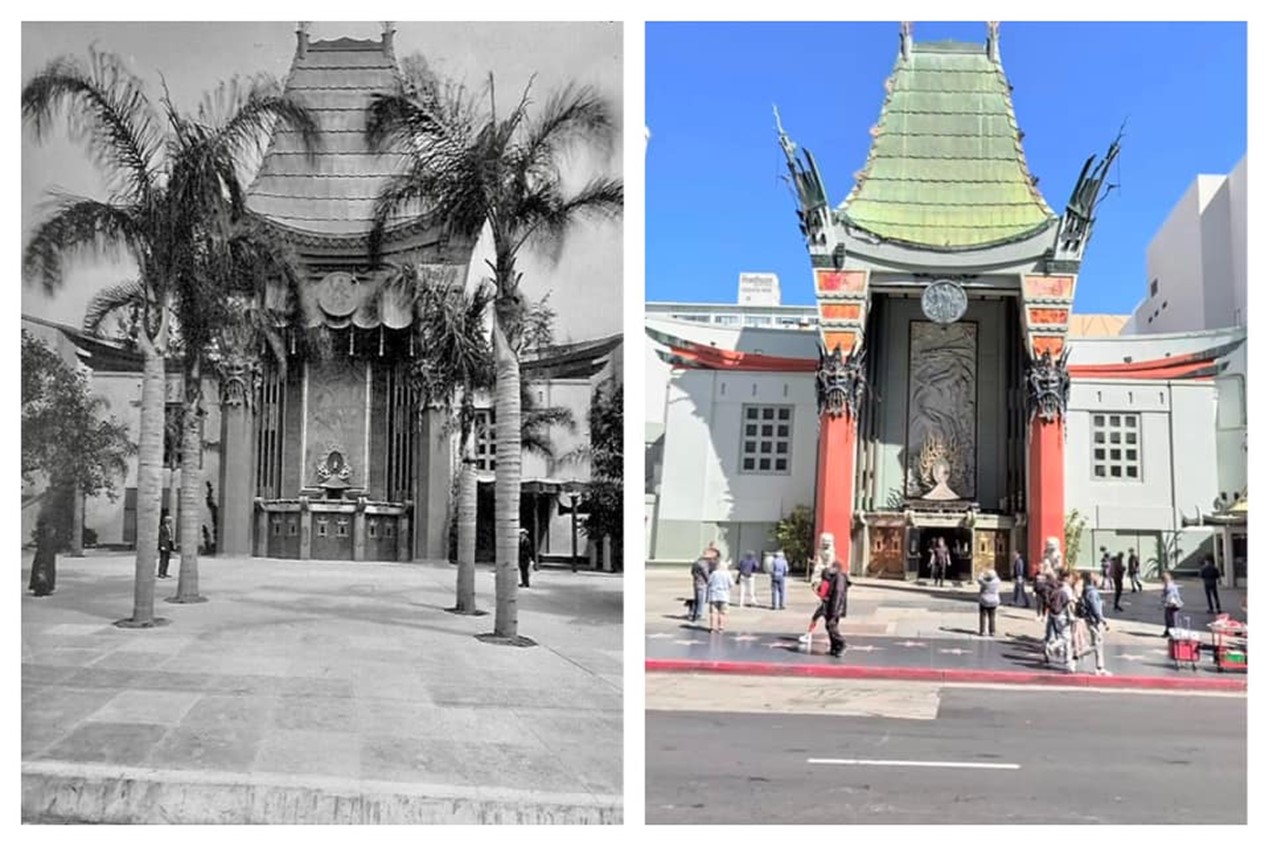 |
|
| (1927 vs 2024)* - Then and Now - Photo comparison by Trey Callaway |
Then and Now
 |
|
| Then and Now - Over 95 years old and well preserved. |
* * * * * |
Hollywood Bowl's First Shell
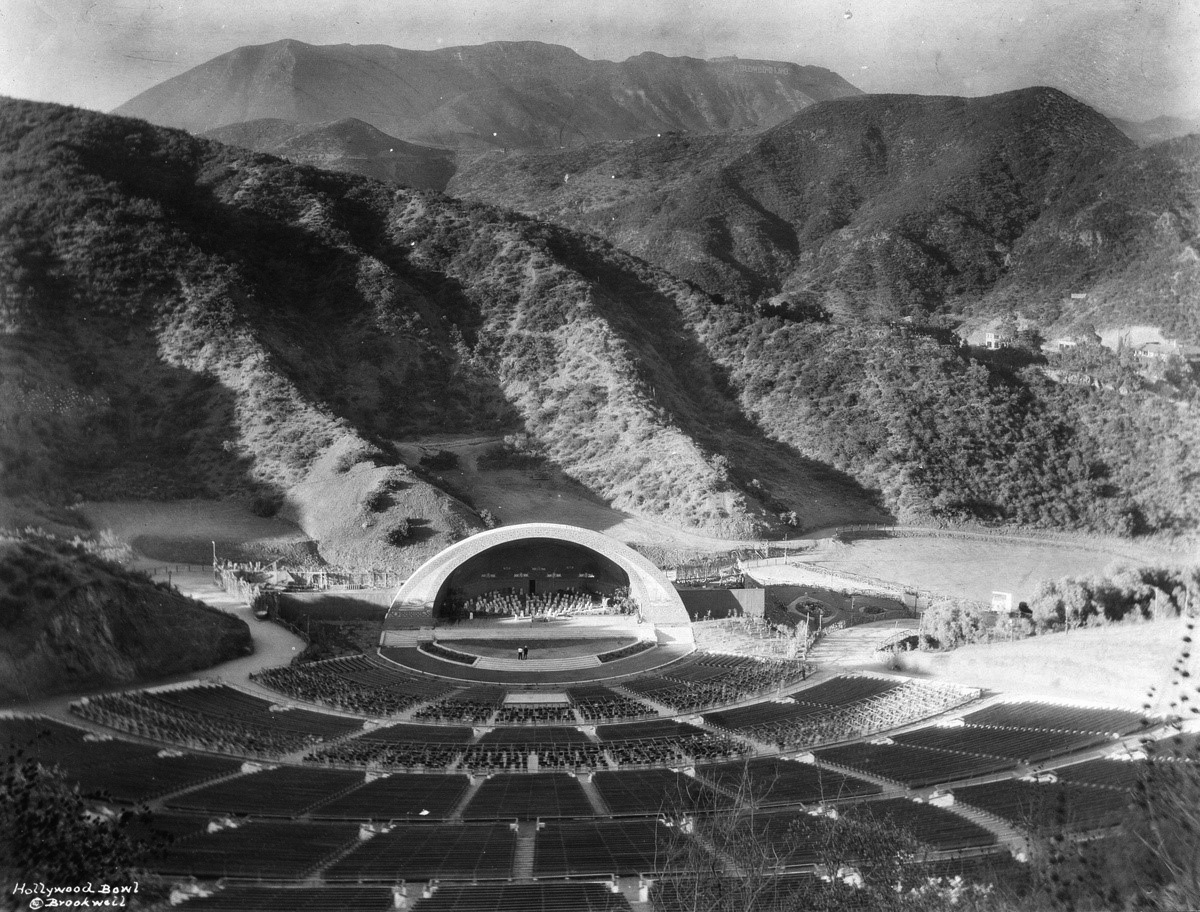 |
|
| (1926)* - The Hollywood Bowl's first shell shortly after its completion. View is from the top of the seating area looking down towards the stage. |
Historical Notes In 1926, the first rendition of the venue’s iconic proscenium shell was built. The original shell was deemed acoustically unsatisfactory (as well as visually unfashionable, with its murals of sailing ships). It would be torn down at the end of the season. Pasadena architect and Rose Bowl designer Myron Hunt created the elliptical form for the Hollywood Bowl's seating amphitheater. His layout featured monumental stairways that reinforced the seating area's dramatic balloon shape, which was described as being "poised to fill with music and ascend." |
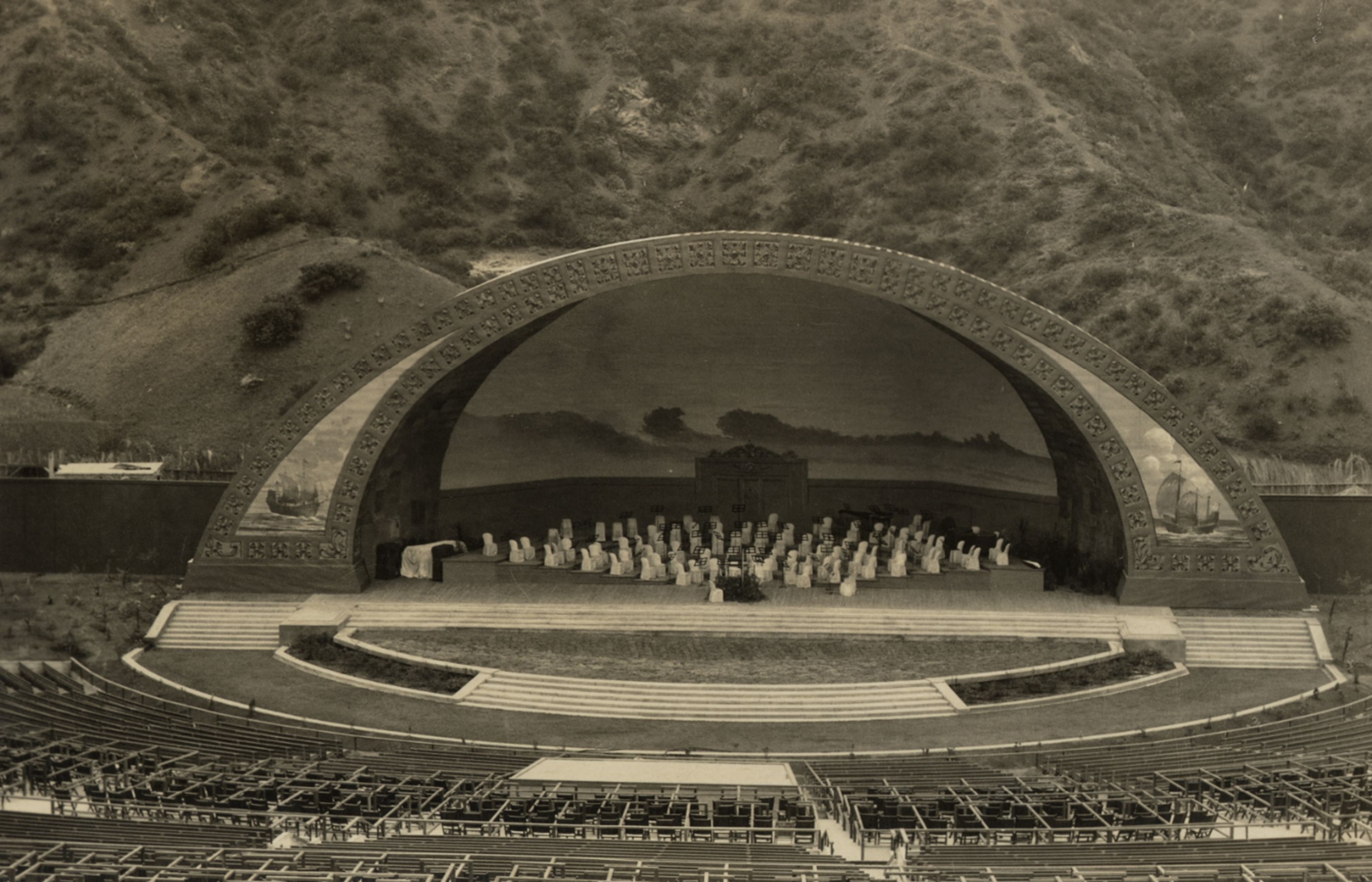 |
|
| (1926)* - The Hollywood Bowl's first shell designed by the Allied Architects Association |
Historical Notes The Hollywood Bowl's first shell designed by the Allied Architects Association was a semi-elliptical structure that aimed to preserve the view of the hillside behind it. However, it inadvertently blocked the natural resonance of the canyon, making it difficult for audiences to hear the music clearly. As a result, this initial shell only lasted for one season before being replaced. |
 |
|
| (1926)* - Close-up view showing the original Hollywood Bowl Shell. |
Historical Notes The acoustics of the first Hollywood Bowl shell, installed in 1926, were considered poor. This shell, designed by the Allied Architects Association, was deemed unacceptable both visually and acoustically. As a result, it was quickly replaced. |
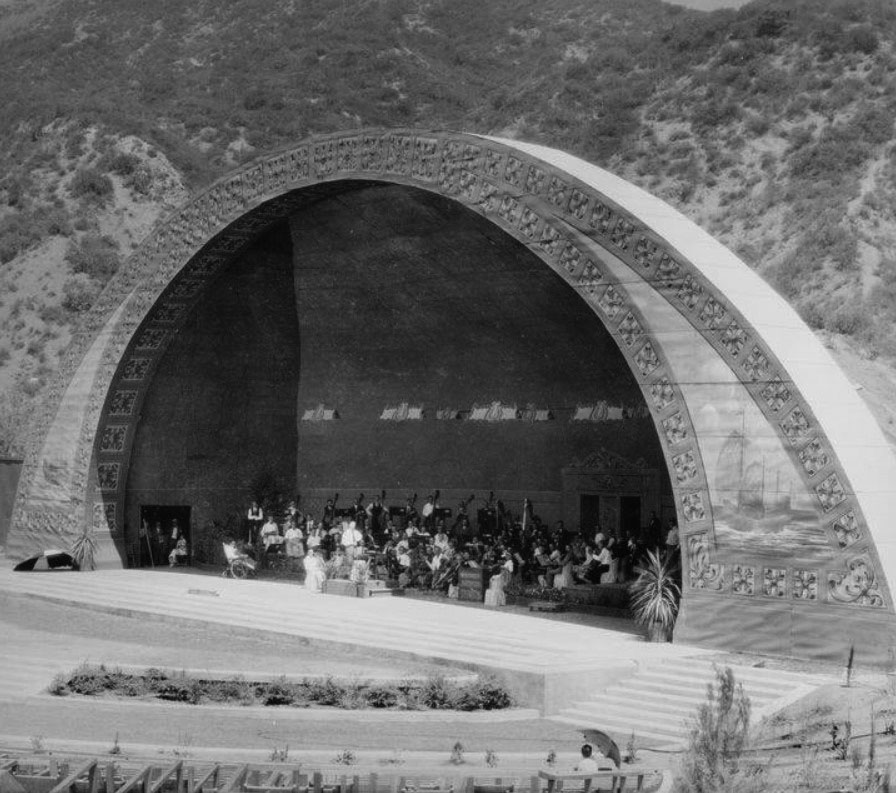 |
|
| (1926)* – Close-up view showing Hollywood Bowl’s first shell shortly after it was completed. Note the mural and designs on the front face of bowl. |
Historical Notes Before the installation of this first shell, performers at the Hollywood Bowl played in the open air on wooden platforms with canvas coverings. The introduction of the shell marked a significant change in the venue's appearance and functionality. |
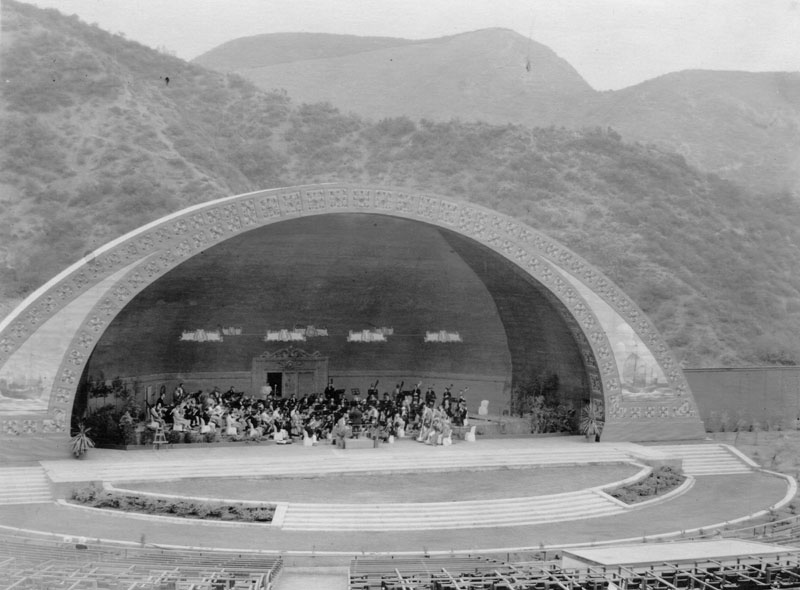 |
|
| (1926)* - Orchestra practicing at the Hollywood Bowl with its new Allied Architects Association designed shell. |
Historical Notes Both Myron Hunt and Allied Architects played important roles in the Hollywood Bowl's development, but for different aspects: Myron Hunt designed the Hollywood Bowl's amphitheater in 1926, creating the elliptical, terraced seating area that is still in use today15. Allied Architects, a separate entity, was responsible for designing and building the iconic shell structure. |
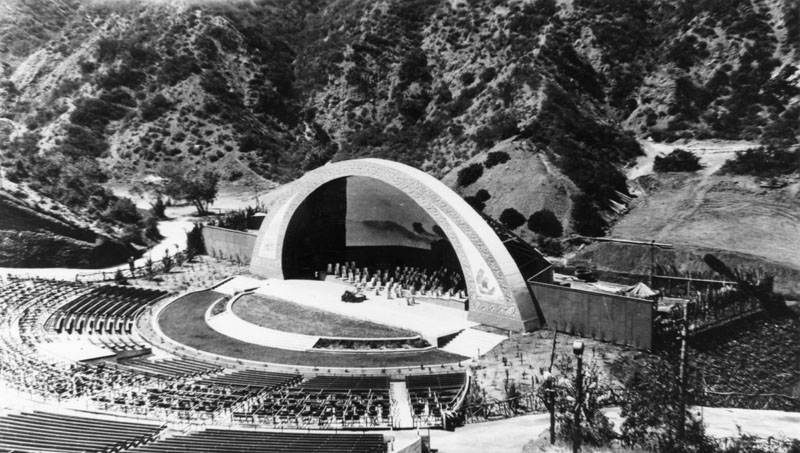 |
|
| (1926)* - Another view of the Hollywood Bowl's new shell. |
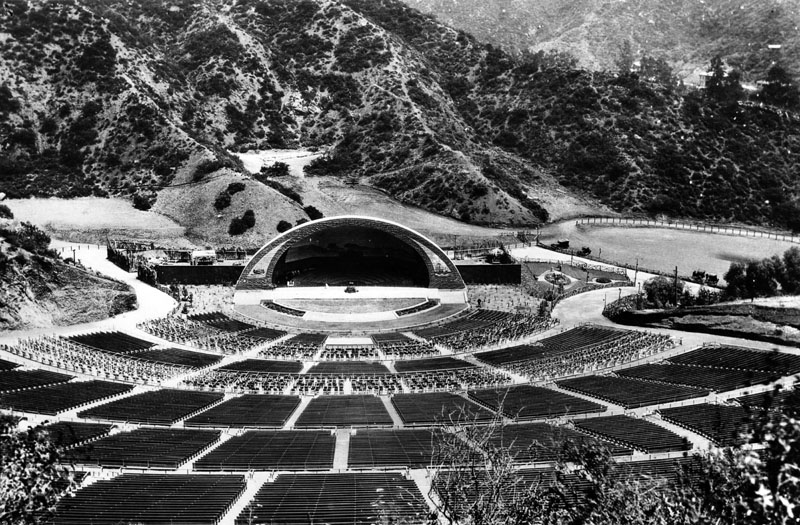 |
|
| (1926)* - View is looking from the top of the hill towards the seating and inner shell of the Hollywood Bowl. |
Historical Notes The 1926 shell was replaced in 1927 with a new design by Lloyd Wright (son of Frank Lloyd Wright). Click HERE to see more in Early Views of the Hollywood Bowl |
* * * * * |
Shrine Auditorium
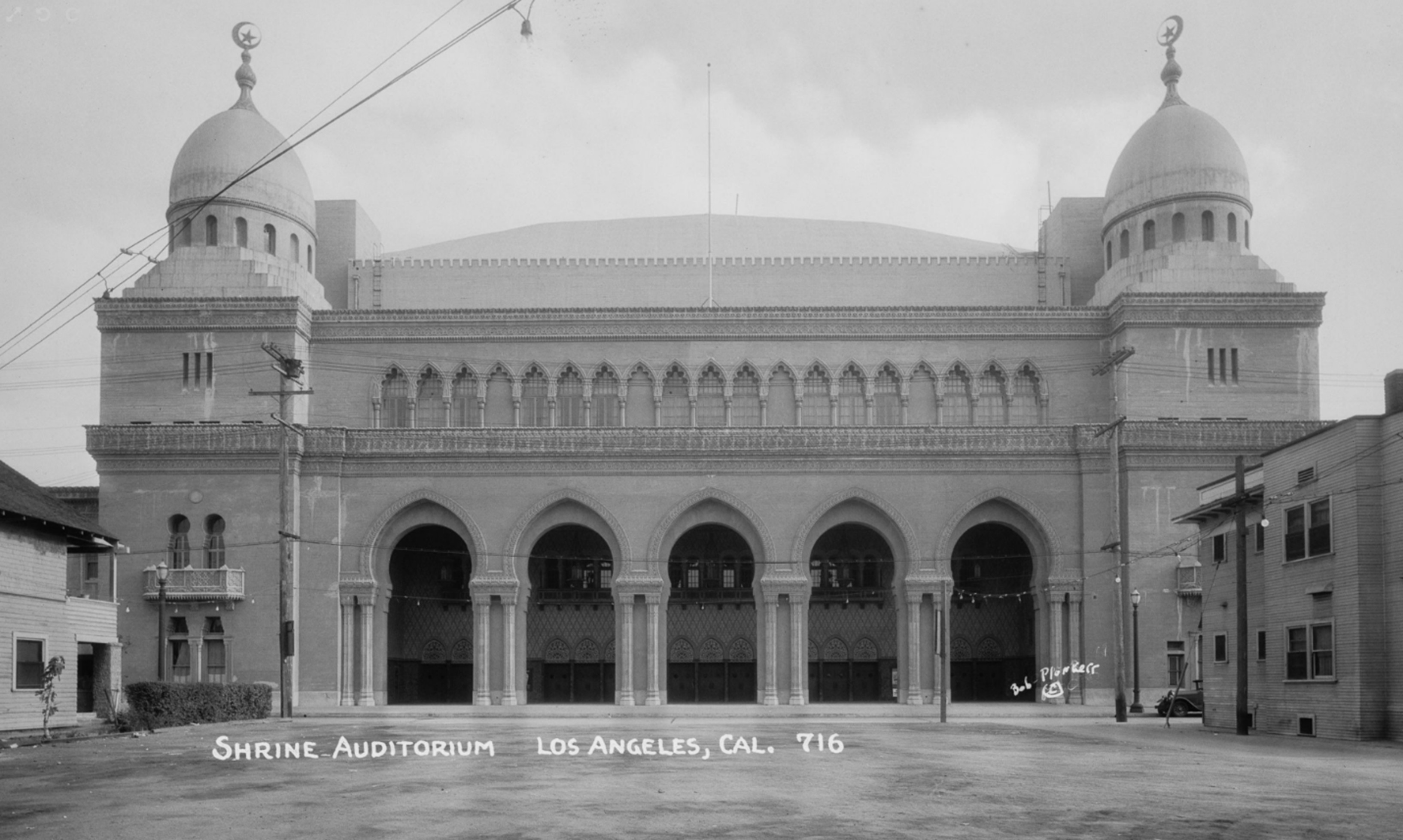 |
|
| (1926)* – View of the newly opened Shrine Auditorium at 665 W. Jefferson Boulevard, looking east from the parking lot across Royal Street. Designed by G. Albert Lansburgh in the Moorish Revival style, the Shrine quickly became a major Los Angeles landmark. (Photo: Bob Plunkett) |
Historical Notes The Shrine Auditorium opened in 1926 as the new headquarters for the Al Malaikah Temple, a division of the Shriners, following the destruction of their original 1906 building by fire in 1920. Designed in the Moorish Revival style by architect G. Albert Lansburgh, with assistance from local architects John C. Austin and A. M. Edelman, the new structure was notable for its grand scale and ornate design. At its opening, the Shrine was the largest theater in the United States, seating over 6,700 people and featuring the largest proscenium arch stage in North America. |
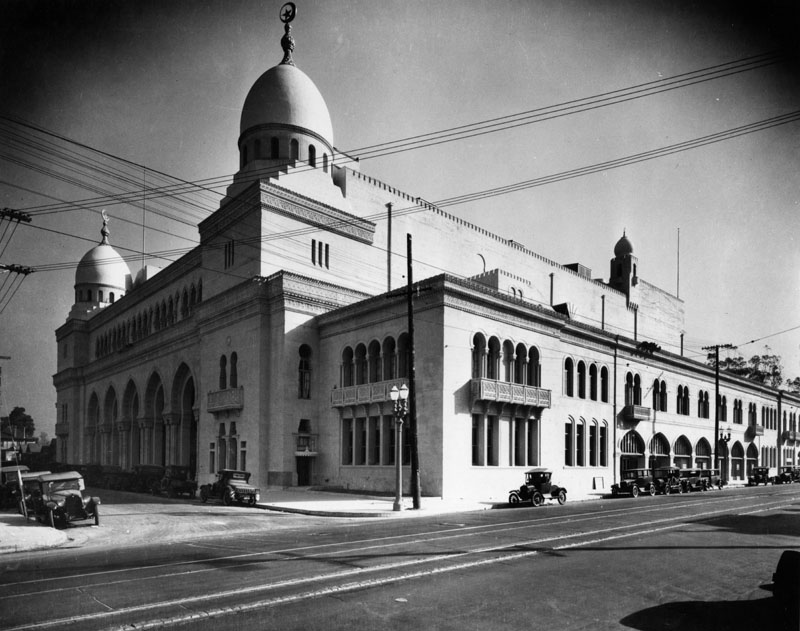 |
|
| (1926)* - Exterior view of the Shrine Auditorium shortly after it was rebuilt in 1926. It is located at 655 West Jefferson Boulevard in the University Park district of Los Angeles. |
Historical Notes Opened in 1926, the current Shrine Auditorium replaced an earlier 1906 Al Malaikah Temple which had been destroyed by a fire on January 11, 1920. Click HERE to see more on the original 1906 Al Malaikah Temple. |
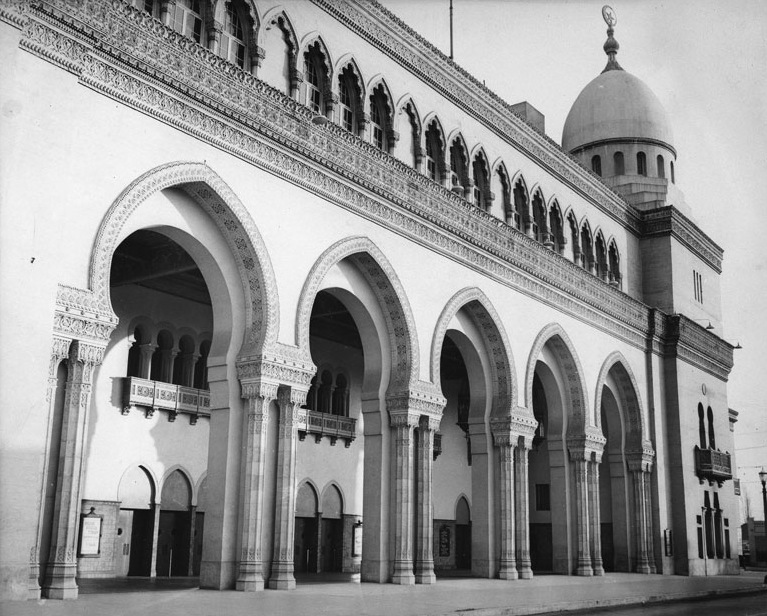 |
|
| (1926)* - Closer view of the ornate Moorish Revival design along the east façade of the newly opened Shrine Auditorium. The detailed horseshoe arches, carved moldings, and onion-shaped dome became hallmarks of this Los Angeles landmark. |
Historical Notes Architecturally, the Shrine Auditorium is distinguished by its Moorish-inspired design, with horseshoe arches, onion-shaped towers, and stained glass windows adorned with Shriners’ emblems. The complex also includes the Shrine Exposition Hall, a 54,000-square-foot multi-purpose facility used for conventions, trade shows, and large-scale events, enhancing the site's versatility as a major gathering place in Los Angeles. |
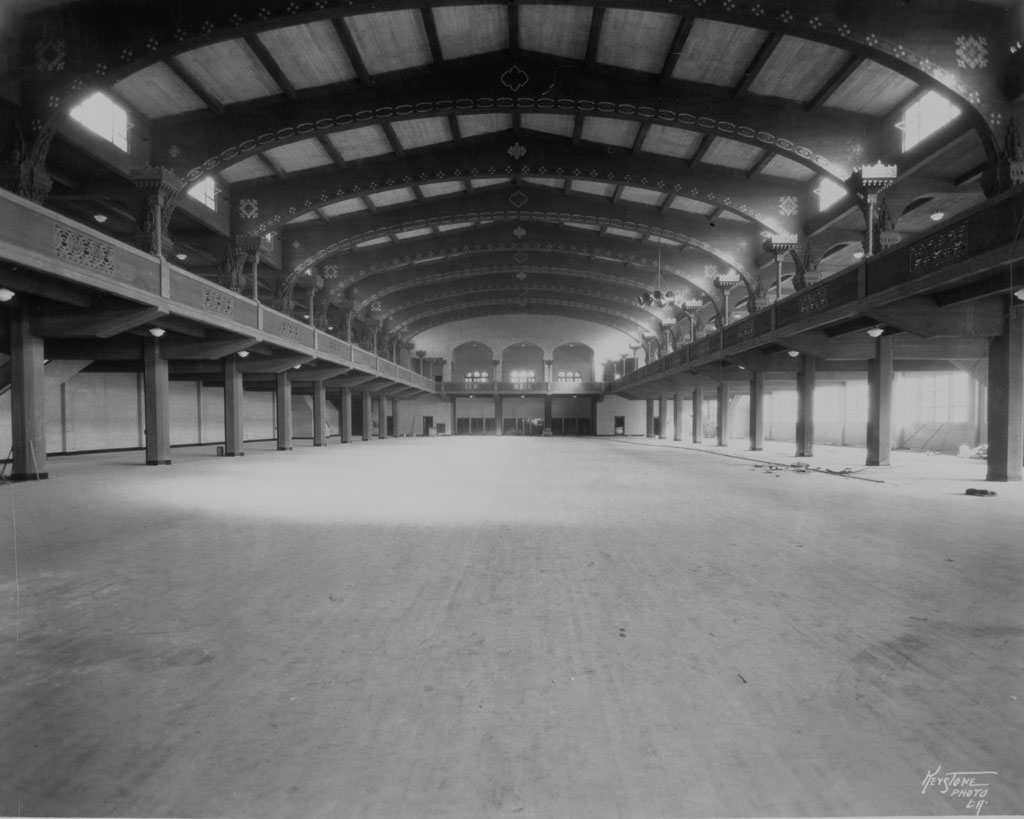 |
|
| (1926)* - View of the interior of the empty ballroom in the Shrine Auditorium, January 20, 1926. |
Historical Notes For 33 years, Shrine Auditorium was home to the University of Southern California Trojans basketball team. The Trojans' home court was on the Shrine's stage. The Los Angeles Lakers also briefly played some playoff games in the theatre, when the nearby Los Angeles Sports Arena was unavailable. |
 |
|
| (ca. 1926)* - View of the Shrine Auditorium stage from upper seats. |
Historical Notes The Shrine Auditorium’s vast interior features a proscenium-style stage—the largest of its kind in North America—accompanied by a freestanding balcony and seating for approximately 6,300 people. Designed in the Moorish Revival style, the auditorium evokes the grandeur of a double-domed Middle Eastern mosque. Two large opera boxes, each accommodating up to 40 guests, are positioned above the orchestra level. |
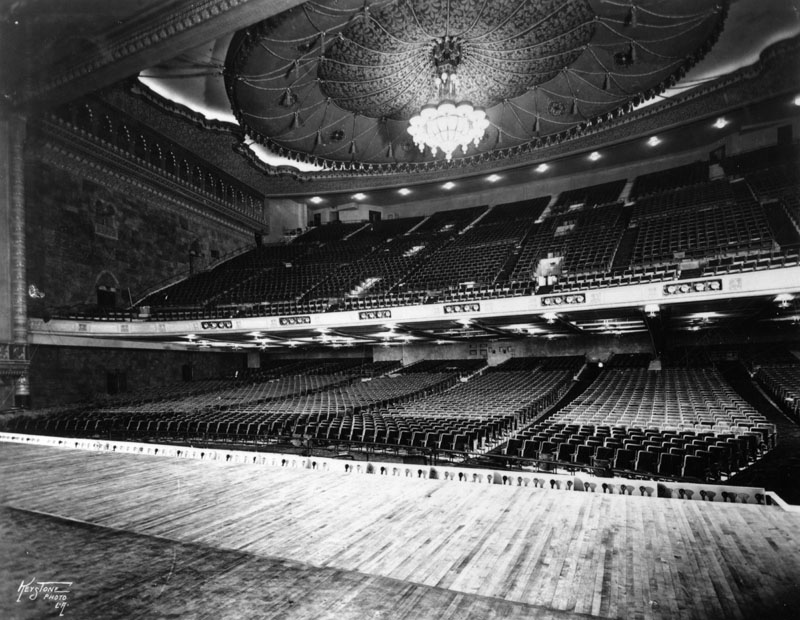 |
|
| (ca. 1926)* - View of the Shrine Auditorium from stage. Note the beautiful chandelier hanging from the ceiling. |
Historical Notes The centerpiece of the auditorium’s design is its circus tent-inspired ceiling, crafted from painted plaster to resemble billowing drapery suspended under a starry blue sky. Double cornices lead into this tent effect, which appears to hang from thick, tassel-adorned ropes. Decorative coves and multi-colored lighting along the front and side walls, as well as above the orchestra pit, add to the whimsical atmosphere. The Shrine Auditorium also houses a monumental Möller pipe organ with four manuals, 67 ranks, and 4,663 pipes, with organ grilles positioned above the opera boxes. The auditorium connects to a pavilion and service wing, containing banquet and exhibition halls, kitchens, and passageways, which originally included a caretaker’s apartment. Together, these features blend architectural spectacle and technical innovation, making the Shrine one of Los Angeles' most remarkable historic venues. |
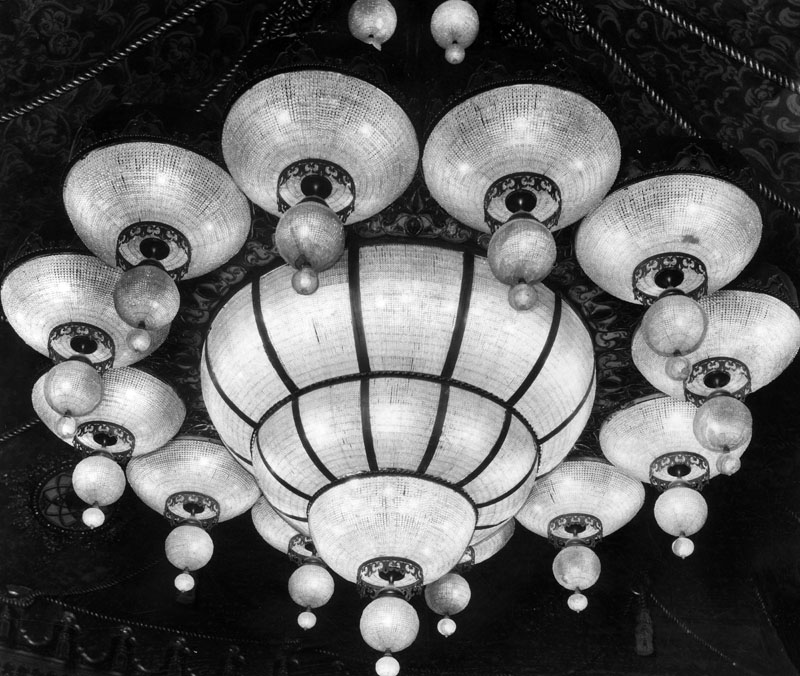 |
|
| (1926)* – Close-up view of the light fixture on the ceiling of the Shrine Auditorium. |
Historical Notes Dominating the center of the hall is a massive electric chandelier, considered the largest in the world at the time of its installation in 1926. Weighing five tons and measuring 20 feet in diameter and 28 feet in height, the chandelier originally featured over 500 colored bulbs drawing more than 48,000 watts. A smaller multi-colored crystal fixture hangs above the orchestra pit, while additional lighting is embedded throughout the ceiling and balcony panels. |
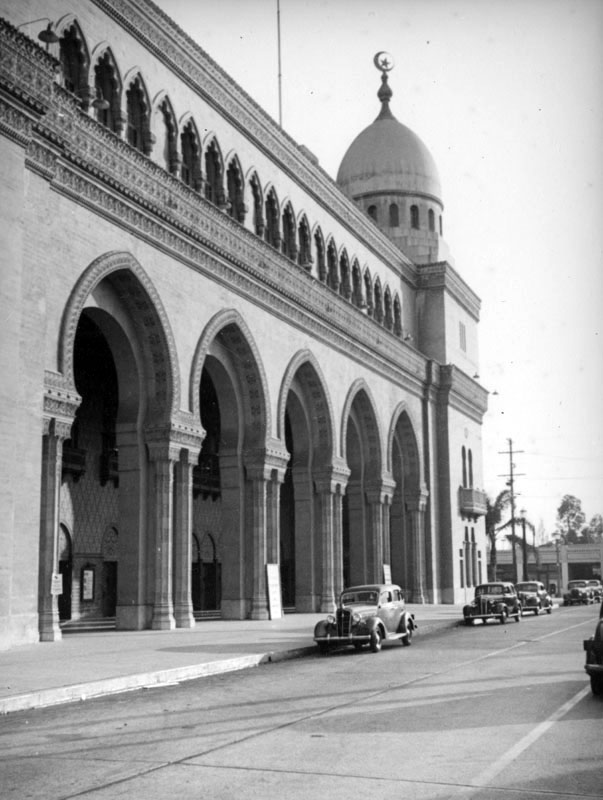 |
|
| (1937)* - Cars are parked in front of the Shrine Auditorium in this view looking south on Royal Street, which captures the arched colonnade and windows, tile walls and dome topped with the crescent and star emblem of the Shrine. |
Historical Notes From its earliest years, the Shrine became a centerpiece for major cultural and entertainment events. It hosted the Academy Awards, Grammy Awards, American Music Awards, and Screen Actors Guild Awards, among others. The venue also served as the home court for the USC Trojans basketball team from 1939 to 1972. Historic moments include Elvis Presley’s first concert at the Shrine in 1956, Michael Jackson’s 1984 Pepsi commercial accident, and world premieres for major films like Star Wars: The Last Jedi and Barbie. Briefly in the late 1920s, the Shrine even operated as the largest movie theater in Los Angeles. |
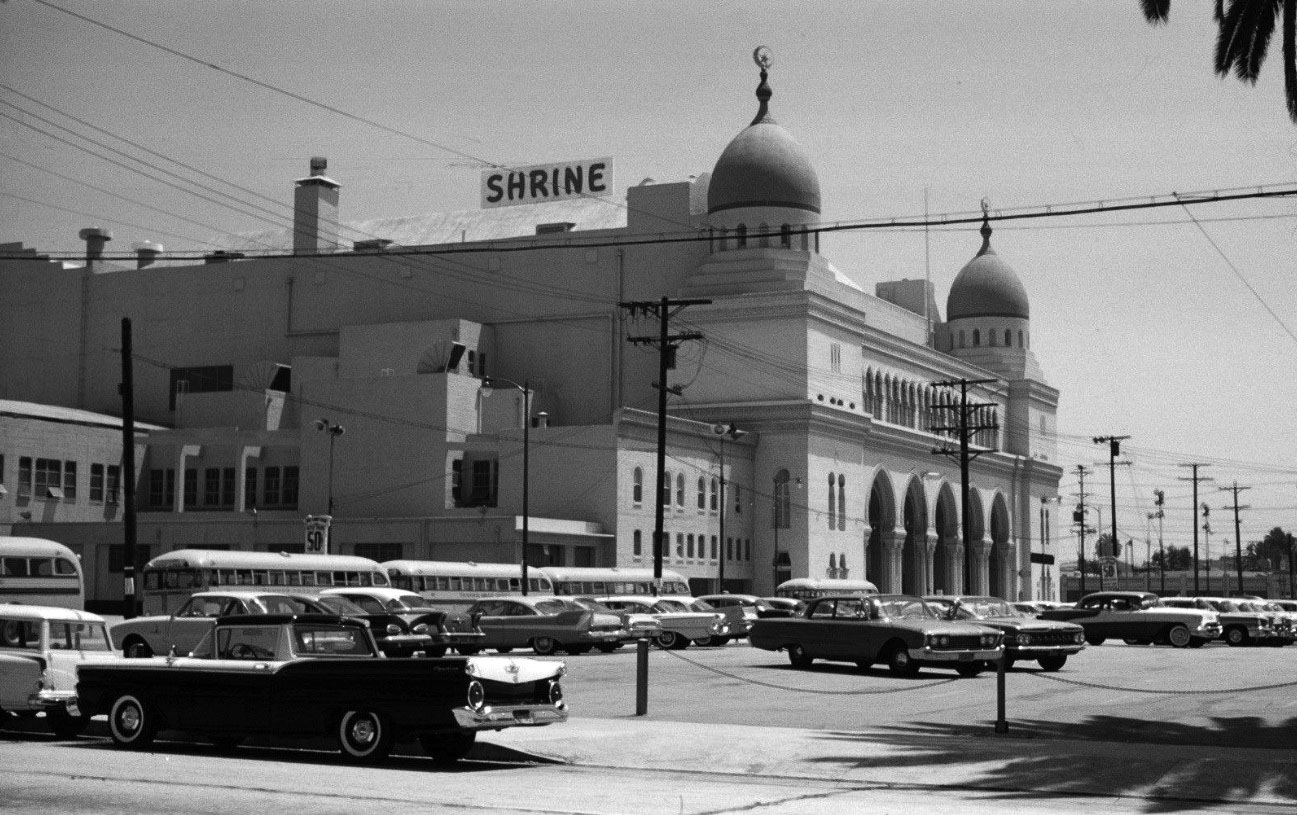 |
|
| (1960s)* – View showing the Shrine Auditorium with school buses seen parked in front. Still one of the largest theaters of its kind in North America. Photo: Vintage Los Angeles. |
Historical Notes The Shrine Auditorium has hosted a number of events, mainly for entertainment. The Academy Awards were held at the Shrine from 1947–1948 and for eight times between 1988 and 2001 until it moved to the Kodak Theatre in Hollywood. The Shrine has hosted several Grammy ceremonies until 2000 when it had moved to the nearby Staples Center. The Primetime Emmy Awards were also held at the venue for a decade beginning in 1998. However, the Primetime ceremony was moved to the nearby Nokia Theatre (which is next door to Staples Center). |
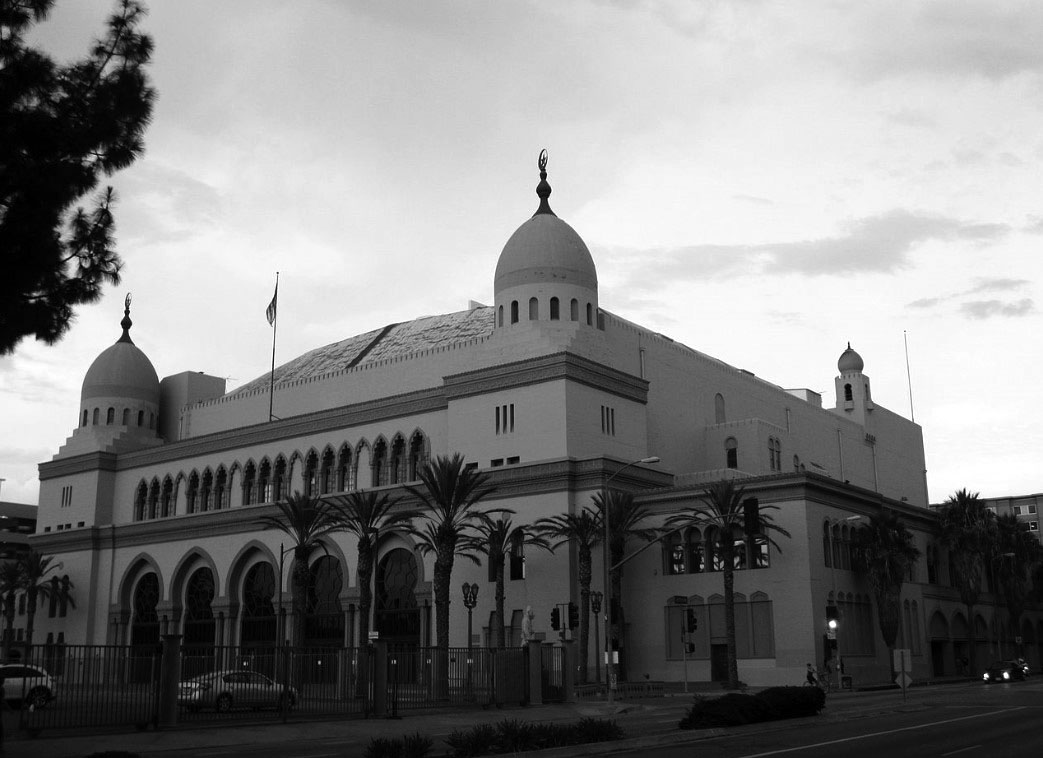 |
|
| (2012)* – View of the Shrine Auditorium as it appears today. It is also the headquarters of the Al Malaikah Temple, a division of the Shriners. Photo by Stephanie Kemna / Wikipedia. |
Historical Notes In 2002, the Shrine underwent a $15 million renovation that modernized its stage technology, infrastructure, and amenities while carefully preserving its historic character. Recognized for its architectural and cultural significance, the Shrine Auditorium was designated a Los Angeles Historic-Cultural Monument in 1975 and added to the National Register of Historic Places in 1987. |
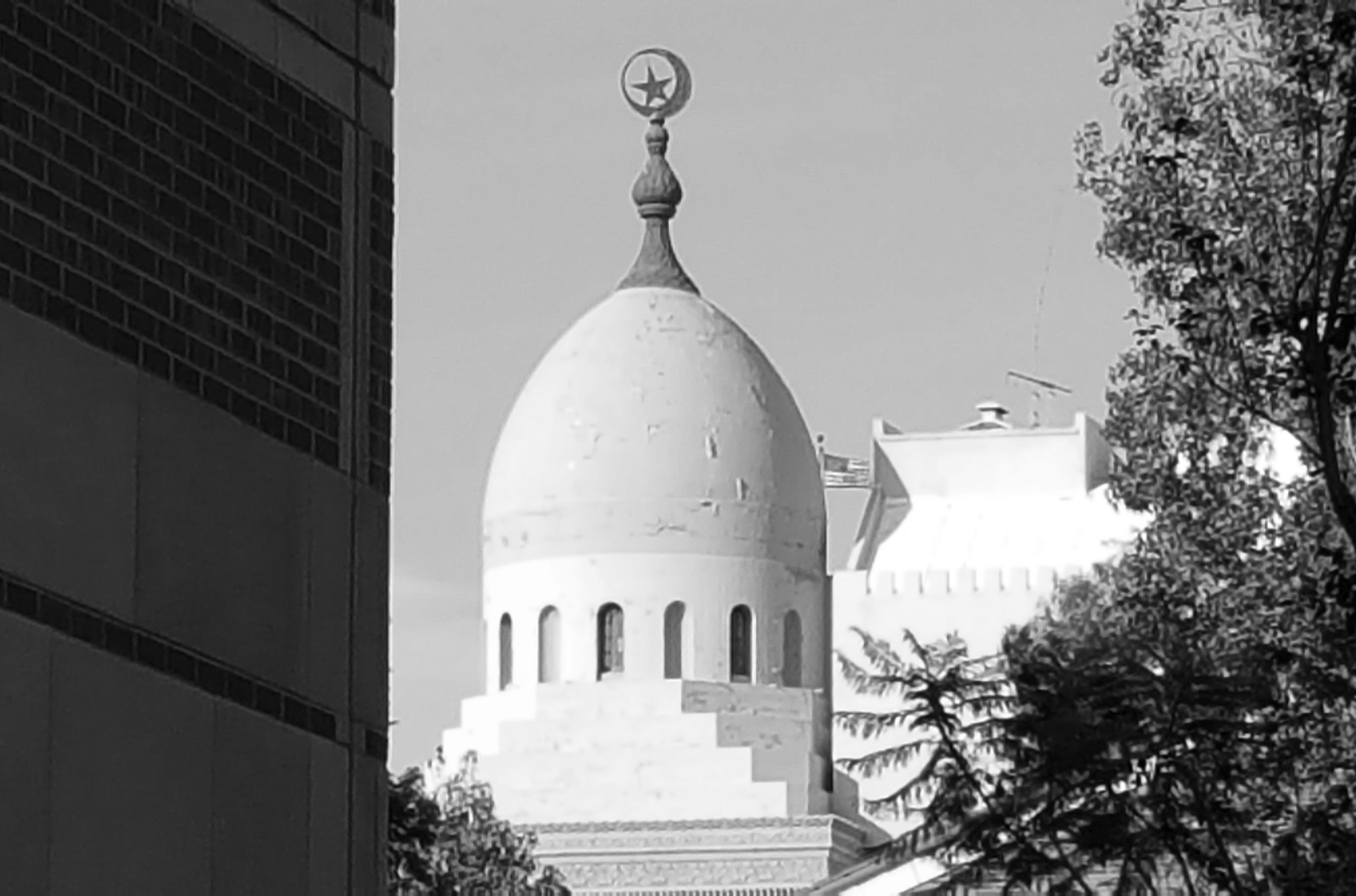 |
|
| (2015)* - View looking north at the Shrine Auditorium as seen from the USC campus across Jefferson Boulevard. Photo by Jack Feldman. |
Historical Notes Today, the Shrine Auditorium remains a vital Los Angeles landmark, celebrated for its architectural grandeur, rich history, and continuing role as a premier venue for entertainment, cultural events, and public gatherings. Its enduring legacy reflects both the vibrant entertainment history of Los Angeles and the city’s commitment to preserving important cultural landmarks. |
Then and Now
 |
|
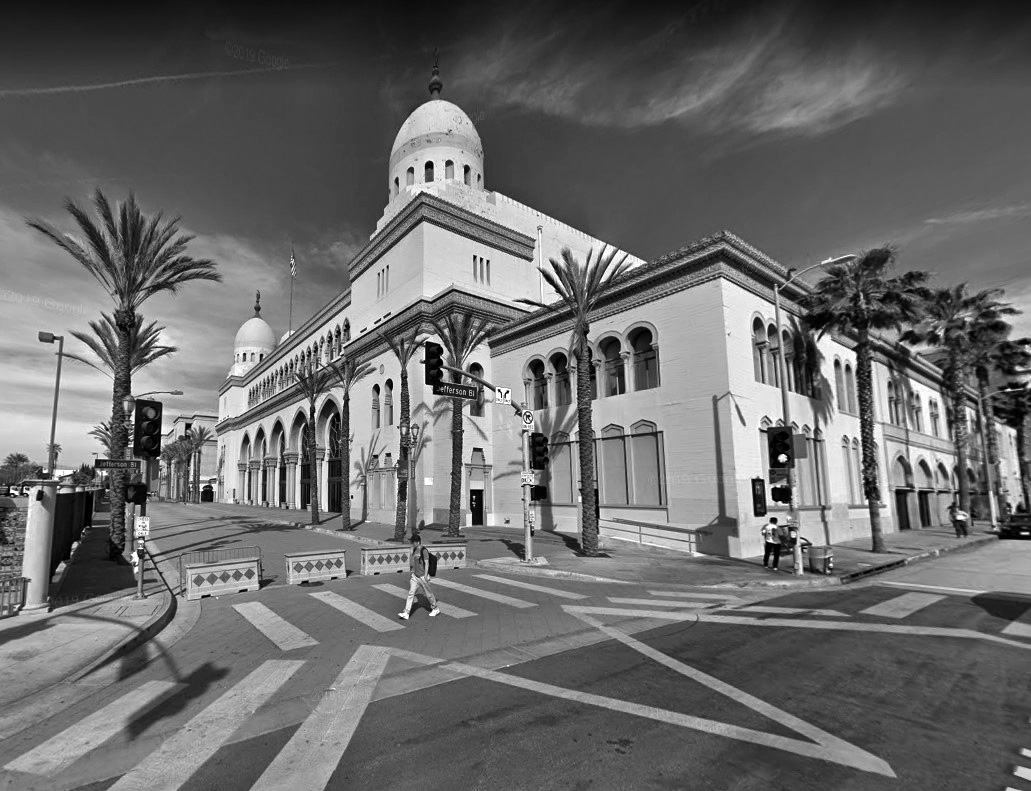 |
|
| (1926 vs. 2019)* - Shrine Auditorium as seen from W. Jefferson Boulevard.. |
* * * * * |
Belmont Theatre
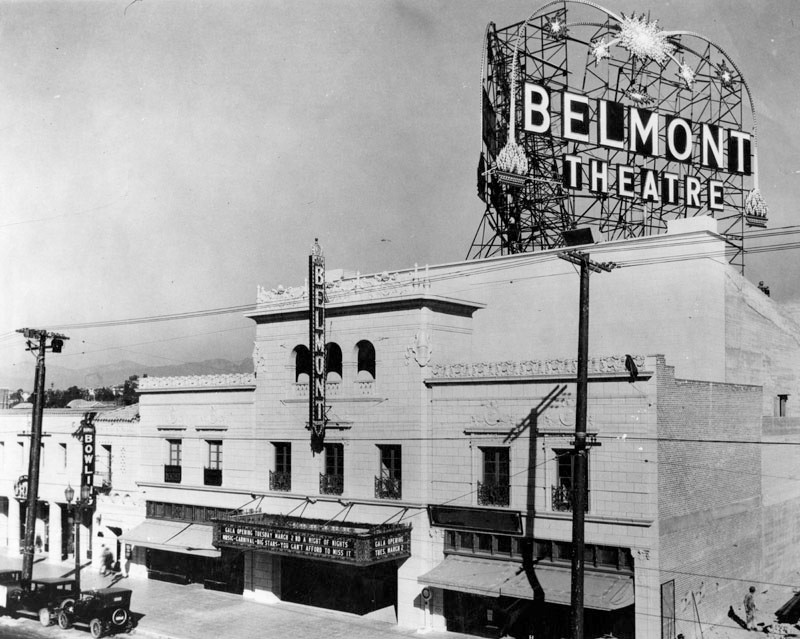 |
|
| (1926)* - View showing the Belmont Theatre and its large roof sign, located at 126 S. Vermont Avenue. |
Historical Notes Opened on March 2, 1926, the Belmont Theatre was a West Coast Theatres operation. It was located on the east side of Vermont Avenue, just south of Beverly Boulevard. |
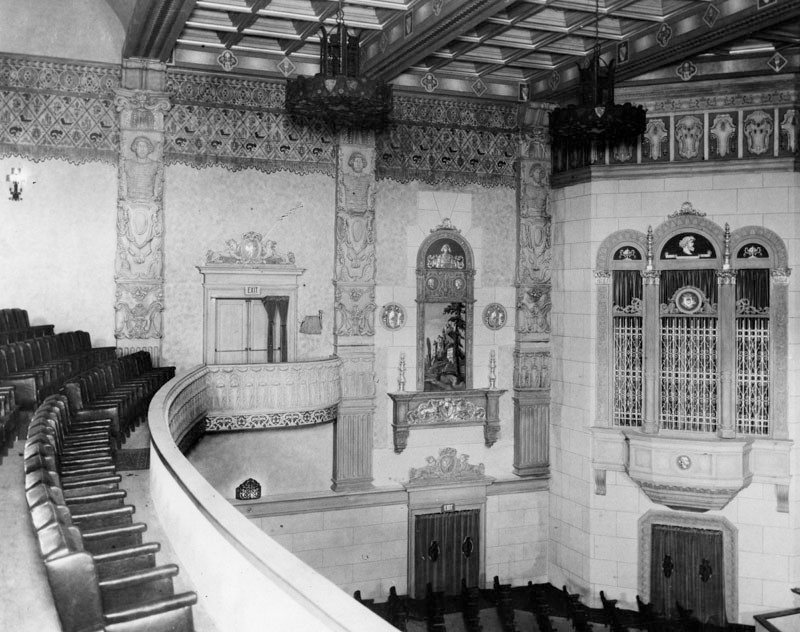 |
|
| (1926)* - Interior view of the Belmont Theatre as seen from the balcony. Note the ornate detail designs on the walls and ceiling. |
Historical Notes The Belmont was designed by Lewis A. Smith who did many projects for West Coast Theatres. It had a seating capacity of 1,680. |
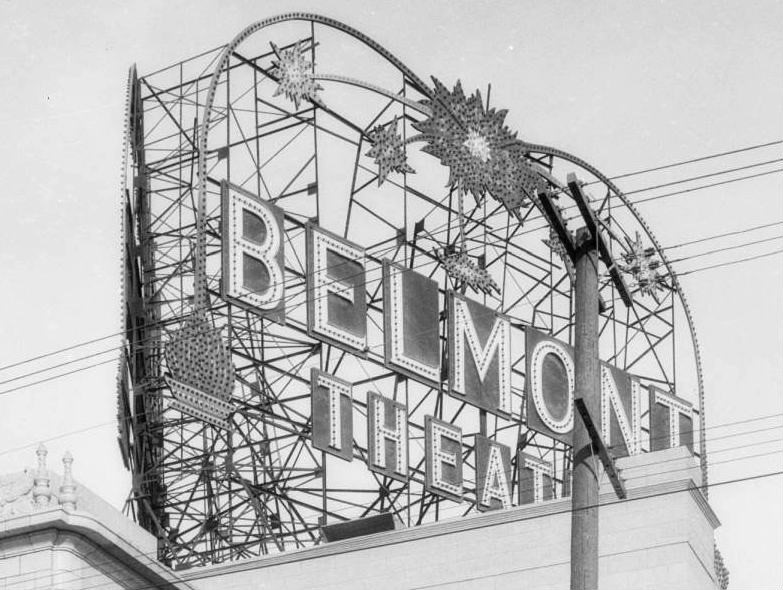 |
|
| (ca. 1926)* - Close-up view showing the oversized roof sign on top of the Belmont Theatre. The sign could be seen from miles away. |
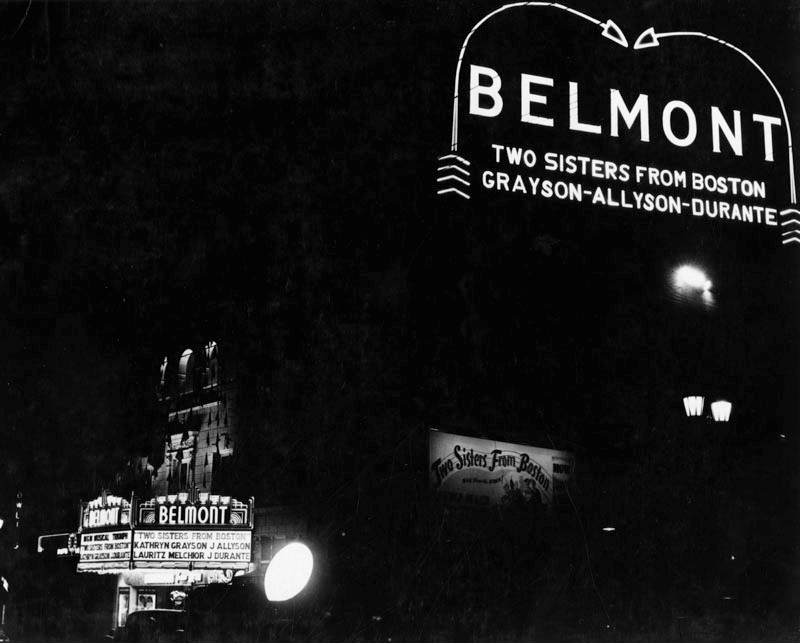 |
|
| (1946)* - Night view of the marquee and roof of the Belmont Theatre. Spotlight draws attention to a film premiere. |
Historical Notes The Belmont Theatre got a major remodel in 1946 by Fox West Coast Theatres resulting in a Skouras-style interior. It's also been known as just the Belmont. |
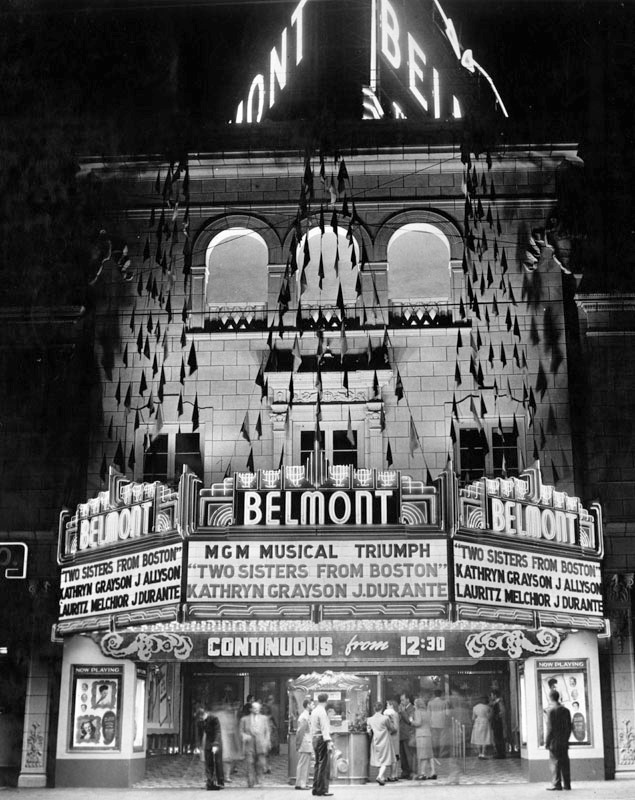 |
|
| (1946)* – Front view of the Belmont Theatre featuring the MGM Musical: “Two Sisters from Boston”, starring Kathryn Grayson, June Allyson, Lauritz Melchior, Jimmy Durante and Peter Lawford. |
Historical Notes The Belmont Theatre closed in 1973 after a fire and was demolished the same year. |
* * * * * |
Pantages Theatre (later Warner Bros. Downtown Theatre)
jpg.jpg) |
|
| (ca. 1926)* - View looking west on 7th street from the intersection of 7th and Hill. On the northwest corner stands the Pantages Theatre building, built in 1920. |
Historical Notes The Pantages Theatre, a nine-story steel-framed building designed by architect B. Marcus Priteca, was the city’s second theatre (and the country’s sixteenth) built for the namesake vaudeville circuit. It is a richly ornamented Beaux Arts structure that includes a 2,200 seat theatre, shops, and offices on the upper floors. |
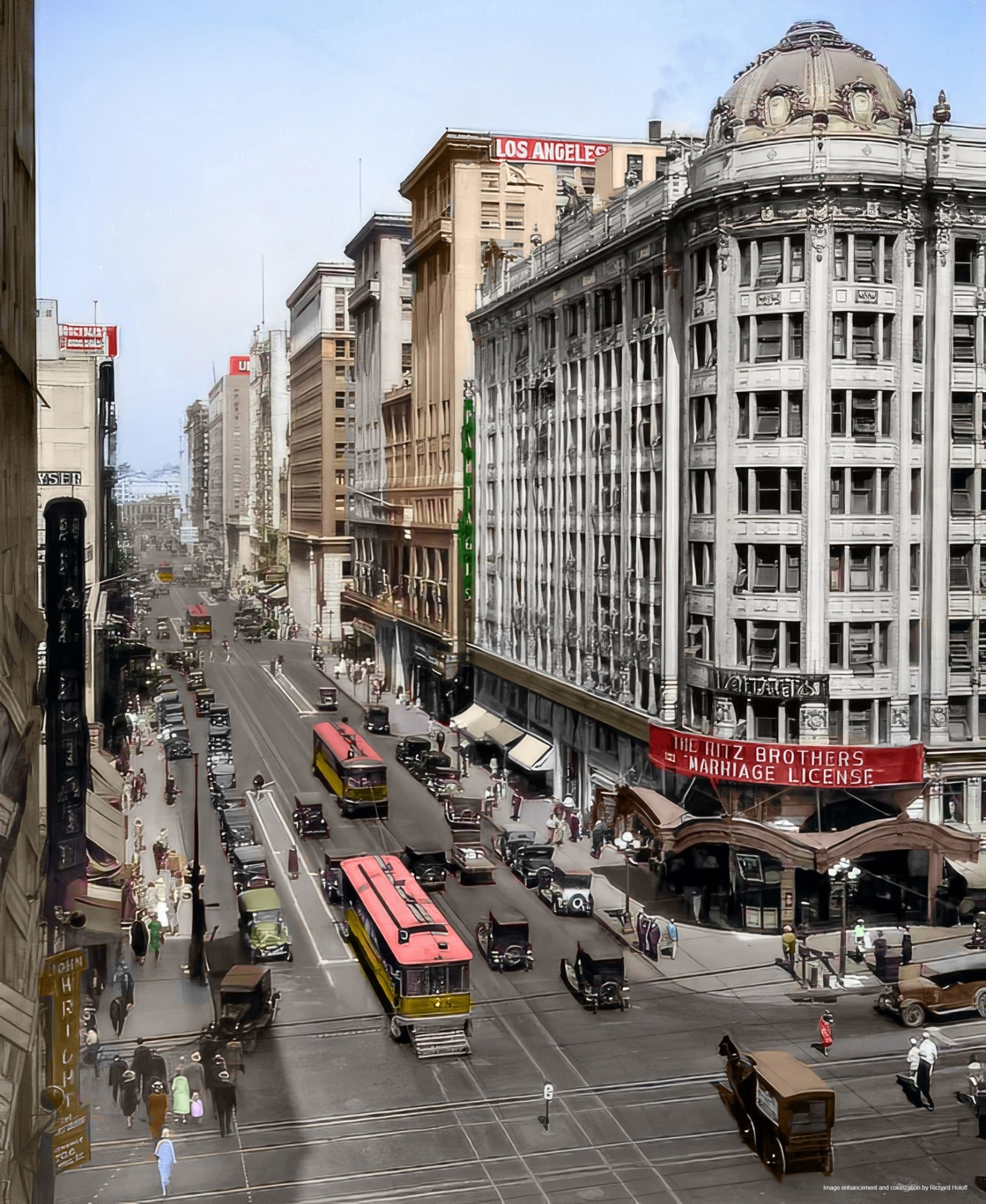 |
|
| (ca. 1926)* - View looking west on 7th street from the intersection of 7th and Hill. On the northwest corner stands the Pantages Theatre building. Image enhancement and colorization by Richard Holoff |
Historical Notes The home of the Pantages circuit prior to this was the 1910 building at 534 S. Broadway. That theatre is now known as the Arcade.^ |
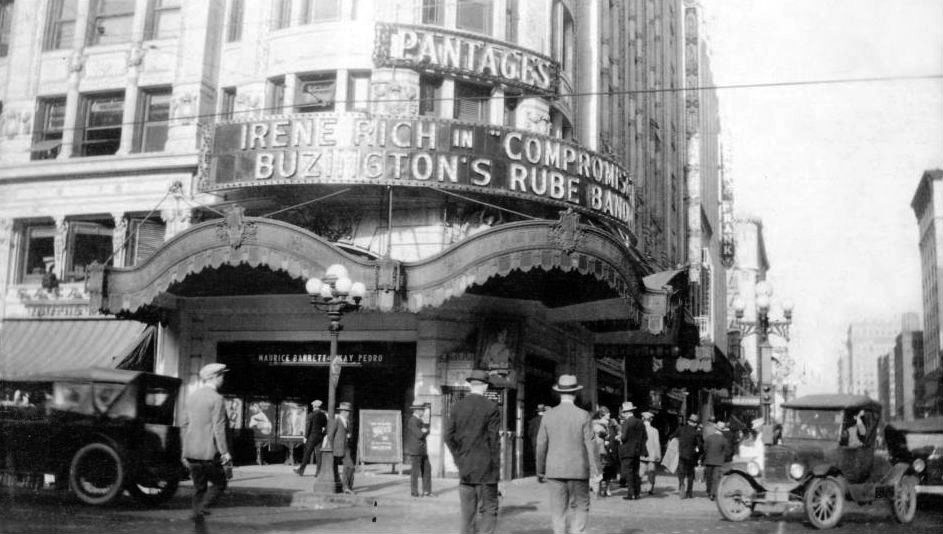 |
|
| (1925)* - View of the front entrance to the Pantages Theatre. The beautiful curved marquee reads: Irene Rich in "Compromise" and Buzington's Rube Band. Note the ornate 5-lamp streetlight posts in front of the theatre. |
Historical Notes The Pantages opened as the second Pantages theater in downtown Los Angeles (the Arcade theater was the first), this B. Marcus Priteca designed theater included Greek treatments for owner Alexander Pantages. The theater’s exterior was coated in white terra cotta.^^# Greek-born Alexander Pantages got his start in show business selling seats for readings of newspapers to miners in Alaska who were starved for information and entertainment.^ |
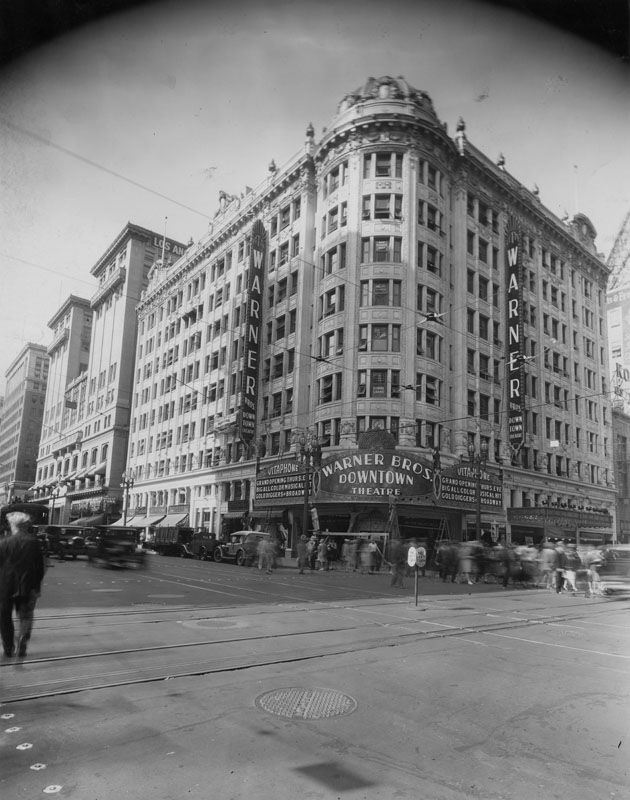 |
|
| (1929)* - Street view of Warner Brothers Downtown Theatre (previously Pantages) located on the northwest corner of Seventh and Hill streets. The theater will have its grand opening, featuring the Western premiere of "Gold Diggers of Broadway." Note that the streetlights in front of the theatre and down 7th Street have been changed to a new, more modern look (Click HERE to see more in Early L.A. Streetlights). |
Historical Notes In 1929 the Pantages Theatre became the Warner Bros. Downtown Theatre. This coincided with the opening of the new Hollywood Pantages Theatre. |
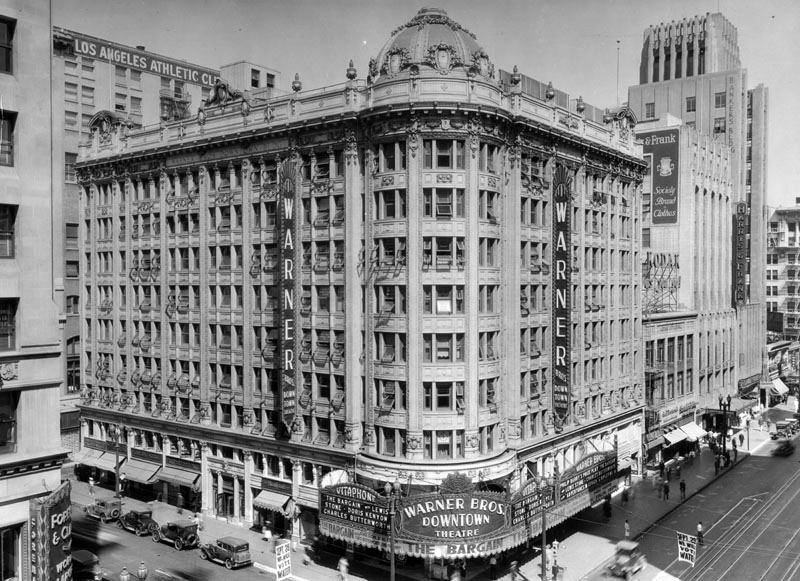 |
|
| (1930s)* - View looking down toward the Warner Bros. Downtown Theatre located on the northwest corner of 7th and Hill streets. The Los Angeles Athletic Club building can be seen on the left. |
 |
(1931)* - Close-up view of the electrical sign for the Warner Bros. Theatre as it hangs on the side of the building.
|
Historical Notes In February 1929, RKO theater magnate Joseph P. Kennedy attempted to acquire the theater chain but was rebuffed by Pantages. Kennedy then decided to destroy his competition. He used his influence among Hollywood movie distributors to keep Pantages from being able to show profitable first-run feature films. Some histories also allege that Kennedy tried to frame Alexander Pantages. In August 1929, a young dancer and aspiring actress named Eunice Pringle claimed that Pantages had sexually molested her in his office on the mezzanine-level of the theater. Pantages was arrested, tried, convicted, and sentenced to 50 years in prison. In an even more sensational series of appeals, Pantages was acquitted. It’s been argued that Pringle later confessed that Kennedy had conspired with her and her agent/lover, Nicolas Dunaev, to concoct the accusation of rape and to lie in court. Whatever the actual truth may have been, the scandal did indeed ruin Pantages theater business and he was forced to sell his chain to Kennedy’s RKO for a paltry $3.5M, much lower than the true value of the company's real estate holdings. Although Kennedy wanted the chain of theaters, he did not need this particular property. RKO already owned several downtown LA theatres and quickly sold the Pantages Theatre to Warner Brothers. They removed the original signage and reopened it as the Warner Bros. Downtown Theatre. * |
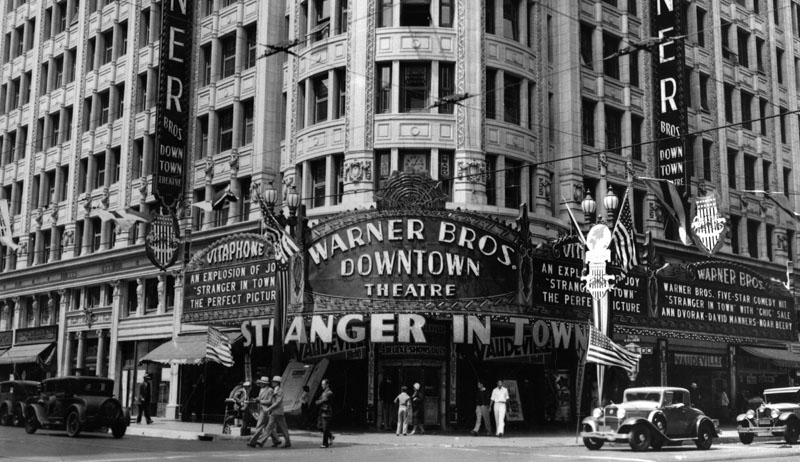 |
|
| (1932)* - View of the Warner Bros. Downtown Theatre marquee on the corner of 7th and Hill Streets. Playing is "Stranger in Town." |
Historical Notes The interior of the Warner Brothers Downtown theater can be seen in the opening scenes of the 1968’s “Funny Girl”. While Barbra Streisand is sitting alone in an orchestra seat, shots are taken from the stage looking out and from an upper balcony looking down. Also, in the 1933 film “Lady Killer”, James Cagney briefly plays a Warner Bros theater usher. There is a short sequence shot on the roof of the Warner Brothers Downtown theatre (usher inspection). Also a quick view of the marquee – even though it says “Strand” – It is clearly the Warner Brothers Downtown in all its blazing glory.^* |
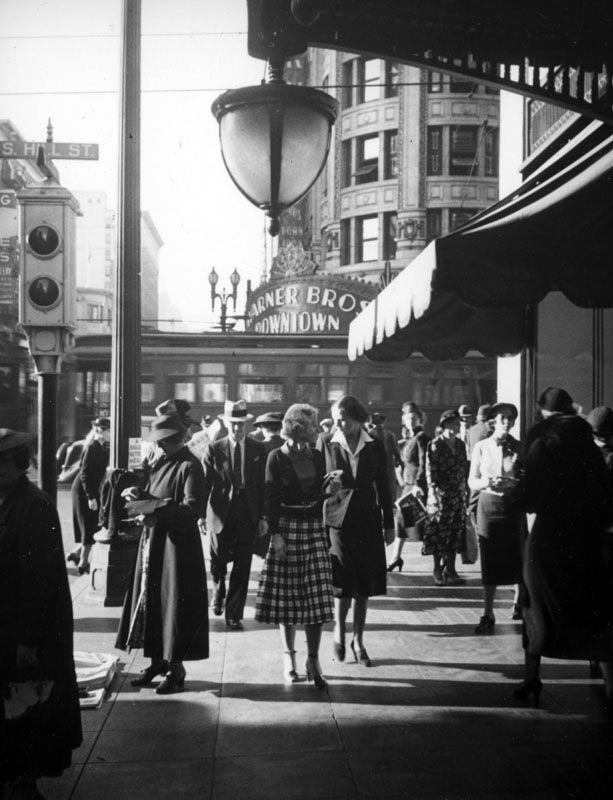 |
|
| (ca. 1937)* - A streetcar rushes by just as this shot is being taken so the bottom of the Warner Brothers Downtown Theater is hidden but both signs are visible, as is an interesting hanging light and the crowds on the sidewalk in this view of Seventh looking west towards Hill. |
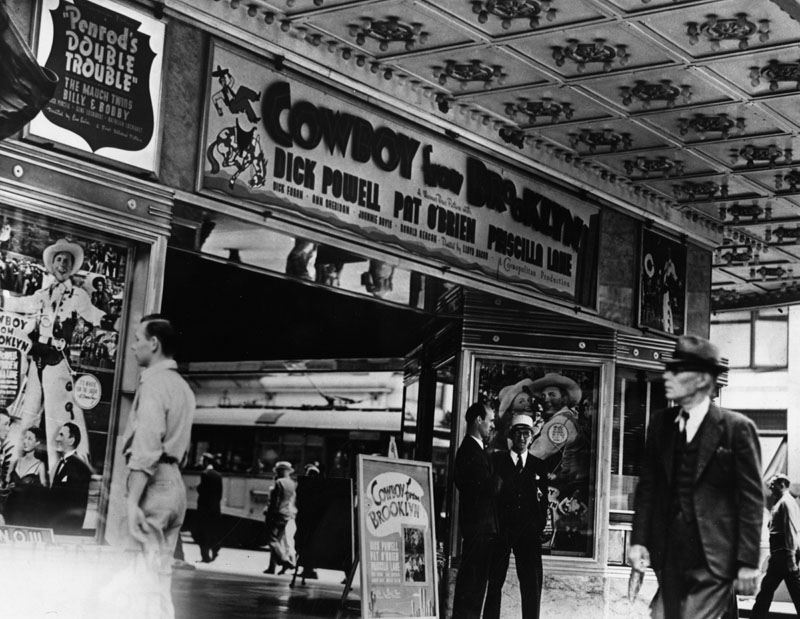 |
|
| (1938)* - A view across the northwest corner containing the box office and part of the lower marquee plus placards for the movie "Cowboy from Brooklyn". |
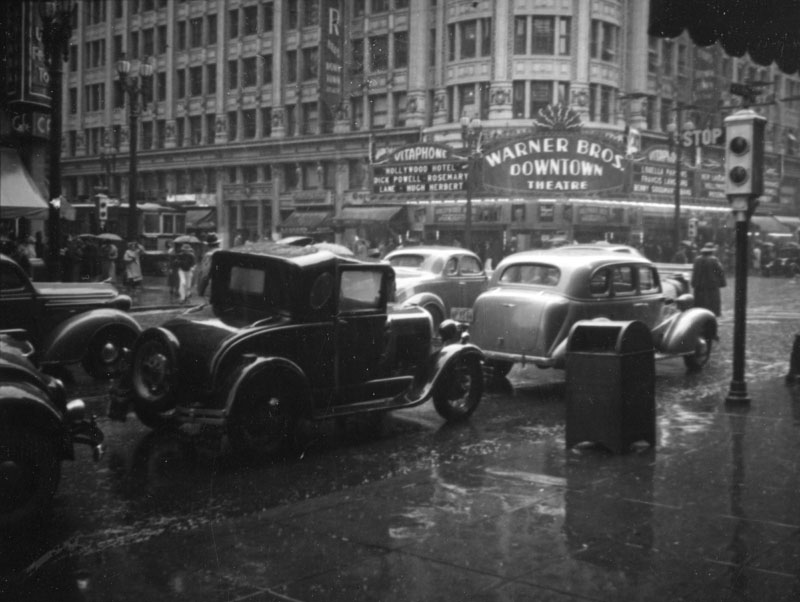 |
|
| (1938)* - Cars battle the rain. The movie "Hollywood Hotel" which came out early in 1938 is playing at the Warner Brothers Downtown (previously the Pantages Theater). Photo by Herman Schultheis. |
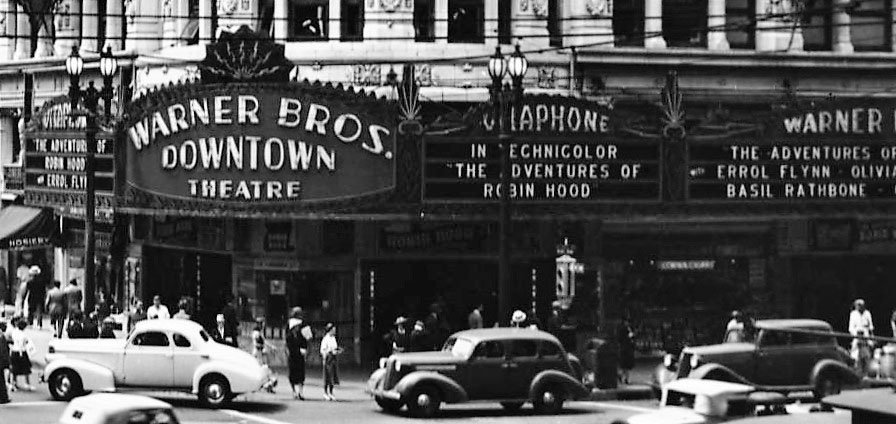 |
|
| (1938)^ – Close-up detail view showing the marquees of the Warner Bros. Downtown Theatre. Now playing: The Adventures of Robin Hood with Errol Flynn, Olivia de Havilland, Basil Rathbone, and Claude Rains. |
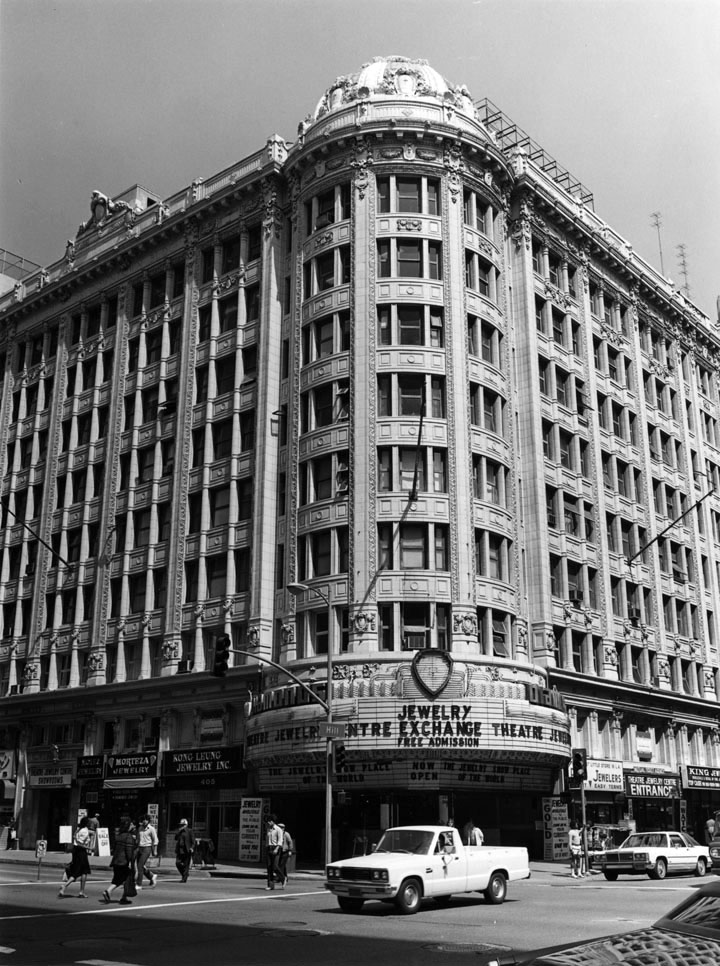 |
|
| (1983)* - View of the Pantages Theatre Building. The sign on the Marquee reads: JEWELRY EXCHANGE |
Historical Notes Until the mid-1960’s, the theater served as the downtown theater for Warner Bros. At that time, Metropolitan Theaters purchased the theater and ran it for another twelve years, renamed Warrens Theatre. After being sold by Metropolitan, the theater became a church before becoming a retail outlet for the Jewelry Exchange. The original seats on the main floor of the auditorium have been removed to make way for retail stalls. The balcony is still intact and its seats have not been removed.* |
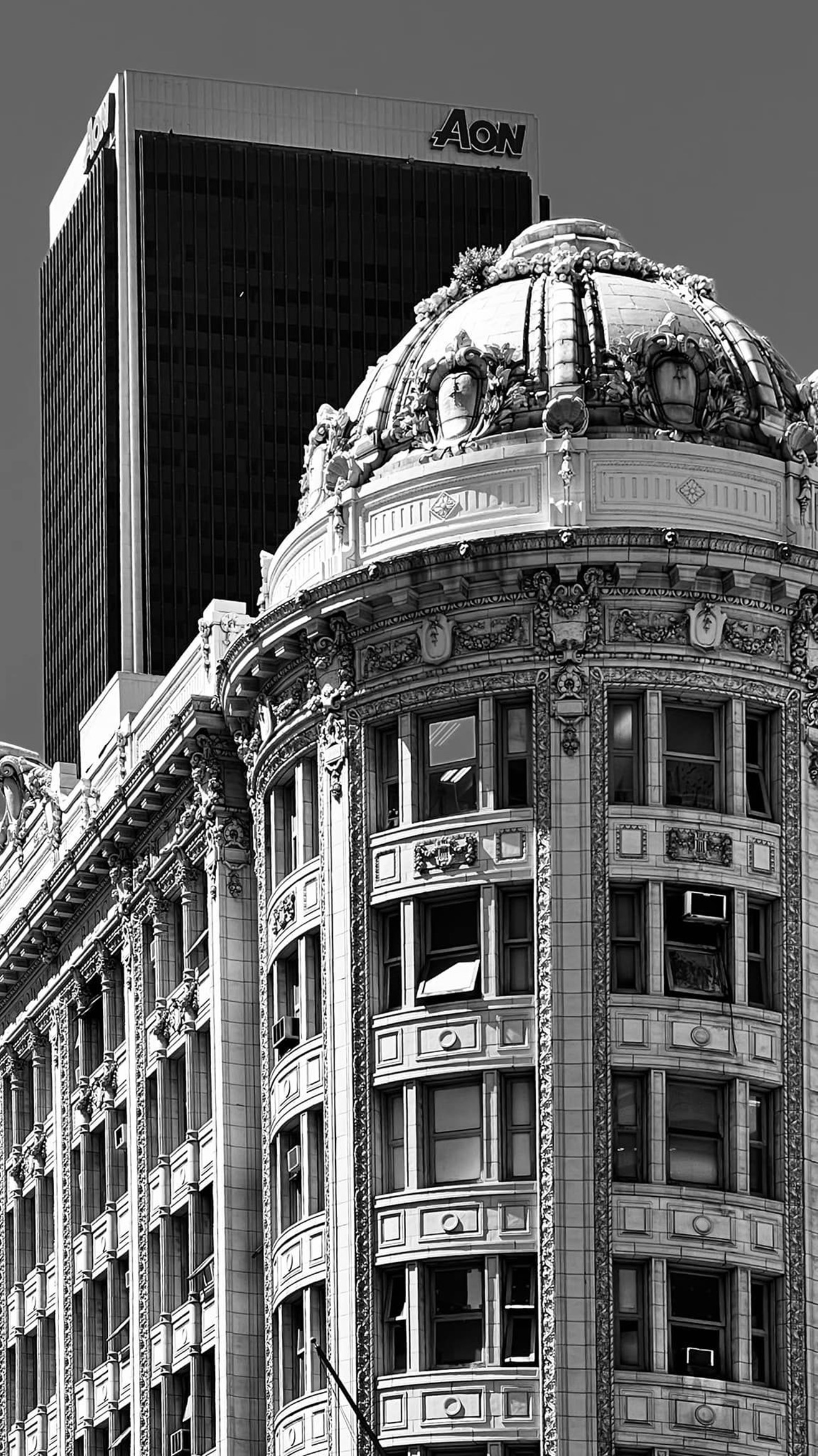 |
|
| (2022)* - Looking up at the beautiful Warner Theater Building (originally Pantages Theatre) with the AON Building in the background. Photo by Carlos G. Lucero |
Historical Notes Vestiges of its Warner Bros. legacy remain. The familiar Warner Bros. emblem is visible behind the current diamond motif above the buildings’ corner marquee. The parapet continues to read “Warner Bros. Downtown Bldg."* |
Then and Now
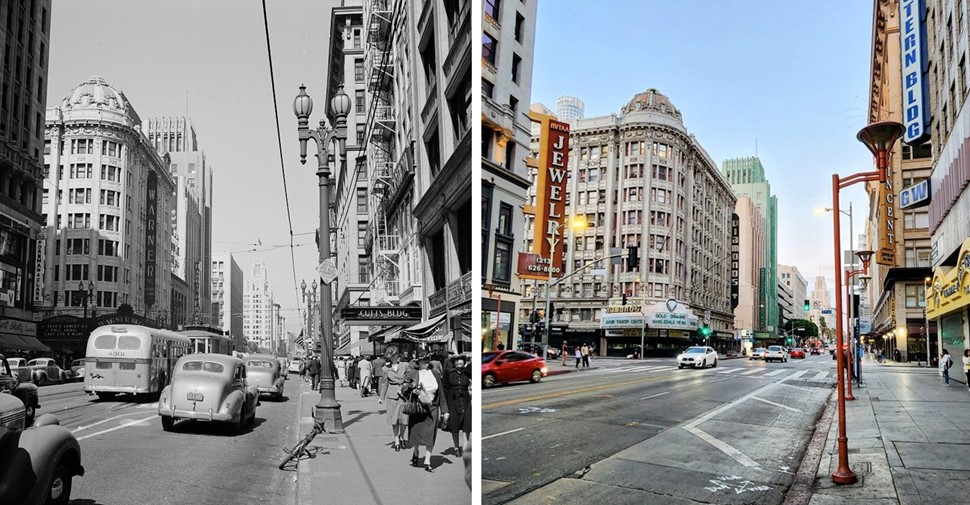 |
|
| Then and Now* - Warner Bros. Downtown Theatre. Then and Now – View is looking north on Hill Street at 7th Street. |
* * * * * |
Orpheum Theatre (4th Home of the Orpheum Circuit)
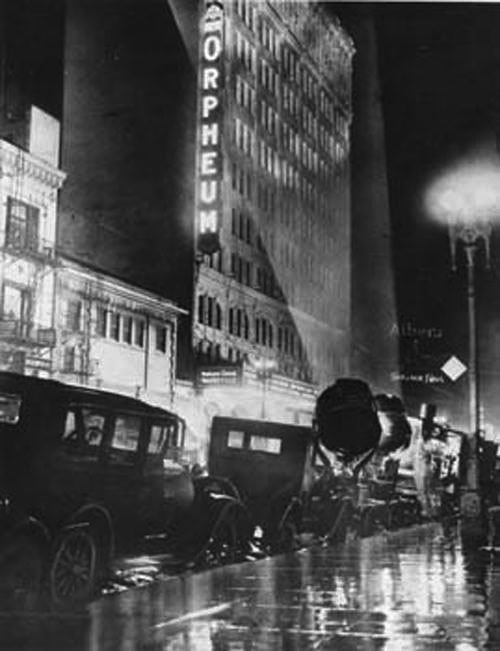 |
(1926)##*^– Opening night at the Orpheum, 842 S. Broadway. |
|
Historical Notes It opened in 1926 as the final theater included in vaudeville master Gustav Walter's chain of revue theaters, each called the Orpheum. It was the number one place to see Hollywood's biggest names, at a time when live variety shows reigned supreme. Lena Horne, Ella Fitzgerald, Sammy Davis Jr. and Judy Garland -- who was discovered at the Orpheum performing under her true name Francis Gumm -- all performed there.*## |
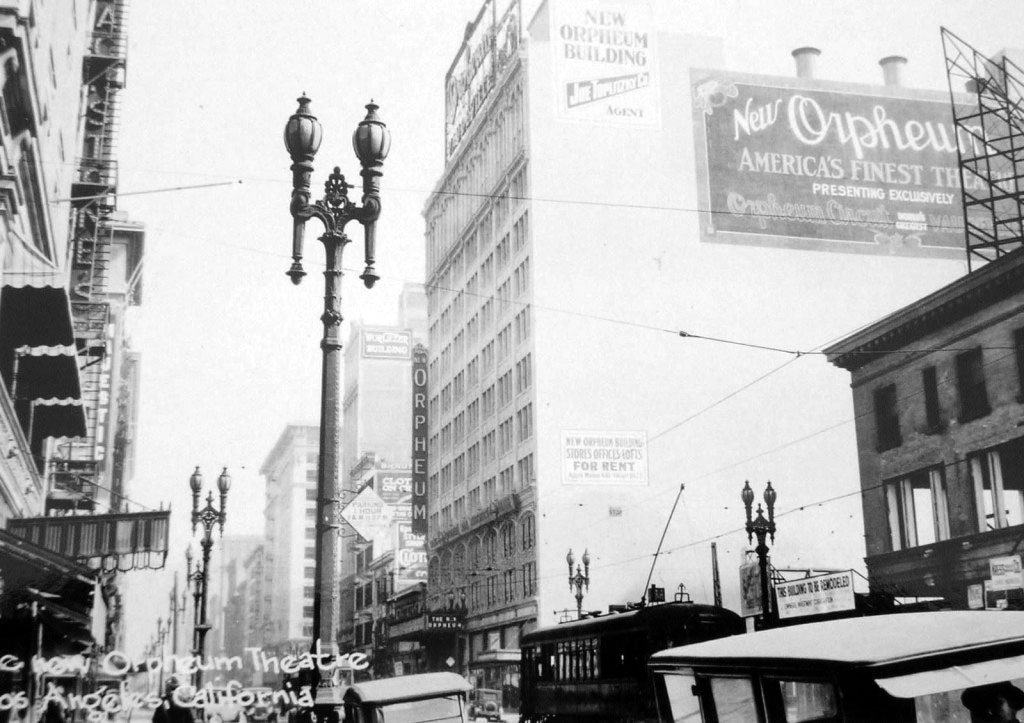 |
|
| (ca. 1926)**^ – View looking north on Broadway showing the Orpheum Theatre. Sign on side of building reads: ‘New Orpheum – America’s Finest Theatre – Presenting Exclusively – Orpheum Circuit Vaudeville’ |
Historical Notes The Orpheum Theatre at 842 S. Broadway opened on February 15, 1926 as the fourth and final Los Angeles venue for the Orpheum vaudeville circuit. Earlier Orpheum theatres in downtown Los Angeles included: ◆ 110 S. Main St. -- Grand Opera House was the home of Orpheum vaudeville from 1894 to 1903. ◆ 227 S. Spring St. -- The Los Angeles Theatre, later called The Lyceum, was known as the Orpheum from 1903 to 1911. ◆ 630 S. Broadway -- Now the Palace Theatre -- this was the Orpheum between 1911 and 1926. |
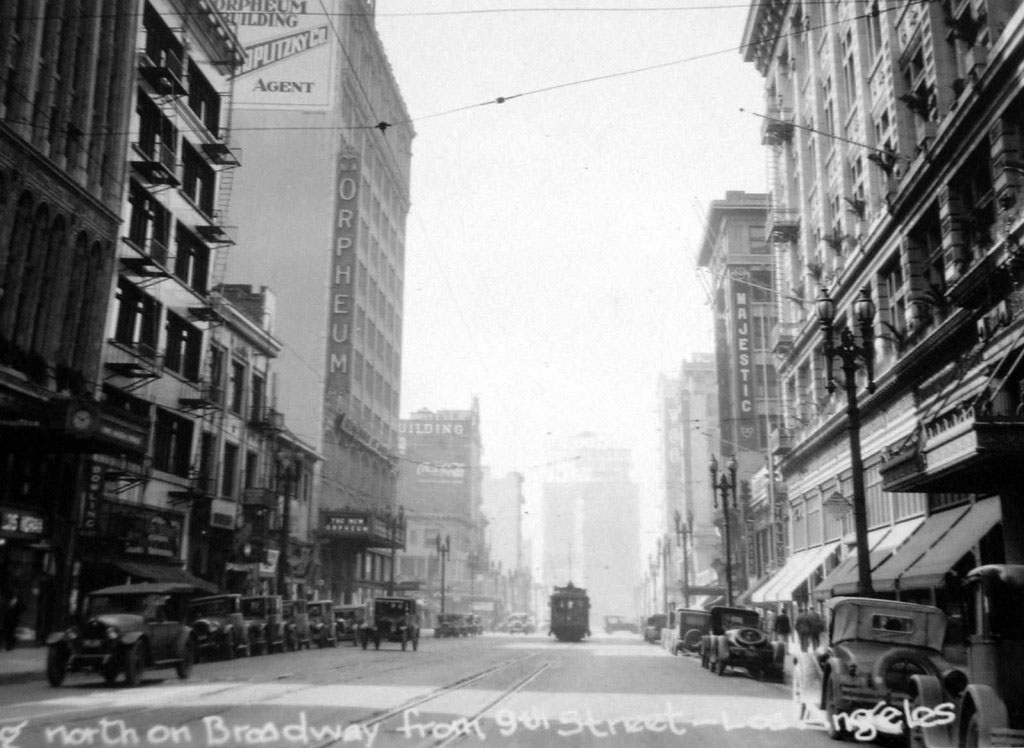 |
|
| (ca. 1926)**^ – Opposite view showing streetcar and autos on Broadway with the Orpheum Theatre on the left. |
Historical Notes Since its 1926 opening, the Orpheum has played host to some of the most venerable names in show business – from burlesque queen Sally Rand, a young Judy Garland (as Francis Gumm) and comedian Jack Benny, to jazz greats like Lena Horne, Ella Fitzgerald and Duke Ellington.*^ |
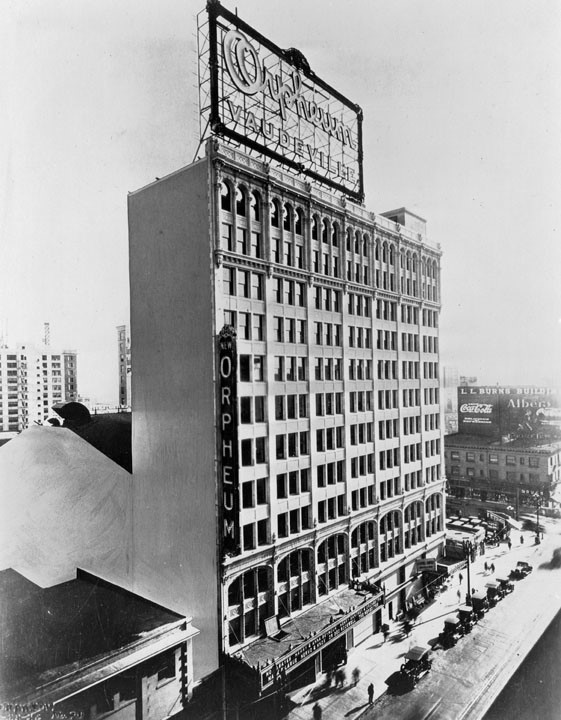 |
|
| (ca. 1926)* – View looking southeast showing the Orpheum Theatre located at 842 S. Broadway. Visible in the background is the L. L. Burns Building, with a large Coca-Cola advertisement. |
Historical Notes The Orpheum was designed in its entirety by top Los Angeles architect G. Albert Lansburgh, who did The Wiltern, El Capitan Theater and The Shrine's interior. Following the 1900s French style of Beaux-Arts architecture, The Orpheum's design included grand marble staircases, shiny brass doors, gorgeous chandeliers, plush silk wall panels and an incredible attention to detail on the façade and sculpted ceiling.*## |
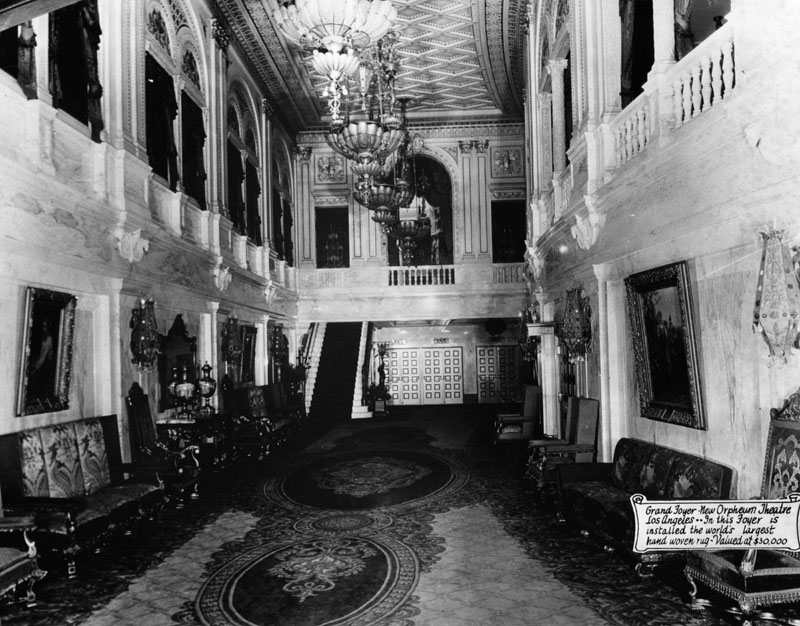 |
|
| (1932)* - The interior grand foyer of Orpheum Theater No. 4 which contains (for that time) the world's largest hand woven rug. |
Historical Notes The theatre’s auditorium, lobby and foyers are matched by its expansive balcony. Stunning at every turn, its downstairs wood paneled foyer recalls a more elegant time when going to a movie theater meant going out on the town. |
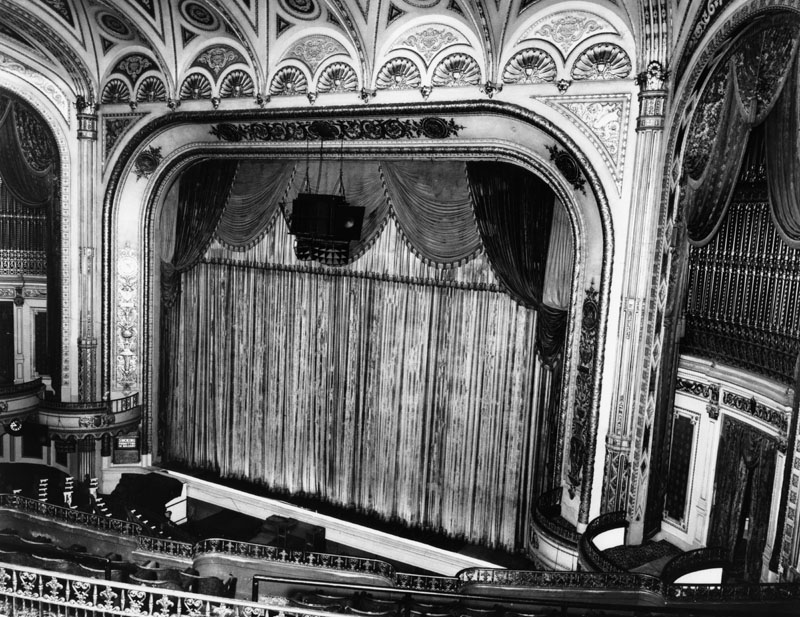 |
|
| (ca. 1930s)* - The proscenium of Orpheum Theater #4 as seen from the balcony. Organ pipe screens can also be seen on each side of the stage. |
Historical Notes When popular entertainment shifted to motion pictures, the Orpheum adapted, and in 1928, a 13-rank, three-manual Wurlitzer organ was installed inside the theater to accompany silent pictures. With the permanently installed metal and wooden pipes blending perfectly into the gilded walls, the organ could re-create around 1,500 orchestral sounds including car horns, thunder, animal sounds and gun shots, due to its 300+ sound effect tabs and revolutionary electrification, thanks to British inventor and Wurlitzer partner Robert Hope-Jones. The organist would add flare to showings by playing the organ's six different keyboards at once; sometimes not even seeing the film before sitting down. The Mighty Wurlitzer organ still exists today. It is one of three pipe organs remaining in Southern California venues. |
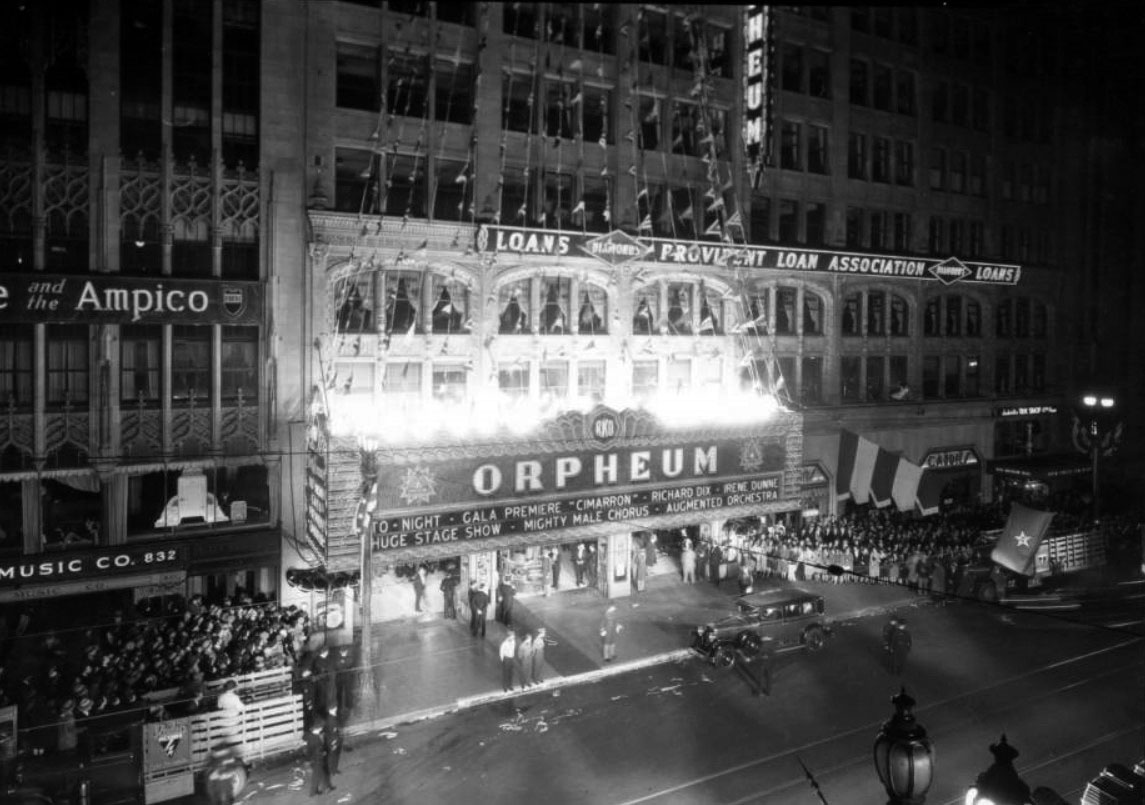 |
|
| (1931)^^ - A high-angle view of the Orpheum Theatre as it premiered the Cimarron with a huge crowd of onlookers. |
Historical Notes Cimarron is a 1931 Western film directed by Wesley Ruggles, starring Richard Dix and Irene Dunne, and featuring Estelle Taylor and Roscoe Ates. The Oscar-winning script was written by Howard Estabrook based on the Edna Ferber novel Cimarron. It would be RKO's most expensive production up to that date, and its winning of the top Oscar for Best Production would be only one of two ever won by that studio. It is also one of the few Westerns to ever win the top honor at the Academy Awards. Epic in scope, spanning forty years from 1889 to 1929, it was a critical success, although it did not recoup its production costs during its initial run in 1931.*^ |
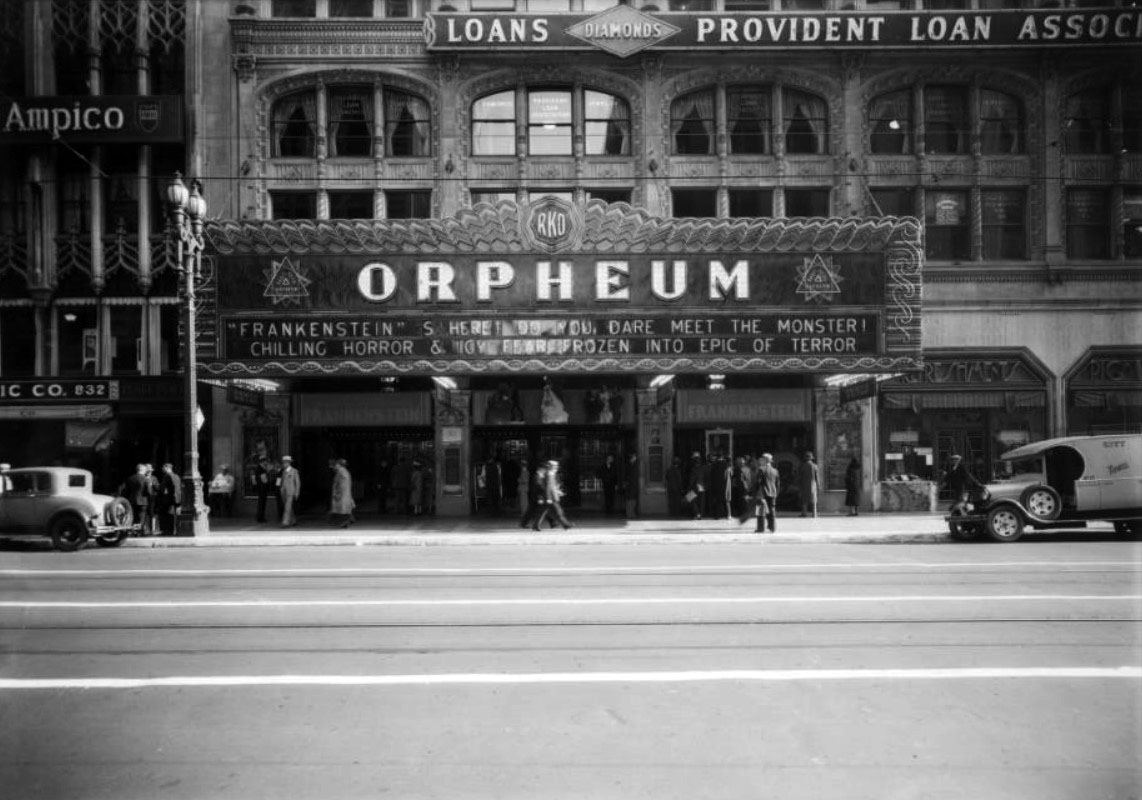 |
|
| (1932)^^ – View looking across Broadway showing the marquee of Orpheum Theatre advertising the motion picture "Frankenstein". |
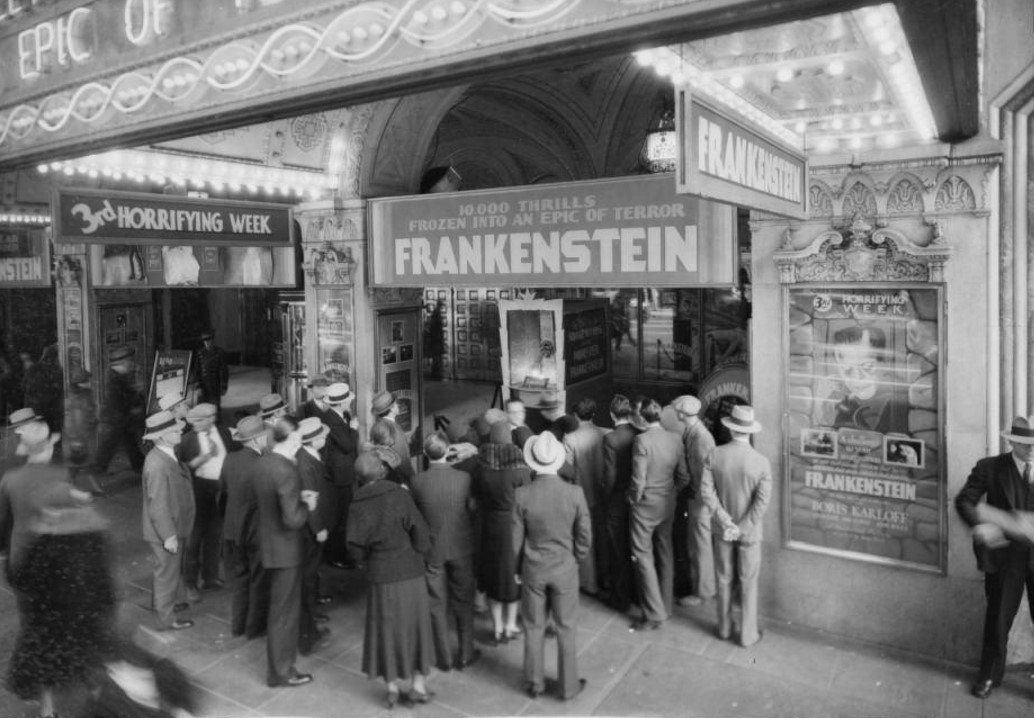 |
|
| (1932)^^ – A group of people stand in front of a display at the front entrance to the Orpheum Theatre. Now playing: ‘Frankenstein’ w/Boris Karloff – ’10,000 Thrills Frozen Into an Epic of Terror’. Photo by Dick Whittington |
Historical Notes The Frankenstein film came out in 1931. Its stars included Colin Clive, Mae Clarke, John Boles and Boris Karloff and featured Dwight Frye and Edward van Sloan. The Webling play was adapted by John L. Balderston and the screenplay written by Francis Edward Faragoh and Garrett Fort with uncredited contributions from Robert Florey and John Russell. The make-up artist was Jack Pierce. A hit with both audiences and critics, the film was followed by multiple sequels and has become an iconic horror film. *^ |
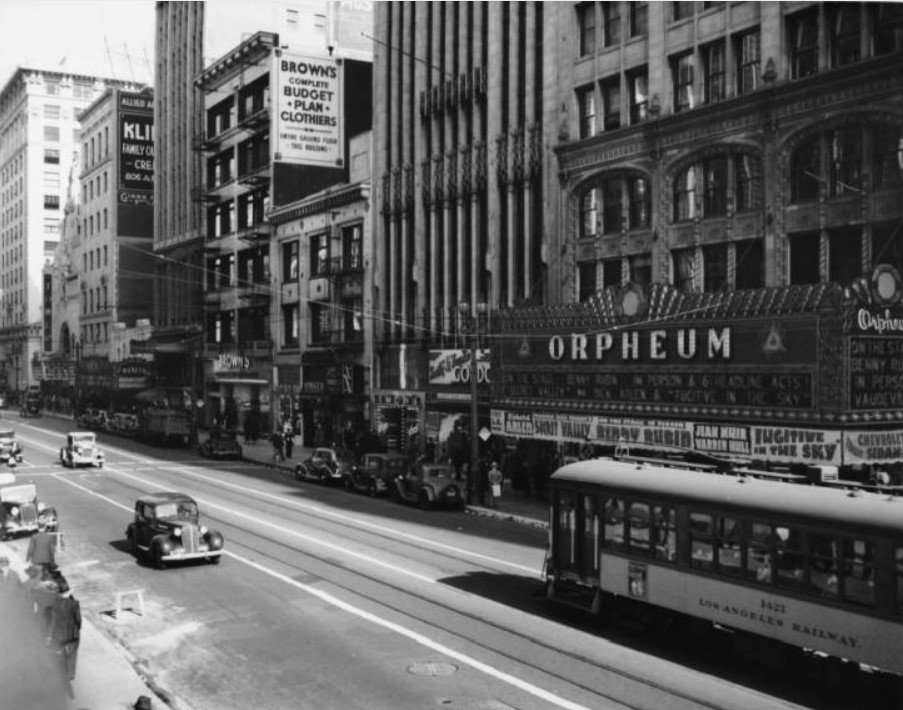 |
|
| (ca. 1938)^^ – View looking north on S. Broadway between 9th and 8th streets. The Orpheum Theater (featuring "Secret Valley" and "Fugitive in the Sky") is seen on the right behind a streetcar. |
 |
|
| (ca. 1949)##^ – View showing the Orpheum during its life as a vaudeville theatre. The marquee reads: “GALA INAGURAL PREMIER TONITE - 8 BIG ACTS – VAUDEVILLE” |
Historical Notes Since its February 15, 1926 opening, the Orpheum has played host to some of the most venerable names in show business – from burlesque queen Sally Rand, a young Judy Garland (as Francis Gumm) and comedian Jack Benny, to jazz greats like Lena Horne, Ella Fitzgerald and Duke Ellington. The 1960s brought a completely new dimension to the theater – “rock and roll” – with performers such as Little Richard, Aretha Franklin and Little Stevie Wonder. |
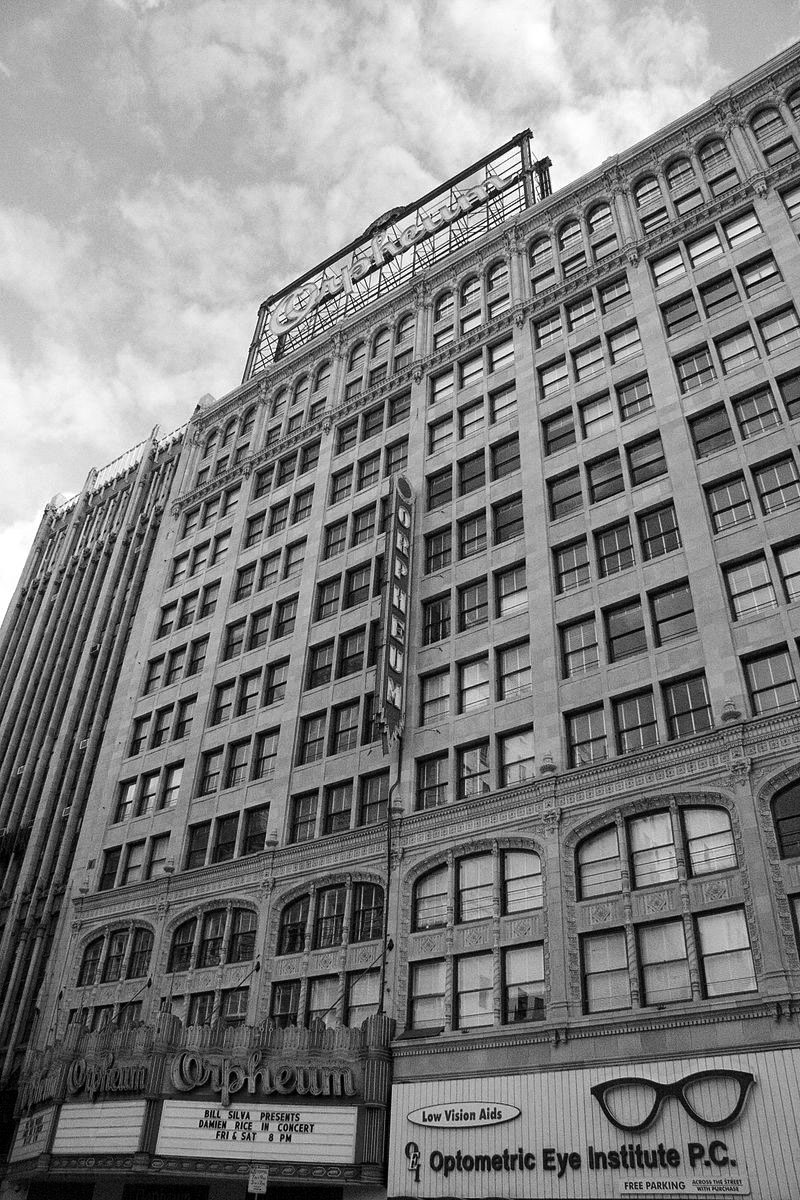 |
|
| (2006)*^ – Looking up towards the top of the Orpheum Theatre Building, located at 842 S. Broadway in downtown Los Angeles. |
Historical Notes After a $3 million renovation, started in 1989, the Orpheum is the most restored of the historical movie palaces in the city.*^ |
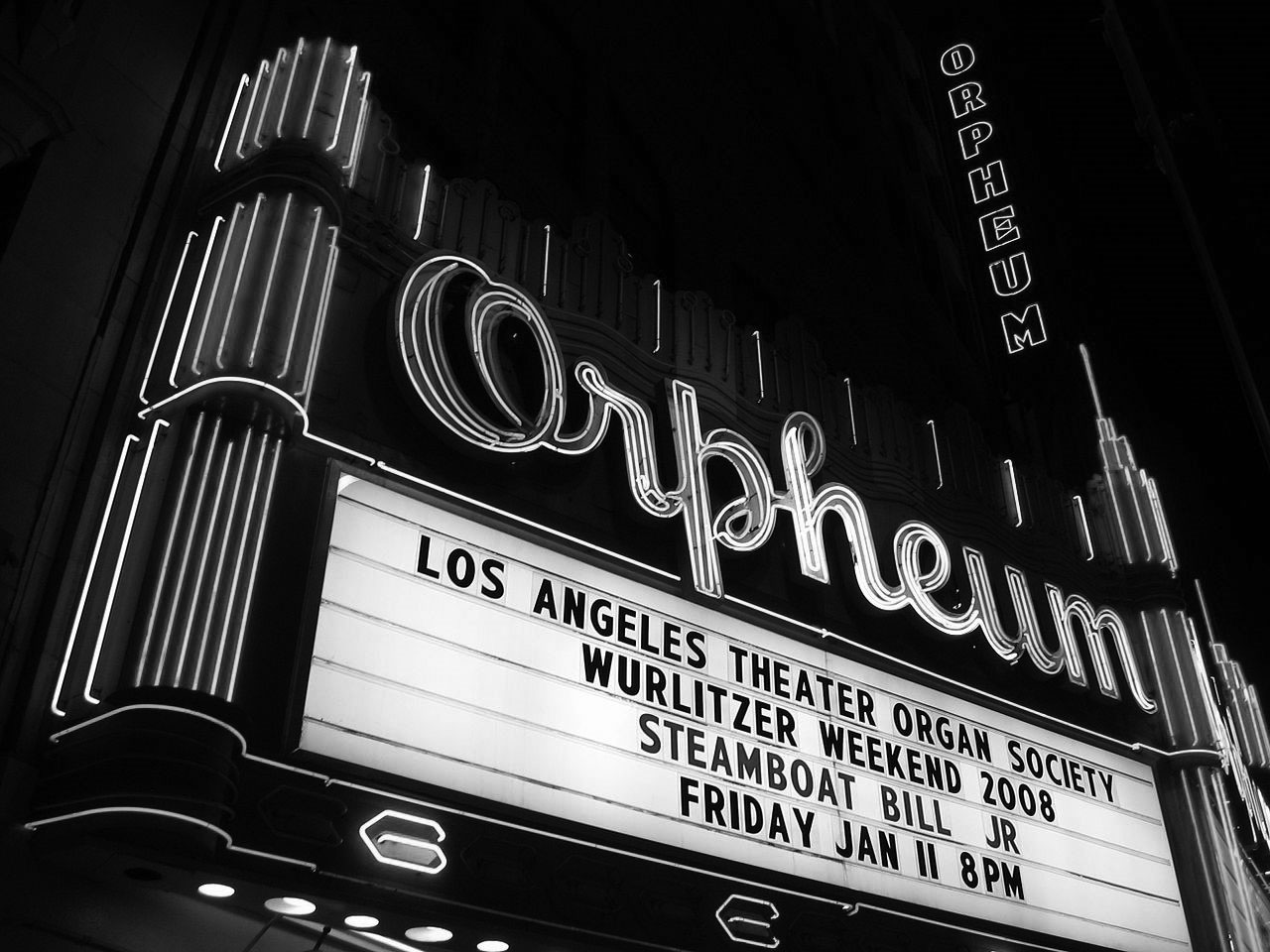 |
|
| (2008)*^ - Orpheum Theatre marquee reads: Los Angeles Theater Organ Society - Wurlitzer Weekend - Featuring Steamboat Bill Jr. - Photo by Oleknutlee via Wikipedia. |
Historical Notes The restored Orpheum Theatre is now a venue for live concerts, movie premieres and location shoots. The love metal band HIM played there for their CD/DVD live album Digital Versatile Doom. The 2010 Streamy Awards were live broadcast from the theatre.*^ |
* * * * * |
Mayan Theatre
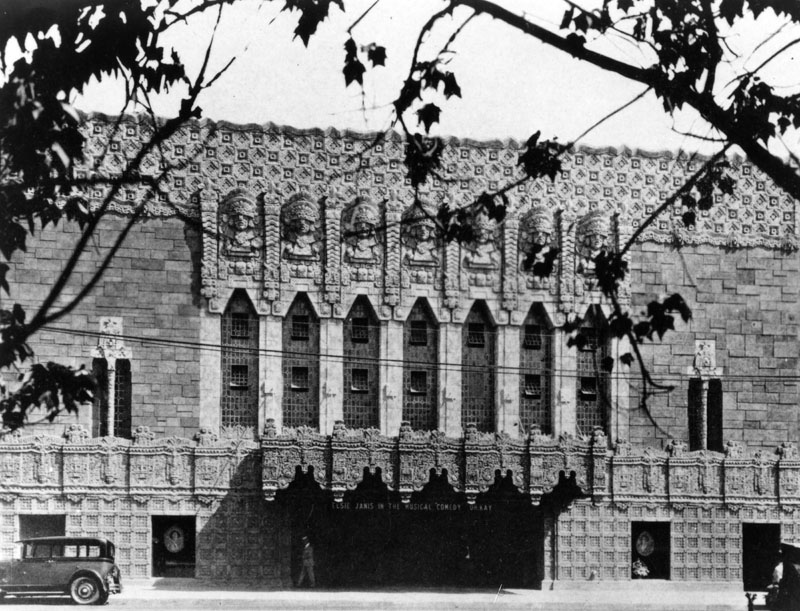 |
|
| (1927)* - The very ornately-carved exterior facade of the Mayan Theater as viewed from across the street, framed by tree branches. Location: 1044 South Hill St. |
Historical Notes The Mayan Theatre opened August 15, 1927 as a legit theatre focusing on musical comedies. The opening attraction was the musical "Oh, Kay!" with Elsie Janis. The Mayan Revival style theatre was designed by the architectural firm of Morgan, Walls and Clements.* |
 |
|
| (1927)* - A view of the auditorium ceiling details as seen from the balcony of the Mayan Theater, in Mayan Revival style. |
Historical Notes Originally a legitimate theater, the Mayan is a prototypical example of the many excessively ornate exotic revival-style theaters of the late 1920s, Mayan Revival in this case. The well-preserved lobby is called "The Hall of Feathered Serpents," the auditorium includes a chandelier based on the Aztec calendar stone, and the original fire curtain included images of Mayan jungles and temples.*^ |
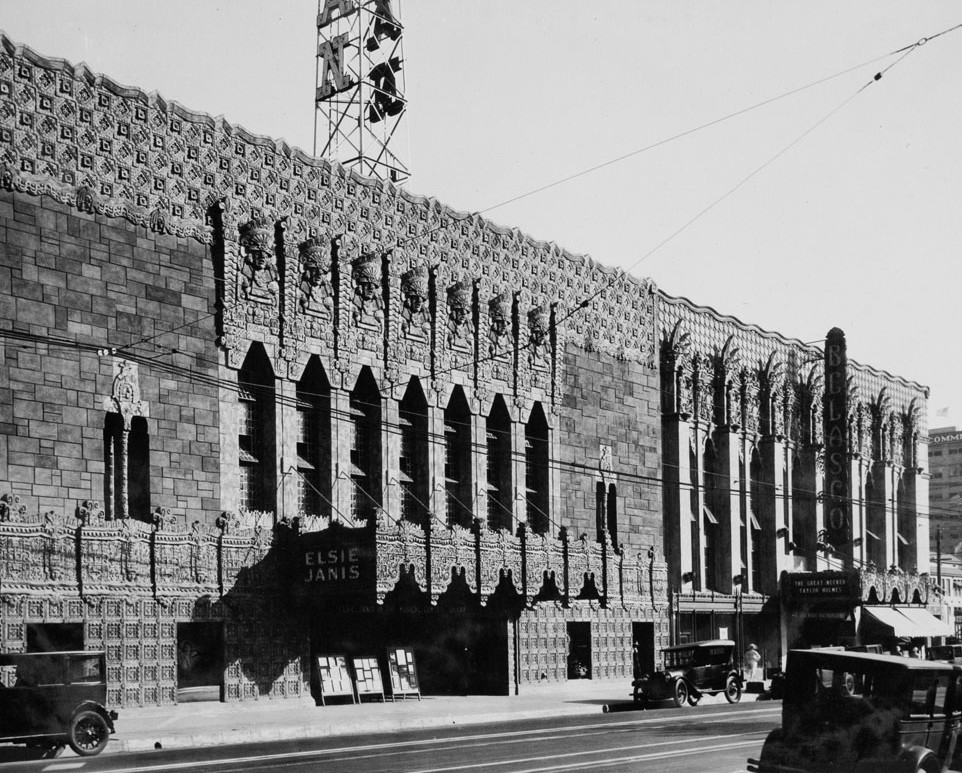 |
|
| (1927)* - Exterior view of the Mayan Theatre at 1044 South Hill Street. The very ornately-carved exterior of the Mayan Theater on the left. The marquee reads: "Now Playing, Elsie Janis in Oh, Kay!" Also in the photo is the Belasco Theater to the right next door, where "The Great Necker" with Taylor Holmes is playing. |
Historical Notes Morgan, Walls & Clements also did the Belasco Theatre (1926) just to the south of the Mayan. The project was financed by developer F.N. Stowall and oil magnate Edward L. Doheny. The Mayan and the Belasco were an attempt to get a new fashionable legit theatre district going west of Broadway.*^# |
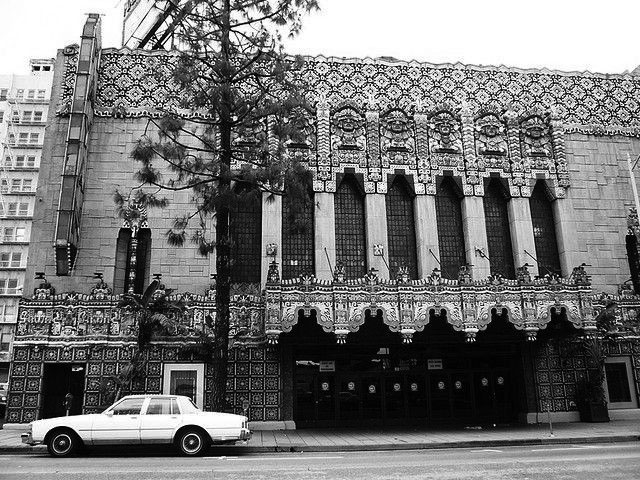 |
|
| (ca. 1980s)***# - View of a 1985 Chevrolet Impala parked in front of the Mayan Theater on South Hill Street. |
Historical Notes In 1989 the Mayan Theater was designated Los Angeles Historic-Cultural Monument No. 460 (Click HERE to see complete listing). |
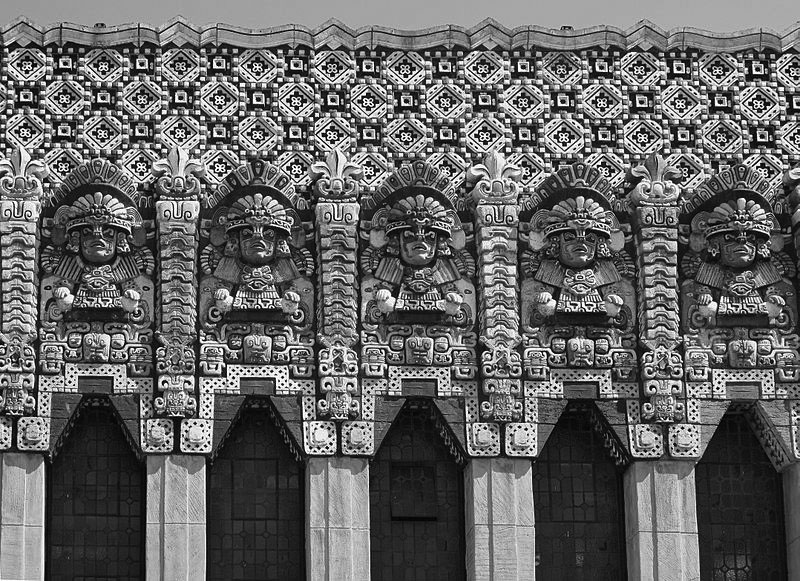 |
|
| (2012)*^ - Detail view of the facade on the Mayan Theater in the Mayan Revival style. Photo by Downtowngal, Wikipedia |
Historical Notes Francisco Comeja designed the cast concrete sculptural facade which was originally grey, but has been colorfully painted in recent years.* The Mayan Revival is a modern architectural movement, primarily of the 1920s and 30s, that drew inspiration from the architecture and iconography of pre-Columbian Mesoamerican cultures.*^ |
 |
|
| (2020)^.^ – Mayan Theatre (now Mayan Nightclub) as it appears today. Photo by Paul Wright |
Historical Notes The theater has been a location in many films, including Sally of the Scandals, The Bodyguard, Save the Tiger, Unlawful Entry, Rock 'n' Roll High School, and A Night at the Roxbury. In 1990, the Mayan Theater, with most of its lavish ornament intact, became a nightclub and music venue. |
* * * * * |
California Petroleum Corp. Building / later Texaco Building (United Artist Theatre - Ace Hotel and Theater)
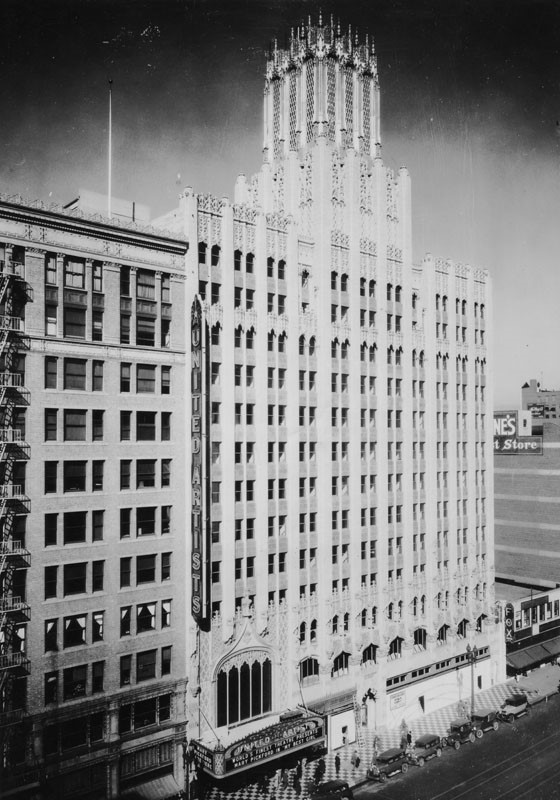 |
|
| (1927)* - View of the newly completed 13-story California Petroleum Corporation Building and the United Artists Theater located at 933 S. Broadway. |
Historical Notes Originally built as the California Petroleum Corporation Building and later known as the Texaco Building. It was the tallest building in the city for one year after its completion in 1927, and was the tallest privately owned structure in Los Angeles until 1956. Its style is Spanish Gothic, patterned after Segovia Cathedral in Segovia, Spain. Architect: Walker & Eisen • Charles Howard Crane The building was completed in 1927 and the United Artists Theatre's grand opening was on December 26 of that same year. The featured film was "My Best Girl" starring Mary Pickford (see marquee for billing). |
.jpg) |
|
| (1928)^^ - View looking southeasterly showing the United Artists Theatre as seen from the roof of building across the street. |
Historical Notes Built by the founders of United Artists Pictures; Charlie Chaplin, D.W. Griffith, Douglas Fairbanks, and Mary Pickford, who needed the massive Spanish Gothic style movie palace as a venue for world premieres of their movies. The castles and cathedrals that Fairbanks and Pickford saw on their honeymoon in Spain, inspired them to instruct architect C. Howard Crane to design their movie palace in that style. It was replicated the following year in the United Artists Theatre in Detroit, Michigan. |
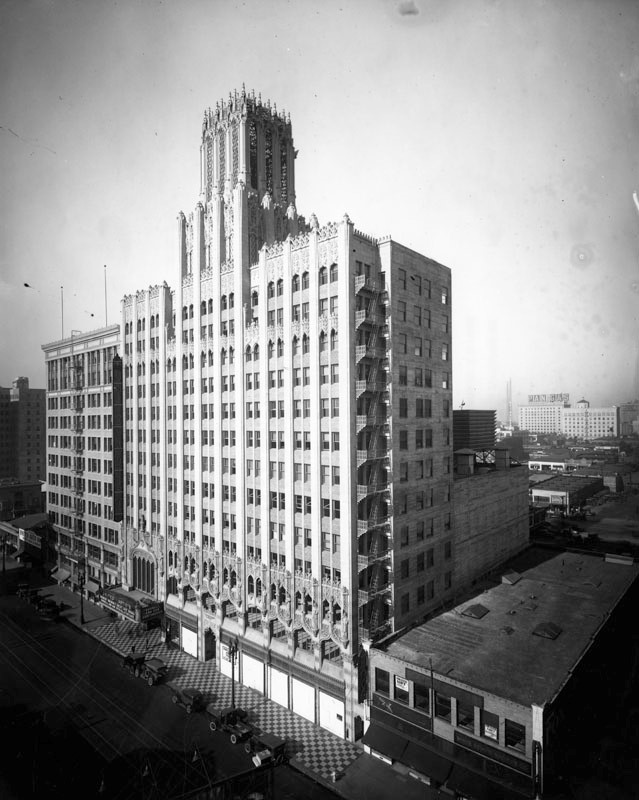 |
|
| (ca. 1928)* - Exterior view of the United Artists Theater in the early morning. "Sorrell and Son Continues" is on the marquee. Note the parquet sidewalk. |
Historical Notes The 13 story office building which fronts the United Artists Theatre was designed by the architectural firm Walker & Eisen, in a Spanish-Gothic style. There is a double height ogival window over the theatre entrance and many niches containing statues on the facade, including one of a figure holding an early movie camera. On top of the main tower feature is a large highly decorated clerestory and sky-sign. |
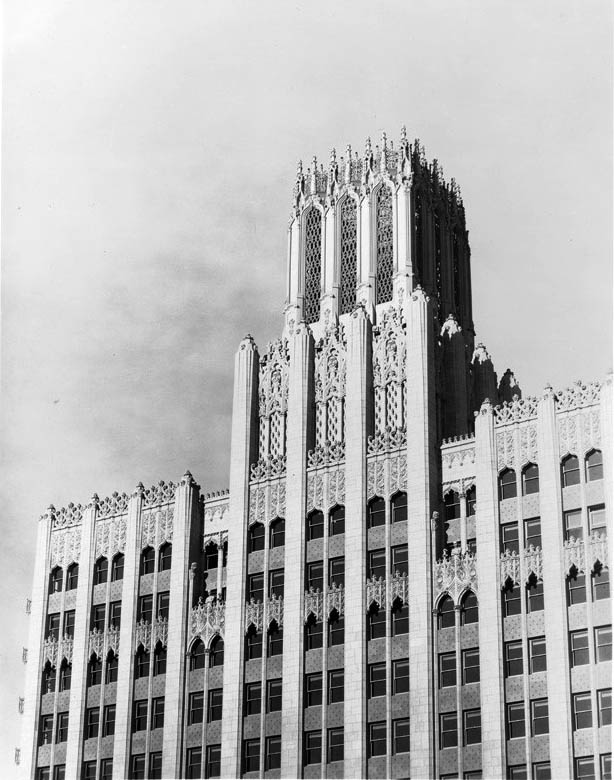 |
|
| (ca. 1928)^*# - Close-up view showing detail trimmings on top floors and roofline of the United Artists Theatre Building. |
Historical Notes The Spanish Gothic style building included a beautiful and ornate 50-foot high "dummy tower" to circumvent the local height restriction of the time, and all of the offices inside were leased by the California Petroleum Co. The United Artists Theater Building/Texaco Building, as it was known, was the city's tallest privately owned building for over 20 years. In 1979 Texaco Oil moved its operations to Wilshire Blvd. and the building remained vacant for some years. Today, this magnificent structure is home to Dr. Gene Scott's University Cathedral.* |
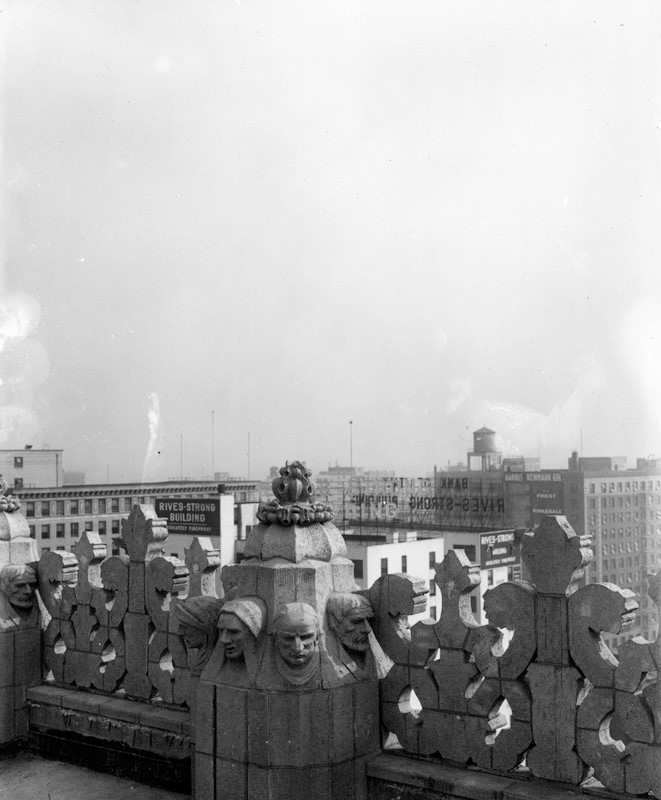 |
|
| (n.d.)* - View showing busts of medieval men looking out over the rooftop of the United Artists Theatre that faces the Rives-Strong Building at 9th and Main streets. |
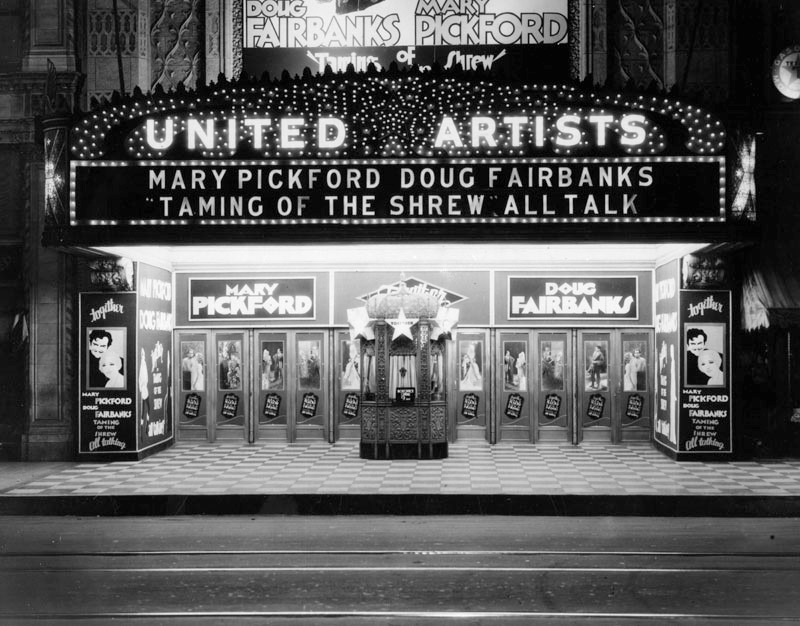 |
|
| (1929)* - The United Artists Theatre at night, showing a lit marquee, foyer and box office during run of "Taming of the Shrew" with Mary Pickford and Doug Fairbanks. |
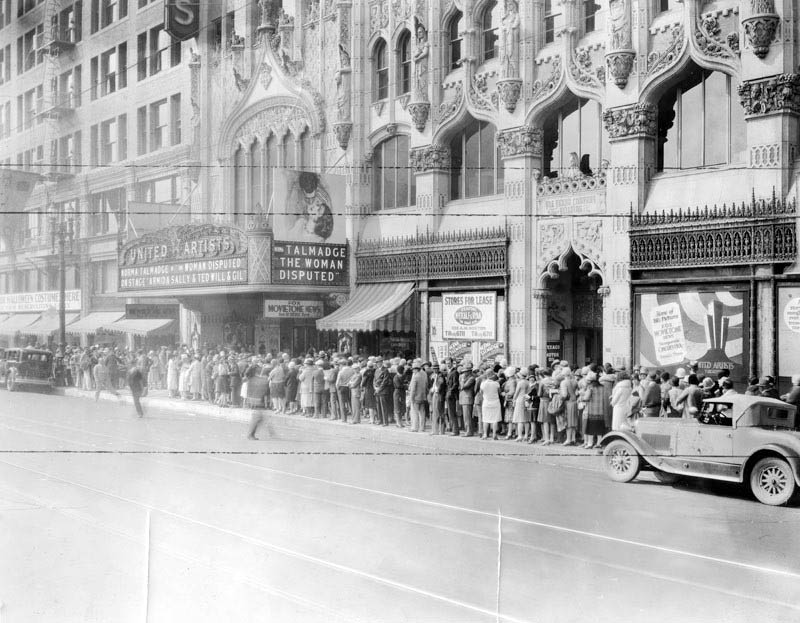 |
|
| (1928)* - View showing crowds in front of United Artists Theater on opening morning of Norma Talmadge's latest picture, "Woman Disputed". Note the ornate designs on the building facia. |
Historical Notes The theatre was a great success and was operated by United Artists Theatres circuit for the majority of its life as a movie theatre. During the 1950’s, a new wide-screen process was installed, and a giant curved screen was erected in front of the proscenium arch. Although little damage was done here, the mezzanine was totally removed to accommodate a new projection booth, which gave a straight throw onto the new screen. |
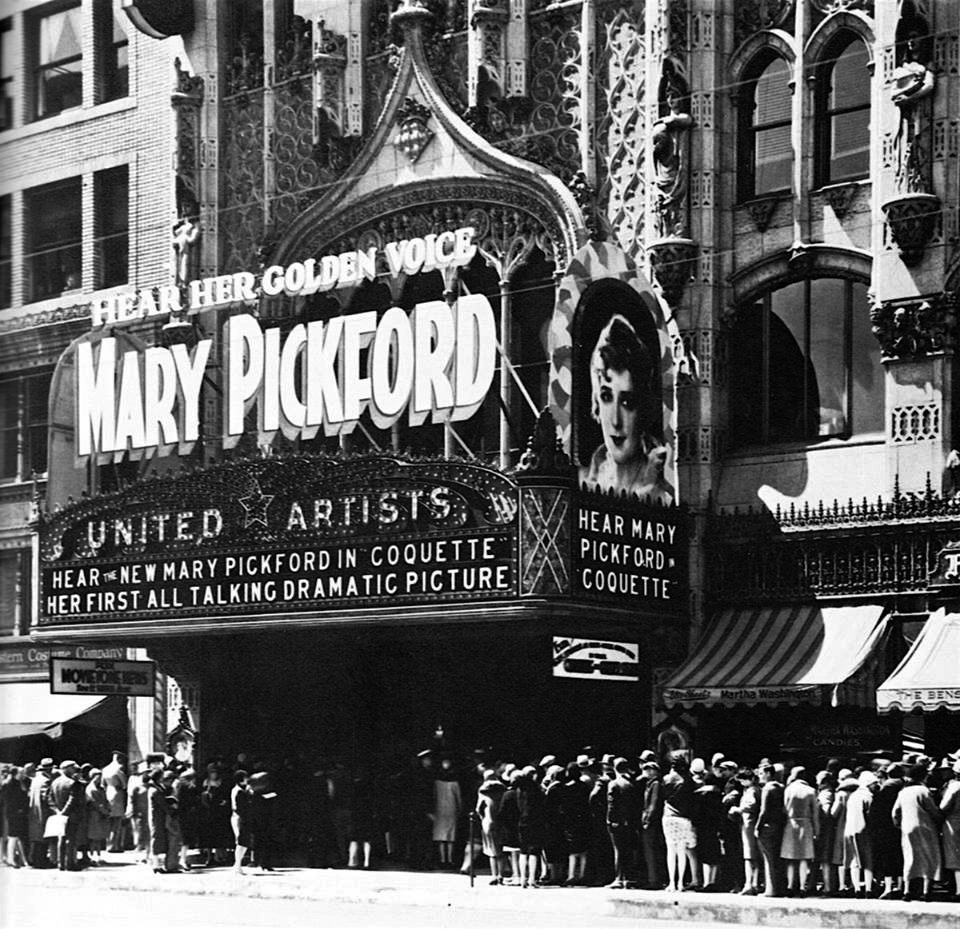 |
|
| (1929)^ – Close-up view showing people in line waiting to see Mary Pickford in "Coquette" - her first talkie - "Hear her golden voice." |
Historical Notes Mary Pickford played a reckless socialite in Coquette (1929), a role for which her famous ringlets were cut into a 1920s' bob. Fans were shocked at the transformation. Pickford's hair had become a symbol of female virtue, and when she cut it, the act made front-page news in The New York Times and other papers. Coquette was a success and won her an Academy Award for Best Actress, although this was highly controversial. The public failed to respond to her in the more sophisticated roles. Like most movie stars of the silent era, Pickford found her career fading as talkies became more popular among audiences. |
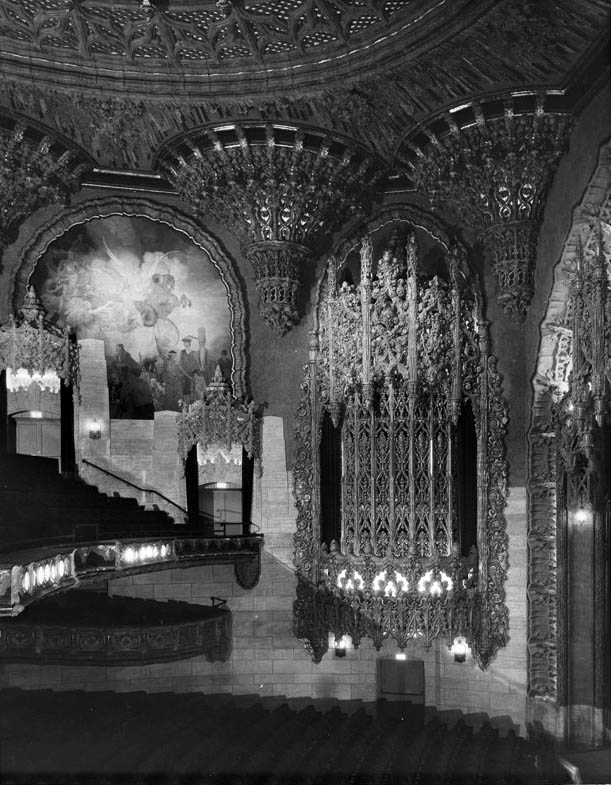 |
|
| (ca. 1927)^*# - Interior view of the United Artists Theatre showing the ornate detail design on walls and ceiling. |
Historical Notes The interior of the theatre was designed by noted theatre interior designer Anthony B. Heinsbergen. In the lobby the ceiling is painted to imitate stained glass, while in the main foyer the vaulted ceiling is painted to resemble tapestries, and has the look of an old Spanish cathedral. An open balcony runs across the foyer at mezzanine level, whilst on the opposite wall are huge gold edged mirrors. Under the foyer was located a private screening room for Mary Pickford. Seating for 2,214 was originally arranged in orchestra, mezzanine and balcony levels. The deep recess in the ceiling is covered with tiny mirrors, which glitter when the cove lighting plays on them. On the two side walls are magnificent murals by Heinsbergen depicting heraldic Medieval scenes with painted characters depicting Fairbanks and Pickford and other Hollywood figures, including the heads of United Artists board members serving in 1927, tacked onto voluptuous bodies of flying gods and goddesses. The organ screens, serving the Wurlitzer 3 manual 17 ranks organ, and the proscenium arch are highly decorated in an elaborate Gothic style.^^# |
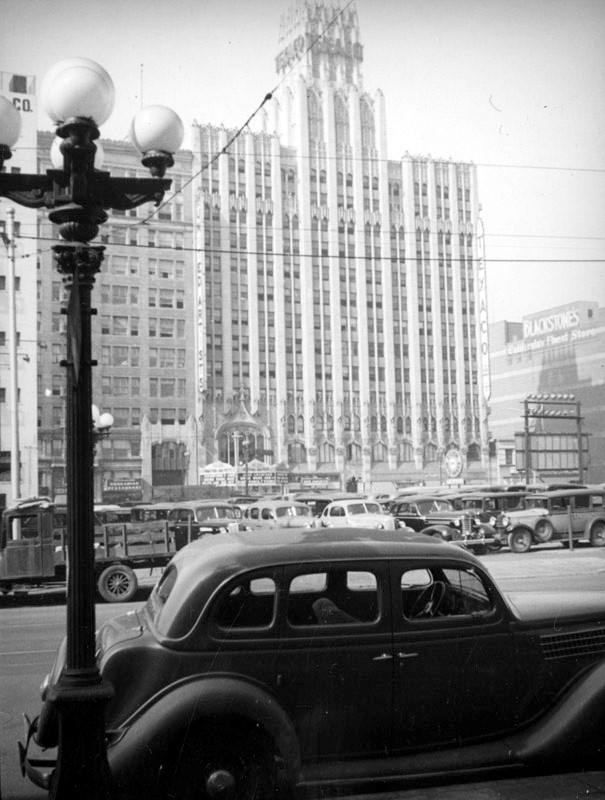 |
|
| (ca. 1937)* - A car is parked on Broadway in this view looking east towards the United Artists Theatre. The theater marquee is visible, as are twin blade signs on either side of the building, one for United Artists, the other for Texaco. Other signs visible include Blackstone's, a Hungarian restaurant, and System Auto Parts. Note the ornate 5-bulb streetlight in the foreground. Click HERE to see more in Early LA Streetlights. |
Historical Notes TIn its later years, the United Artists Theatre was operated by Metropolitan Theatres and it closed as a full time cinema in the summer of 1989, screening Spanish language movies. It briefly became a legitimate playhouse, staging Spanish language comedies, dramas and musical comedies for adults.^^# |
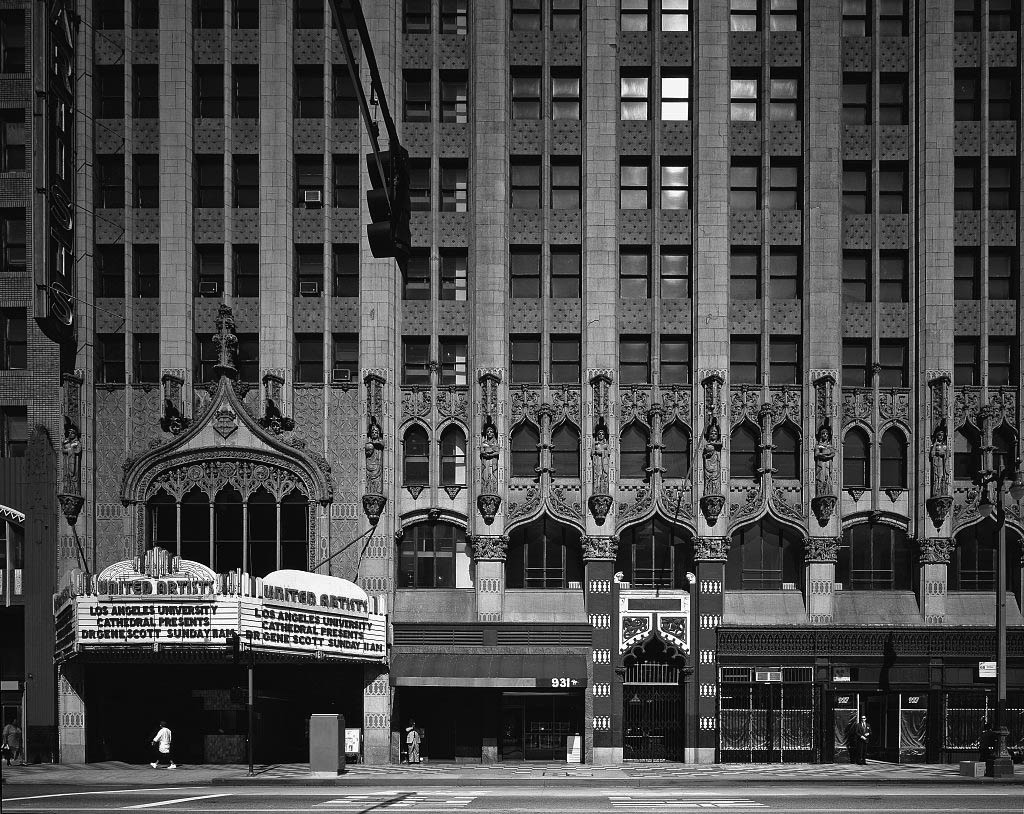 |
|
| (ca. 2010s)*^ – Front view of the United Artists Theatre located at 933 S. Broadway. Photo by Carol M. Highsmith |
Historical Notes In the fall of 1989, United Artists Theatre was taken over by Dr. Eugene Scott for church use. Volunteers from his organization toiled for many hours to remove years of smoke stains and grime from the building, which now looks as good as it did on opening night, back in 1927. The former United Artists Theatre became home for Los Angeles University Cathedral. Upon the death of Dr. Eugene Scott in 2005, the church continued to use the building for a few more years. It was put up ‘For Sale’ in 2010, and was sold in the fall of 2011, to a developer, with plans to convert the office space part of the building into a hotel. In January 2014 the Ace Hotel opened in the former office space fronting the building, and on February 14, 2014 the former United Artists Theatre opened as a concert venue known as the Theatre at the Ace Hotel, when British rock band Spiritualized performed.^^# In 1991, the United Artists Theater Building was designated Los Angeles Historic-Cultural Monument No. 523 (Click HERE to see complete listing). |
* * * * * |
LA Gas and Electric Distribution Station
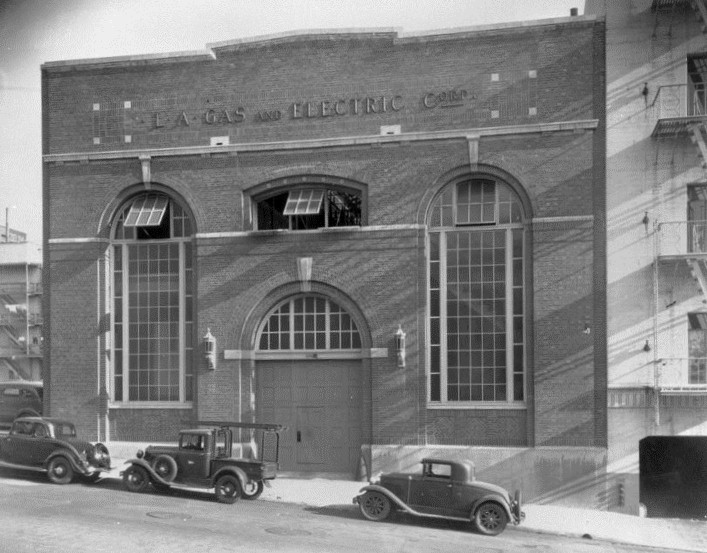 |
|
| (1927)** - Distribution Station No. 42 - 428 South Hope Street. This station was built by LA Gas and Electric Co. which was purchased by the Los Angeles Bureau of Power and Light in 1937. Click HERE to see more in Early Power Distribution Stations. |
Historical Notes In December of 1936 Los Angeles City voters approved a charter amendment authorizing the Bureau of Power and Light to issue revenue bonds in the amount of $46 million and purchase the electrical system of Los Angeles Gas and Electric Corporation. At that time, it was the last remaining privately owned system in LA. In 1937, the Bureau of Water Works and Supply consolidated with the Bureau of Power and Light and became the Los Angeles Department of Water and Power. Click HERE to see more in Electricity in Early Los Angeles. |
* * * * * |
LA Bureau of Power and Light Distribution Station
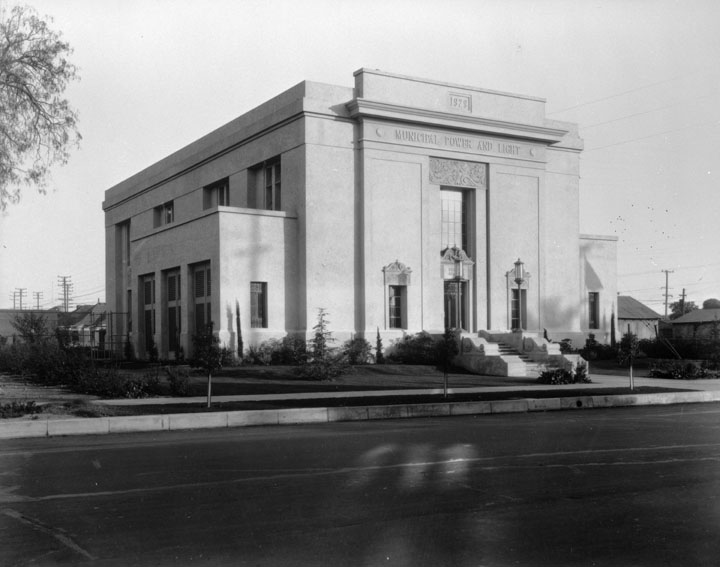 |
|
| (1928)** - Los Angeles Bureau of Power and Light Distribution Station No. 4 - 5736 South Figueroa Street |
Historical Notes Electric utilities use distribution stations to transfer power from the transmission system to the distribution system for a specific service area. It is uneconomical to directly connect electricity customers to the main transmission network, unless they use large amounts of power. Therefore the distribution station reduces voltage to a value suitable for local distribution. In addition to transforming voltage, the substations regulate voltage which ensures a smoother level of power as seen by the customer. Click HERE to see more in Early Power Distribution Stations. |
* * * * * |
Dunbar Hotel (Sommerville Hotel)
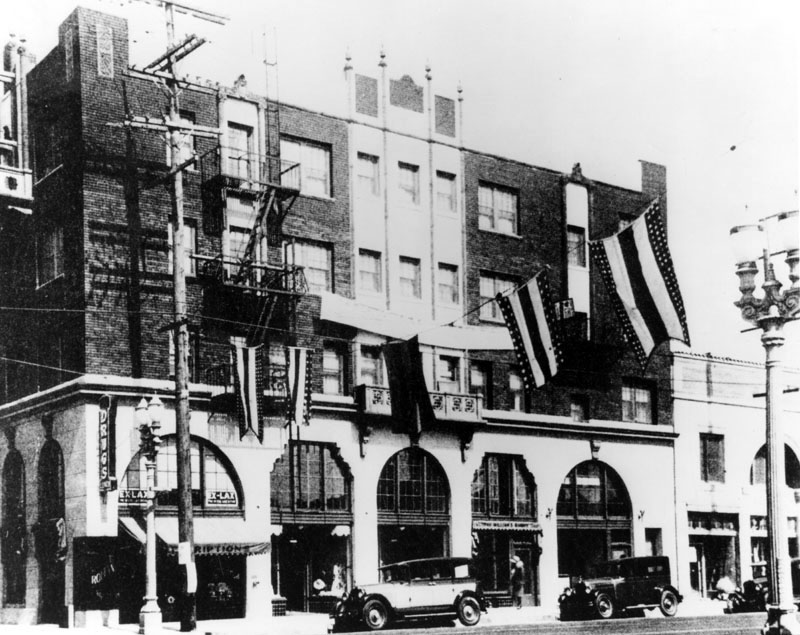 |
|
| (1928)* - Exterior view of the Dunbar (Somerville) Hotel, located at 4227 South Central Avenue. |
Historical Notes The hotel was opened by African-American John Alexander Somerville in 1928 as the Hotel Somerville. Following the stock market crash of 1929, the new owners renamed it after the African-American poet Paul Lawrence Dunbar.* John Somerville is also known as being USC's first black graduate. |
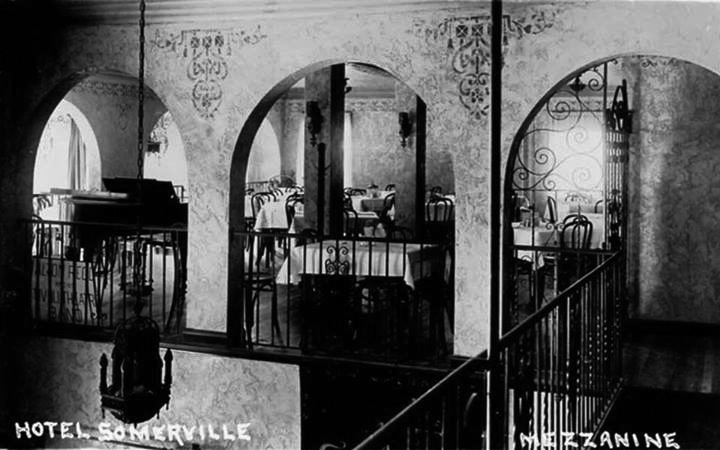 |
|
| (1928)^#** - View of the Mezzanine of the Hotel Somerville where you could see many of the top Jazz performers of the day. |
Historical Notes The Dunbar is a culturally significant building in Los Angeles' history because it was the social scene for the African-American community during the Jazz Age and beyond. Just about every performer of importance stayed and played here: names like Lionel Hampton, Duke Ellington, Nina Mae McKinney, Dorothy Dandridge, Billie Holiday, Nat King Cole...the list really goes on and on.^#** In 1974, the Dunbar (Somerville) Hotel was designated L.A. Historic-Cultural Monument No. 131 (Click HERE to see complete listing. |
.jpg) |
|
| (ca. 1938)^^ - Postcard view of the Dunbar (Somerville) Hotel located on the corner of Central Avenue and 42nd Place. |
Historical Notes Printed at the bottom of the postcard: "115 rooms, 75 rooms with bath. Rates $1.00 per day and up. Weekly rates $5.00 and up" "The Dunbar Hotel is known as the "House of hospitality." Thermostatically controlled steam heat and hot water, 24-hour elevator service, telephones in all rooms, and shops in conjunction--for your comfort. Jas. C. Nelson, Prop., Kathryn Nelson, Mgr."--printed on verso.* |
* * * * * |
Golden Gate Theater
 |
|
| (1927)* – View looking at the southwest corner of Atlantic and Whittier Boulevards in East Los Angeles, site of the Golden Gate Theater as part of the Vega Building Complex. |
Historical Notes The Golden Gate Theater was a historic movie palace located in East Los Angeles that has a rich and complex history. Built in 1927 by developer Peter Snyder and designed by architects William and Clifford A. Balch, the theater was a significant cultural landmark on Whittier Boulevard. The theater was notable for its Churrigueresque architectural style, with an entrance modeled after the portal of Spain's University of Salamanca. It could seat approximately 1,500 people and was originally part of the L-shaped Vega Building complex, which included 13 stores and apartment units. |
 |
|
| (1930)* – View looking east on Whittier Boulevard toward Atlantic, showing the Vega Building Complex on the southwest corner. Also seen here is one of the two entrances to the Golden Gate Theatre |
Historical Notes Located at 5176 East Whittier Boulevard in East Los Angeles, the Golden Gate Theater was built in 1927, designed by William and Clifford A. Balch, whose other notable contributions include the El Rey Theater on Wilshire Boulevard and the Fox Theater in Pomona. The Golden Gate Theater was designed as a playhouse and movie theater and was built in the Spanish Baroque Revival Churrigueresque-style replicating the entrance to the University of Salamanca in Spain. |
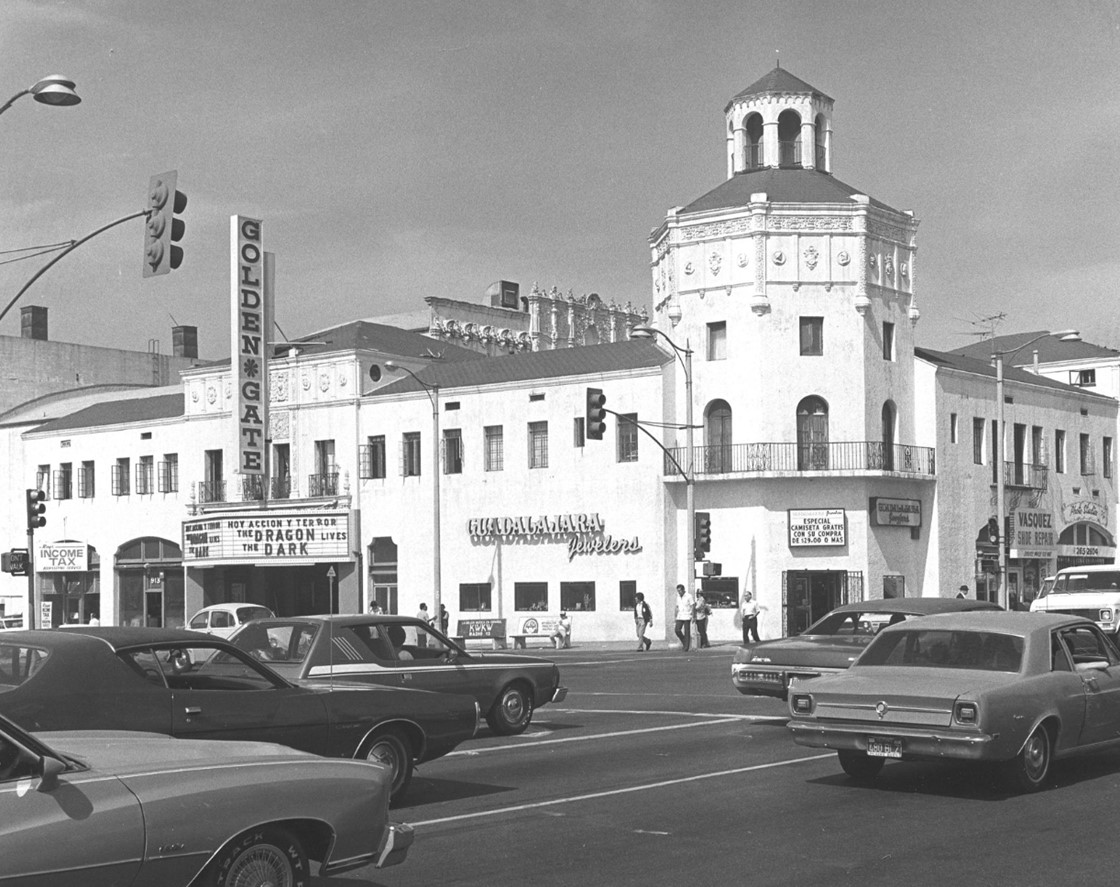 |
|
| (1980)*- View of the Golden Gate Theater, part of the Spanish Baroque Revival Churrigueresque-style Vega Building complex, on the southwest corner of Whittier and Atlantic Boulevards. Photo by William Reagh. |
Historical Notes Throughout its history, the Golden Gate Theater played a crucial role in East Los Angeles community life. In the 1920s and 1930s, it showed silent films accompanied by organ and orchestra music. By the 1960s, it hosted live acts, rock concerts, and variety shows. In the 1970s, it began showing films with Spanish subtitles, reflecting the changing demographic of the neighborhood. |
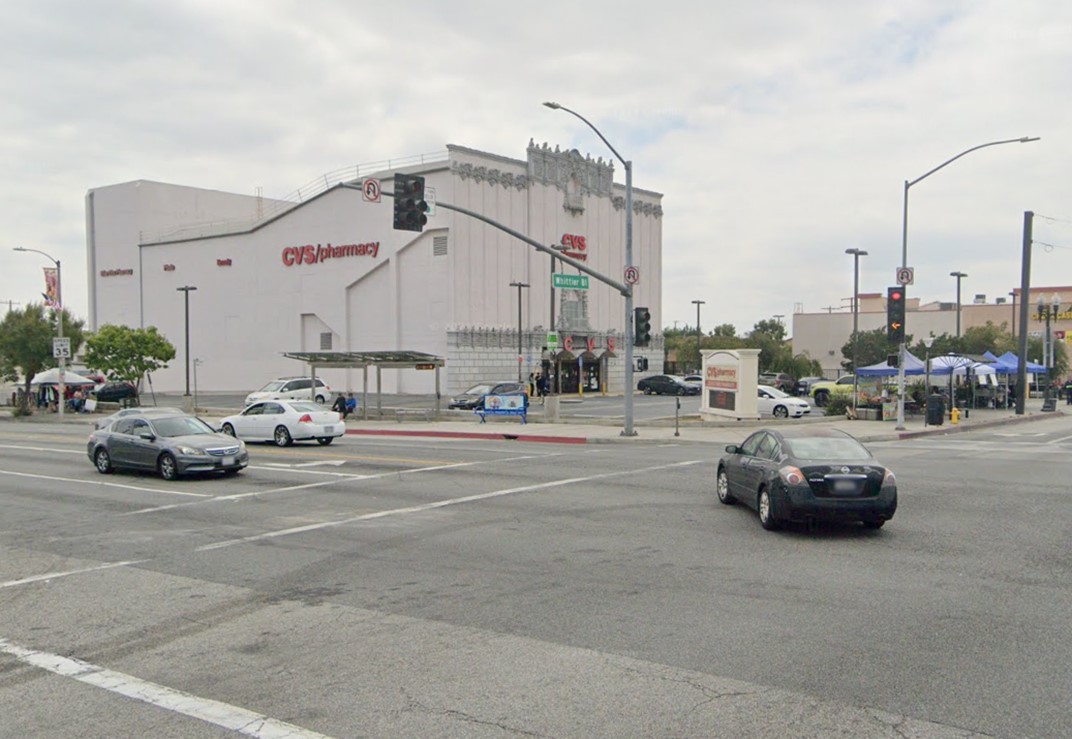 |
|
| (2024)* – Looking at the southwest corner of Whittier and Atlantic Boulevards showing a CVS Pharmacy in part of the building that once housed the Golden Gate Theater. |
Historical Notes Originally, the theater was accessed by entrances into the courtyard of the historic Vega Building, an L-shaped retail and apartment building, which surrounded the theater. Damage from the 1987 Whittier earthquake caused the Vega Building to be deemed unsafe and later demolished, and left the 1,500 seat Golden Gate Theater vacant. Many battles followed over the preservation and re-development of the historic site. It is one of a few neighborhood movie palaces left in Southern California and is the only building in East Los Angeles listed in the National Register of Historic Places. In 2012, the building was re-opened and adapted for use as a CVS retail pharmacy. |
Then and Now
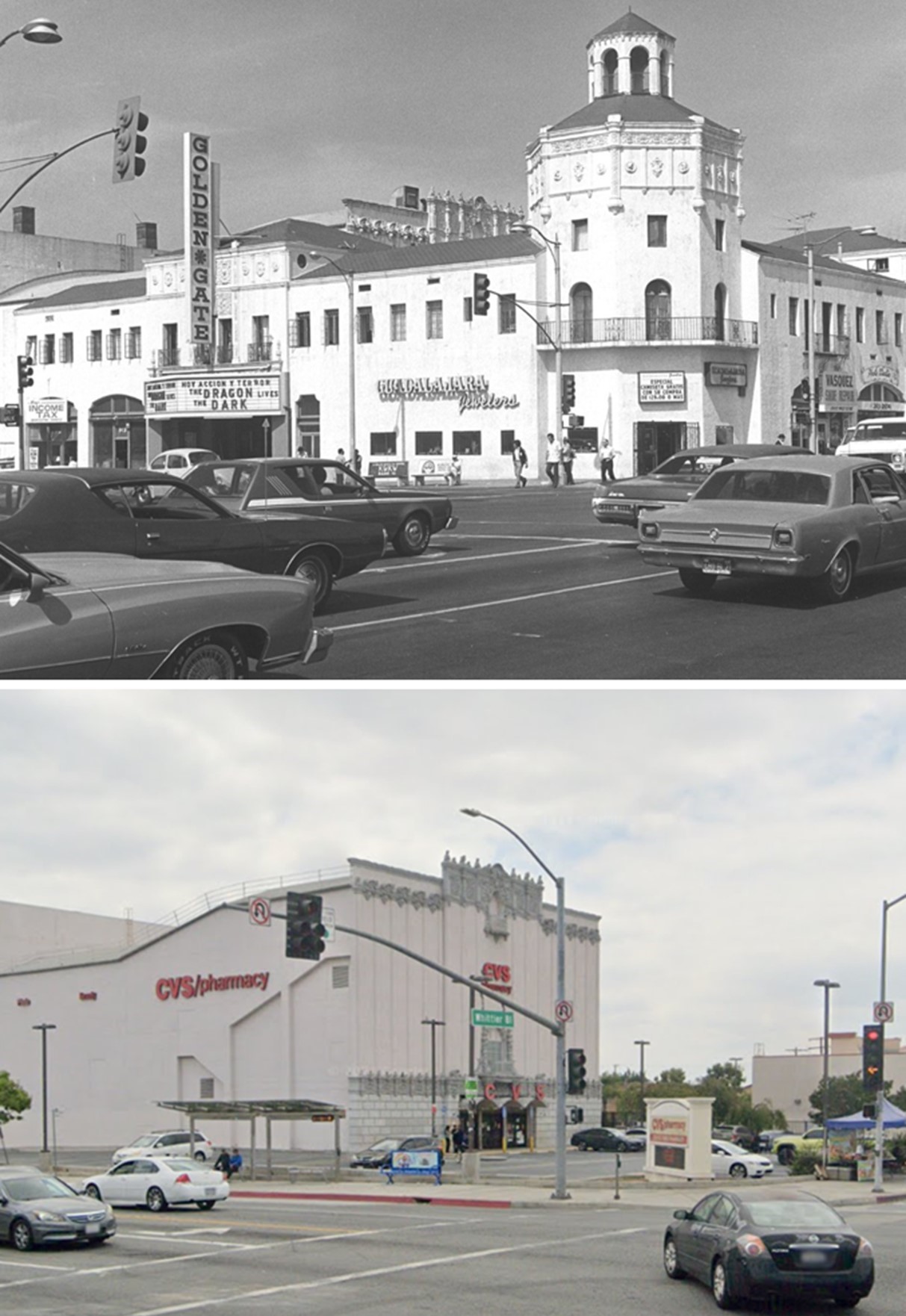 |
|
| (1980 vs. 2024)* – A ‘Then and Now’ comparison of the Golden Gate Theater, now a CVS pharmacy on the southwest corner of Whittier and Atlantic Boulevards. The 1987 Whittier earthquake severely damaged the Vega Building, rendering it unsafe and leading to its demolition, leaving only the theater portion standing. By 2012, the remaining structure was repurposed and reopened as a CVS pharmacy. Photo comparison by Jack Feldman. |
* * * * * |
Sears Building (Boyle Heights)
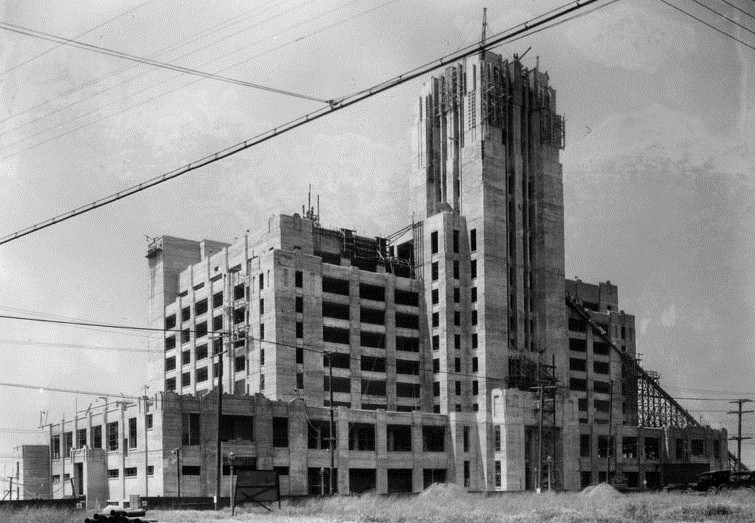 |
|
| (1927)* - Construction of the Sears store on Soto Street and Ninth Street (later Olympic Boulevard), Boyle Heights, on May 4, 1927. |
Historical Notes In December 1926, Sears, Roebuck and Company of Chicago announced that it would build a nine-story, height-limit building on East Ninth Street (later renamed Olympic Boulevard) at Soto, in the Boyle Heights section of Los Angeles. The building, intended to serve as a mail order distribution center for the Rocky Mountain and Pacific Coast states, was constructed by Scofield Engineering Company. Architectural work was handled by George Nimmens Company.^ |
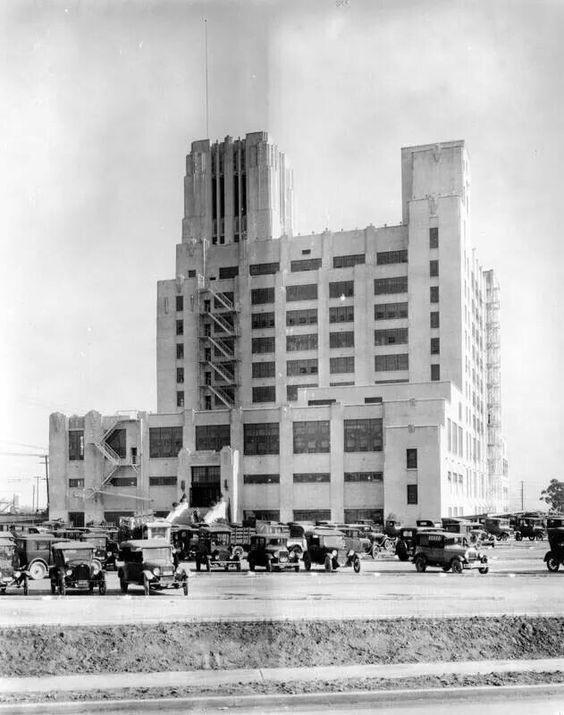 |
|
| (1927)* - Exterior view of the Sears store on Soto Street and Olympic Boulevard, Boyle Heights, with cars in the parking lot and the doors open. |
Historical Notes The building was erected in just six months using materials that were all made in Los Angeles County, with the exception of the steel window sashes. To accomplish the feat, the contractor had six steam shovels and a large labor force working night and day shifts. It was reported that rock and sand for the cement work were being delivered to the site at the rate of twenty carloads daily. When the building was completed in late June 1927, the Los Angeles Times reported that the construction was believed to have set a record: “All records for the erection of a huge structure were believed to have been broken when last week the Scofield Engineering Construction Company turned over the new $5,000,000 department store and mail-order house at Ninth street and Boyle avenue to Sears, Roebuck & Co., having completed this height-limit project in 146 working days, or 171 days of elapsed time.” ^ |
 |
|
| (1927)* - View showing the Boyle Heights Art Deco Sears building with cars in the parking lot, 2650 E. Olympic Blvd. |
Historical Notes Sears, Roebuck & Company Mail Order Building was built as a distribution center for the company's mail order department. The building served that function until 1992, when Sears closed its Los Angeles distribution center and sold the building. Though Sears still operates a retail store on the ground floor, the rest of the enormous complex has remained vacant since 1992. The 1,800,000-square-foot complex, considered one of the iconic landmarks of LA's Eastside, has been the subject of several renovation proposals since the mid-1990s. In 2007 and 2008, Boyle Heights native Oscar de la Hoya made two bids to acquire the property, with plans to convert the complex into retail and residential space.^ |
 |
|
| (ca. 1929)* - Exterior view of the Sears store on Soto Street and Olympic Boulevard, Boyle Heights. It has camping supplies for sale, with tents erected in the parking lot. In the foreground is a vacant lot at a level higher than the street. It has a sign, "Elect Werner City Attorney." |
Historical Notes From 1927 to 1991, the building was operated both as a mail order distribution center serving the Western United States and as a retail store operating on the ground floor. The sprawling mail order distribution center was a marvel of modern technology when it opened, with employees filling orders by roller skating around the enormous facility, picking up items and dropping them onto corkscrew slides for distribution by truck or rail. The building was one of the largest in Los Angeles, and it attracted more than 100,000 visitors in its first month of operation, not including shoppers at the ground floor retail store.*^ |
 |
|
| (n.d.)***# - View of the Art Deco Tower of the old Boyle Heights Sears building shot at night. In the foreground is the Sears gas station. |
Historical Notes In 2004, the Boyle Heights Sears building was designated Los Angeles Historic-Cultural Monument No. 788 (Click HERE to see complete listing). It was also listed in the National Register of Historic Places on April 21, 2006 - #05001407. |
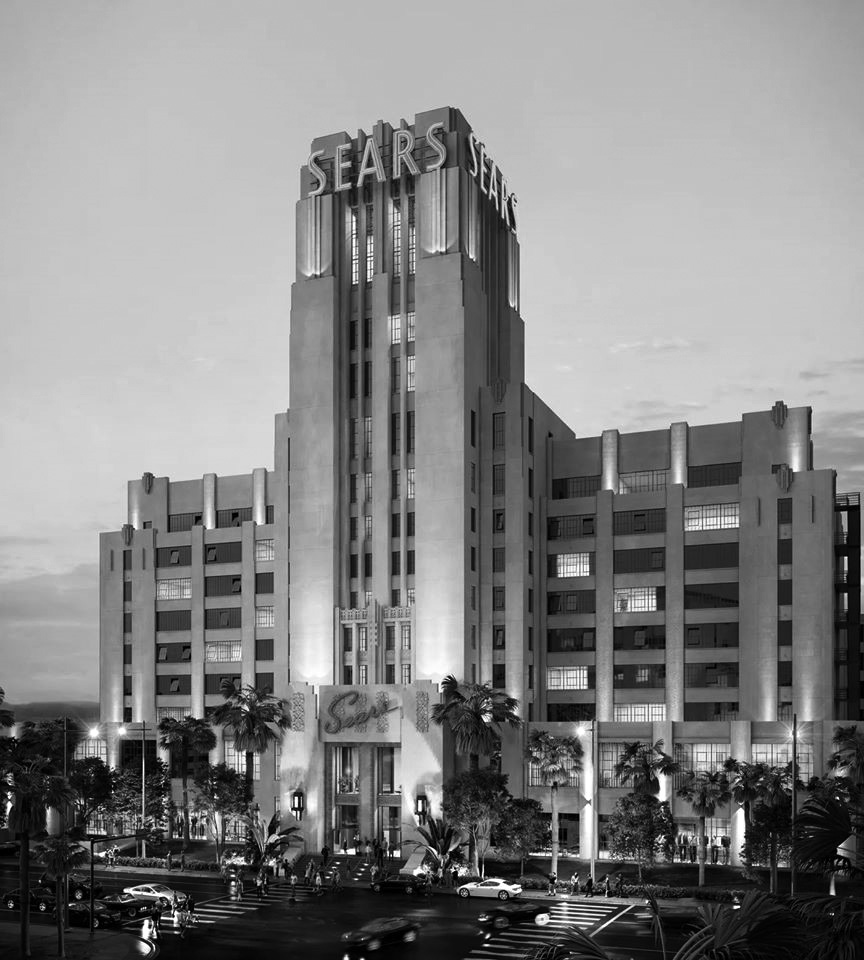 |
|
| (2017)^ - Artist rendering showing front view of the Sears building with its iconic illuminated sign after a proposed remodel and redtrofit. Rendering courtesy of The Shomof Group |
Historical Notes Developer Izek Shomof wants to transform the historic Art Deco tower and the vacant 10-story distribution center that’s attached to it into a lively mixed-use campus with a food hall, offices, event space, rooftop restaurant, and more than 1,000 live-work units. The sprawling Sears structure encompasses an entire city block on Olympic Boulevard, and the new renderings show that architecture firm Omgivning plans to carve nine “light courts” into the former distribution center to flood the spaces with air and sunshine. Throughout, there will be an abundance of windows, plus concrete and exposed ducting for a distinctly industrial vibe (it matches the designs of what’s being built in the nearby Arts District.) Shomof is dubbing the project the Mail Order District in honor of the building’s history. It was one of nine distribution centers that Sears erected from 1910 to 1929 to fulfill catalog orders, and it once employed more than 1,000 workers. Penthouses will be added to the top of the tower, and the 12th floor rooftop of the former distribution center will become a restaurant with a pool and outdoor patio. The 11th floor rooftop will be devoted to amenities for residents, including a separate pool and spa, plus basketball and volleyball courts and a gym. |
* * * * * |
Sparkletts Bottled Water Corp.
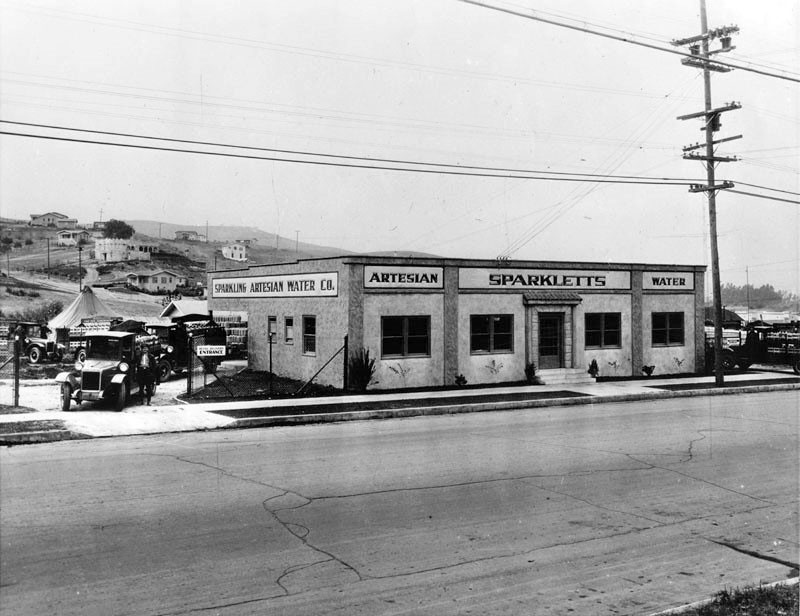 |
|
| (1929)* – View showing the first bottling plant for Sparkletts Bottled Water Corp, at 4500 York Boulevard in Highland Park. |
Historical Notes In the 1920s, Eagle Rock resident Burton N. Arnds Sr. found the taste of the municipal water supply “to be lacking,” according to an L.A. Times story. Within a few years, Arnds and partners opened a water bottling plant supplied by a well near what is now York Boulevard and Avenue 48. The Sparkling Artesian Water Co. was later renamed Sparkletts as demand for bottled water skyrocketed with the arrival of newcomers. It was one of several Northeast L.A. bottling plants that captured and sold water tapped from underground wells and streams. #^^# |
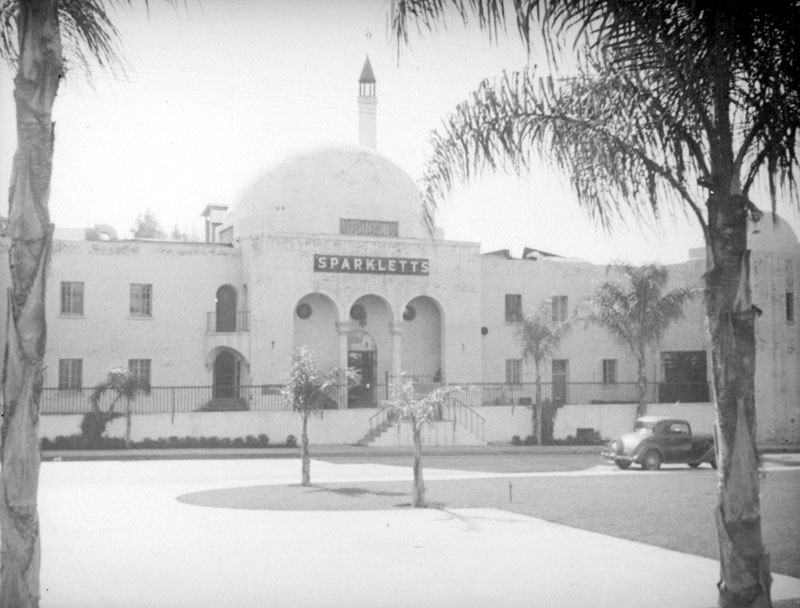 |
|
| (1930s)* - View of the arched entryway of the Moorish style bottling plant and corporate headquarters for Sparkletts Bottled Water Corporation, located at 4500 York Boulevard, in Eagle Rock. |
Historical Notes In 1929, Sparkletts broke ground on a much larger, $200,000 bottling plant that today stretches across most of the 4500 block of Lincoln Avenue. The firm hired architect Richard King to create a massive brick building topped by several domes in what looks like an effort to give the box-like industrial structure a Moorish-style ambiance. the new bottling plant featured a then modern production facility that, according to a 1929 L.A. Times article, was home to what the firm “claimed to be the largest, five-gallon bottle sterilizer in the world, with a capacity of 1,800 bottles per hour." #^^# |
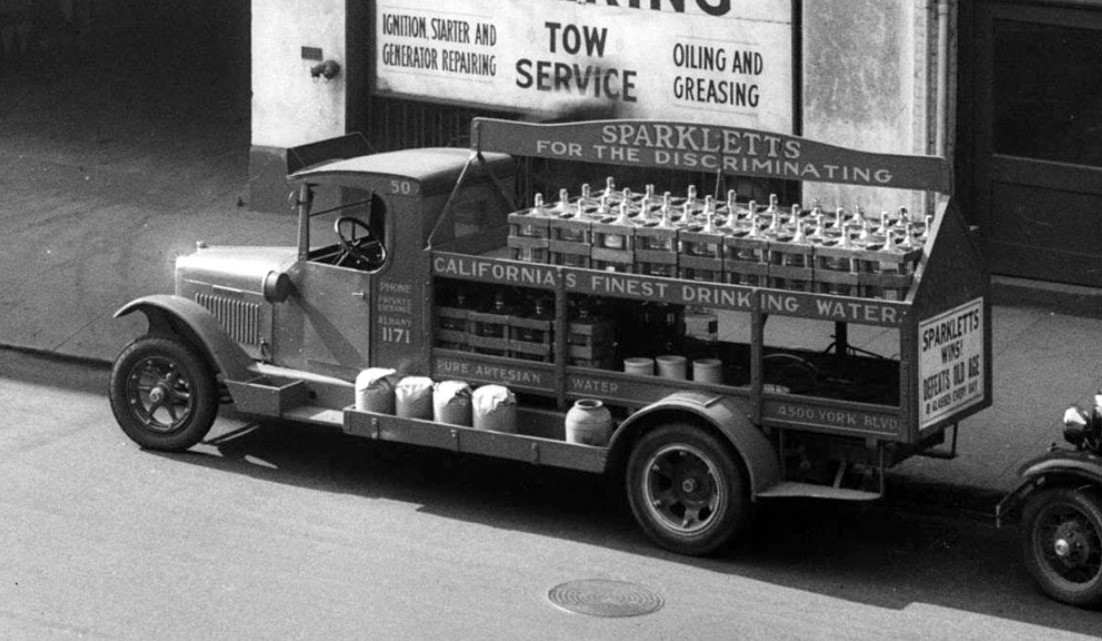 |
|
| (1931)^#^^ – View showing a Sparkletts delivery truck in the 200 block of S. Los Angeles Street. Sign on truck reads: “Sparkletts for the Discriminating”. |
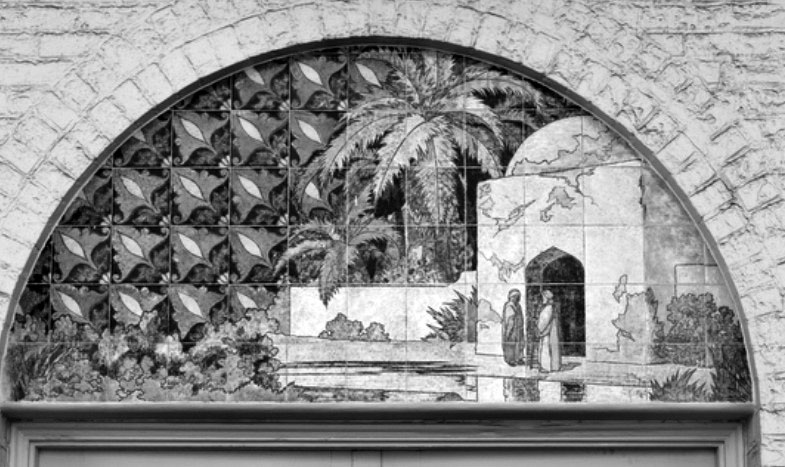 |
|
| (2013)* – Mural over the main entrance to the Sparkletts Building. Photo courtesy of The Eastsider. |
Historical Notes Over the main entrance, which is topped by the largest dome, a tile mural depicts what looks like an oasis, with a pool of water, palm trees and two figures dressed in flowing robes standing in front of a domed building. |
* * * * * |
Tower Theatre
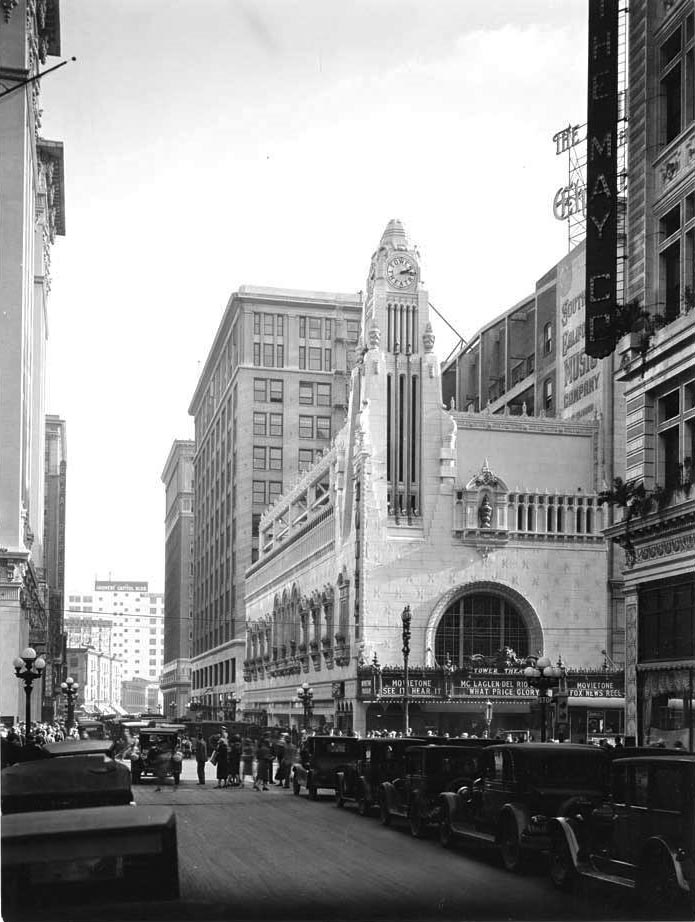 |
|
| (1927)* – View looking east on 8th Street toward Broadway where the newly constructed Tower Theatre stands tall on the southeast corner. Now playing: “What Price Glory?” with Victor McLaglen and Delores Del Rio. The May Co. Building is seen on the right (S/W corner). |
Historical Notes The Tower Theatre, at 802 S. Broadway, opened in 1927. It was commissioned by H.L. Gumbiner, who would later also build the Los Angeles Theatre in 1931. The Tower was the first theater designed by architect S. Charles Lee.* |
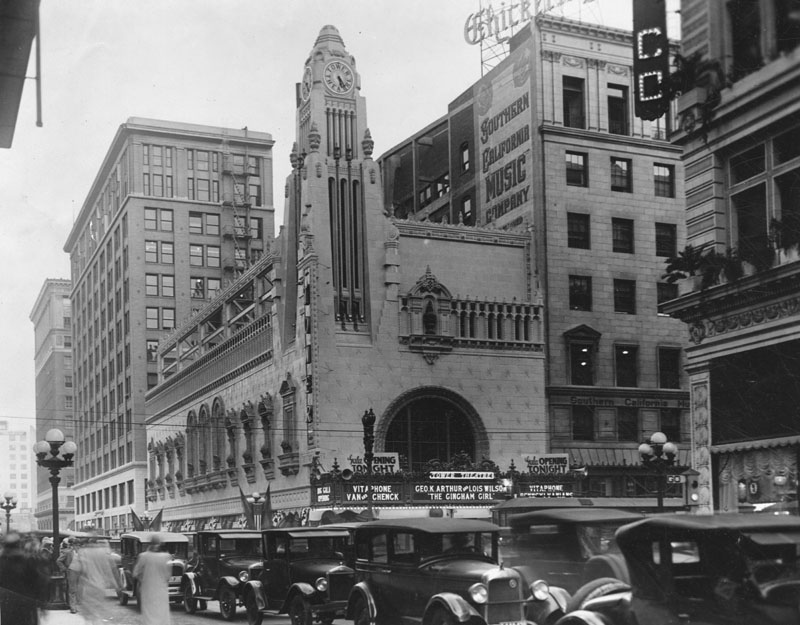 |
|
| (1927)* - Exterior view of the Tower Theatre, at S. Broadway and W. 8th Street, featuring "The Gingham Girl", starring George K. Arthur and Lois Wilson. The Southern California Music Company building can be seen just south of the theatre. |
Historical Notes Seating 900 on a tiny site, it was designed in powerful Baroque style with innovative French, Spanish, Moorish, and Italian elements all executed in terra-cotta. Its interior was modeled after the Paris Opera House. Its exterior features a prominent clock tower, the very top of which was removed after an earthquake. It opened in 1927 with the silent film The Gingham Girl starring Lois Wilson and George K. Arthur.* The Tower Theatre was built on th site of the old Garrick Theatre. |
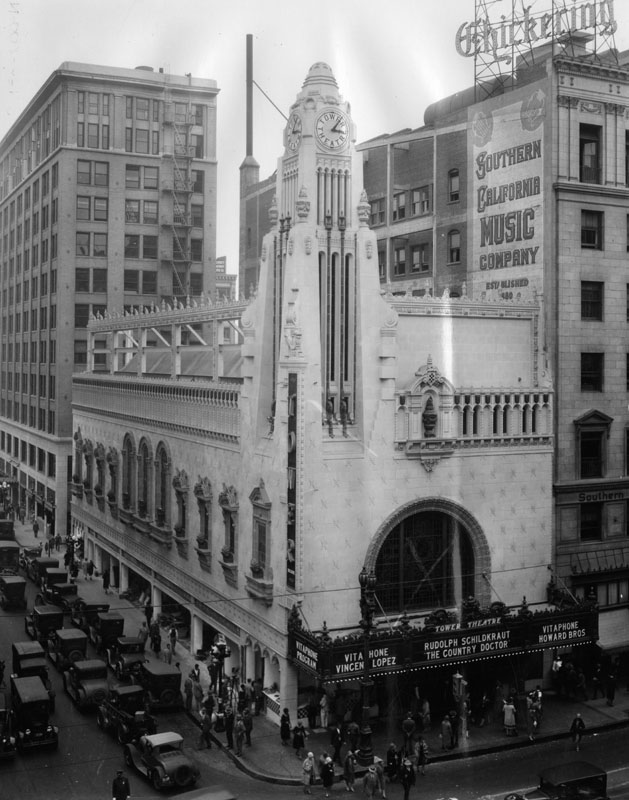 |
|
| (1927)* - Exterior corner view of the Tower Theater, located 802 S. Broadway. On the two sides of the marquee: Vitaphone program; Vita phone Vincent Lopez; Rudolph Schildkraut The Country Doctor; Vitaphone Howard Bros. |
Historical Notes The Tower Theater was the first film house in Los Angeles to be wired for talking pictures, and it was the location of the sneak preview and Los Angeles premiere of Warner Bros.' revolutionary part-talking The Jazz Singer (1927), starring Al Jolson. It was also the first theater in Los Angeles to be air conditioned.* |
.jpg) |
|
| (ca. 1928)* - Detail close-up view showing the 8th Street side of the Tower Theatre designed by architect S. Charles Lee, his first theatrer design. It was designed in powerful Baroque style with innovative French, Spanish, Moorish, and Italian elements all executed in terra-cotta. |
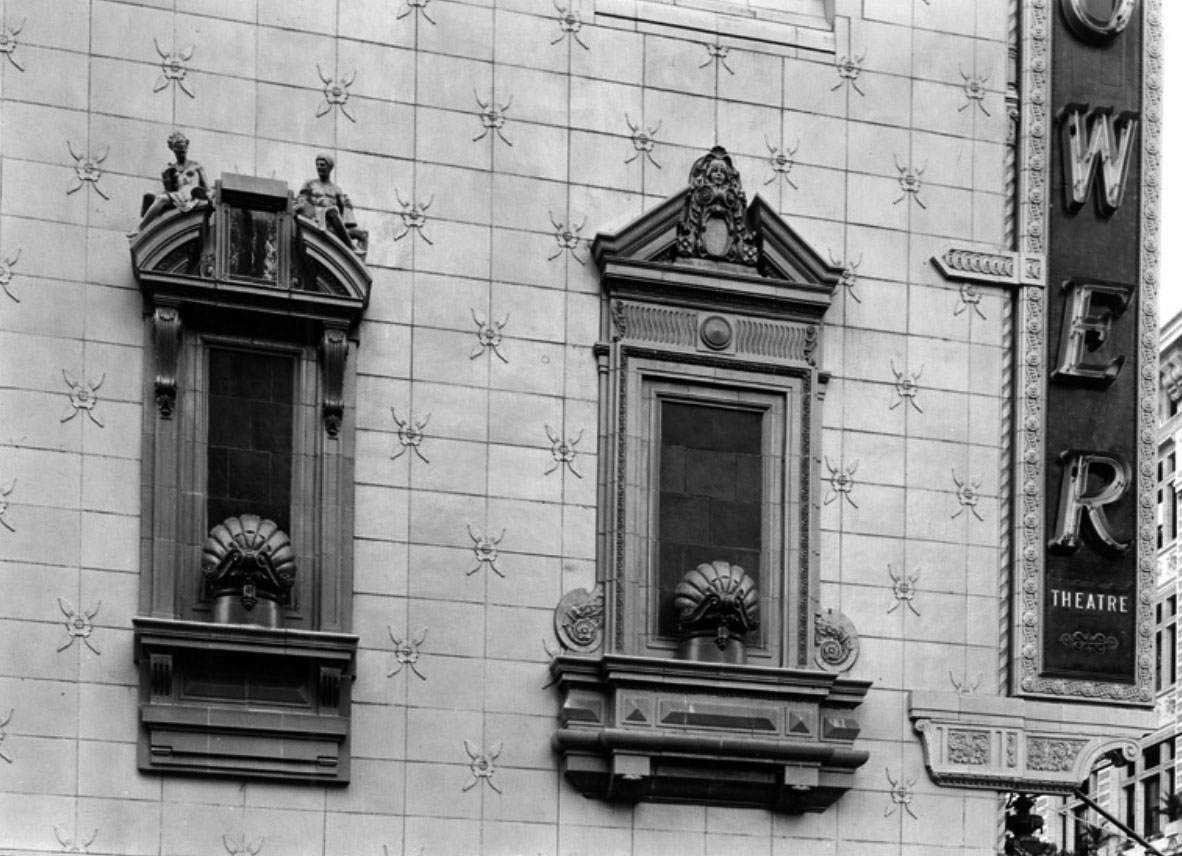 |
|
| (ca. 1928)* - Detail view showing the ornate terra-cotta design features on the Tower Theatre. |
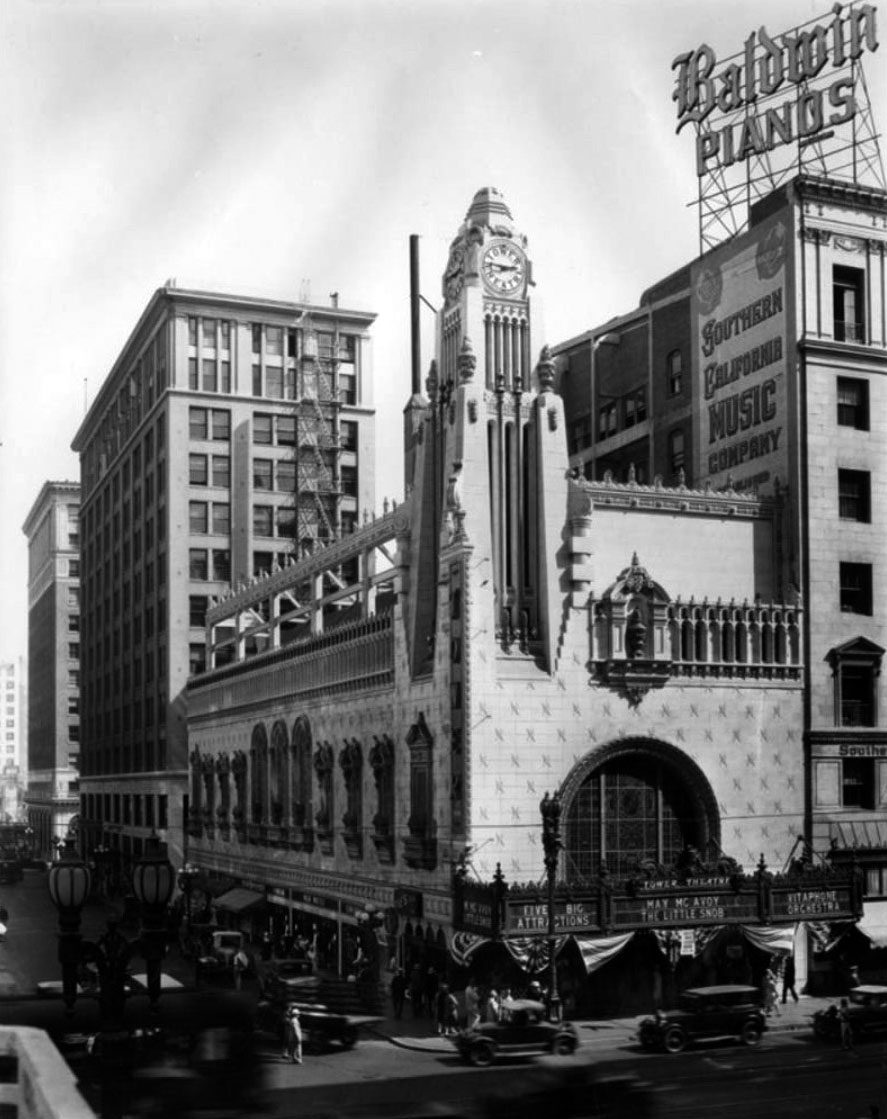 |
|
| (1928)* - Looking southeast across the intersection of Broadway and 8th Street towards the Tower Theatre. The marquee is in 4 sections and advertising: May McAvoy; The Little Snow ; Vitaphone Orchestra; Five Big Attractions. The building behind shows the name Southern California Music Company and has a sign on top of the building for Baldwin pianos. |
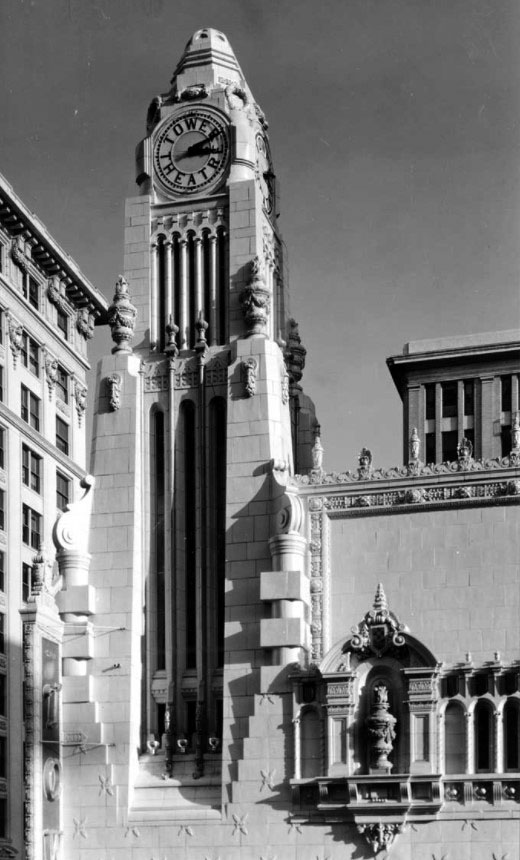 |
|
| (1928)* – Close-up detail view of clock tower on the corner of the Theatre. |
 |
|
| (1928)^^ – Street view looking south on Broadway at 8th Street showing the Tower Theatre at the end of the street to the left (S/E corner), its clock tower reading approximately thirty-nine minutes after two o'clock, behind which the Southern California Music Company building, Wurlitzer Building, Platt Music Company building and the New Orpheum can be seen, respectively. Automobiles, pedestrians and a cable-car navigate the street to the right. |
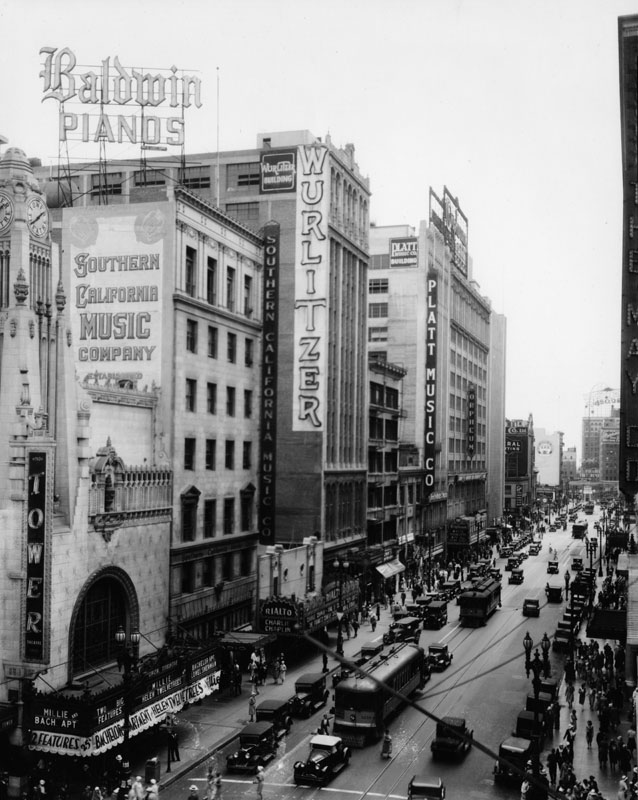 |
|
| (ca. 1931)* - View looking south on Broadway from 8th Street, showing (left to right): The Tower Theater, Southern California Music Company, Wurlitzer Building, Rialto Theater, Platt Music Company, and the Orpheum Theater. A very large and prominent Baldwin Pianos sign sits on top of the Southern California Music Co. Building. |
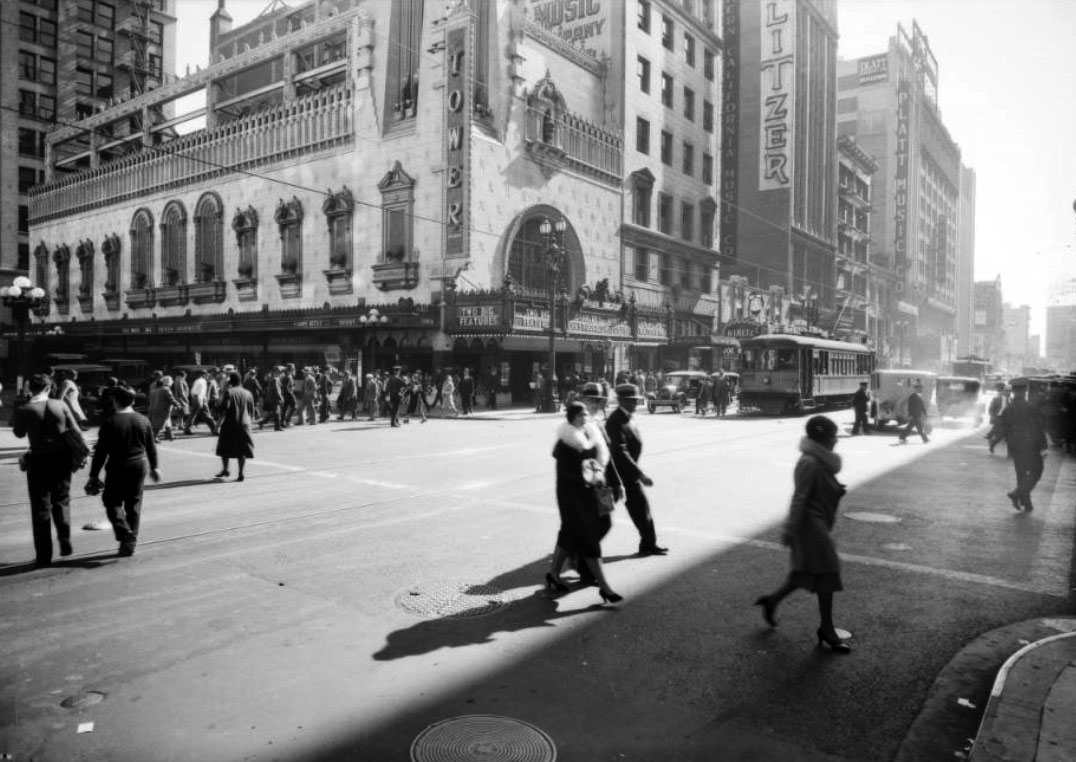 |
|
| (1931)^^ - View looking toward the Tower Theater at 8th and Broadway. Traffic is stopped as people cross the intersection in all directions. Photo by Dick Whittington |
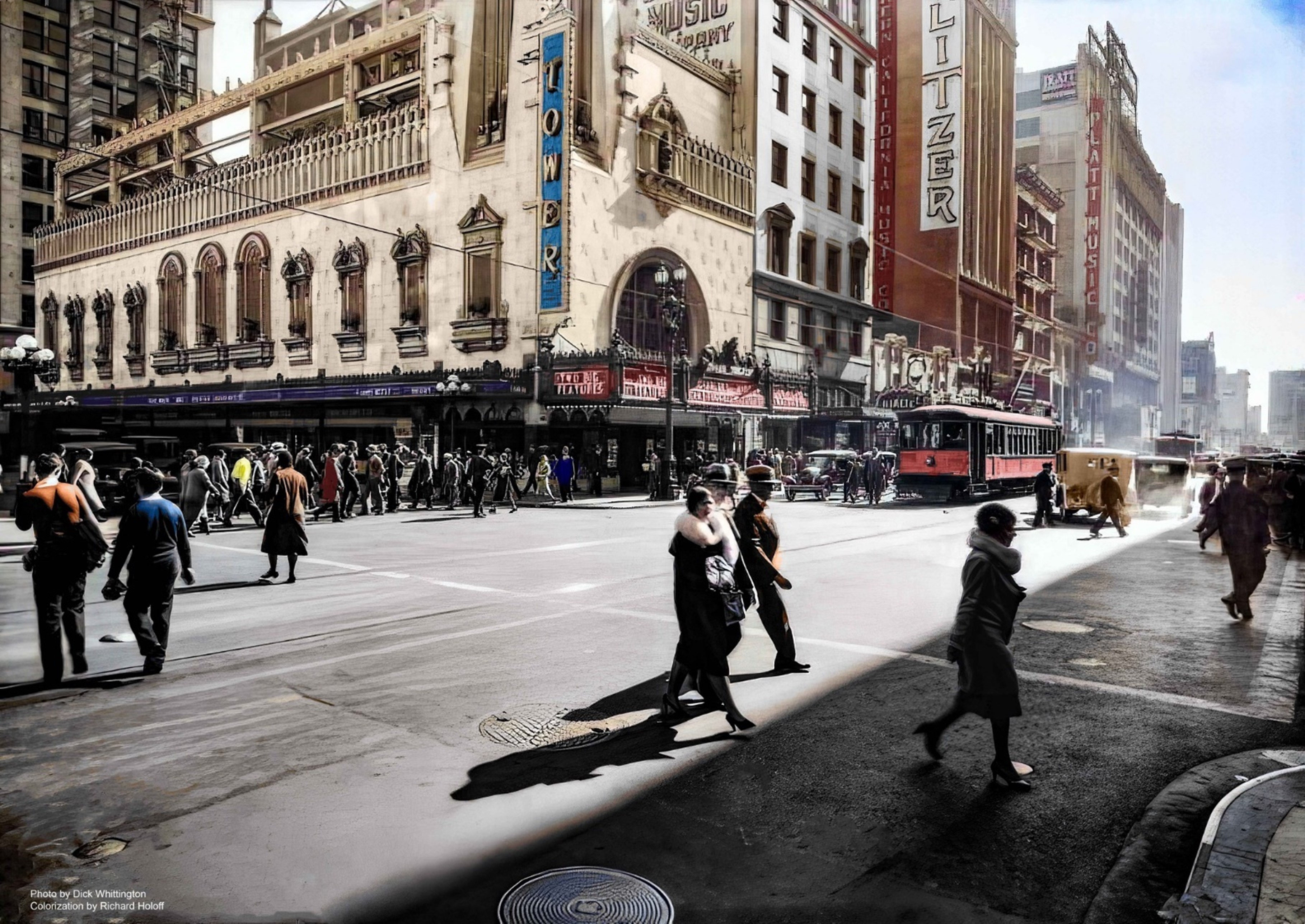 |
|
| (1931)^^ - View looking toward the Tower Theater at 8th and Broadway. Traffic is stopped as people cross the intersection in all directions. Photo by Dick Whittington; Image enhancement and colorization by Richard Holoff |
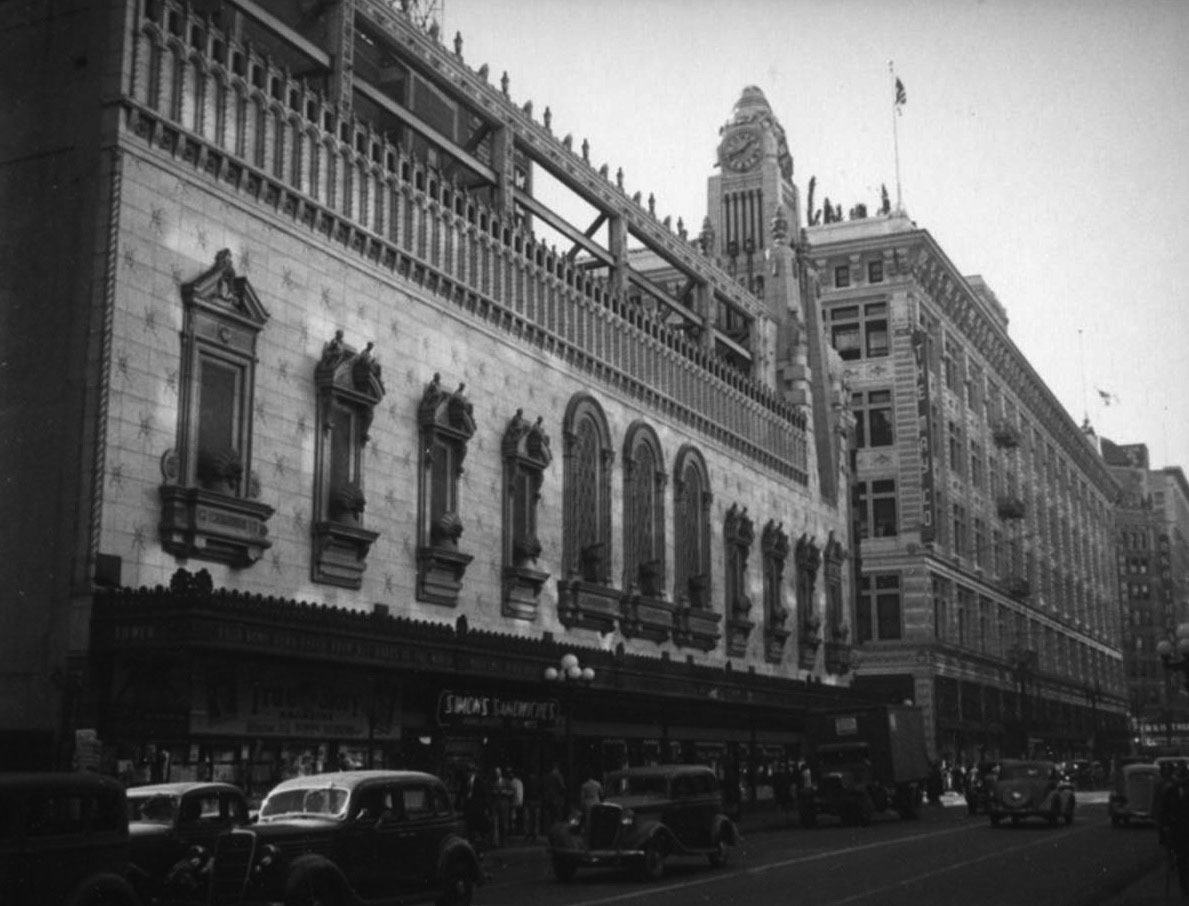 |
|
| (ca. 1937)* – Looking west on 8th Street toward Broadway showing the Tower Theatre on the left (SE Corner). Across the street (SW Corner) stands the May Company Building. Photo by Herman Schultheis |
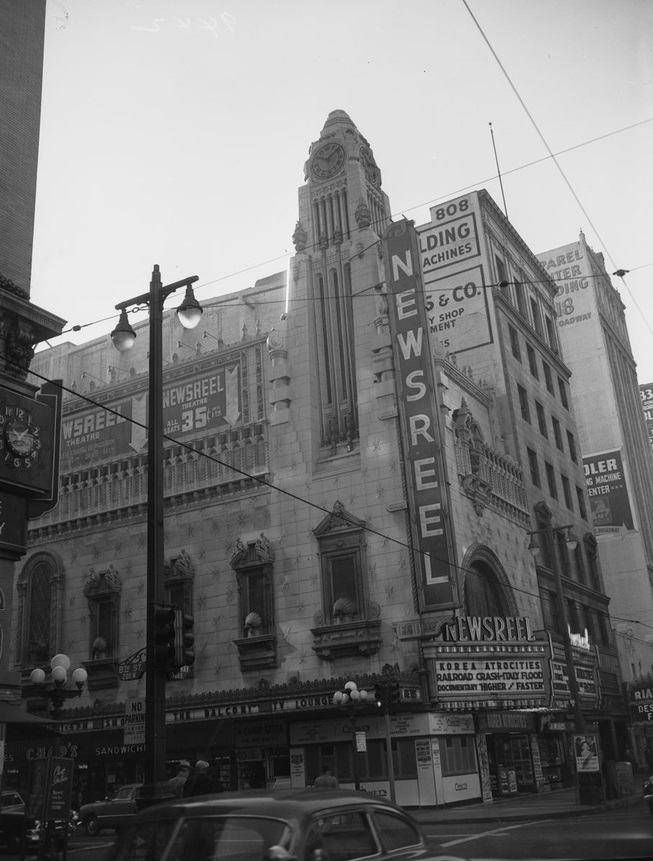 |
|
| (1951)^^ - View of the Newsreel Theater (aka The Tower Theater) on the corner of Broadway and 8th Street. |
Historical Notes In 1950, the theatre began a successful period of running only newsreels, aptly taking on the name, Newsreel Theatre. That signage can still be faintly seen on the north and east sides of the building. It also served as a general-run theatre under the name Music Hall Downtown. In 1965, the theatre was renamed the Tower Theatre. During the 1990s, the Tower became a popular location for film production, including the Warner Bros. film, Mambo Kings.* In 1989, the Tower Theater was designated as Los Angeles Historic-Cultural Monument No. 450 (Click HERE to see complete listing). |
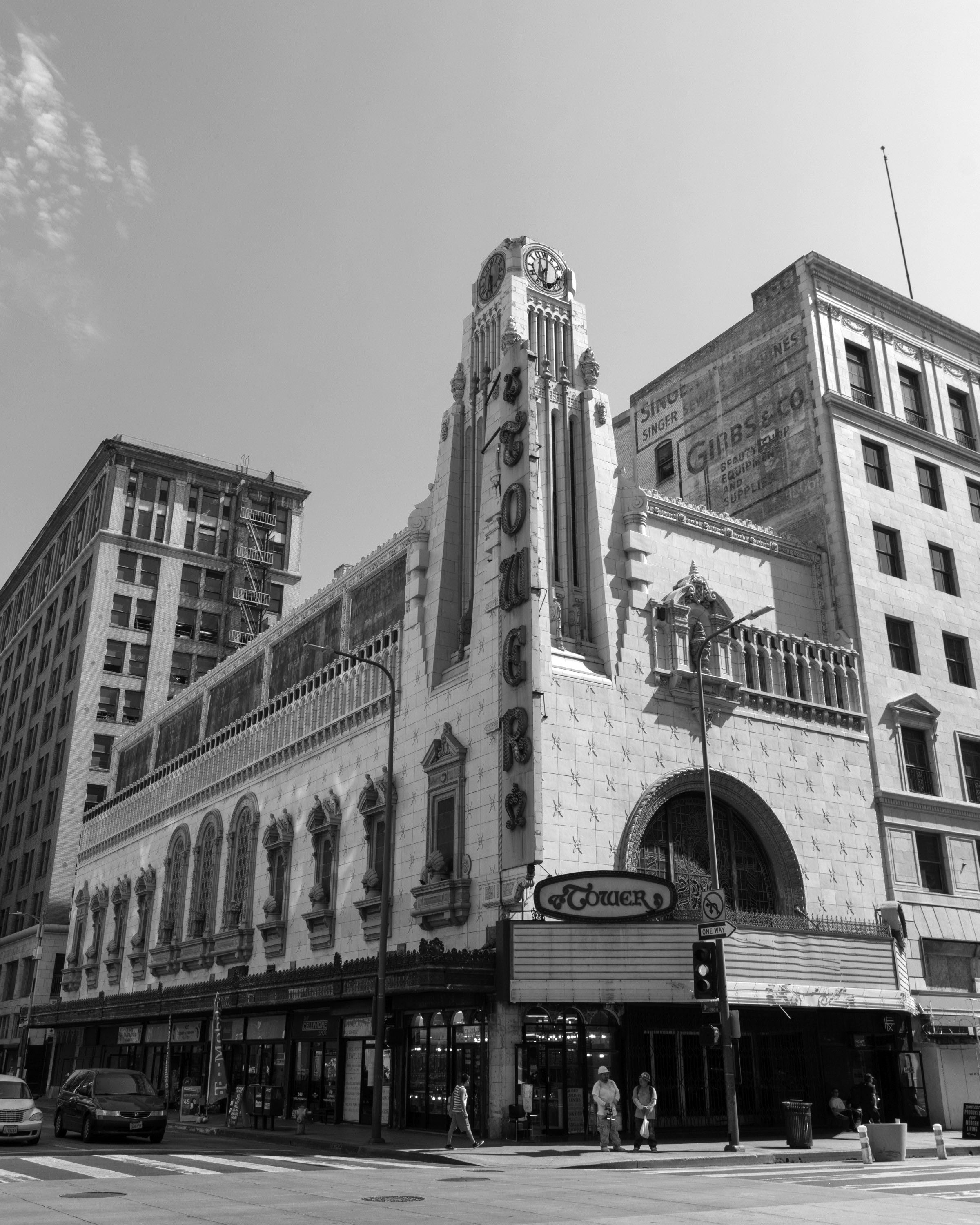 |
|
| (2017)^ – A vacant Tower Theatre - Photo by Difference Engin via Wikipedia |
Historical Notes On August 2, 2018, Apple officially announced plans to adaptively reuse The Tower Theatre as a retail operation, including additional community programming, classes, and events.* |
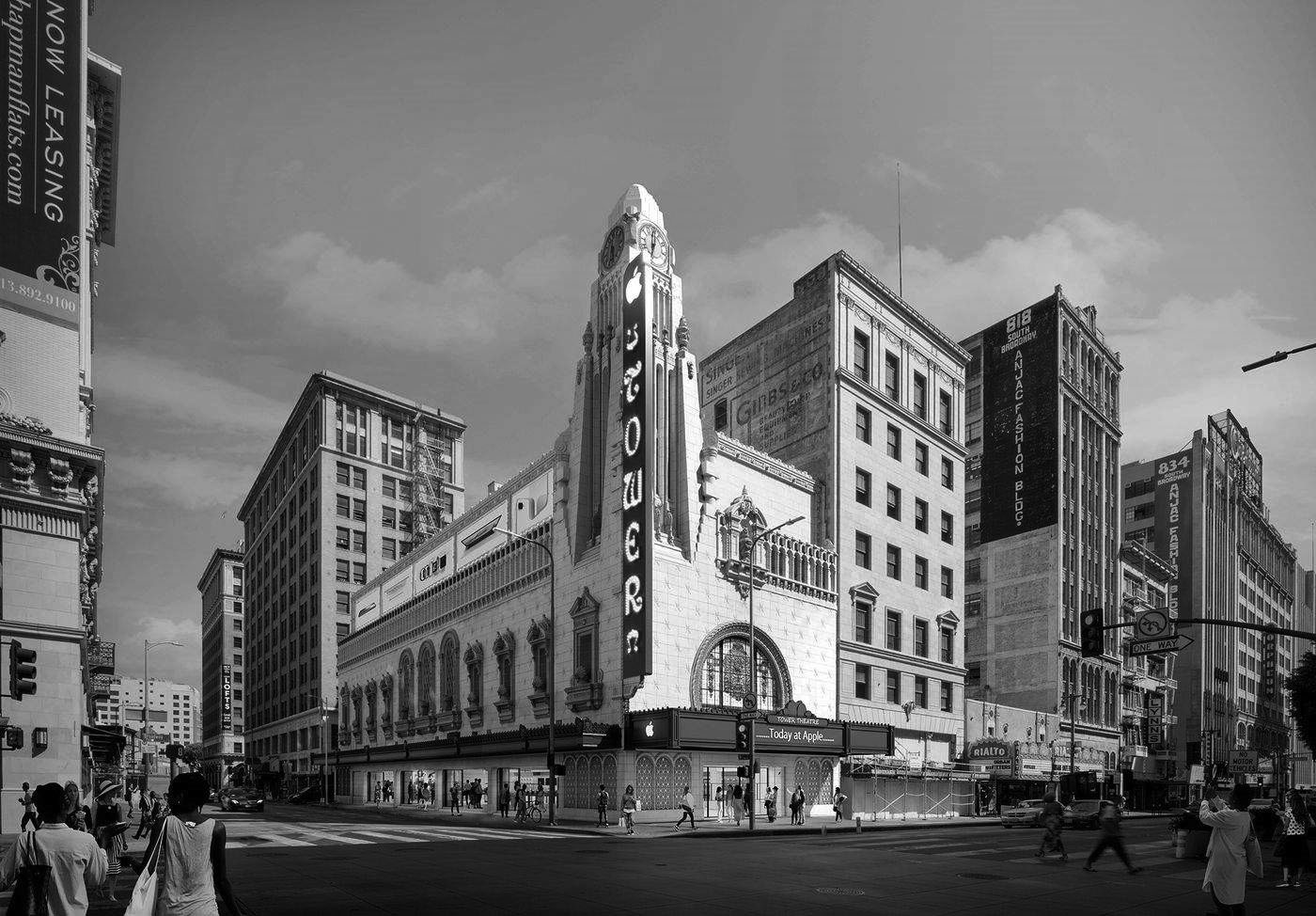 |
|
| (2020)* – Rendering of the restored Tower Theatre – new home to the Apple Store. Rendering courtesy of Urbanize LA |
Historical Notes The Cupertino-based tech company is transforming the historic movie palace at 8th Street and Broadway into a unique retail store which will incorporate space for programs, classes, and potentially live events. Foster + Partners, in coordination with Los Angeles-based Gruen Associates, is designing the project, which includes a full seismic and structural retrofit of the 93-year-old Tower Theatre. Plans call for restoring the historic building to its original appearance, removing a series of mid 20th century alterations and recreating a portion of its clock tower which was lost to earthquake damage in the 1970s.* |
* * * * * |
Maddux Airlines
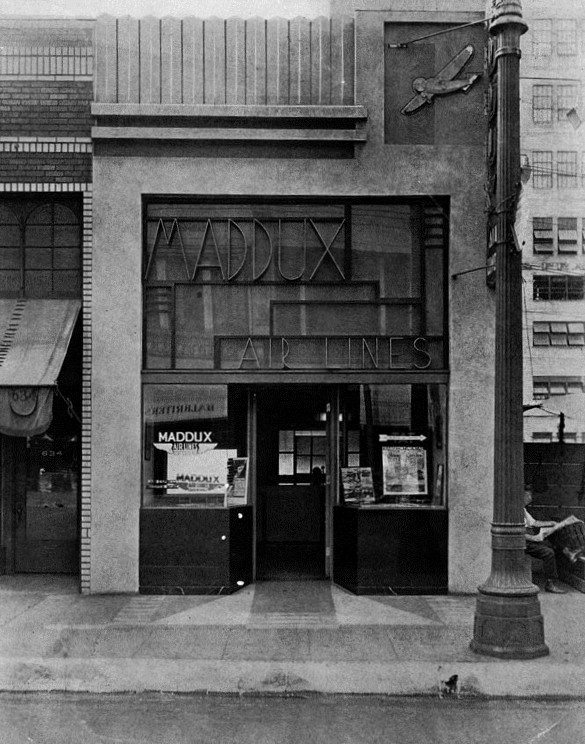 |
|
| (ca. 1928)* - Exterior view of Maddux Airlines, located at 636 South Olive Street, in downtown Los Angeles. The cement building is covered with stucco, black marble to windows and 3/8 inch metal letters in iron frame |
Historical Notes Built in ca. 1928. Architects: Jock Detlef Peters and Feil & Paradise. Peters was a German émigré known for his modern store designs in Los Angeles. Other of his projects included the interiors of Bullock's Wilshire. In 1927 Jack L. Maddux, an owner of a Los Angeles Ford and Lincoln car dealership, founded Maddux Air Lines. The airline’s inaugural flight was on September 22, 1927 when the airline’s Ford 4-AT Tri-motor carrying 12 passengers flew from San Diego to Los Angeles. This flight was to a small dirt landing strip that would later become Mines Field then Los Angeles International Airport, although the landing strip, called Inglewood Site, was not suitable for the airline, and Jack Maddux chose instead Rogers Airport, with improved facilities, and later Grand Central Air Terminal in Glendale.*^ |
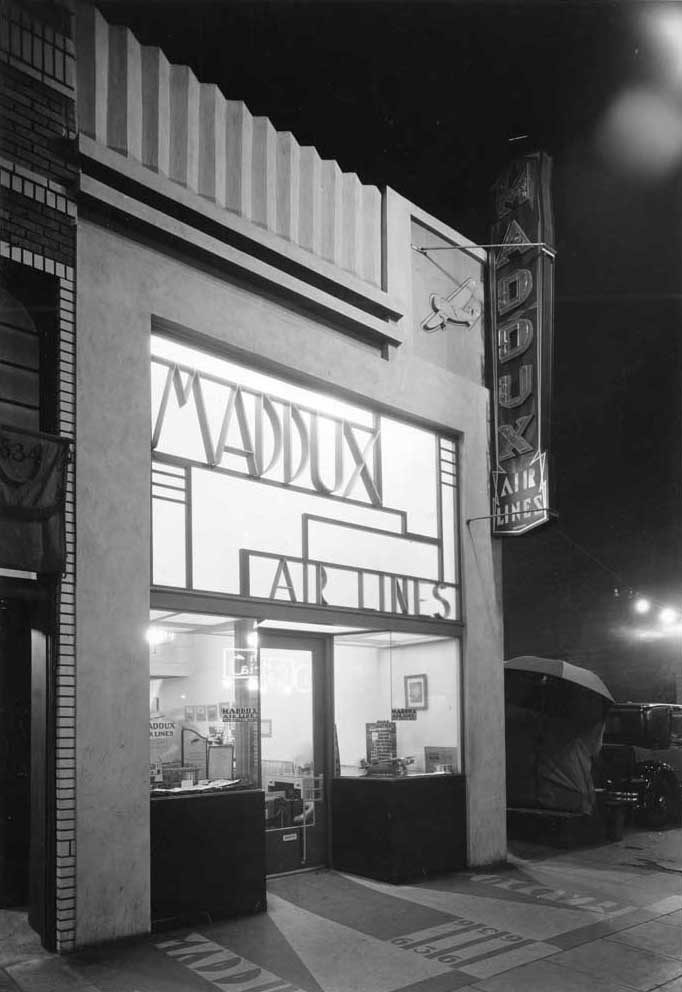 |
|
| (ca. 1929)^*# - Night view showing the Maddux Air Line office at 636 Olive S. Street. |
Historical Notes To publicize flying to the West Coast, Jack Maddux ordered the ferry pilot to stop in a number of large cities along the way back to Los Angeles. He talked groups of local businessmen into taking flights around their local areas. Maddux apparently used the free rides to recruit investment in forming a national airline and it apparently worked. Maddux Airlines was formed September 2, 1927; its first flight was on November 1, 1928; from Burbank Airport to San Diego's Lindburgh Field.; the cost was $15. ^ |
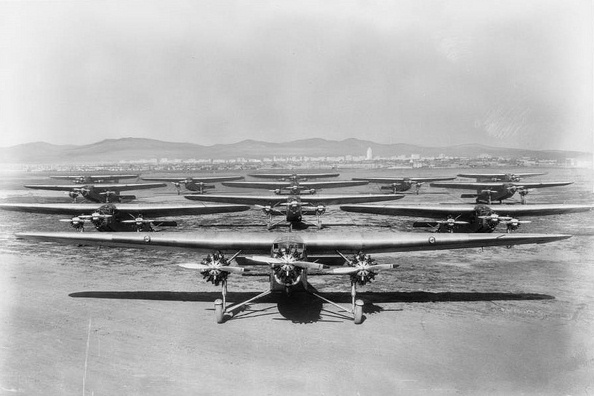 |
|
| (1929)**^ - View of the Maddux Air Lines fleet at Mines Field. |
Historical Notes By mid 1929, Jack Maddux had 16 Tri-motors (the largest fleet of Fords in service) and two smaller planes which he used for private charter. Business was booming but the risks were great and he was unable to obtain an airmail contract from the government. To get the government's support, Jack merged the airline with Transcontinental Air Transport on November 16, 1929. It occurred just fifteen days after the October 29, 1929 stock market crash. At first, they called the new venture TAT-Maddux. Eight months later on July 19, 1930, TAT-Maddux merged with another local West Coast air carrier, competitor Western Air Express. The Maddux name was discarded at this time and the carriers actually did fly under their own names even though they were then associated. Jack did win a seat on the corporate board but he did not, apparently, have a major say in the new airline's operation, which became known as Trans Continental and Western Airlines (T&WA). Eventually, T&WA became Trans World Airlines.^ Among the famous aviators who were involved with Maddux were Charles Lindbergh and Amelia Earhart. Maddux also had a publicity department that advertised the celebrities who flew with the airline. These included Will Rogers, who rode on the inaugural flight, and Hollywood actors Arthur Edmund Carewe and Dolores del Río.*^ |
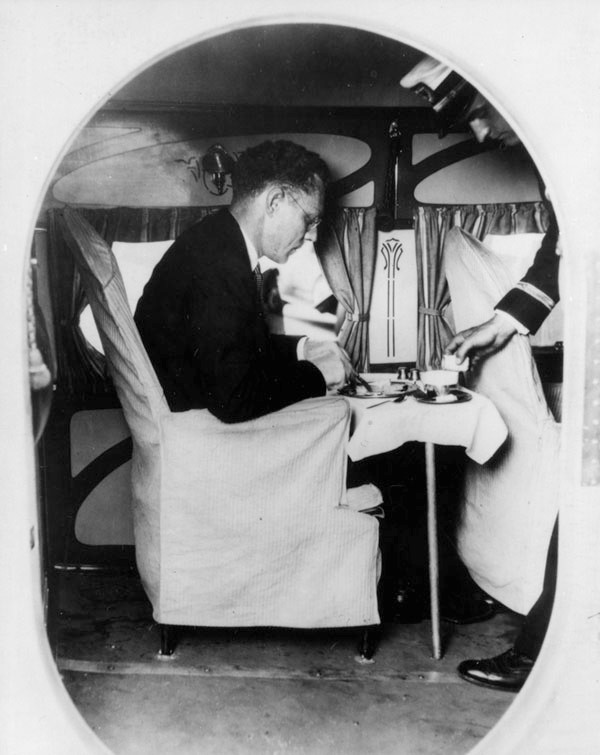 |
|
| (ca. 1929)* - Interior view of Maddux Airlines, showing a passenger eating a meal. |
Historical Notes Aviation circles on the web note two "Maddux Air" crashes, one in 1929, and another in 1930. There were others involving TAT and T&WA later. Crashes in those early days were not uncommon. Flying was new and the safety technology was virtually nonexistent then.^ Click HERE to see more in Aviation in Early Los Angeles. |
* * * * * |
Schaber's Cafeteria
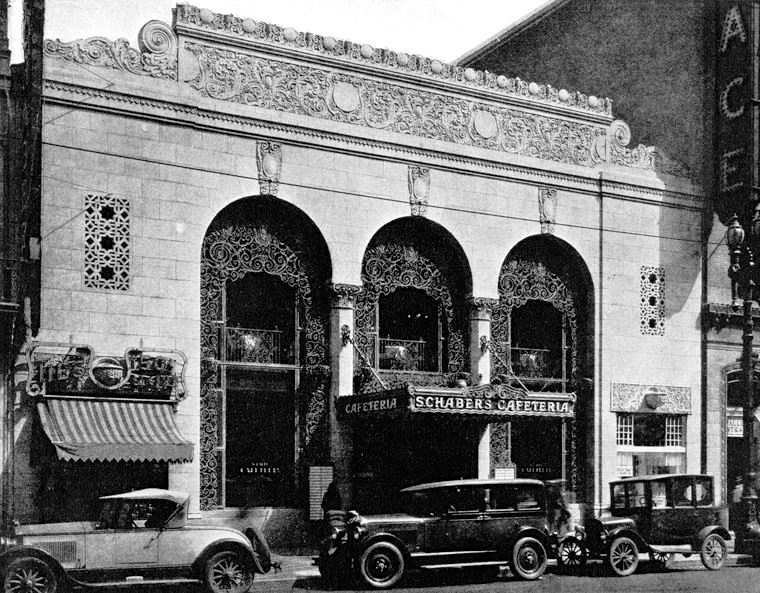 |
|
| (ca. 1928)* - Exterior view and entrance to Schaber's Cafeteria. The newspaper clipping from Architectural Digest reads "facade executed in pinkish buff architectural terra cotta with rugged vertical hammered effect", "Scofield-Twaits Co., builders" and "C.F. Plummer, architect." |
Historical Notes Alfred Schaber opened Schaber’s Cafeteria at 620 S. Broadway in 1928. Restaurants became an important part of Broadway, serving both the shopping and theater-going public. Besides full-service restaurants in all of the major department stores, Schaber's Cafeteria became a favorite destination after its opening in 1928 next to the Palace Theatre.*##* |
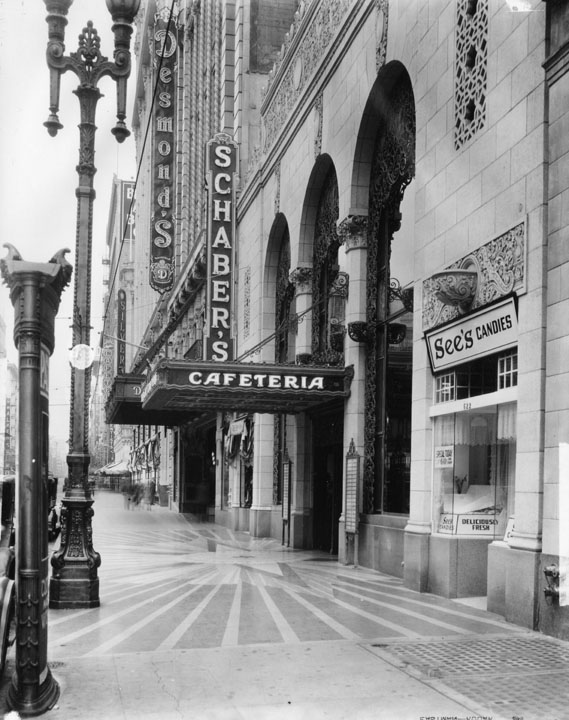 |
|
| (ca. 1928)* - Exterior view of the ornately detailed buildings on Broadway, including Schaber's Cefeteria, Desmond's, and See's Candies in the foreground. See's features chocolates at 60 cents a pound. |
Historical Notes Charles Alexander See II (1882–1949) arrived in the United States from Canada in 1921 with his wife Florence MacLean Wilson See (1885–1956), and his widowed mother Mary Wiseman See (1854–1939). Mary See had developed the recipes that became the foundation of the See's candy business while helping run her husband's hotel on Tremont Island in Ontario. The family opened the first See's Candies shop and kitchen at 135 North Western Avenue in Los Angeles in November 1921. They leased the shop from the French Canadian pioneer of Los Angeles Amable La Mer. They had twelve shops by the mid-1920s and thirty shops during the Great Depression. In 1936 See's opened a shop in San Francisco. In 1972 the See family sold the company to Berkshire Hathaway Inc. In 2007, Warren Buffett called See's "the prototype of a dream business".*^ |
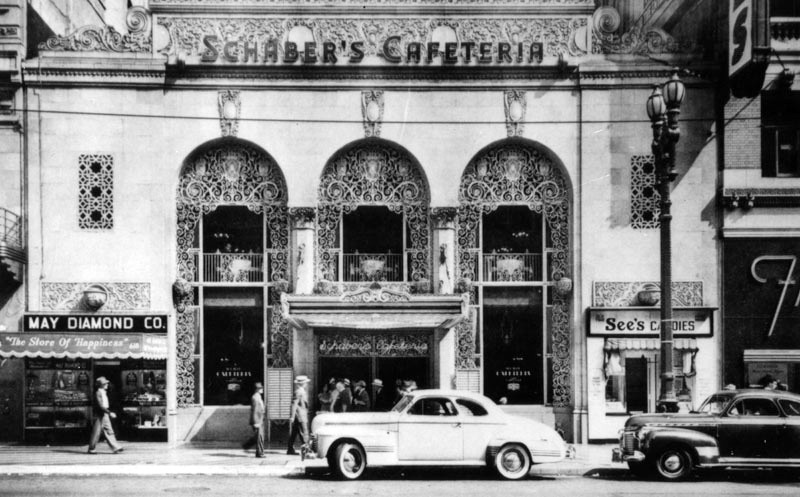 |
|
| (ca. 1940)* - Exterior view of the two story Schaber's Cafeteria at 620 South Broadway in Los Angeles. The See's Candies store is visible at right, and the May Diamond Company is at left. Two automobiles are parked out front. |
Historical Notes Today, the facade still looks great. Figaro Bistro opened in the building in December 2012. Click HERE for contemporary view. |
Then and Now
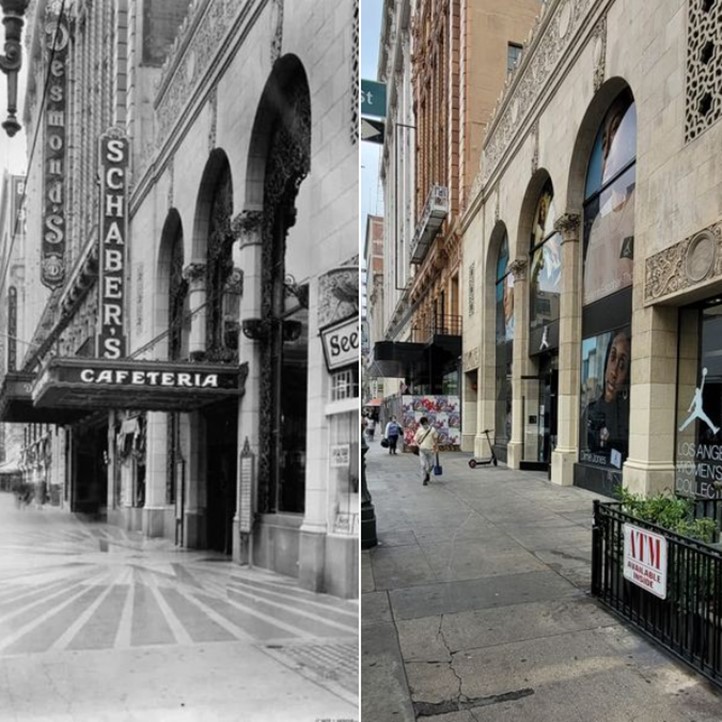 |
|
| (1928 vs. 2022* - Looking north on Broadway showing Schaber's Cafeteria at 620 South Broadway. |
* * * * * |
Ward Hotel
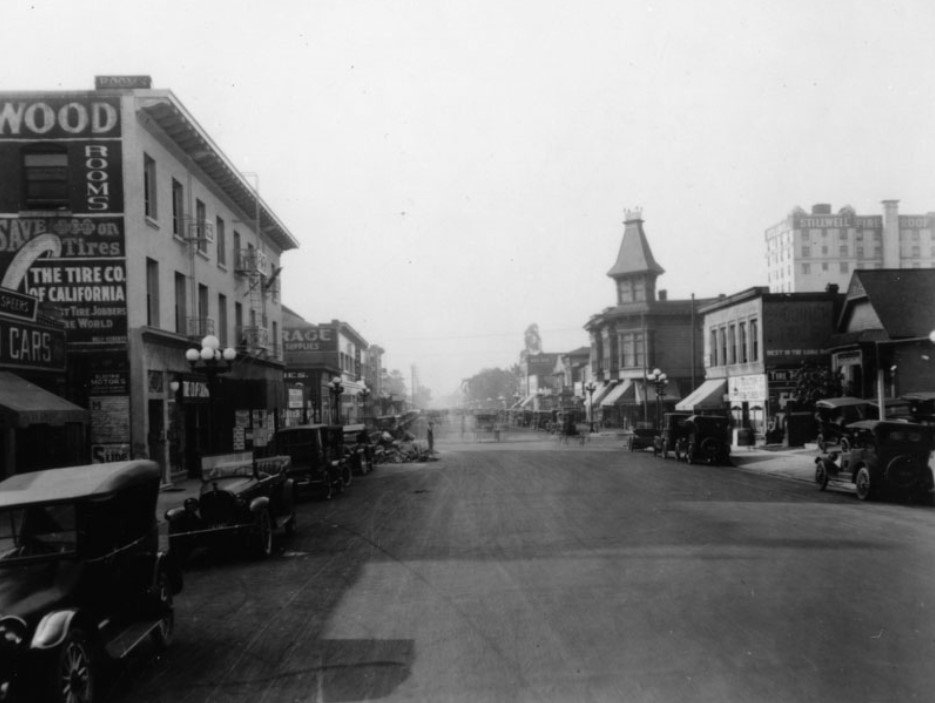 |
|
| (ca. 1925)* – View looking south on Olive Street towards 8th Street. The building with the ornate tower/steeple on the S/W corner of Olive and 8th streets is the Ward Hotel which also housed various small businesses. |
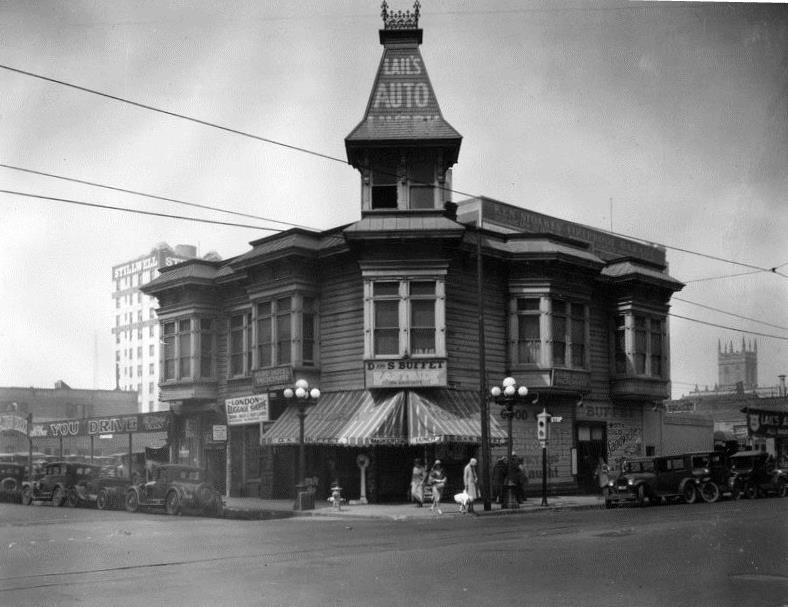 |
|
| (1927)* - View showing the southwest corner of 8th and Olive in 1927. The building shown has several signs advertising: "Lail's Auto Livery" on the steeple as well as on either ends of the building; "Ward Hotel rooms" below two windows, also on both sides of the building; "London Luggage Shoppe" with an entrance on the left side; and "D and S Buffet Eastside" prominently in the middle, offering hot and cold sandwiches. The Stillwell Hotel as well as a church tower can be seen in the background. |
* * * * * |
City Hall Construction
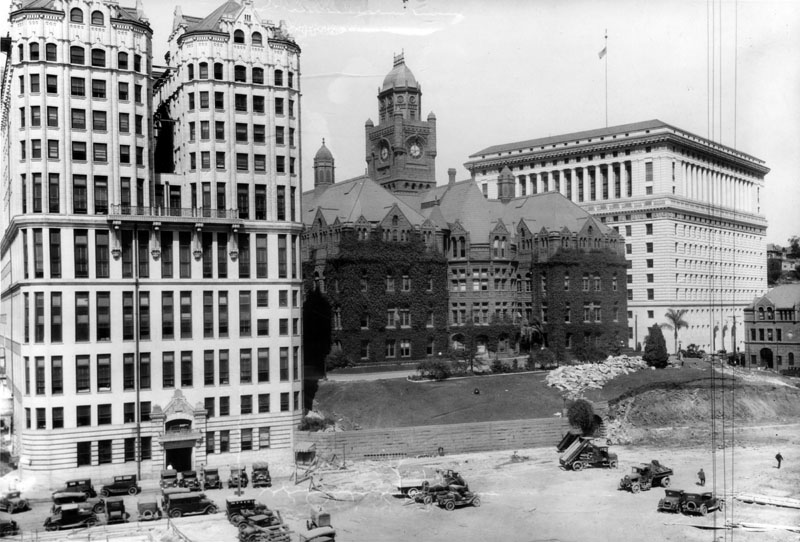 |
|
| (ca. 1927)* - View is looking northwest toward three powerhouses: Hall of Records, County Courthouse, and Hall of Justice. The construction site of the new Los Angeles City Hall can be seen in the forefront. |
Historical Notes The Hall of Records was built in 1906 and demolished in 1973; the County Courthouse was built in 1891 and demolished in 1936; the Hall of Justice was built in 1922 by Allied Architects.* |
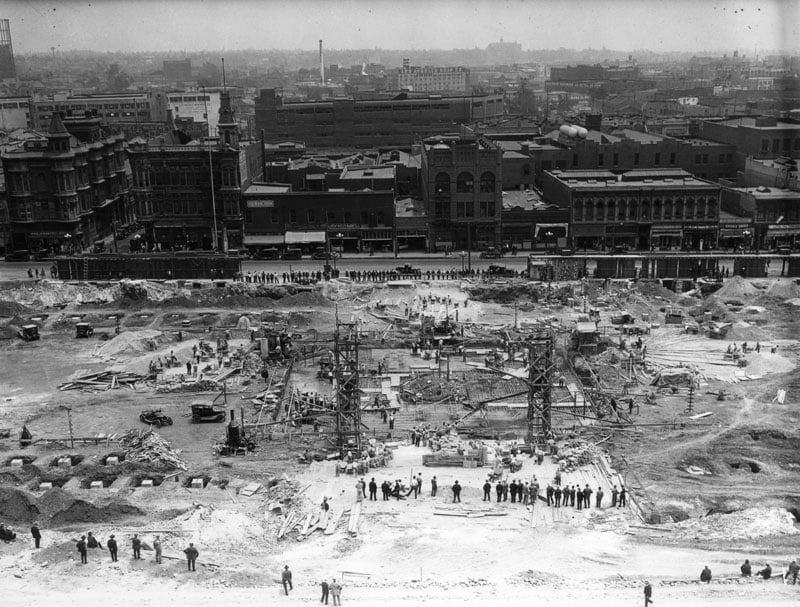 |
|
| (1927)^.^ – View looking East showing newly poured footings for the new City Hall building, as seen from the Hall of Records. At upper-left corner can be seen two LA iconic buildings built in the late 1800s and located at Main and Market streets: Amestory Building and the U.S. Hotel. |
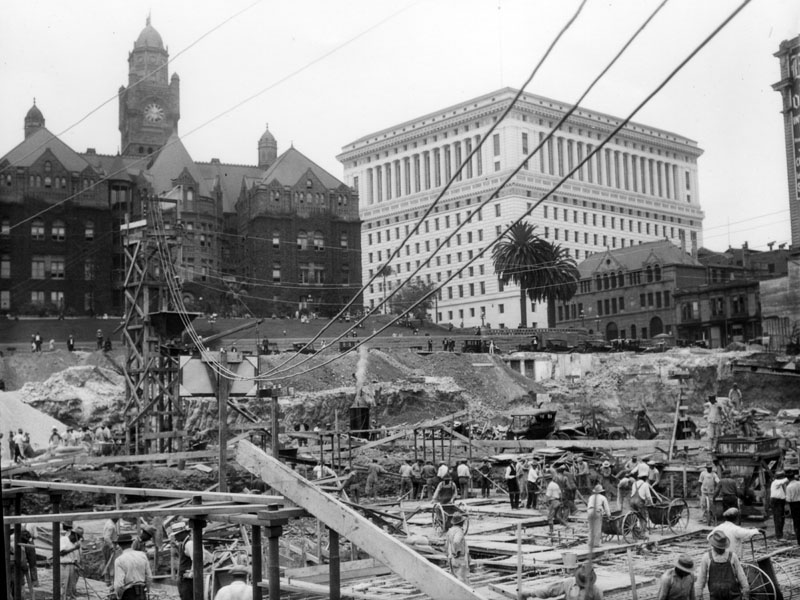 |
|
| (1927)* - Preparation of the site for construction of Los Angeles City Hall. In the background stand the old County Courthouse and the Hall of Justice to its right. |
Site of Today's Los Angeles City Hall
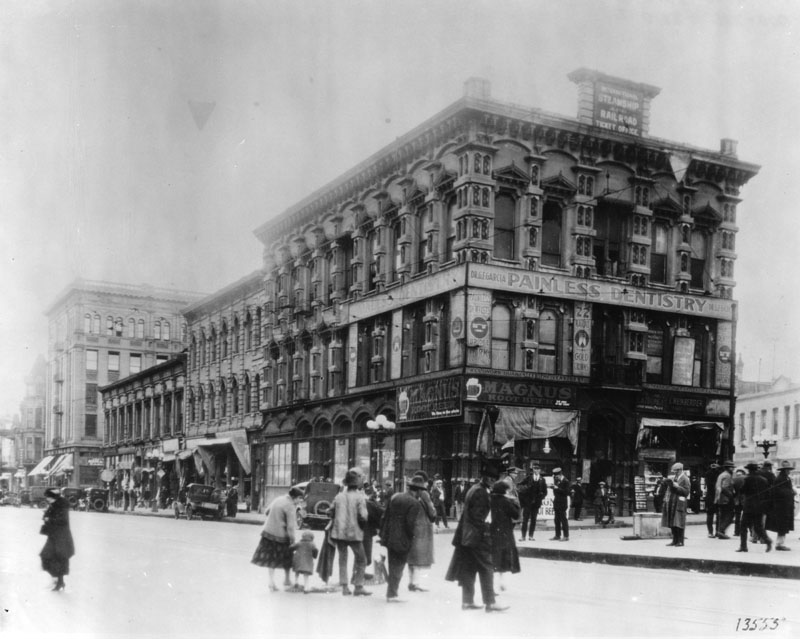 |
|
| (ca. 1926)* - View showing the Temple Block at the intersection of Spring, Main, and Temple streets. This would become site of today's City Hall. The above photo was taken shortly before the block would be razed to make way for the new City Hall building. Ground was broken on March 4, 1926. |
Historical Notes For decades the triangle-shaped Temple Block at the intersection of Main, Spring, and Temple streets was the commercial heart of Los Angeles. One of the city’s first stores was established right here in the 1850’s by Johnathan Temple (thus Temple Street). |
City Hall Construction
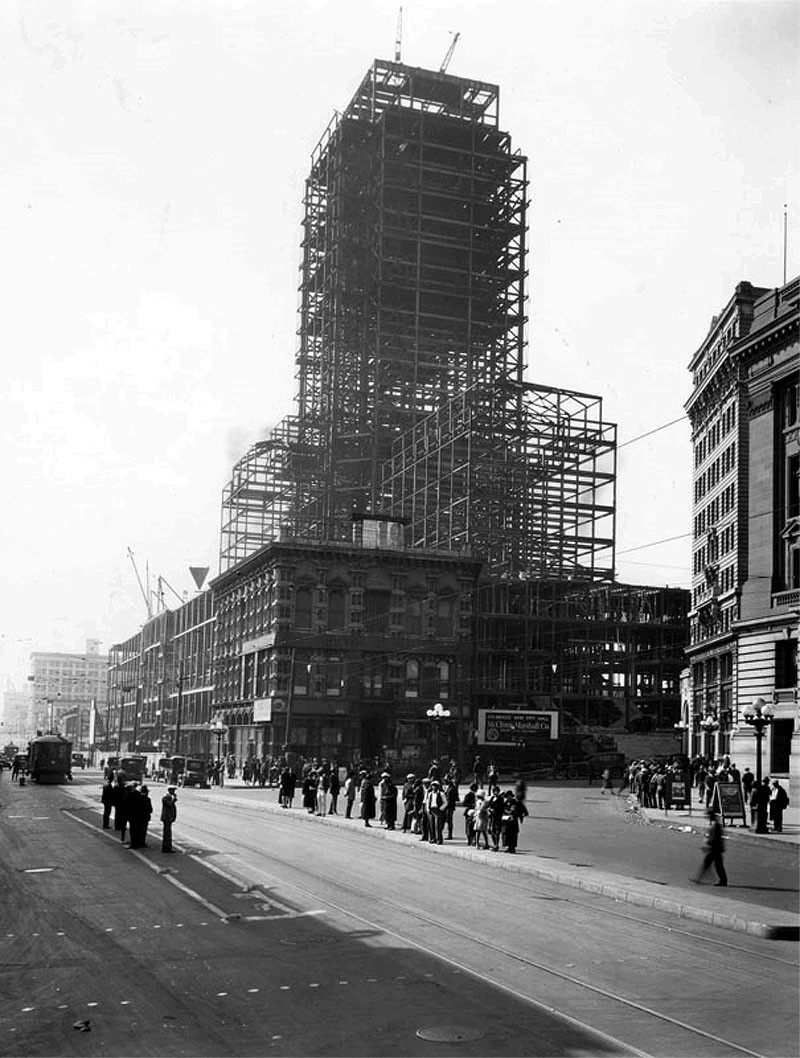 |
|
| (1927)* - Steel framing goes up quickly as the new City Hall takes form, dwarfing the historic corner building of Temple Block. |
Historical Notes After authorizing a bond issue on June 5, 1923, the city commissioned John Parkinson, Albert C. Martin, and John C. Austin as architects in August, 1925. Parkinson was responsible for the concept and architectural design of the building; Martin, the structural design; and Austin, the working drawings and general administration of the project.^ |
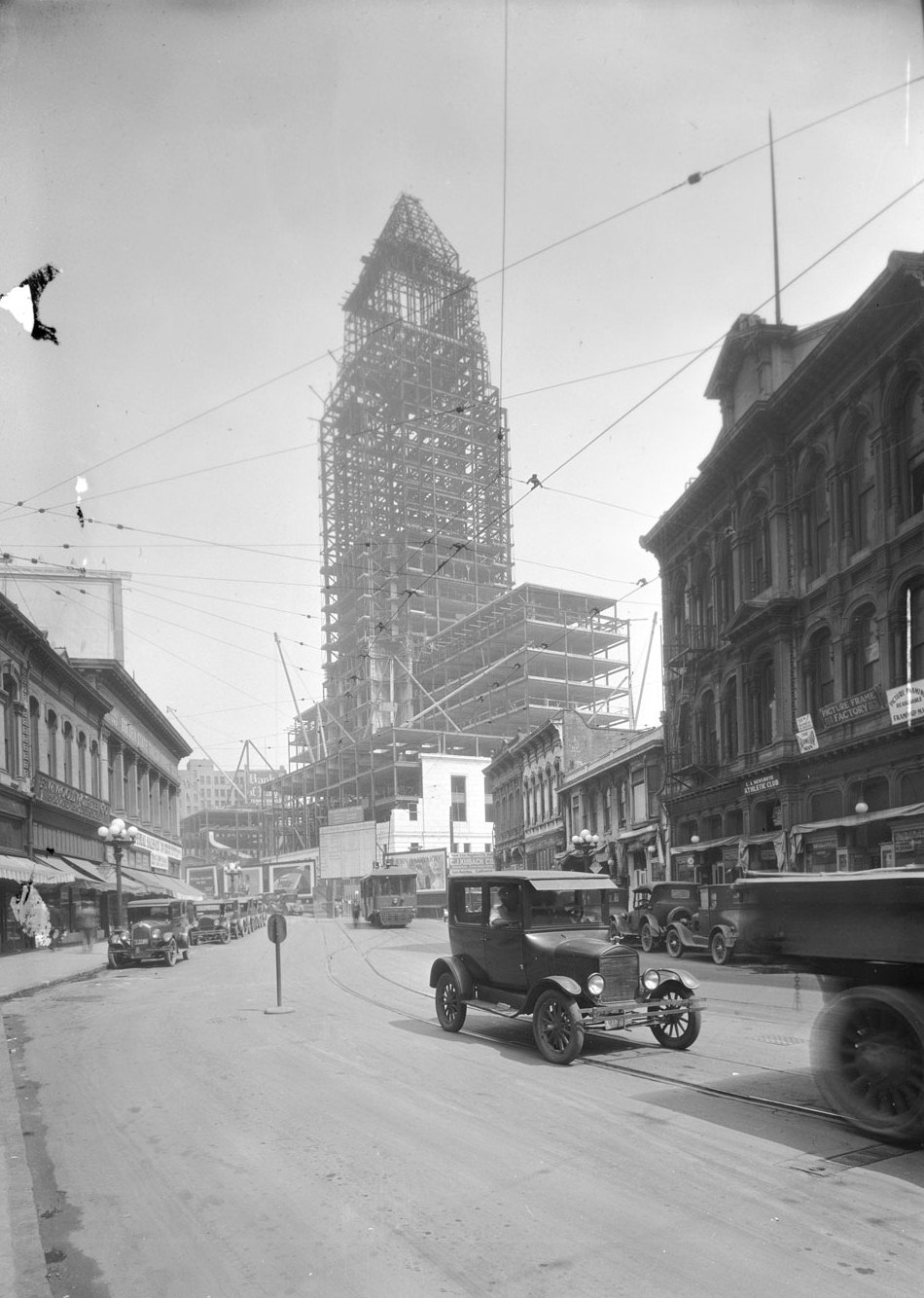 |
|
| (1927)^^ - View showing early model cars and streetcar with City Hall under construction in the background. The structure's steel framing is nearly complete. |
Historical Notes The new 28-story high-rise was replacing the old 1888-built City Hall located on Broadway between 2nd and 3rd Streets. That building had replaced a one-story adobe City Hall, formerly the old Rocha House, on the northeast corner of Spring and Court Streets. |
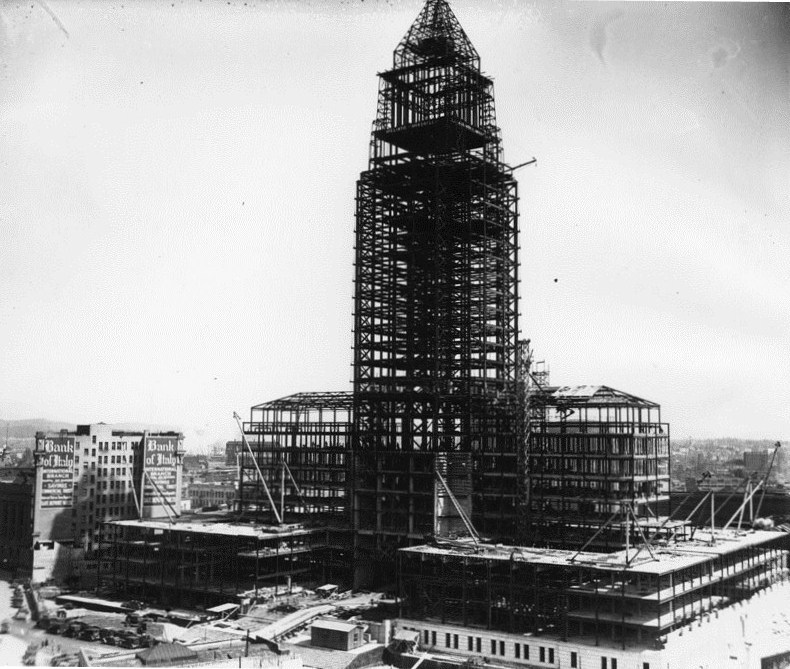 |
|
| (1927)* - Exterior stone begins to be added during construction. |
Historical Notes At 454 feet high the new City Hall would become Los Angeles' tallest building for over 30 years. |
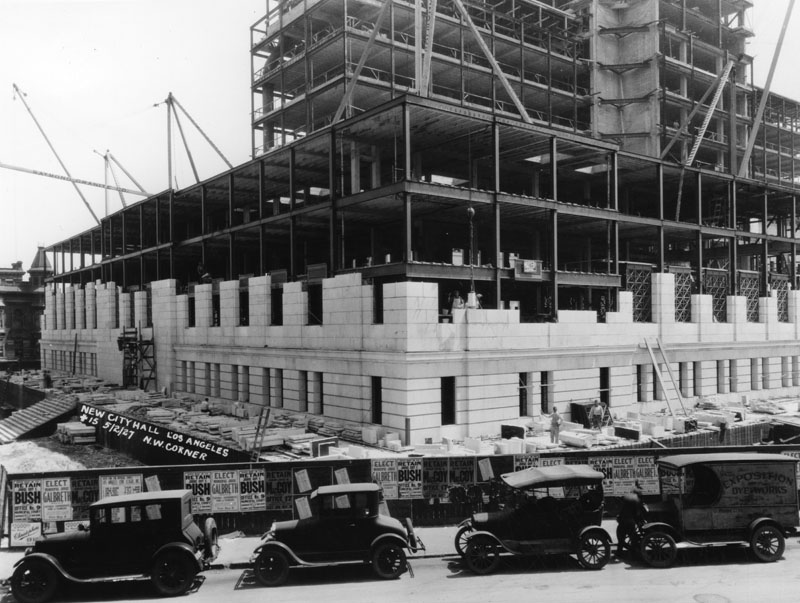 |
|
| (1927)* - View showing northwest corner of the new City Hall building, May 2, 1927, during construction. |
Historical Notes The concrete in the City Hall tower was made with sand from each of California's 58 counties and water from its 21 historical missions. |
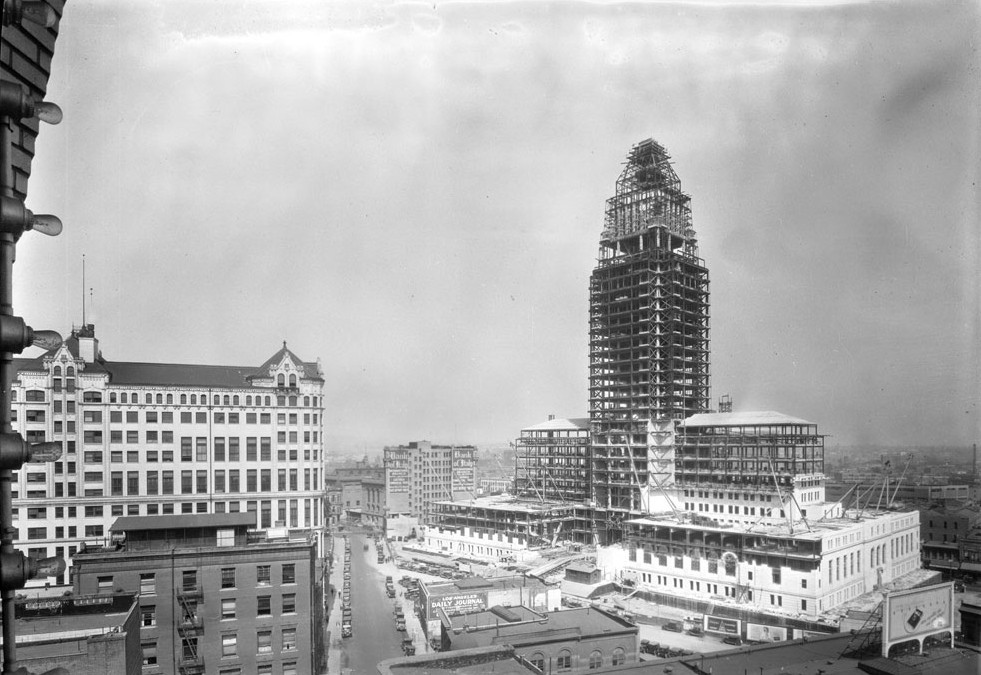 |
|
| (1927)^^ - Los Angeles City Hall beginning to take form, 200 N. Spring Street. |
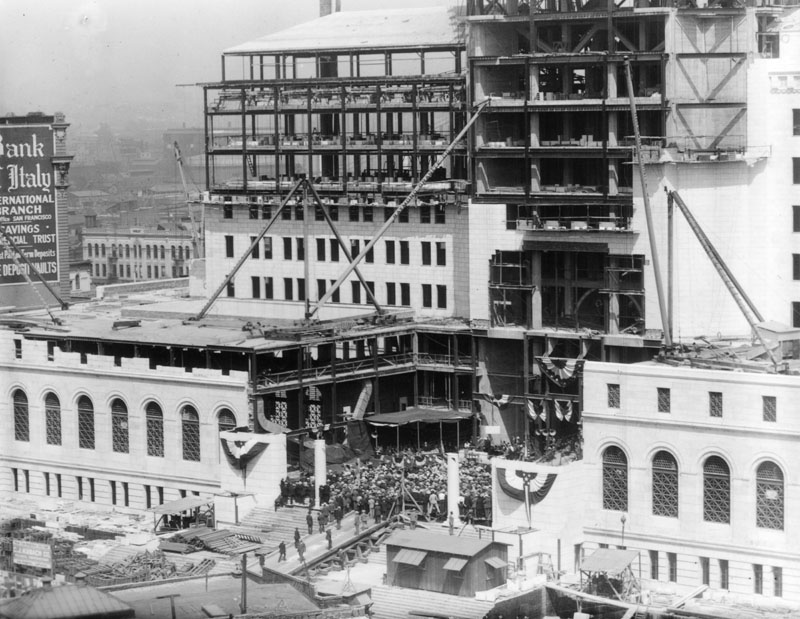 |
|
| (1927)* - Ceremony marking halfway completion of the new Los Angeles City Hall. |
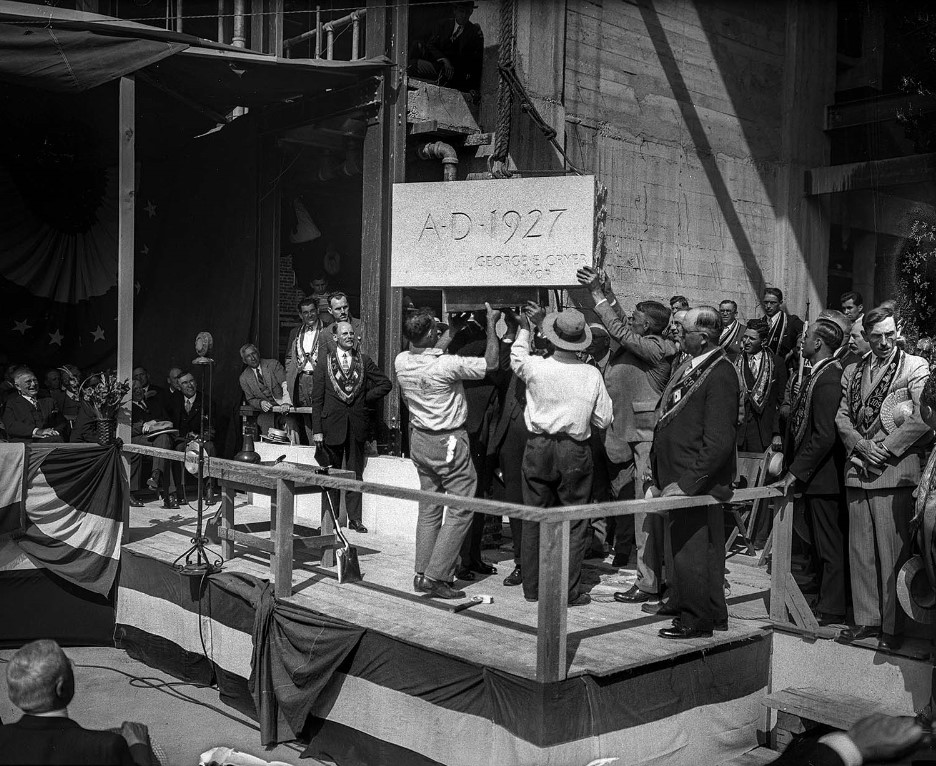 |
|
| (1927)^^* - Cornerstone for the new Los Angeles City Hall being lowered into position. |
Historical Notes A story accompanying this photo in the June 23, 1927, Los Angeles Times reported: “The corner-stone of Los Angeles’ new City Hall was laid at 2 o’clock yesterday afternoon. The ceremonies were conducted by the Native Sons of the Golden West, with Charles A. Thompson, Grand President of the order presiding. Appropriate speeches were made by Gov. (Clement) Young, Mayor (George) Cryer, President McGarry of the Chamber of Commerce and Edward J. Delorey, who acted as chairman. … Just before the corner-stone was lowered into position, a copper box was placed inside which contained more than a score of historical documents and other articles. Among these was an autographed photograph of Mayor Cryer, his annual message, the charter of Los Angeles, a history of the California pioneers, a copy of the city budget for 1927-28, an account of the discovery of gold in 1848, three gold nuggets and numerous other articles. The Governor joined the Mayor at the old City Hall and the procession to the new structure was led by the Firemen’s Band. Several thousand persons witnessed the ceremonies, The program was broadcast.” |
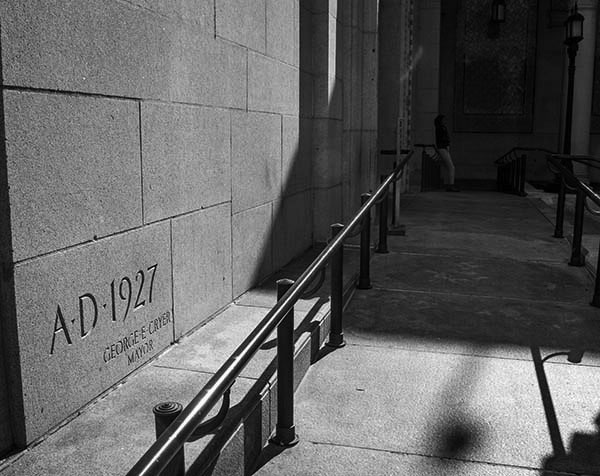 |
|
| (2015)^^* - The cornerstone for Los Angeles City Hall is to the left of the historical entrance – now closed – off Spring St. Photo by Scott Harrison |
 |
|
| (1927)* - View of the new Los Angeles City Hall more than halfway completed. |
Historical Notes City Hall's distinctive tower was based on the purported shape of the Mausoleum of Mausolus and shows the influence of the Los Angeles Central Library, completed soon before the structure was started.*^ |
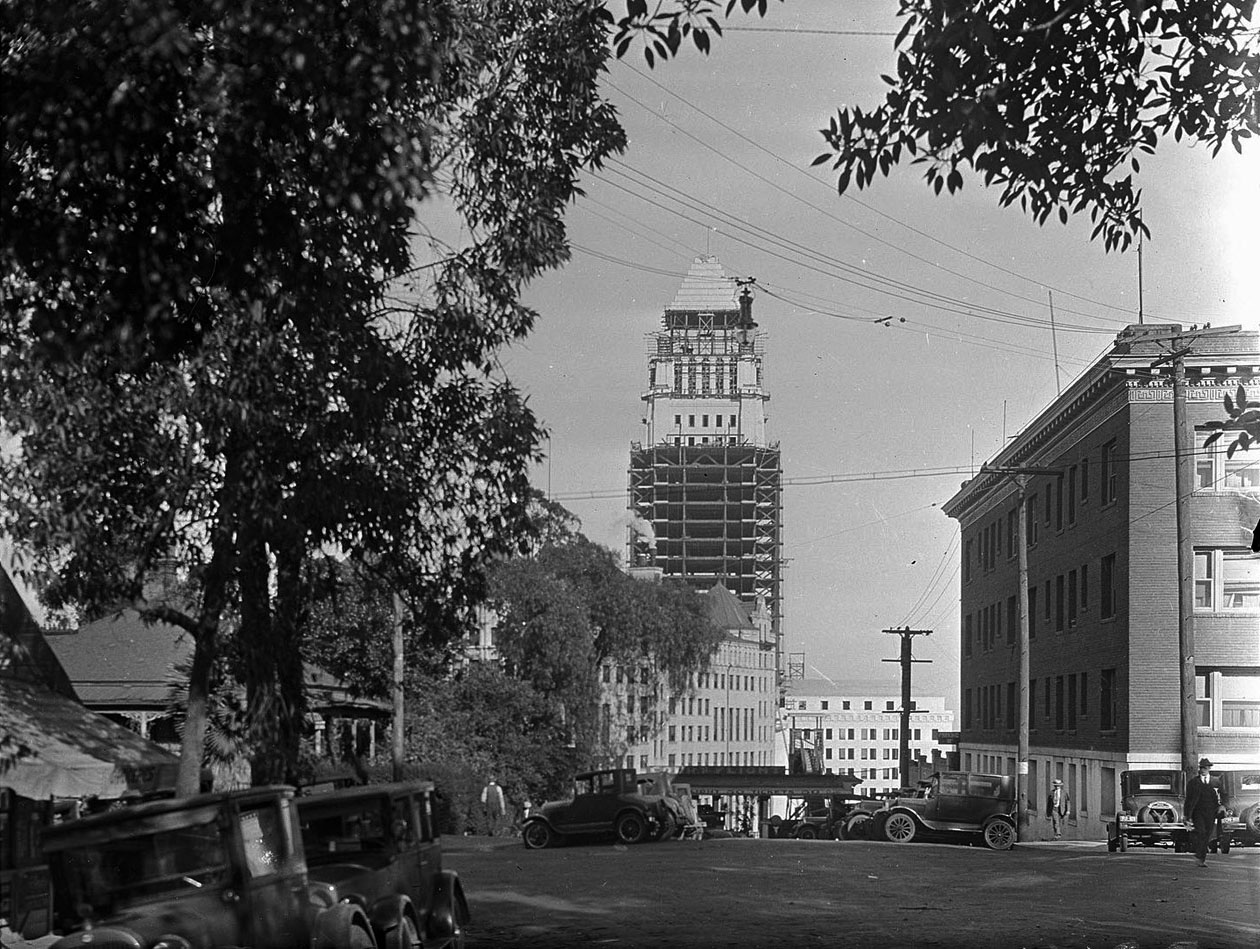 |
|
| (1928)* – City Hall under construction as seen from the upper terminus of Angels Flight at 3rd and Olive. |
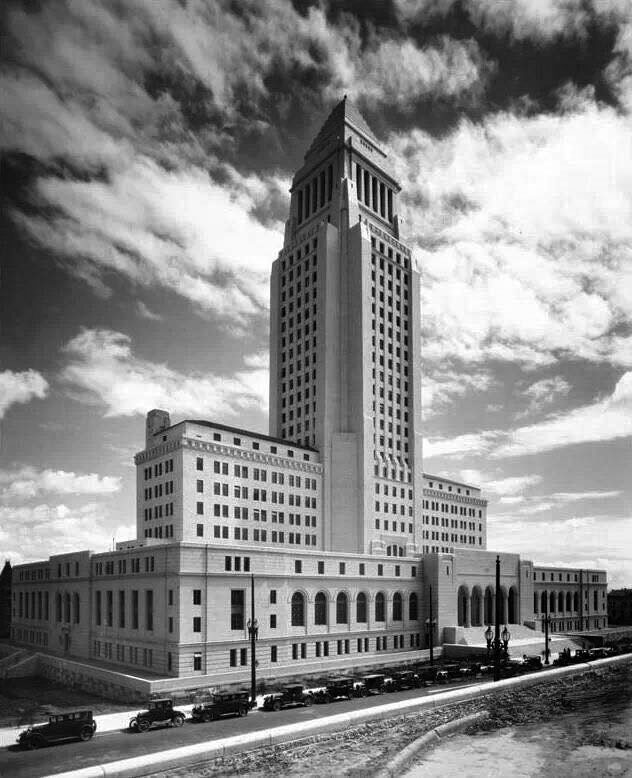 |
|
| (1928)^.^ - City Hall near the last stage of completion, prior to landscaping. After completion City Hall was LA's tallest building until 1964. |
Historical Notes Prior to the late 1950s the Charter of the City of Los Angeles did not permit any portion of any building other than a purely decorative tower to be more than 150 feet. Therefore, from its completion in 1928 until 1964, the City Hall was the tallest building in Los Angeles, and shared the skyline with only a few structures having decorative towers, including the Richfield Tower and the Eastern Columbia Building. |
Opening Ceremony
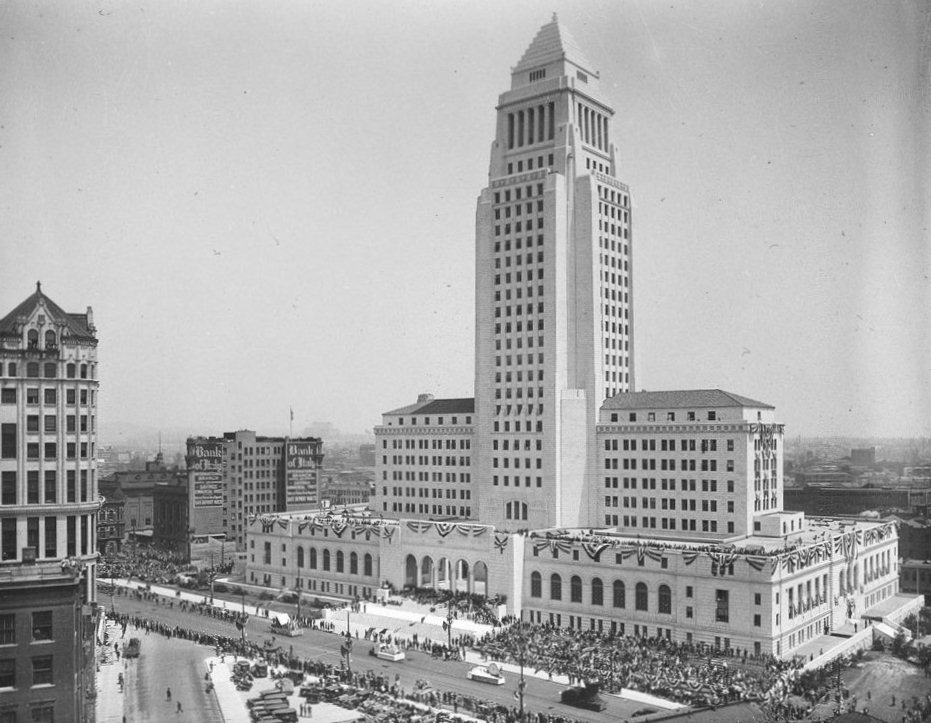 |
|
| (1928)^^ - View of Los Angeles City Hall decorated with banners for its opening ceremony. A crowd of people are gathered at the curb, bleachers are full of spectators, and a parade is in progress on Spring Street. |
Historical Notes The big dedication, overseen by Sid Grauman and attended by an estimated 15,000 people, featured emceeing by Joseph Schenck and speeches by Mayor George E. Cryer and San Francisco Mayor James Rolph, Jr. After Rolph spoke, Irving Berlin sang, as did “Chief Yowlache, the Yakima Indian; Elsa Alsen, the grand opera singer; the Mexican chorus of Los Angeles, in costume; Virgil Johannson, and others."^ |
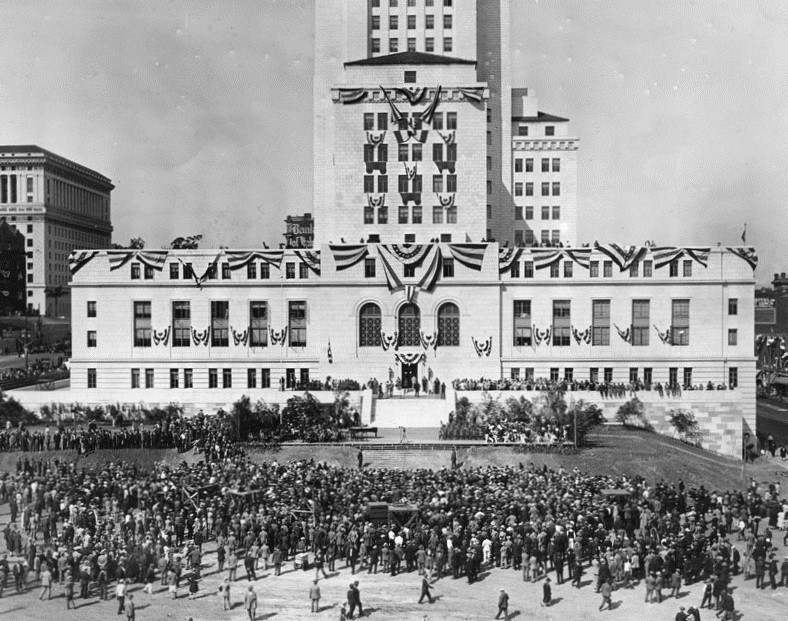 |
|
| (1928)* - Dedication ceremony of the newly completed Los Angeles City Hall. Photograph taken of the side facing 1st Street. |
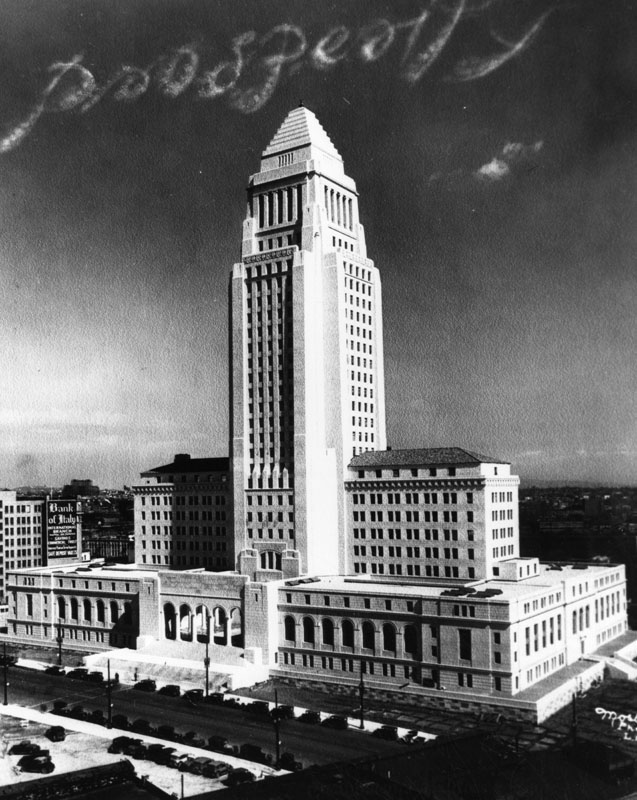 |
|
| (ca. 1928)* - View of the new Los Angeles City Hall, completed in 1928, with sky writing over the building reading "prosperity." It was the tallest building in L.A. from its completion in 1928 until 1964. |
Historical Notes An image of City Hall has been on Los Angeles Police Department badges since 1940. |
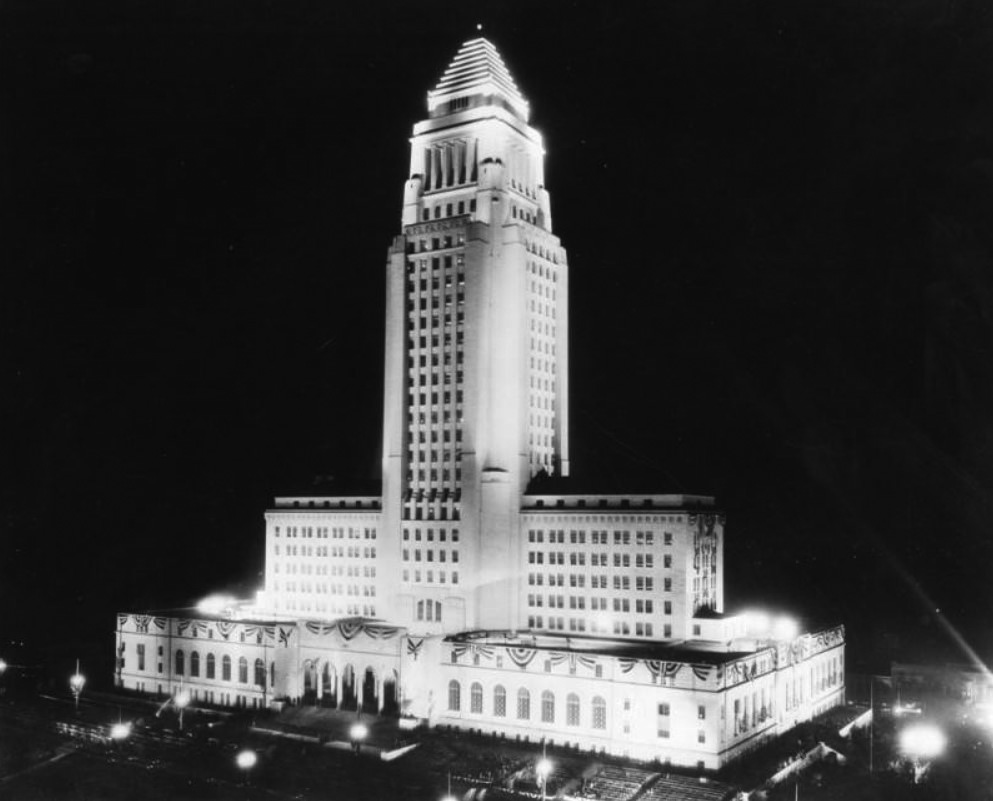 |
|
| (1928)* - Nighttime view of the opening of City Hall with building decorated and lit up. |
Historical Notes The following historical timeline lists the buildings used by City Council, also known as City Hall, since 1850, when Los Angeles was incorporated as a municipality: ◆ 1850 - 1853 - used rented hotel and other buildings for City meetings ◆ 1853 - rented adobe house (aka Rocha Adobe) on Spring Street - across from current City Hall (now parking lot for Clara Shortridge Foltz Criminal Justice Center). The buliding was shared with the County who used it as a Court House. ◆ 1861 - moved into John Temple's Clocktower Market Building, but only stayed for less than a year before the County Court House moved-in ◆ 1861 - 1884 - relocated back to the Rocha Adobe and stayed for over 20 years ◆ 1884 - 1888 - moved to new City Hall Building at South Spring Street and West 2nd Street (site of current Los Angeles Times Building) ◆ 1888 - 1928 - moved to new Romanesque Revival Building on 226-238 South Broadway between 2nd Street and 3rd Street; demolished in 1928 and now site of parking lot between LA Times Parking structure and 240 Broadway. ◆ 1928 - moved to current City Hall Building |
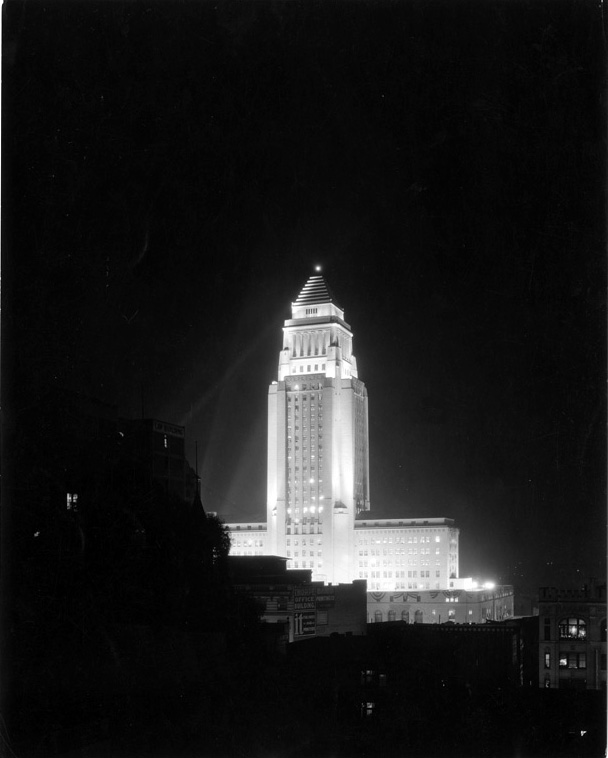 |
|
| (ca. 1928)^*# - Nighttime view of City Hall as seen from Bunker Hill. |
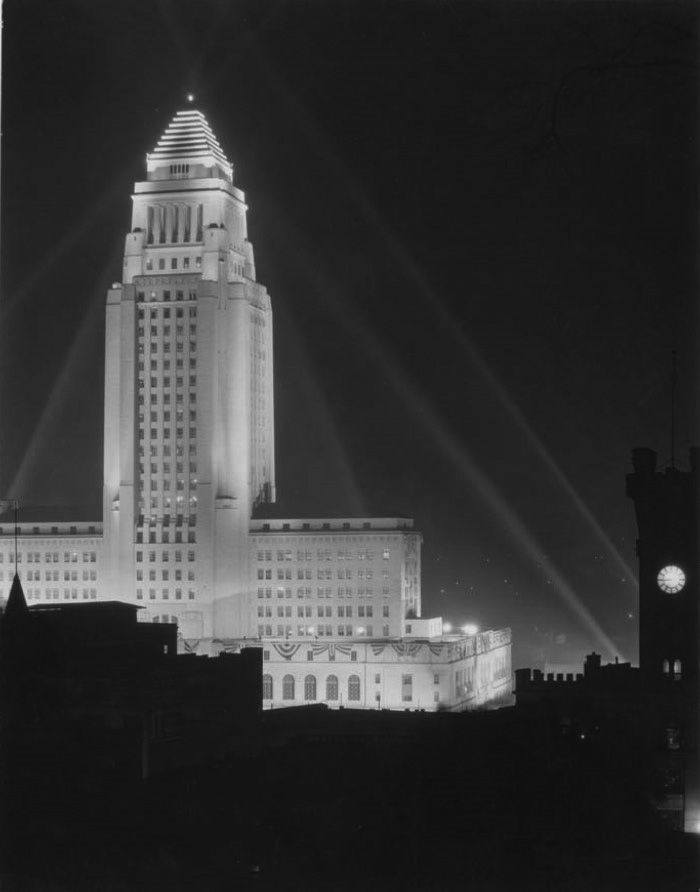 |
|
| (1928)^*# – View looking down from Bunker Hill toward City Hall during opening ceremonies. The LA Times Building clock tower can be seen at right. |
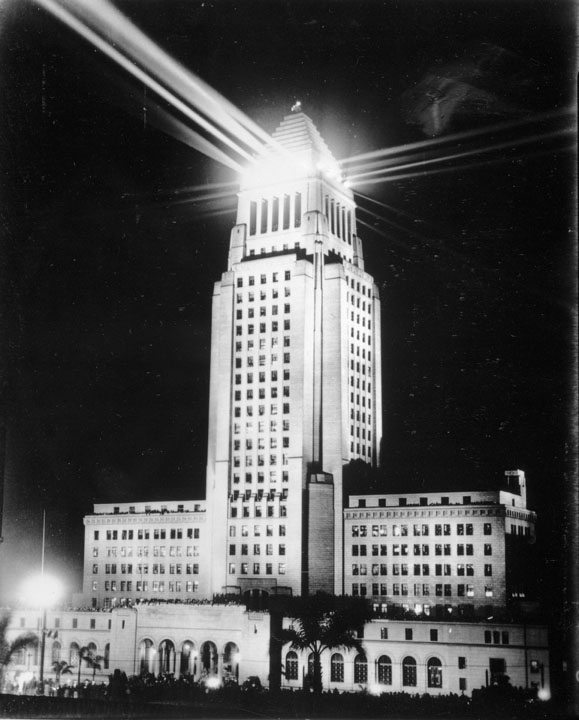 |
|
| (April 26, 1928)^ - View showing Opening Ceremony of the Los Angeles City Hall with multiple spotlights shining out of tower. |
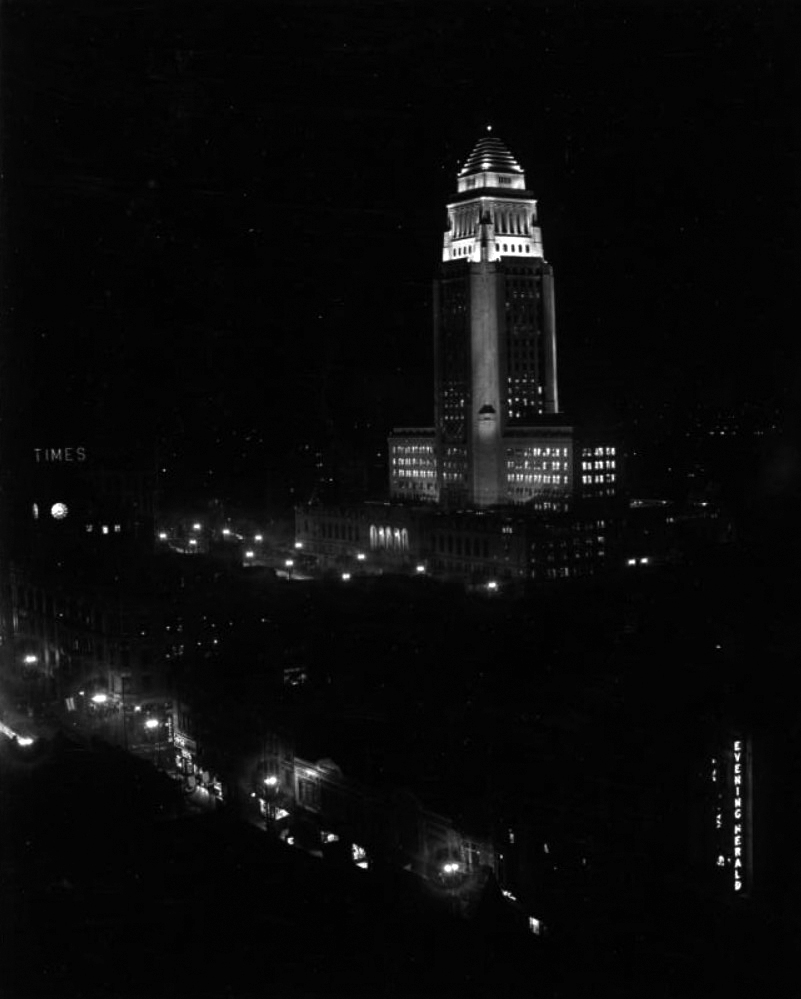 |
|
| (1928)^^ – Night view showing Los Angeles City Hall in downtown Los Angeles. The LA Times Building on the N/E corner of Broadway and 1st Street can be seen at left, with the lighted sign "Times." |
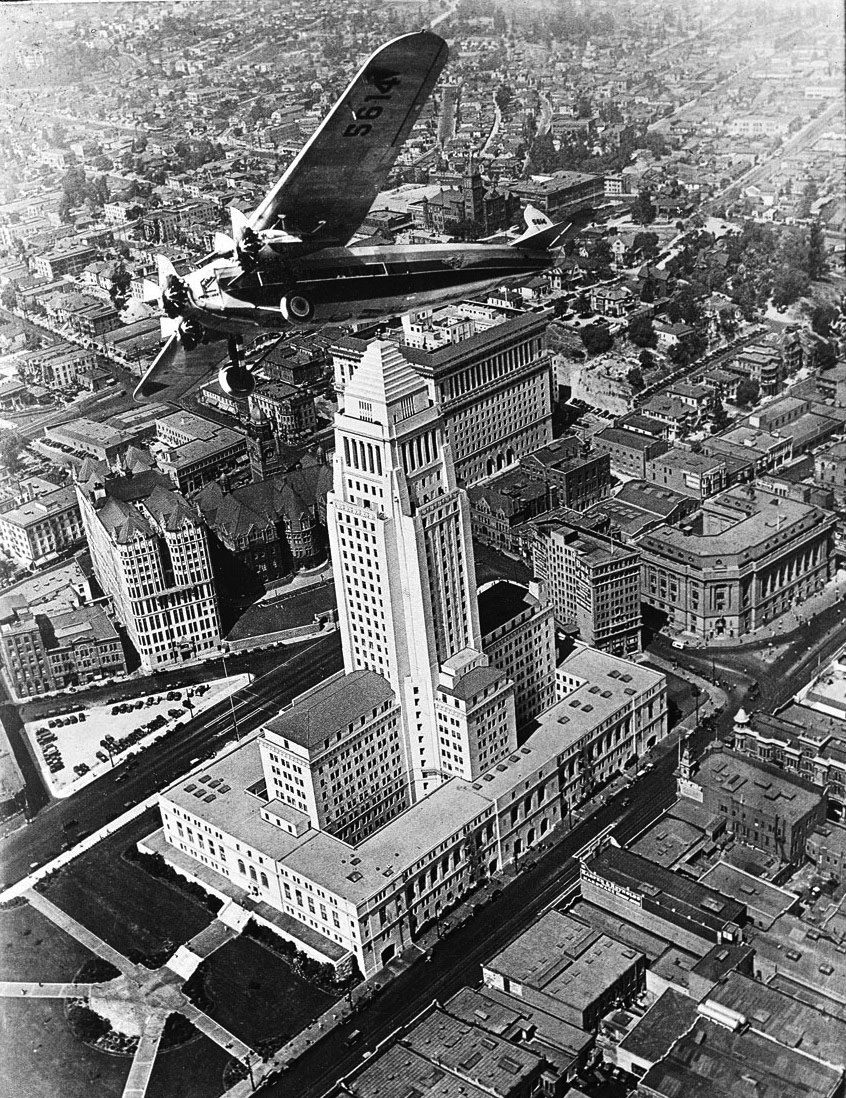 |
|
| (ca. 1929)^^ - View looking northwest showing an airplane (Fokker F.10) buzzing over City Hall. |
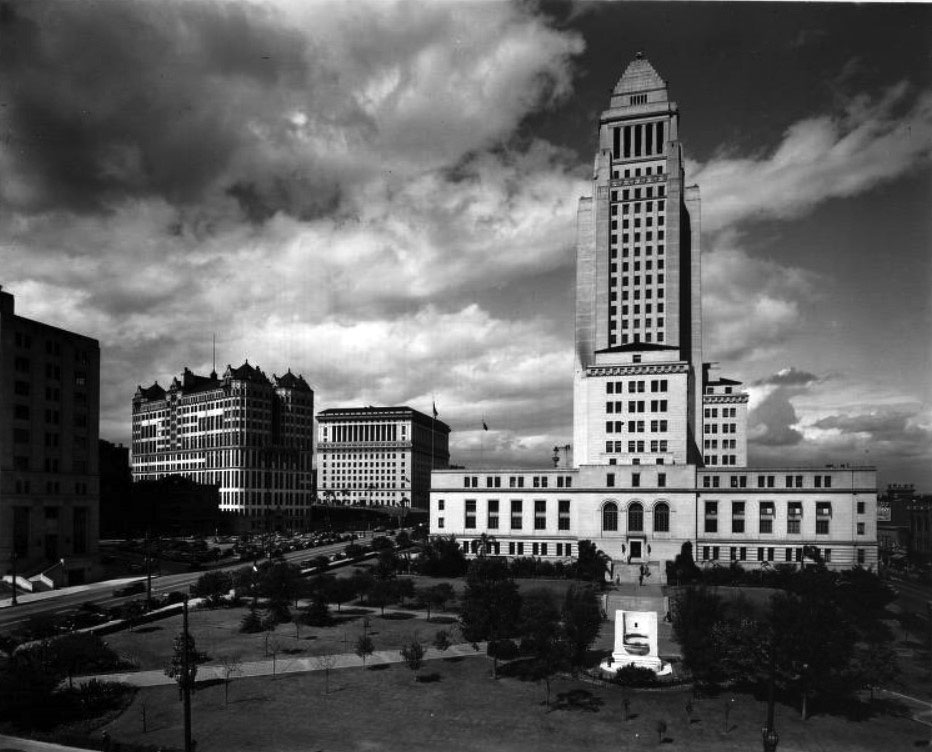 |
|
| (ca. 1930s)^^ - View of City Hall facing north from First Street. To the west on Spring Street are the old State Building, Hall of Records, and Hall of Justice. |
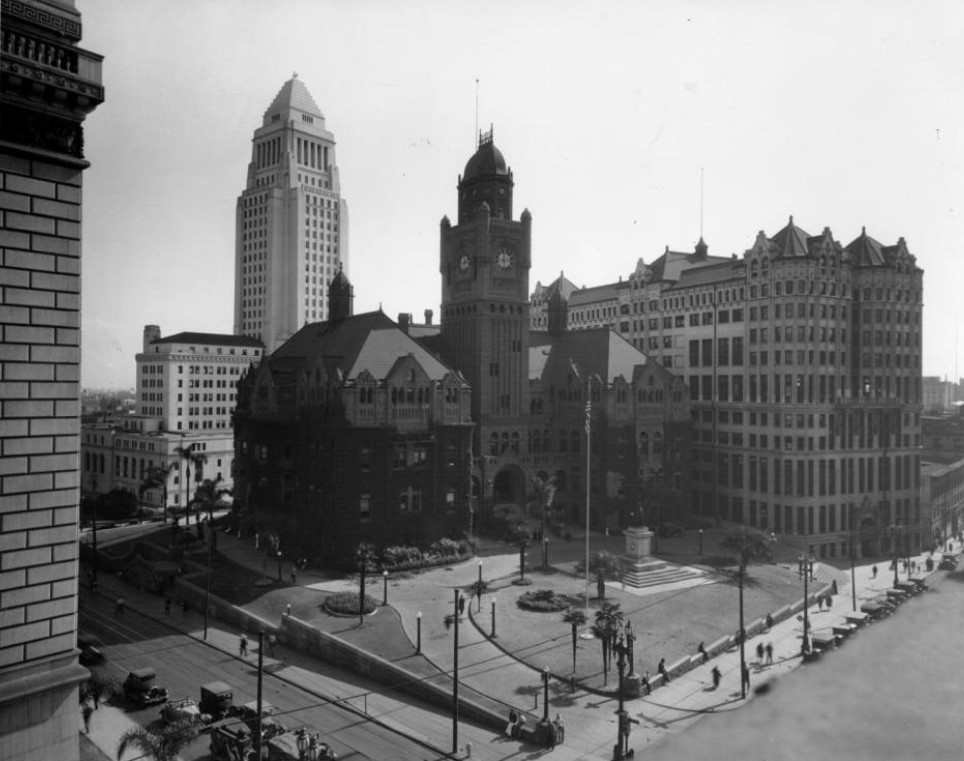 |
|
| (1930)^^ - View looking southeast at the intersection of Temple and Broadway. The County Courthouse stands at center with the Hall of Records to its right. City Hall towers above both in the background. |
Historical Notes The old LA County Courthouse was demolished in 1936. The Hall of Records stood until 1973. |
Before and After
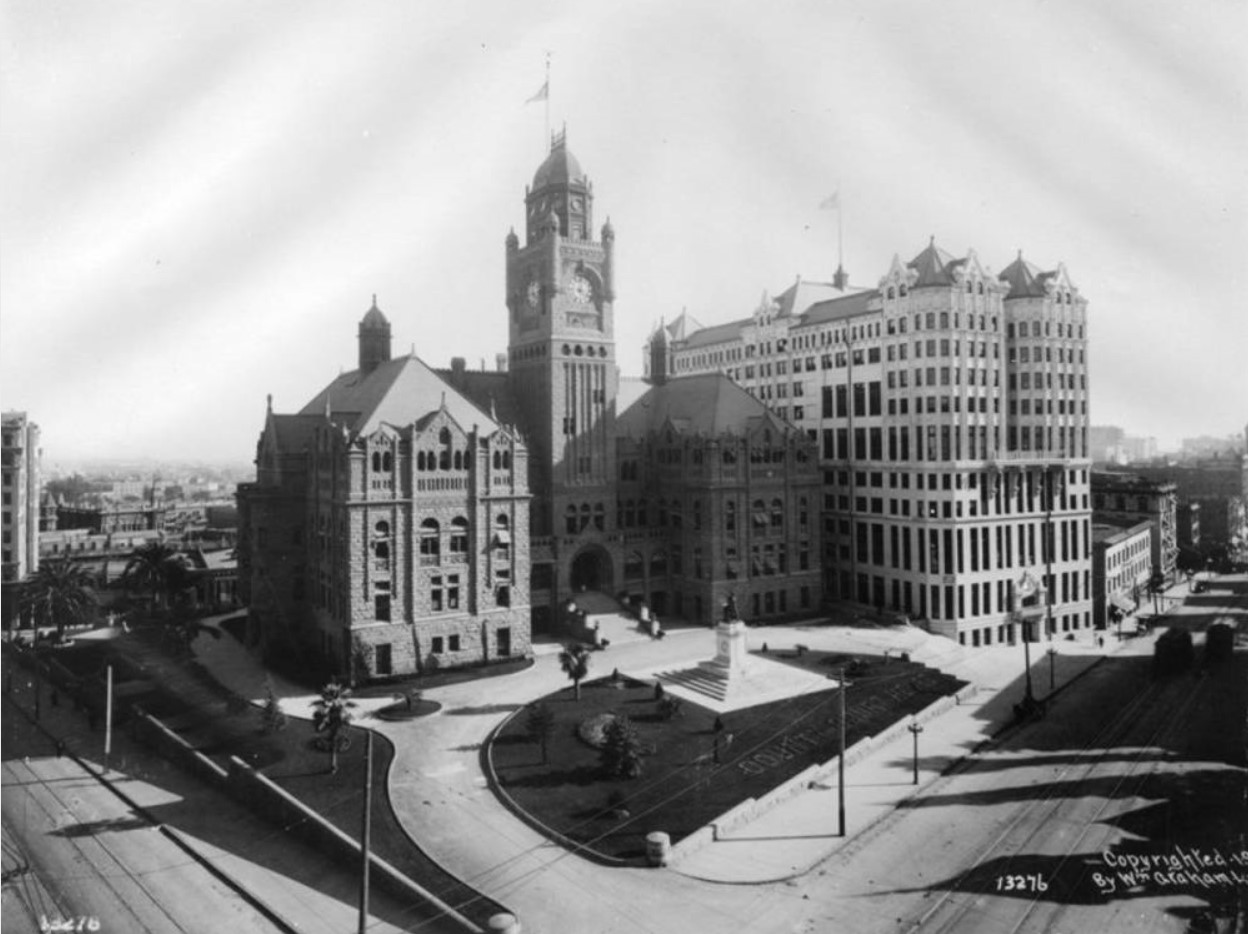 |
|
 |
|
| (1911 - 1930)^^ - View looking toward the southeast corner of Temple and Broadway before and after City Hall was built (1928). |
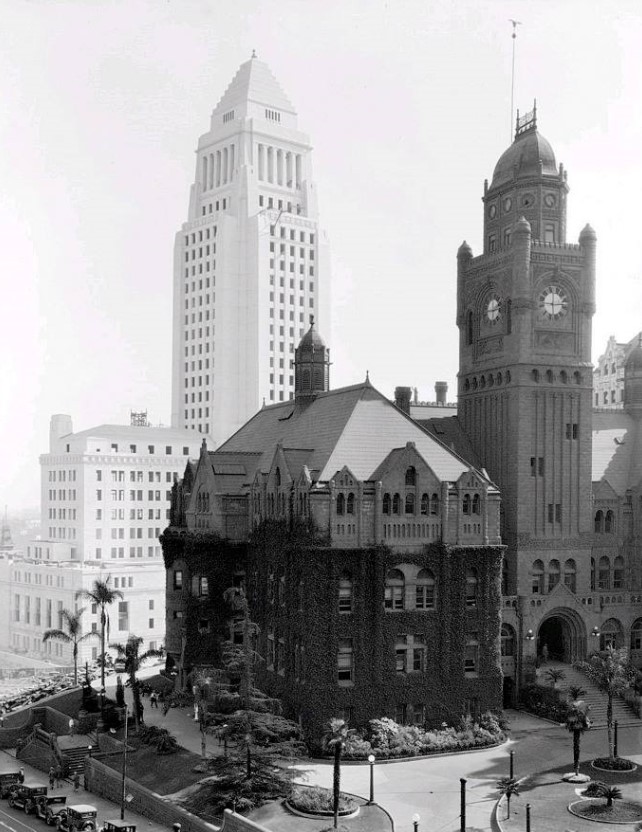 |
|
| (1928)^^ - A great shot of the Los Angeles’ City Hall in the background (which is still with us, thankfully) and in the foreground the County Courthouse who somebody decided wasn’t worth saving (demolished in 1936). |
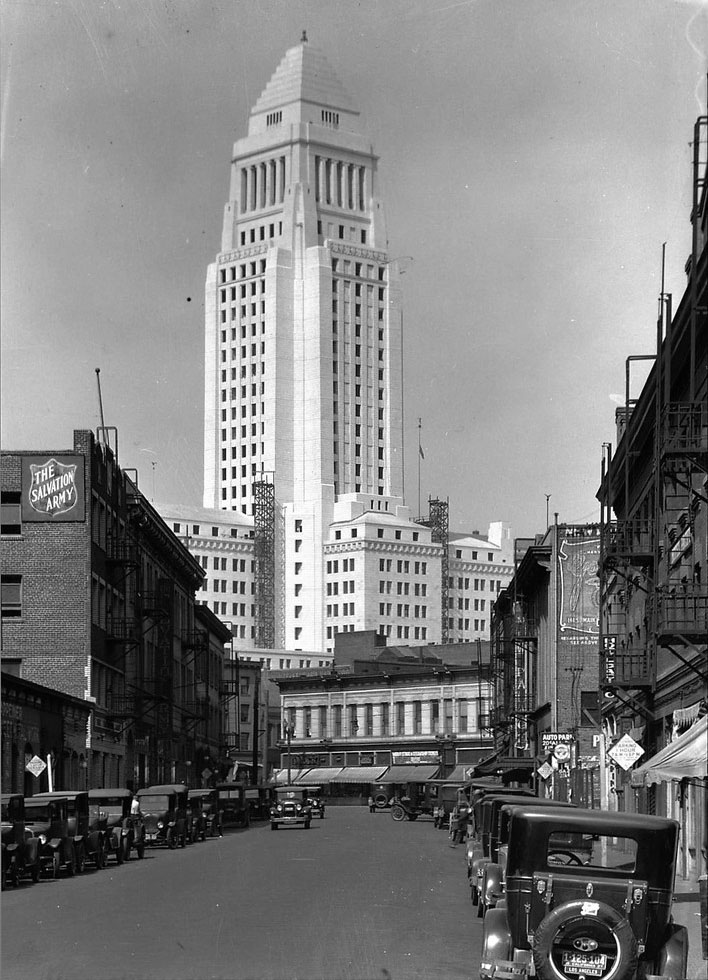 |
|
| (1928)^^ - View showing the nearly completed City Hall building as seen from Weller Street (now Onizuka Street, Little Tokyo). Metal scaffolding can be seen in place near the base of the tower. On the left can be seen the Salvation Army. |
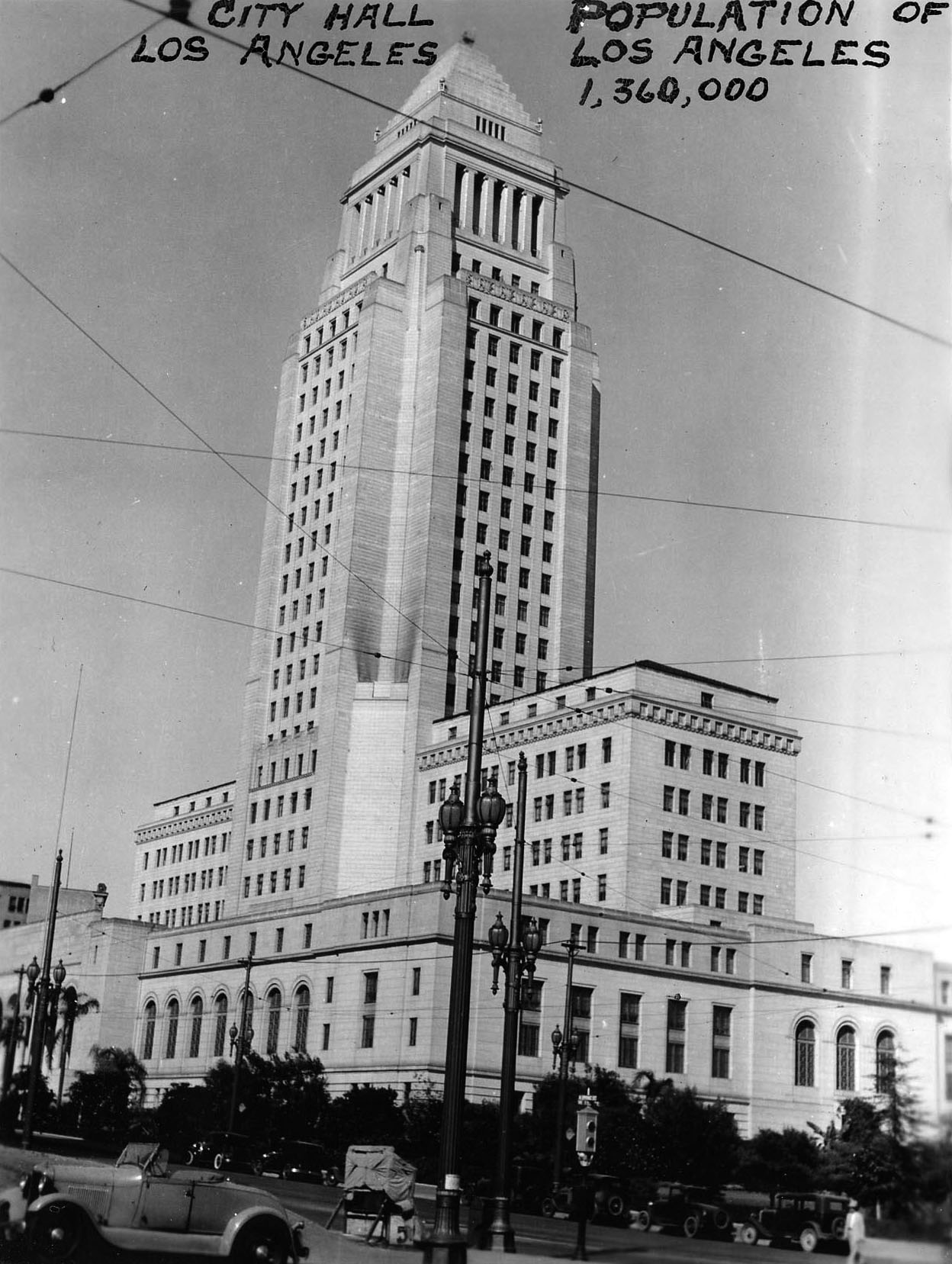 |
|
| (1934)^*# – View looking northeast toward City Hall from the intersection of Spring and 1st Street. |
| (1936)^ - The beacon light placed on the top of Los Angeles City Hall is lighted when power first arrived from Hoover Dam. |
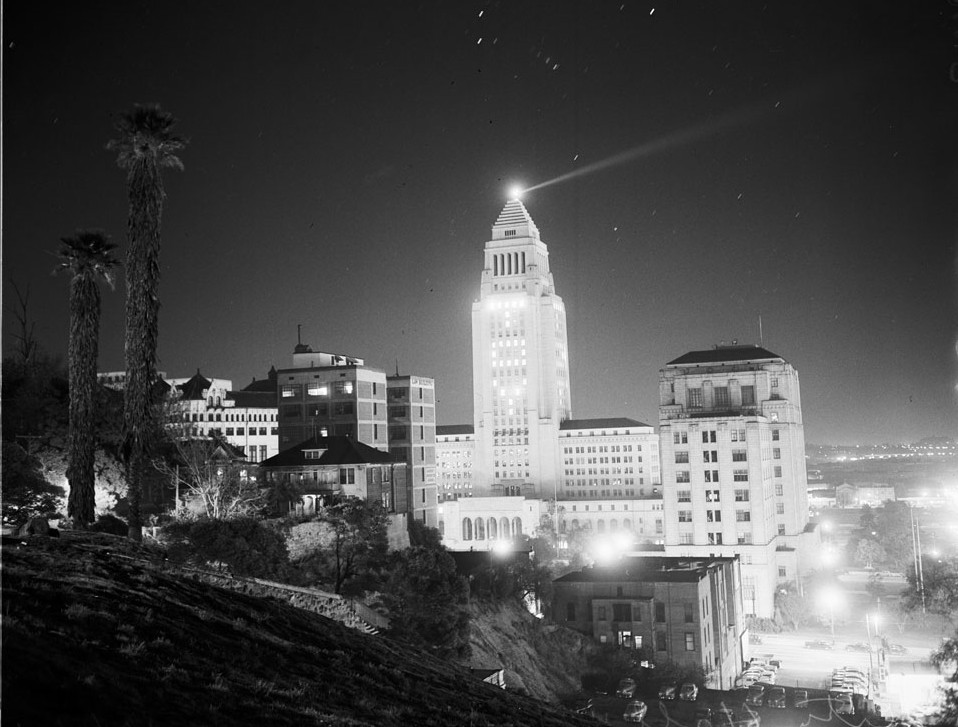 |
|
| (1951)^^ - The rotating beacon (The 'Lindbergh Beacon') is visible atop City Hall, and a portion of Bunker Hill can be seen on the lower left. At center-right is the old State Building. |
Historical Notes The Lindbergh beacon was installed on top of City Hall in 1928. Originally white, the light was replaced with a red light in 1931 after the U.S. Department of Commerce deemed the bright beacon a hazard to air safety. During WWII the light was turned off, and relit just a few of times more before being removed in the early 1950s. |
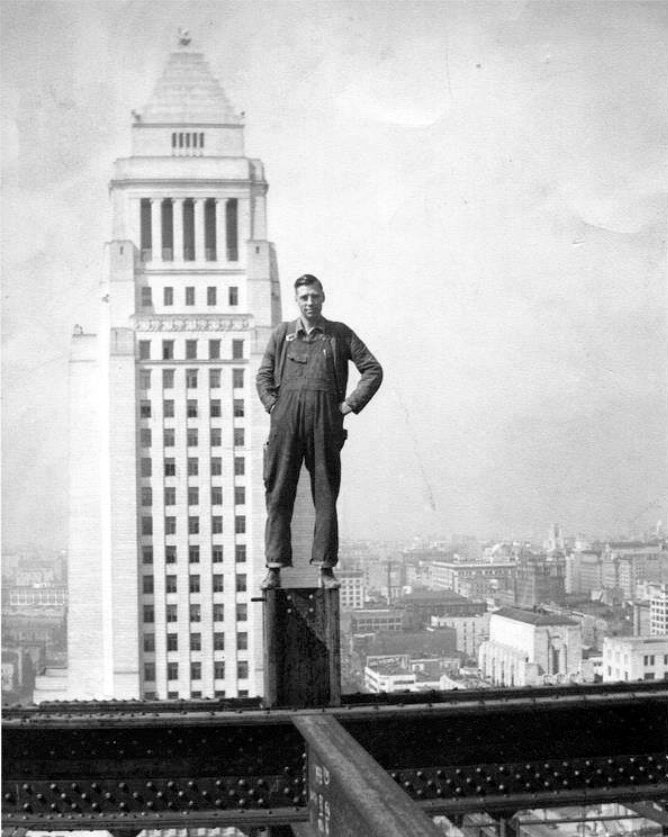 |
|
| (ca. 1938)^.^ - View looking south toward City Hall showing a man standing fearlessly on top of steel framing for the new Federal Courthouse and U.S. Post Office Building*. |
Historical Notes The Federal Courthouse and U.S. Post Office Building was completed in 1940. |
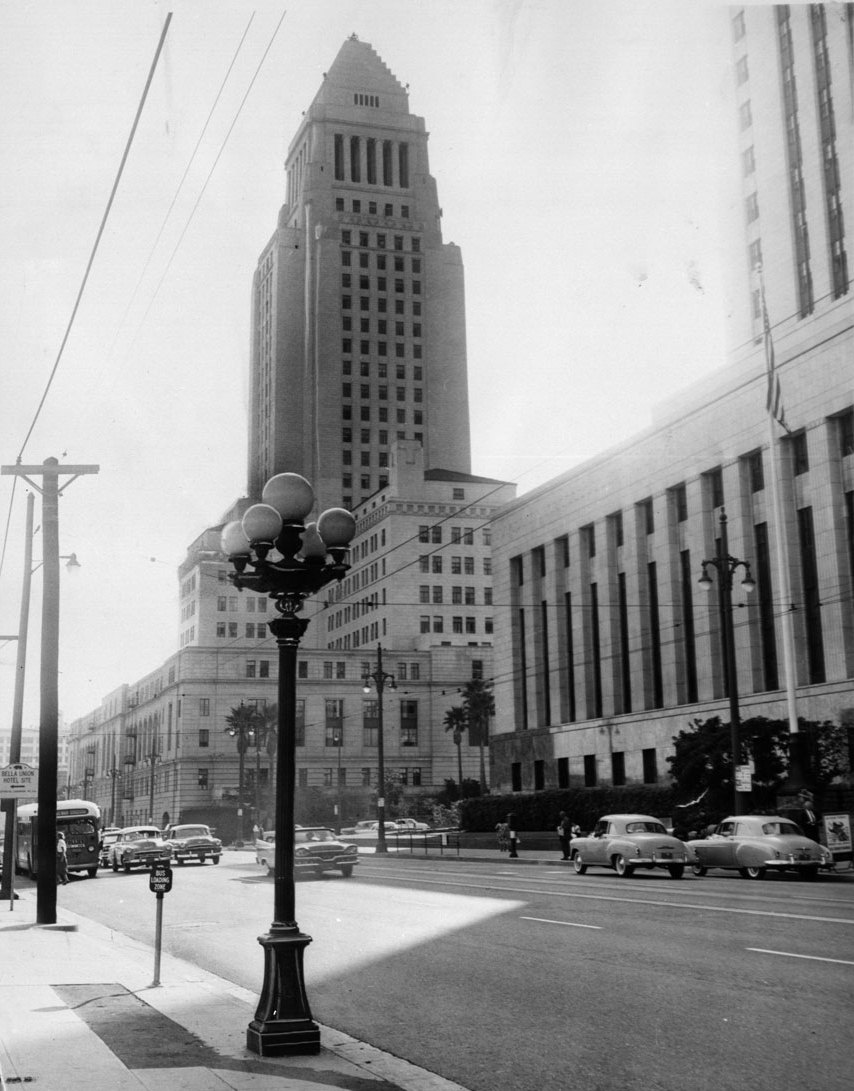 |
|
| (1959)^^ - Street view looking south on Main Street showing City Hall standing on the southwest corner of Temple and Main streets. The Federal Courthouse and U.S. Post Office Building is seen on the right. Note the beautiful 5-globe streetlight in the foreground.* |
Historical Notes The most common of the incandescent multiple globe electroliers of the early 1900s were those manufactured by the Llewellyn Iron Works of Los Angeles. The firm became so identified with this style of street light that any multiple globe electrolier became commonly known as a Llewellyn. The Llewellyn Iron Works, founded in 1889‐1890, was one of the largest metal working facilities in Los Angeles. It manufactured structural steel – including that for the Bradbury Building (1893). |
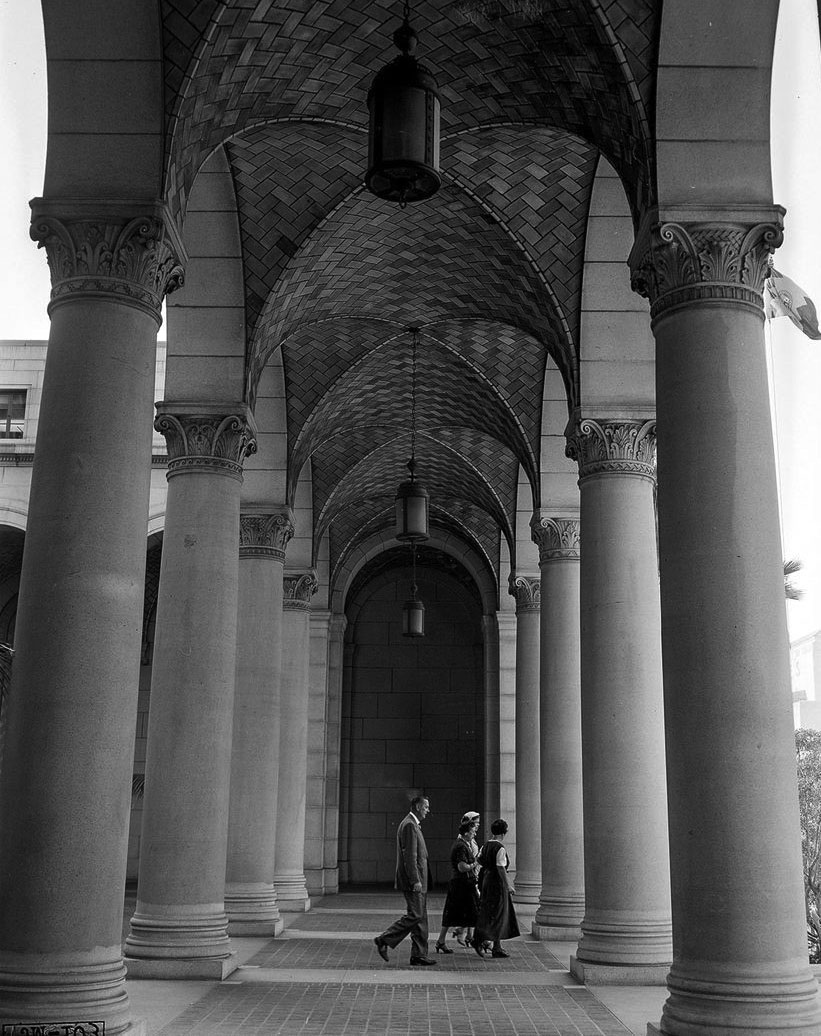 |
|
| (1955)^^ - Spring Street entrance to Los Angeles City Hall. This image led off the Know Your City photography series in the Nov. 18, 1955, Los Angeles Times. (Los Angeles Times Archive / UCLA) |
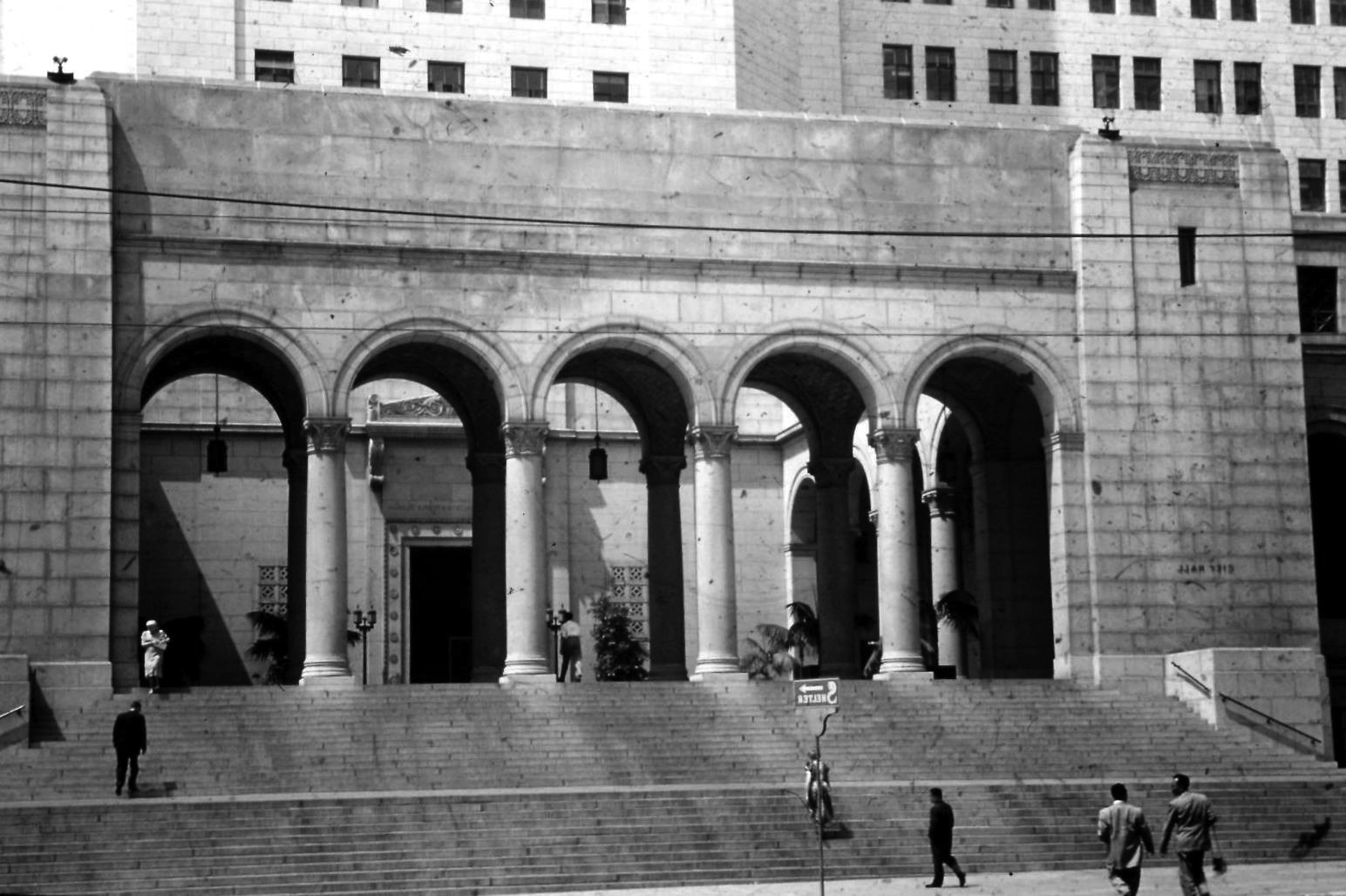 |
|
| (1950s)^ – View showing the steps to City Hall on the Spring Street side. |
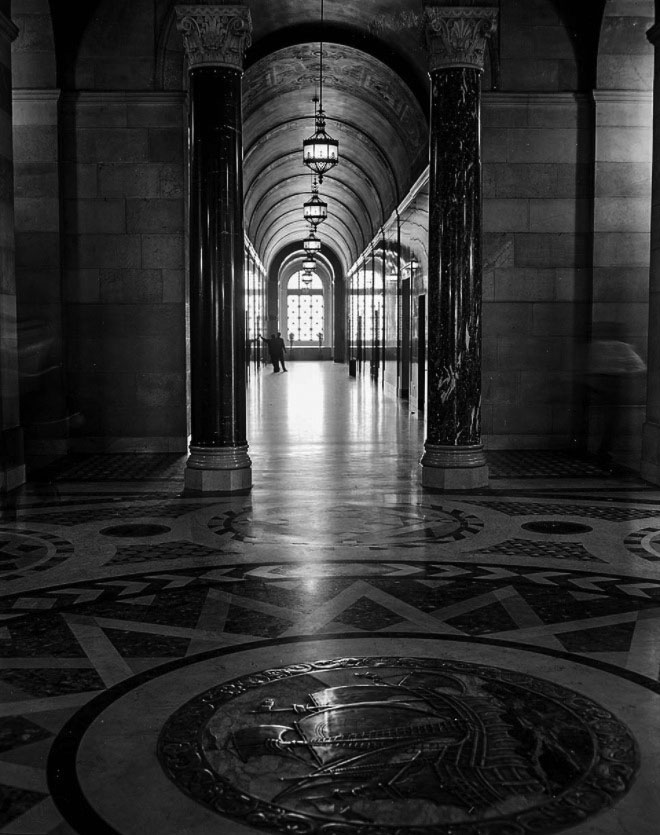 |
|
| (1955)^* – View showing the south corridor on the Spring Street floor of City Hall as seen from the rotunda. At the end, to the left, the Mayor’s office; to the right, offices of City Councilmen. Note the bronze plaque set in the middle of the rotunda’s floor. |
Historical Notes The ornately tiled rotunda with its marble columns, metal chandeliers and long, arched hallways are enough of a reason to visit City Hall.* |
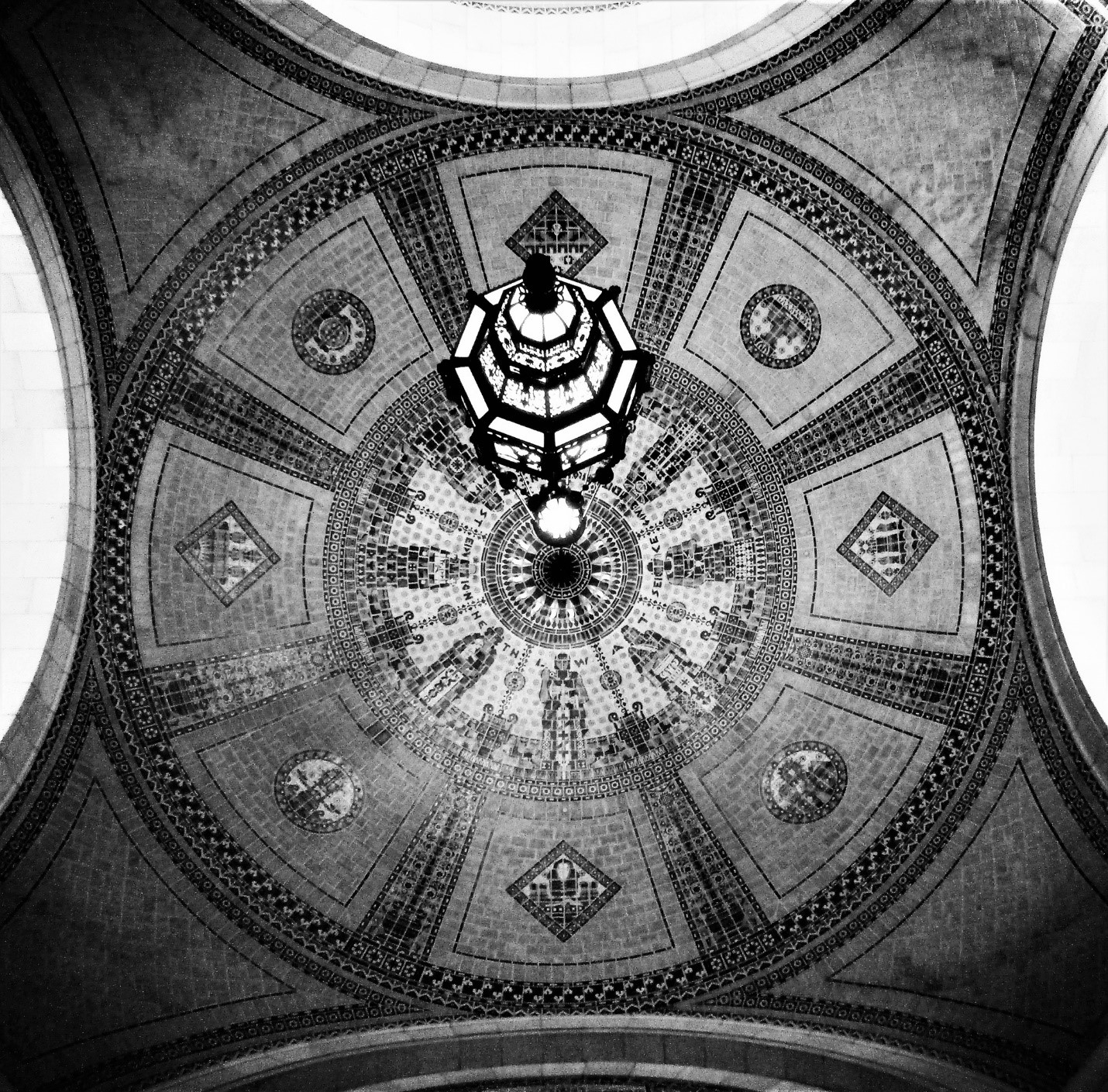 |
|
| (2021)* – Looking up at the beautiful ceiling of the City Hall rotunda located on the third floor. Photo by Howard Gray |
Historical Notes Architect Austin Whittlesey designed the interior of City Hall. Byzantine in style, it has huge vaulted ceilings, marble floors and perhaps its biggest feature, a giant rotunda high above the marble floor with ornate artworks and lighting fixtures.* |
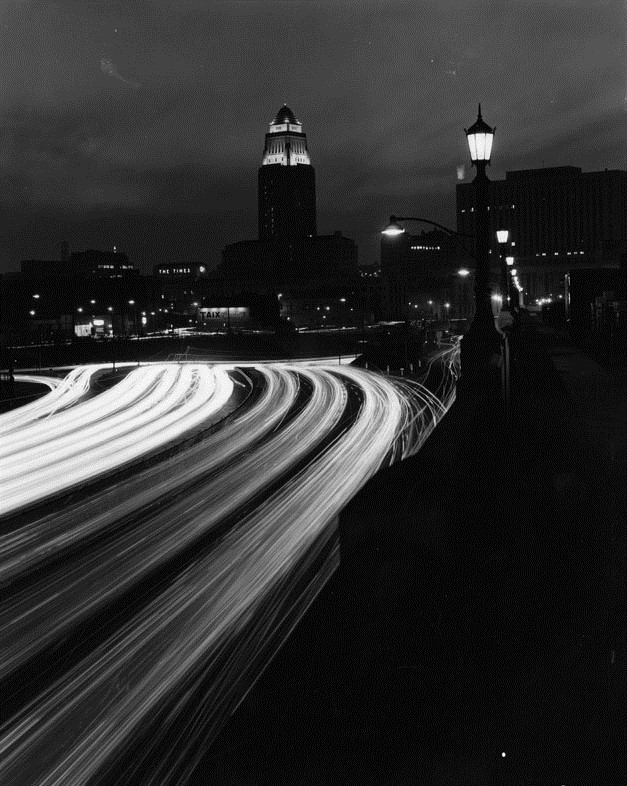 |
|
| (1962)* - Nighttime view of Los Angeles City Hall looking southwest from the San Bernardino Freeway. |
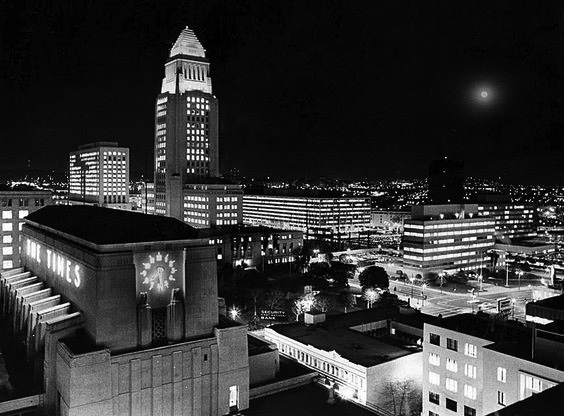 |
|
| (1969)^ – Night view looking northeast over the LA Times Building toward City Hall. With all the light, the city looks aglow! |
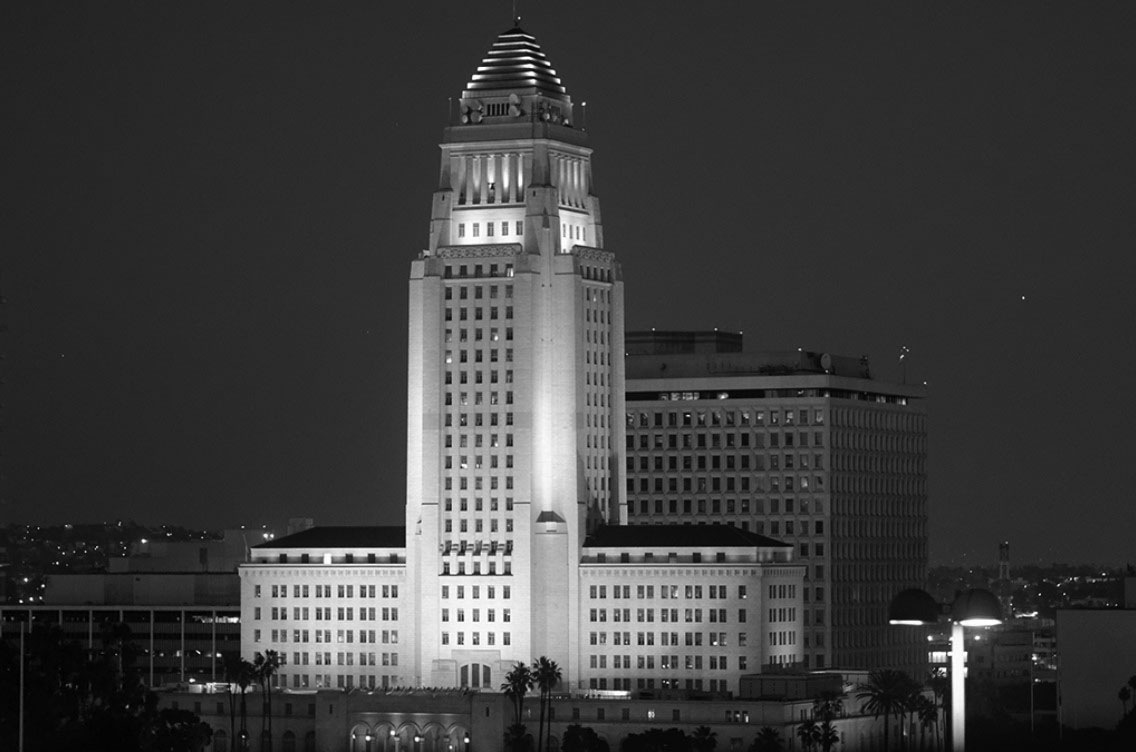 |
|
| (2013)*^ - View looking northeast showing City Hall at sunset. Photo by Michael J Fromholtz |
Historical Notes The building underwent a seismic retrofit from 1998 to 2001. It is designed to sustain minimal damage and remain functional after a magnitude 8.2 earthquake. In 1976, Los Angeles City Hall was designated LA Historic-Cultural Monument No. 150 (Click HERE for complete listing). |
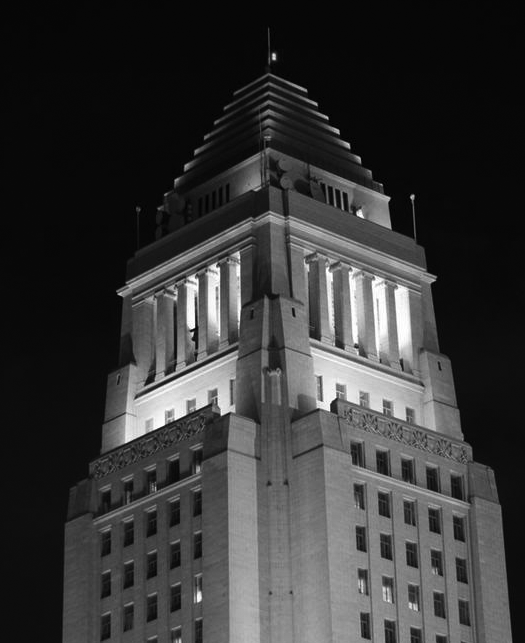 |
|
| (ca. 2015)** - Close-up view of the top floors of City Hall including the Observation Deck. |
Historical Notes The Observation Deck at City Hall is where you can get one of the best (and free) views of Los Angeles by day. Public entrance is at 201 Main Street. Open to the public, Monday through Friday from 9AM to 5PM, the Observation Deck offers an outstanding view of the downtown L.A. city skyline. Admission is free, but you will need to check in at the security desk at the Main Street entrance. They will issue a visitor badge and give you a leaflet with directions to the Observation Deck on the 27th floor. You will pass through the Tom Bradley Room on the 26th floor. The walls on this level are covered with pictures of all past mayors of Los Angeles. The "room" is not an open space - instead it's a hallway that occupies the perimeter of the floor. After you are finished looking at the pictures, you will walk up a grand staircase to the Observation level on the 27th floor. Most of the level is an open space filled with chairs and a podium. It's interesting to imagine what sort of conferences or meetings might occur from this vantage point overlooking the city. You can go outside on this level and walk around the perimeter of the floor. The view is great, and there are signs to let you know what's where. There are unobstructed views of Union Station, Disney Concert Hall and other downtown LA attractions. ^ |
 |
|
| (2013)*^ – View looking northeast showing downtown Los Angeles with snow-capped San Gabriel Mountains in the background. City Hall is seen at lower center-right. Once the tallest building in Los Angeles (1928 thru 1964), City Hall is now dwarfed by scores of other skyscraper buildings. Photo by Todd Jones |
Historical Notes Los Angeles went through a large building boom that lasted from the early 1960s to the early 1990s, during which time the city saw the completion of 30 of its 32 tallest buildings, including the U.S. Bank Tower, the Aon Center, and Two California Plaza. The city is the site of 25 skyscrapers at least 492 feet (150 m) in height, more than any other city in the Pacific coast region. As of July 2011, there were 505 completed high-rises in the city. As of May 2011, there were 60 high-rise buildings under construction, approved for construction, and proposed for construction in Los Angeles. 37 of these 60 buildings are over 100 meters tall.^ |
* * * * * |
International Bank Buillding
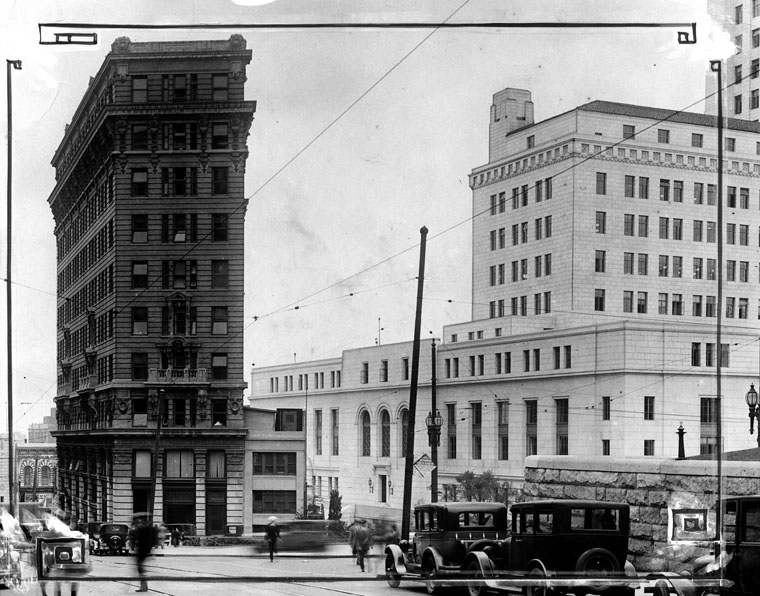 |
|
| (1929)* - Old International Bank Building, left, a landmark on Temple St. beside the new City Hall, is ordered demolished to make way for expansion of civic center. Building also houses the City Health Department, May 31, 1929. |
Historical Notes In 1928, the International Savings & Exchange Bank Building was dwarfed by the new 28-story Los Angeles City Hall, and soon after calls for its demolition increased, resulting in its razing sometime after 1954. The portion of Spring Street that its front entrance faced no longer exists.*^ |
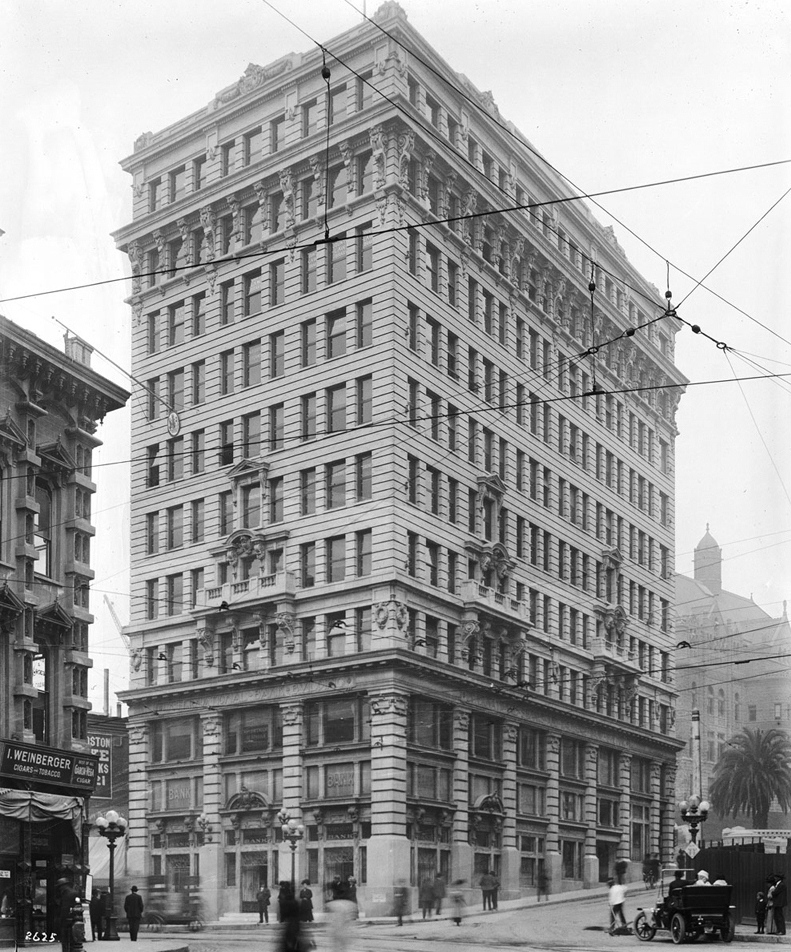 |
|
| (1910)^^ - Exterior view of the International Bank Building on the southwest corner of Spring Street and Temple Street as it appeared in 1910. |
Historical Notes The International Savings & Exchange Bank Building (also known as the International Savings Building), was built in the Spring Street Financial District of Los Angeles in 1907. Standing ten floors, it was designed in the Renaissance Revival and Italianate styles by architect H. Alban Reaves, who had previously designed several structures in New York, including what is now the south building of the historic Schuyler Arms. It stood at 226 North Spring Street, the intersection of Temple and Spring, (sometimes referred to as Temple Square) across from the Main Post Office and was featured in several postcards from the 1920s.*^ |
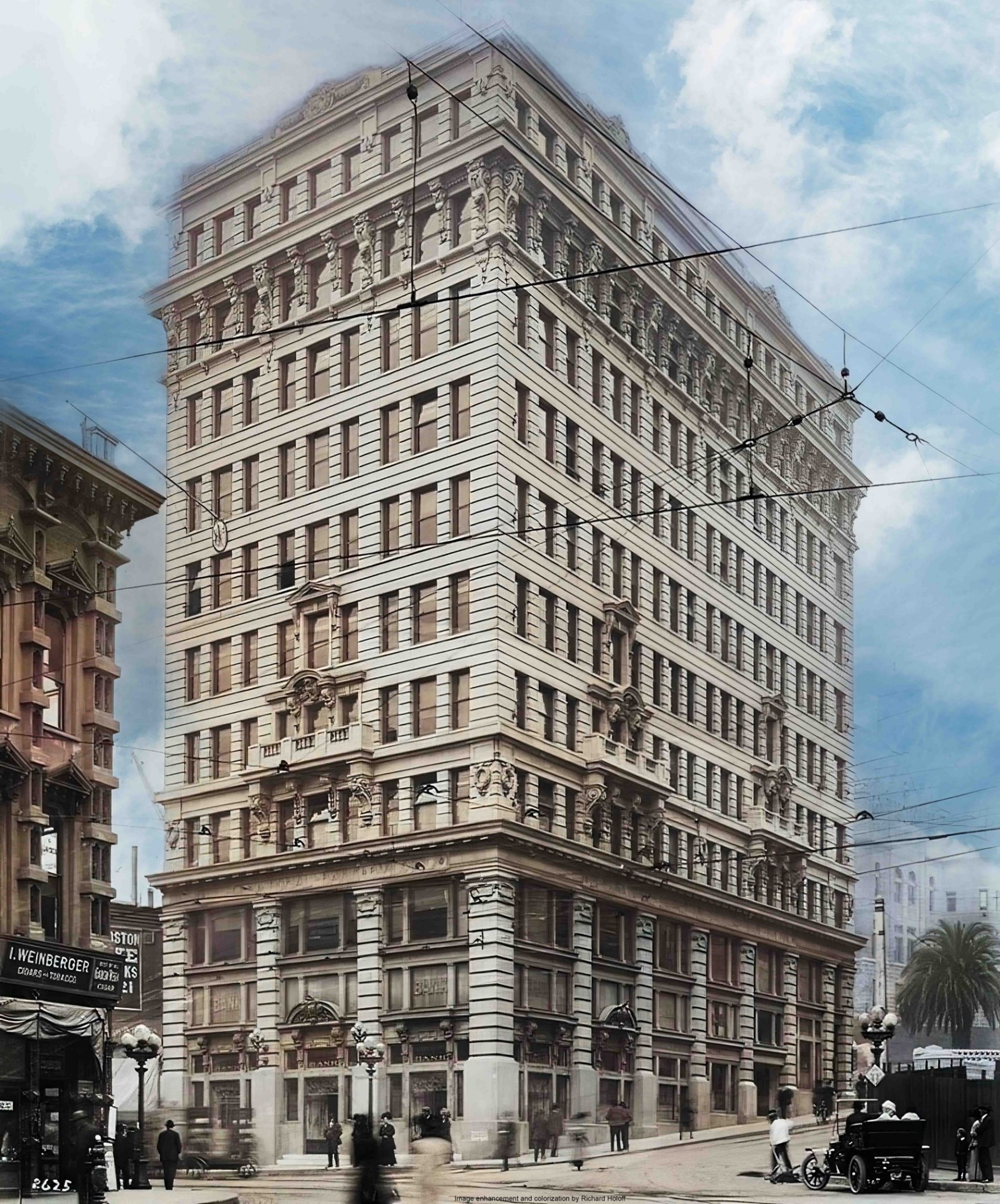 |
|
| (1910)* - The International Bank Building, located on the southwest corner of Spring and Temple streets. The LA County Courthouse can be seen in the background on the right and the Temple Block is on the left. Image enhancement and colorization by Richard Holoff. |
Historical Notes Click HERE to see more on the International Bank Buildling. |
* * * * * |
Hollywood Playhouse
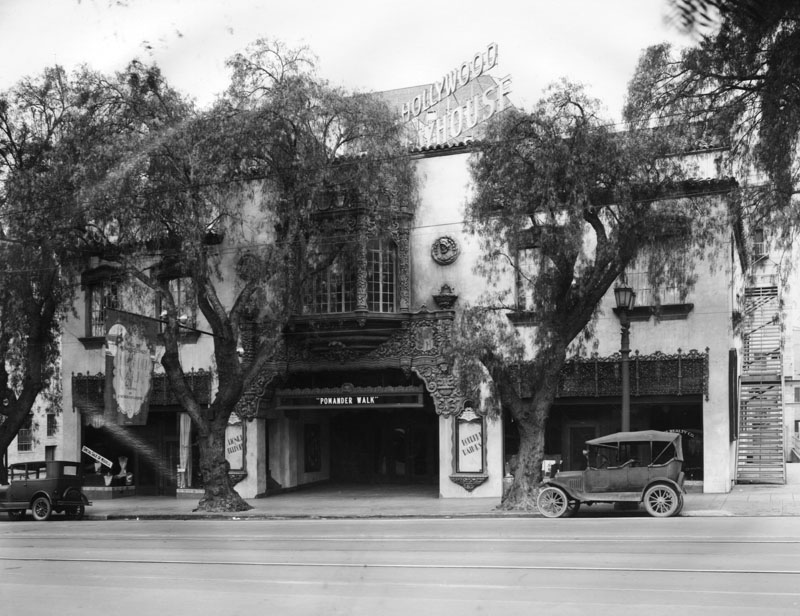 |
|
| (1927)* - Exterior view of the Spanish style Hollywood Playhouse, located at 1735 N. Vine, near the intersection of Hollywood and Vine. |
Historical Notes The Hollywood Playhouse opened for the first time on January 24, 1927. It was designed in the Spanish Baroque style by the architectural team of Henry L. Gogerty and Carl Jules Weyl in 1926-1927. During the Great Depression, the theatre was renamed The WPA Federal Theatre (after the Works Progress Administration), and used for government-sponsored programs. Later, the theatre hosted numerous CBS Radio Network programs, including Fanny Brice's Baby Snooks show and Lucille Ball's My Favorite Husband program. Lux Radio Theater broadcast condensed movie scripted versions, usually with the movie's original cast performing their movie roles. Ginger Rogers and Ray Milland performed "Lady in the Dark" in 1945.*^ |
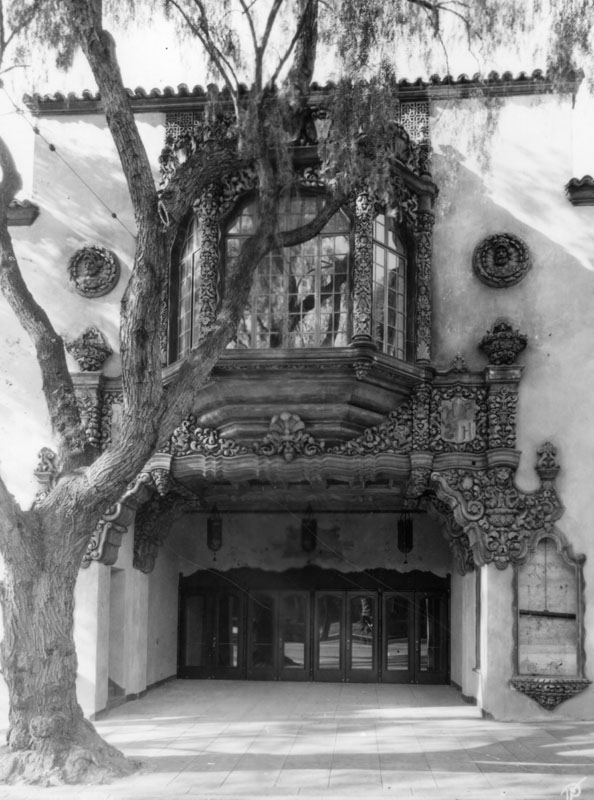 |
|
| (ca. 1927)* - Facade of the Spanish Baroque style Hollywood Playhouse entrance, designed by Gogerty & Weyl. |
Historical Notes In the 1940s, 1735 Vine was renamed The El Capitan Theatre, and was used for a long-running live burlesque variety show called Ken Murray's Blackouts. This should not be confused with the nearby movie theatre of the same name and age, the El Capitan Theatre on Hollywood Boulevard, which at the time was known as the Paramount Theatre. In the 1950s, still under the name of El Capitan, the theatre became a television studio, and it was from a set on its stage that Richard Nixon delivered his famous "Checkers speech" on September 23, 1952. This event is often mistakenly said (especially on the Internet) to have taken place at the El Capitan Theatre on Hollywood Boulevard, though that theater was never a television studio, and in 1952 was operating as a movie house called the Paramount Theatre. The theater was also home to The Colgate Comedy Hour, the Lawrence Welk Show, and This is Your Life.*^ |
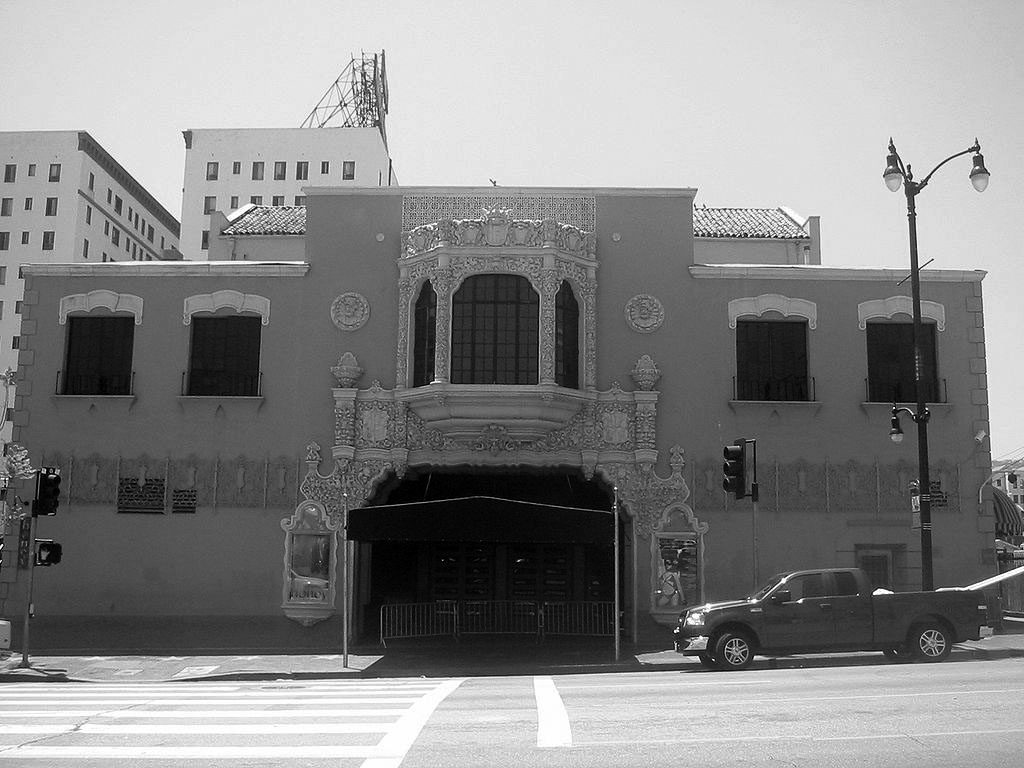 |
|
| (2007)*^ - Front view of the Avalon (formerly the Hollywood Playhouse) at 1735 N. Vine St. |
Historical Notes The Avalon (or Avalon Hollywood) is a night club and music venue. Located at 1735 N. Vine Street, it has previously been known as The Hollywood Playhouse, The WPA Federal Theatre, El Capitan Theatre, The Jerry Lewis Theatre, The Hollywood Palace and The Palace. It has a capacity of 2,000.*^ |
* * * * * |
First National Building (Hollywood)
 |
|
| (1924)^^ - View showing First National Bank and The Frank Meline Co. on the northeast corner of Hollywood Boulevard and Highland Avenue. A Hollywood Storage Co. truck is seen backed-up against the curb in front of the building. A man is standing in front of the bank entrance while a woman appears to be crossing the street. |
Historical Notes This would be the site of the iconic 13-story Hollywood First National Bank Building, built in 1927. |
First National Bank Building (later Security Pacific Bank)
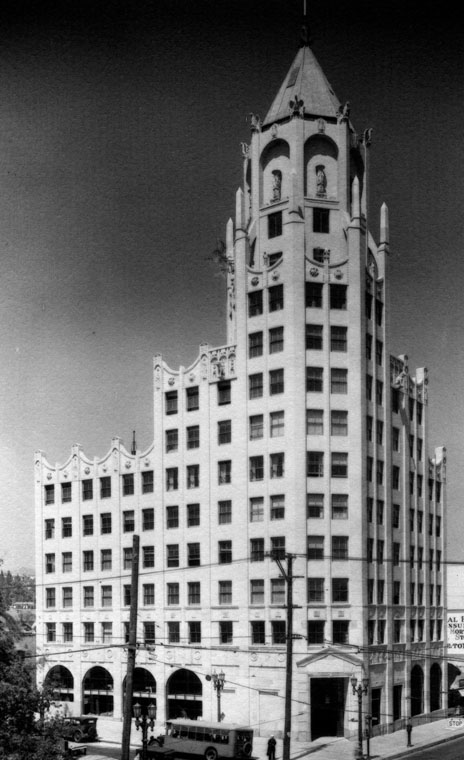 |
|
| (ca. 1927)* - Exterior view of Hollywood First National Bank, located on the northeast corner of Highland Avenue and Hollywood Blvd. |
Historical Notes Built in 1927, the First National Bank building located at 6777 Hollywood Boulevard was designed/constructed by architects Meyer and Holler who are also known for having built Grauman's Chinese Theatre, Grauman’s Egyptian Theatre, and Culver Studios. The same firm served as engineers and also did the construction.* |
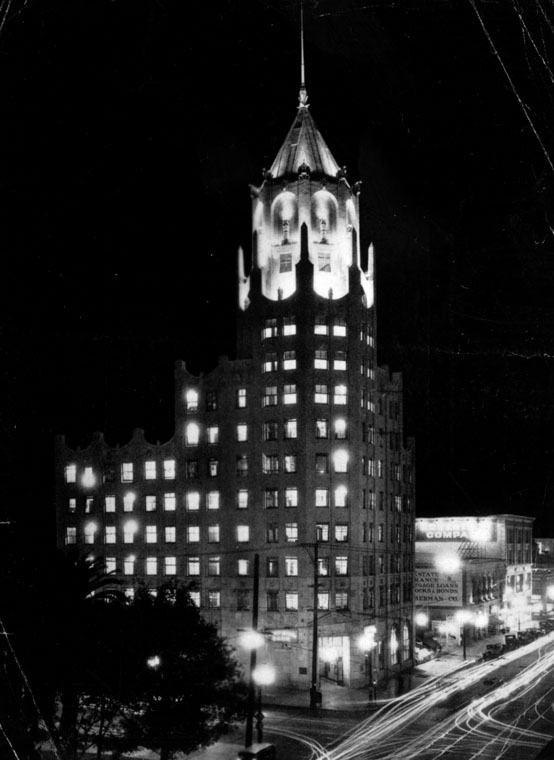 |
|
| (ca. 1928)* - Exterior night view of Hollywood First National Bank, northeast corner of Highland Avenue and Hollywood Boulevard, located at 6777 Hollywood Blvd. |
Historical Notes The thirteen story building with Gothic/Renaissance elements a la Art Deco is one of a handful of structures in the city that is adorned with gargoyles. The building's architects (Meyer and Holler) created an eclectic hybrid of art deco and neo-gothic styles. It was the tallest building in Los Angeles from 1927 to 1932.* |
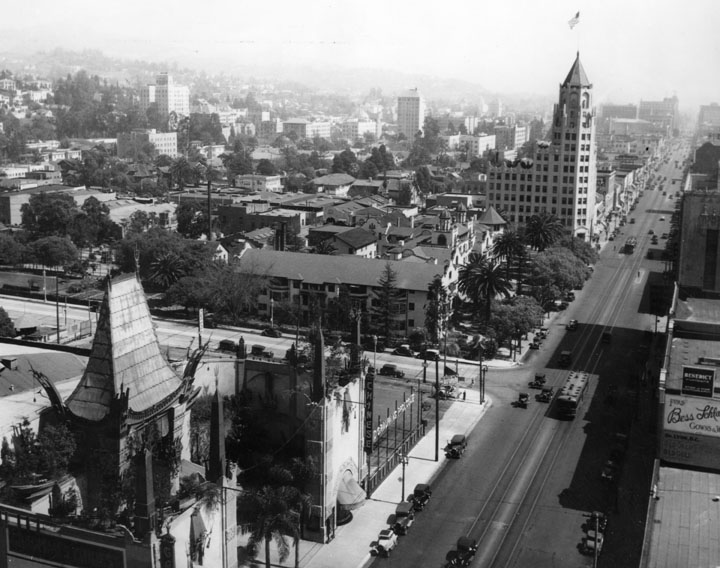 |
|
| (ca. 1930)* - An aerial view of Hollywood from Grauman's Chinese Theatre (on the lower left). In the distance, the tallest building is the First National Bank. |
Historical Notes The First National Bank Building was designed in Art Deco/Gothic style by architects Meyer and Holler and built in 1927. It is located on the northeast corner of Hollywood Blvd. and Highland Avenue. Grauman's Chinese Theater was also designed by Meyer and Holler and it too was built in 1927. The theater is located at 6925 Hollywood Boulevard.* |
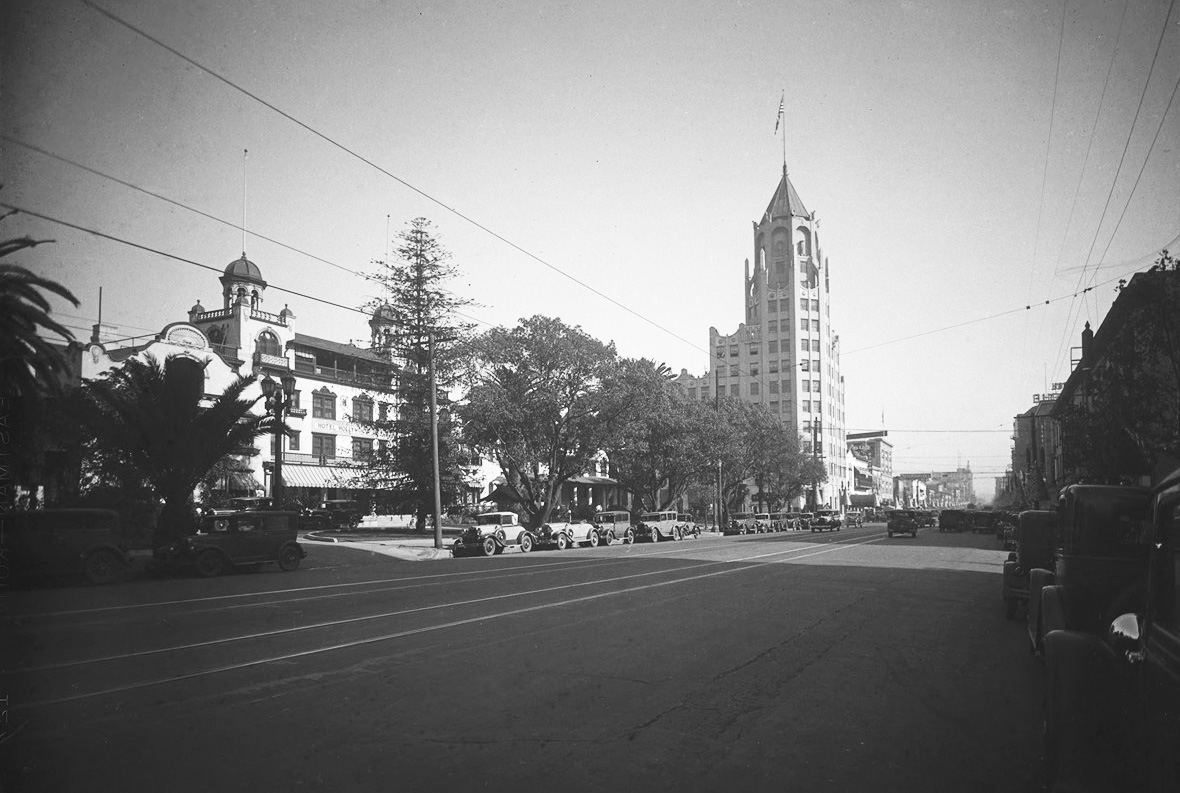 |
|
| (1931)* – Street view looking east on Hollywood towards Highland with the First National Bank of Hollywood seen on the NE corner. Also seen here on the left is the 1902-built Hollywood Hotel. |
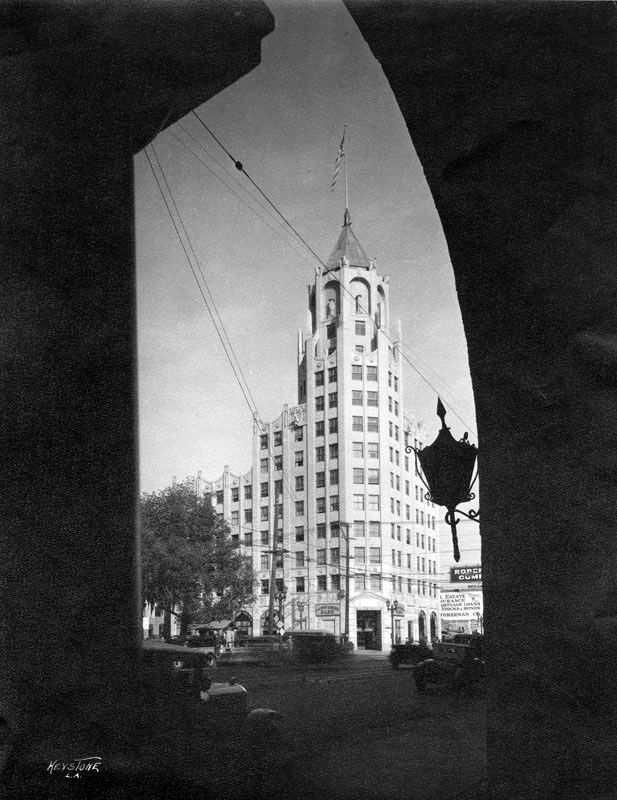 |
|
| (1935)* - Northeast corner of Highland and Hollywood Blvd. showing the facade of the First National Bank of Los Angeles, Hollywood Branch which is topped by a tower decorated with sculptures in arched niches and a flagpole. |
Historical Notes On September 1, 1868, Hellman, Temple and Co. opened in the then small town of Los Angeles. The banking firm was the predecessor of Farmers and Merchants Bank (1870), which was the predecessor of Security First National Bank. The bank earned a reputation for aggressive and creative business practices and benefited from economic and population growth in the Western United States. By the mid-20th century it had an international presence, and was ranked the fifth-largest bank in the United States and third-largest in California in terms of deposits. In 1967, Security First National Bank bought Pacific National Bank and became Security Pacific National Bank. In 1992, Bank of America acquired Security Pacific National Bank.*^ |
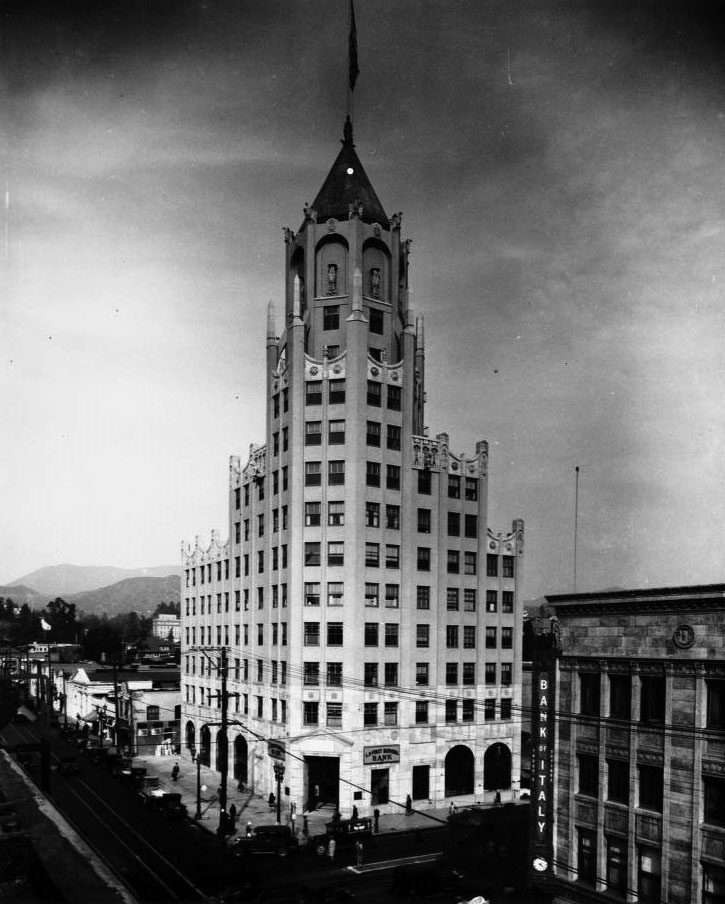 |
|
| (ca. 1938)^^ - View looking toward the northeast corner of Hollywood and Highland where the iconic Security First National Bank stands. The Bank of Italy++ (later Bank of America) stands across the street on the southeast corner. |
Historical Notes ++The Bank of Italy was founded in San Francisco, on October 17, 1904 by Amadeo Giannini. It grew by a branch banking strategy to become the Bank of America, the world's largest commercial bank, with 493 branches in California and assets of $5 billion in 1945.*^ |
.jpg) |
|
| (1953)**^* - View of Hollywood Blvd. looking east from the roof of the Roosevelt Hotel. The Hollywood Hotel and the Security First National Bank building can be seen at the intersection of Highland Ave and Hollywood Blvd. |
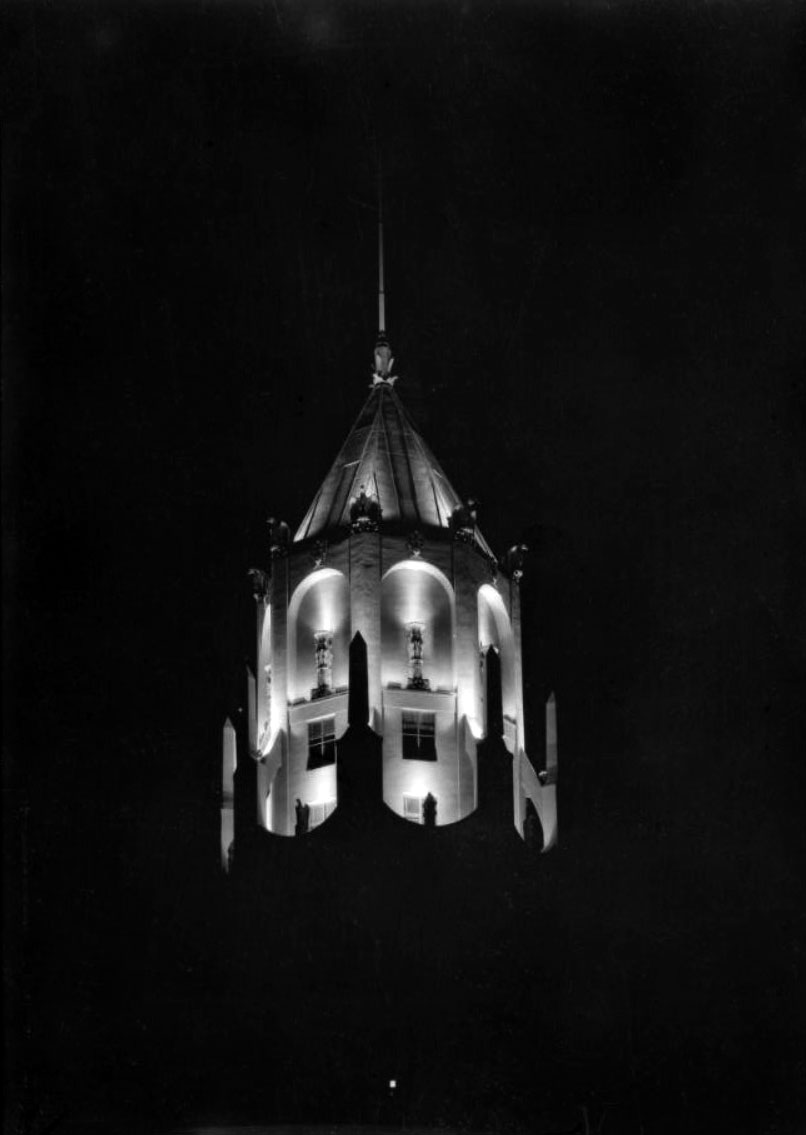 |
|
| (1928)^^ - Night view showing the illuminated Gothic-Style tower of the First National Bank Building in Hollywood. The tower is decorated with sculptures in arched niches and a flagpole. |
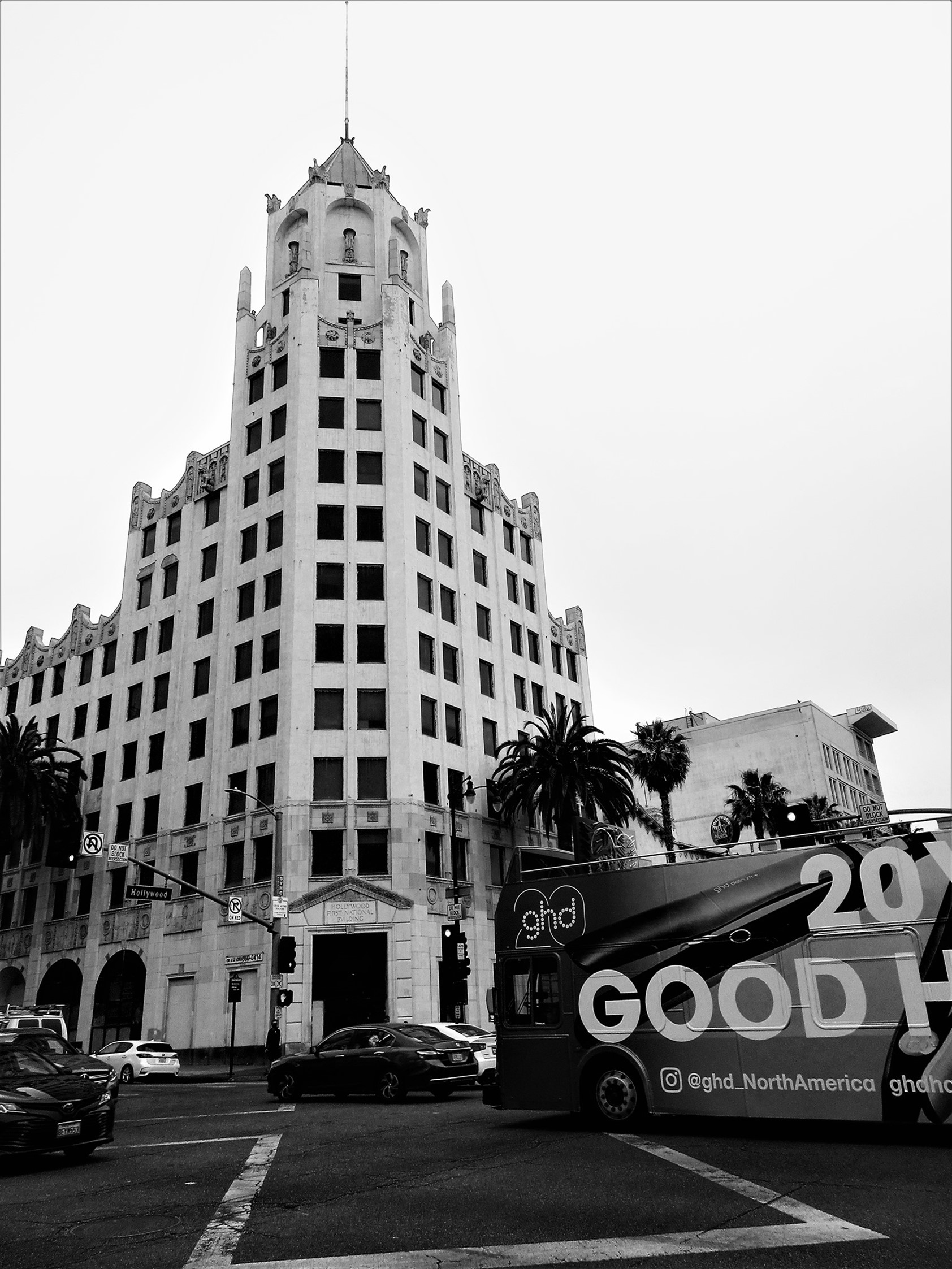 |
|
| (2021)*- Looking toward the First National Bank Building as a tour bus passes by. Photo by Howard Gray |
Historical Notes The Art Deco 13-story building on the northeast corner of Highland Avenue and Hollywood Boulevard was occupied by Security Pacific Bank until 2008 and has been vacant since. |
* * * * * |
Hollywood Storage Co. Building (aka Toberman Store Co. Bldg)
 |
|
| (1928)* - Front view of the Hollywood Storage Co. Building, located at Highland Avenue and Santa Monica Boulevard. |
Historical Notes Standing at fourteen stories tall, this building was made entirely out of concrete to protect its precious storage from risk of fire. Designed in the Spanish Colonial Revival style, this facility would hold costumes and set pieces during the film industry’s earliest years. The height of the building aided as the perfect location for radio towers, which local radio station KMTR took advantage of.* Morgan, Walls & Clements designed this Spanish revival style building, completed in 1925.* |
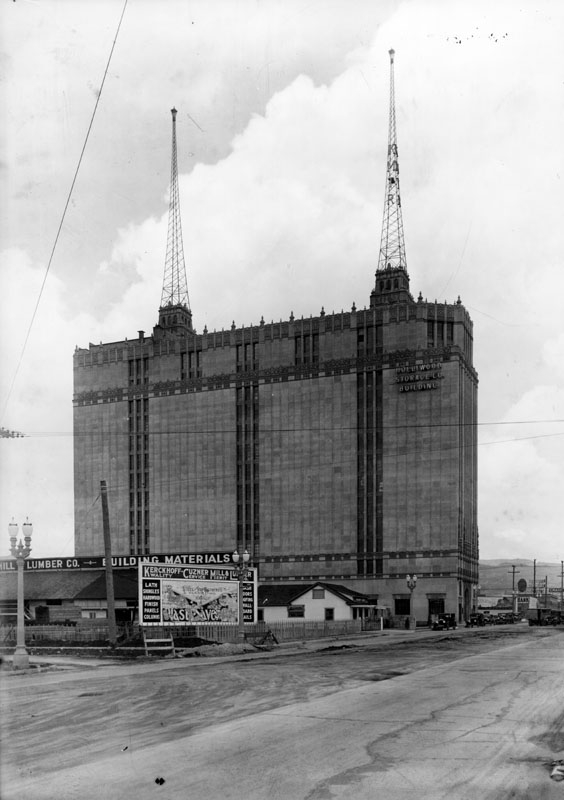 |
|
| (1928)* - Side view of the Hollywood Storage Co. Building, located at 1025 N. Highland Ave. |
Historical Notes The Hollywood Storage Building was the tallest building in Hollywood at the time of its construction. The brainchild of Charles E. Toberman, it would become one of many that the early real estate mogul would create in Hollywood, including Grauman’s Chinese and Egyptian Theaters, and the Hollywood Roosevelt Hotel. But the Hollywood Storage Building would be a completely different kind of project as the many films now being produced in the area were in need of a place to store their props and equipment.* |
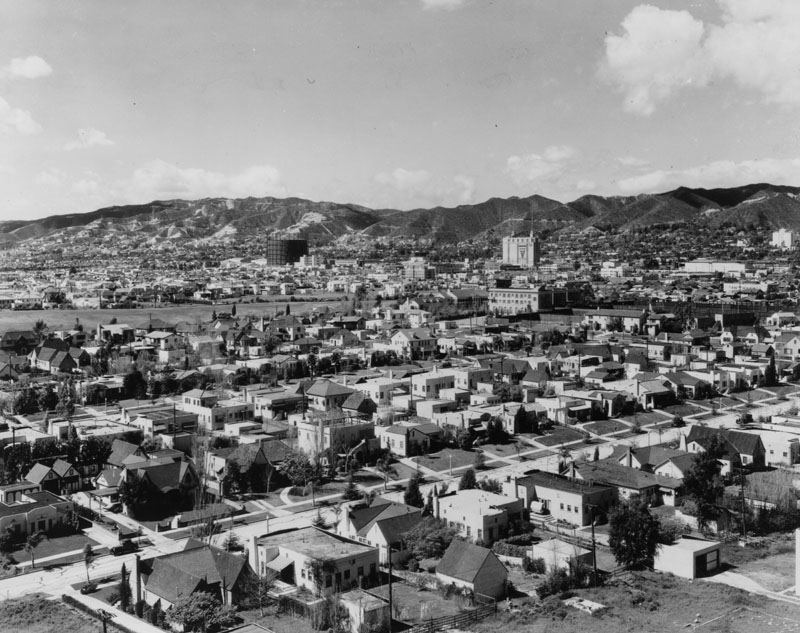 |
|
| (1930)* - Panoramic view of Hollywood looking northwest on a very clear day. The Hollywood Storage Co. Building, located at Santa Monica Boulevard and Highland Avenue, is the tallest building in the area. |
Historical Notes The Hollywood Storage Building was purchased by Bekins in 1939. The building was also home of the Evening Herald radio station, KMTR.* |
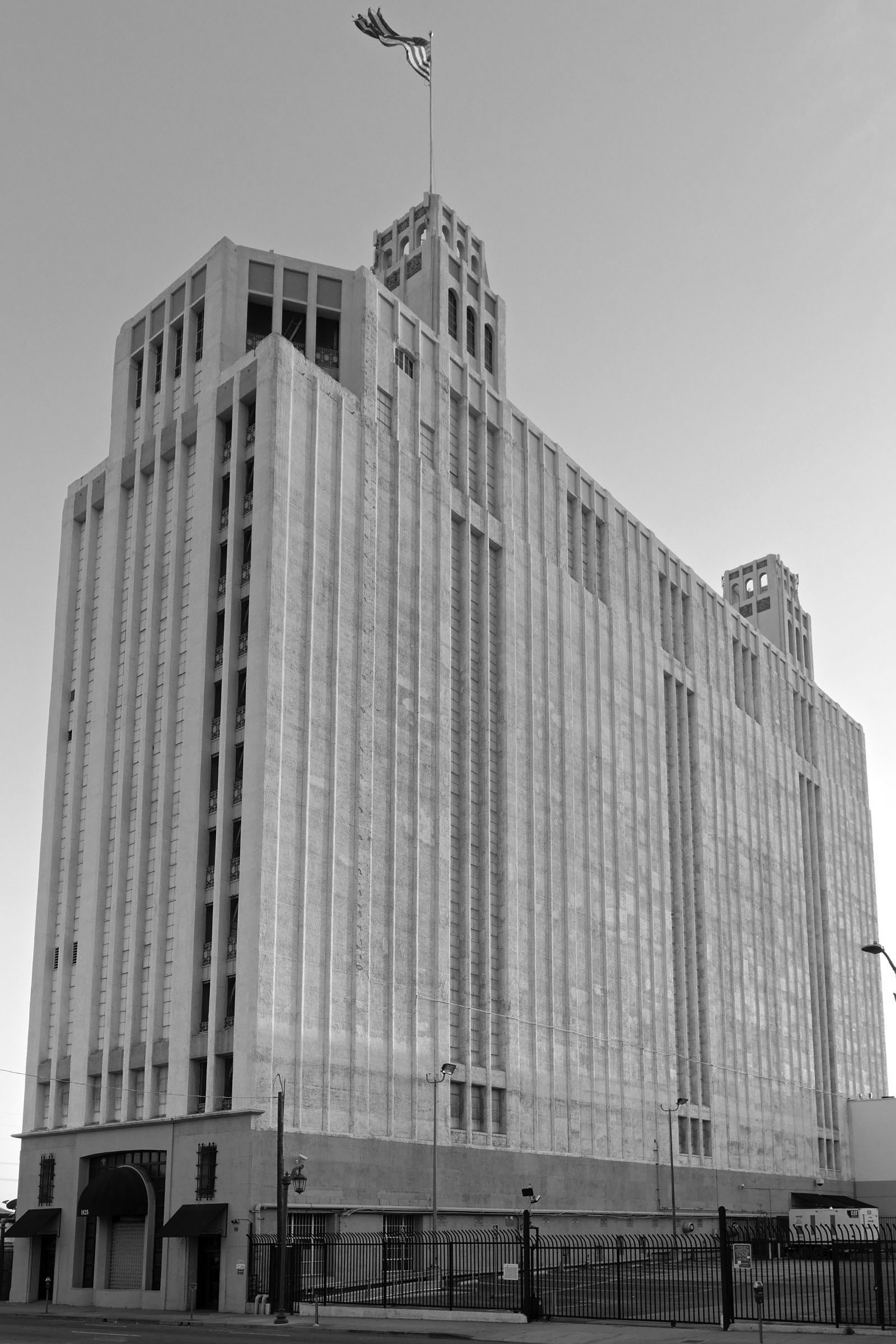 |
|
| (2015)^ - Hollywood Storage Building, aka Toberman Storage Company (Bekins Van and Storage) |
* * * * * |
John C. Fremont Branch Library (aka June St. Library)
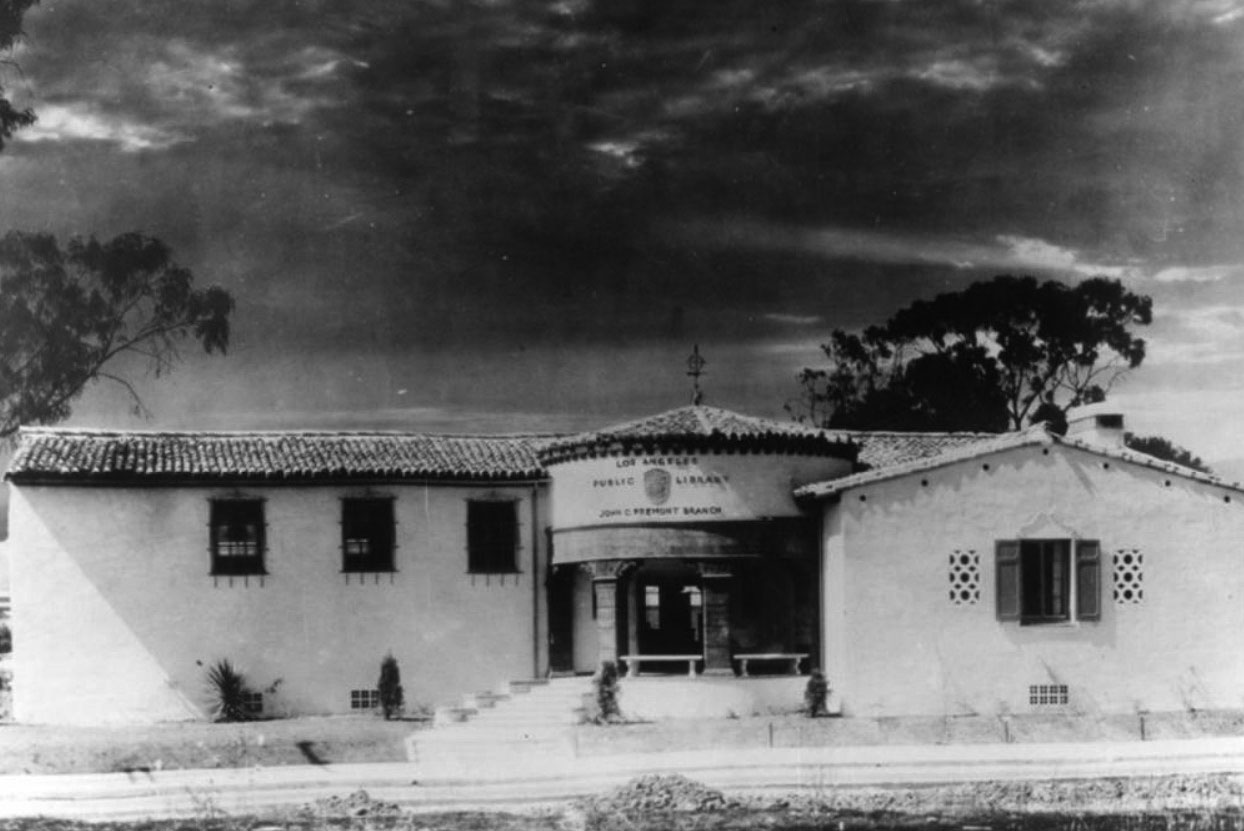 |
|
| (1927)* – View showing the newly completed John C. Fremont Branch of the Los Angeles Public Library at 6121 Melrose Avenue. Note the designs on the columns at the entrance and wrought iron bars over the windows. |
Historical Notes John C. Fremont Branch Library was built in 1927 based on a Mediterranean Revival design by architect Merl L. Barker. |
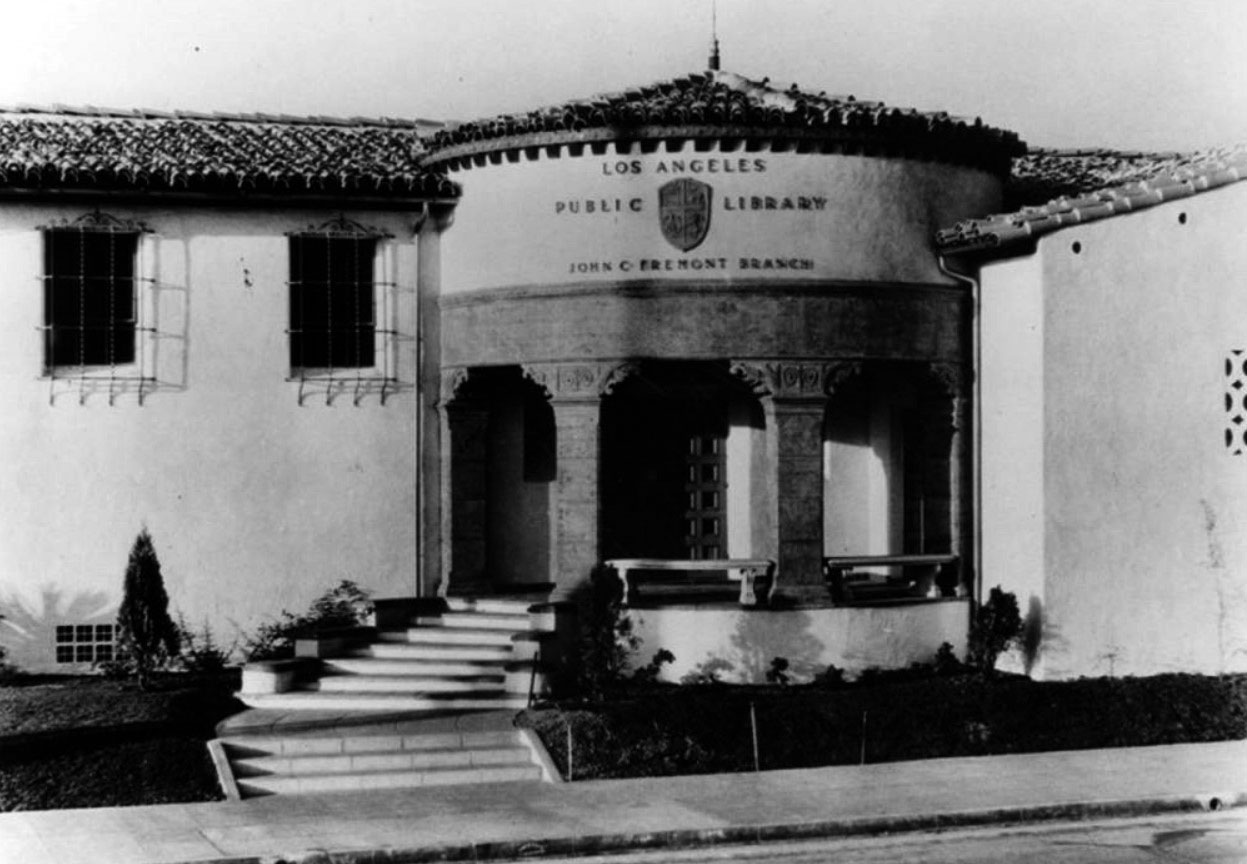 |
|
| (1927)* – Close-up view showing the entrance to the John C. Fremont Branch Library. |
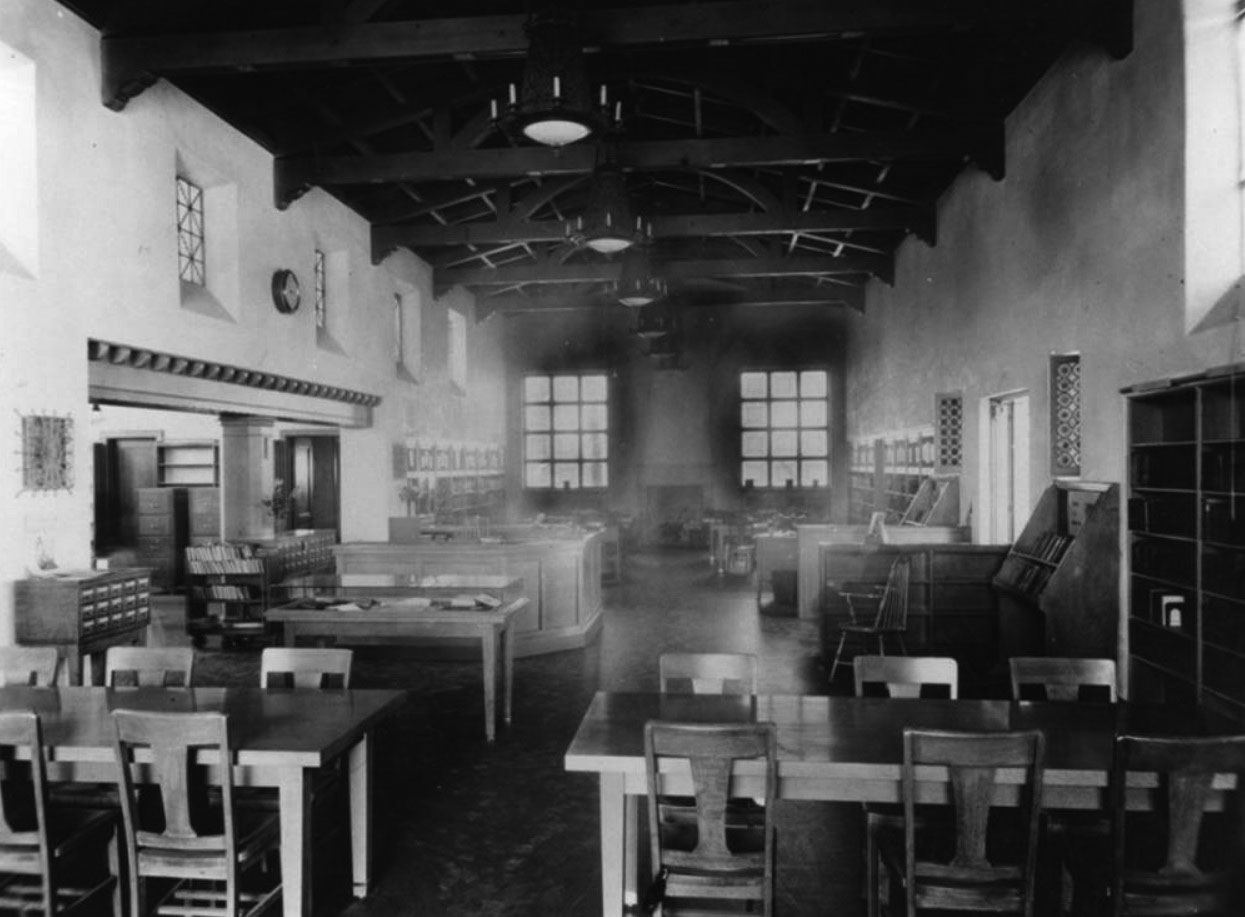 |
|
| (1927)* - Interior view of John C. Fremont Branch of the Los Angeles Public Library, located at 6121 Melrose Avenue. |
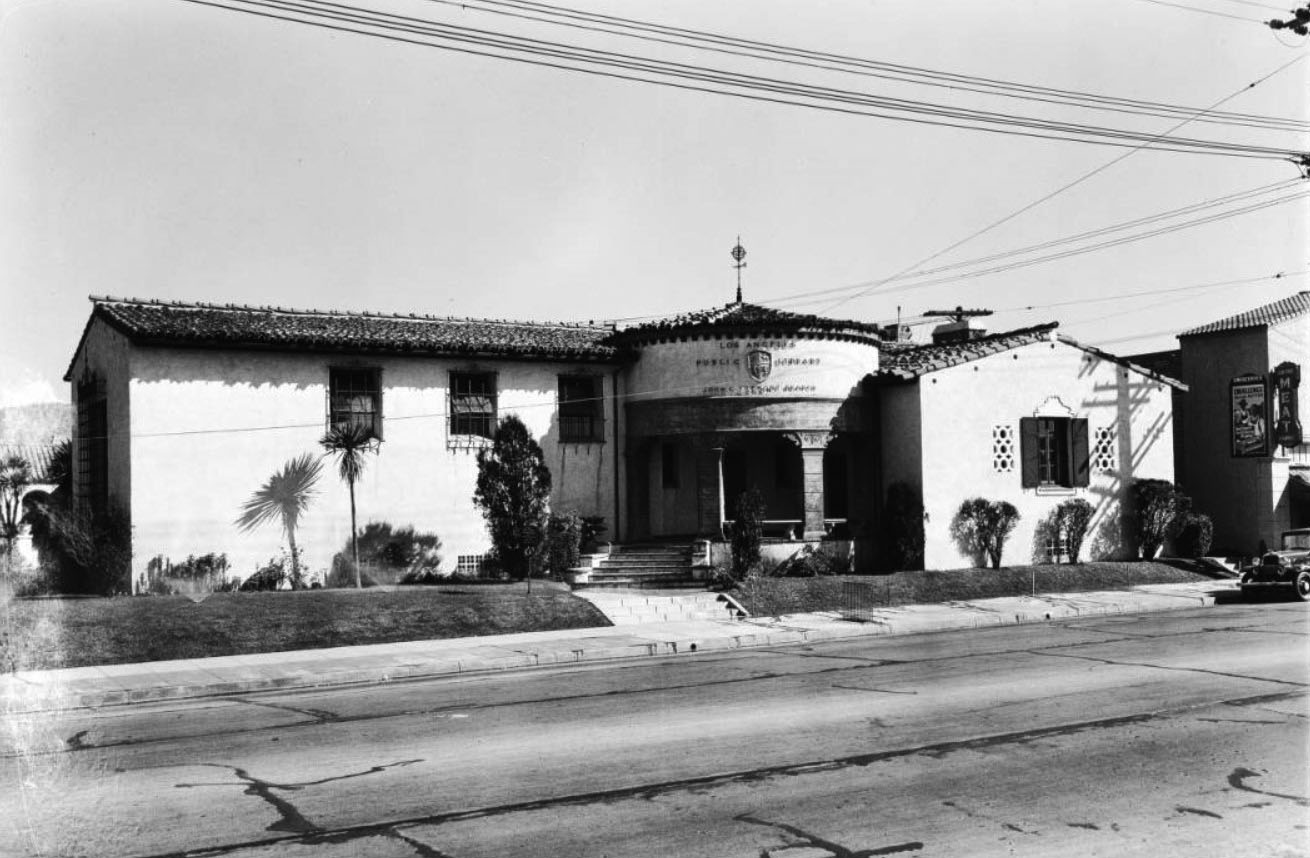 |
|
| (1930s)* – View looking across Melrose Ave showing the Spanish-style Fremont Branch Library located on the NE corner of Melrose and June Street. On the right can be seen an early model car parked in front of a meat store. |
Historical Notes The library closed in 1990 because its masonry was not reinforced and the building was not in compliance with seismic safety codes. The library operated from a temporary location until February 1996. The library re-opened in its current location on March 26, 1996. The in-compliance library gained air conditioning, a meeting room, a small parking lot, wiring for computer and internet usage, and access for disabled persons.^ |
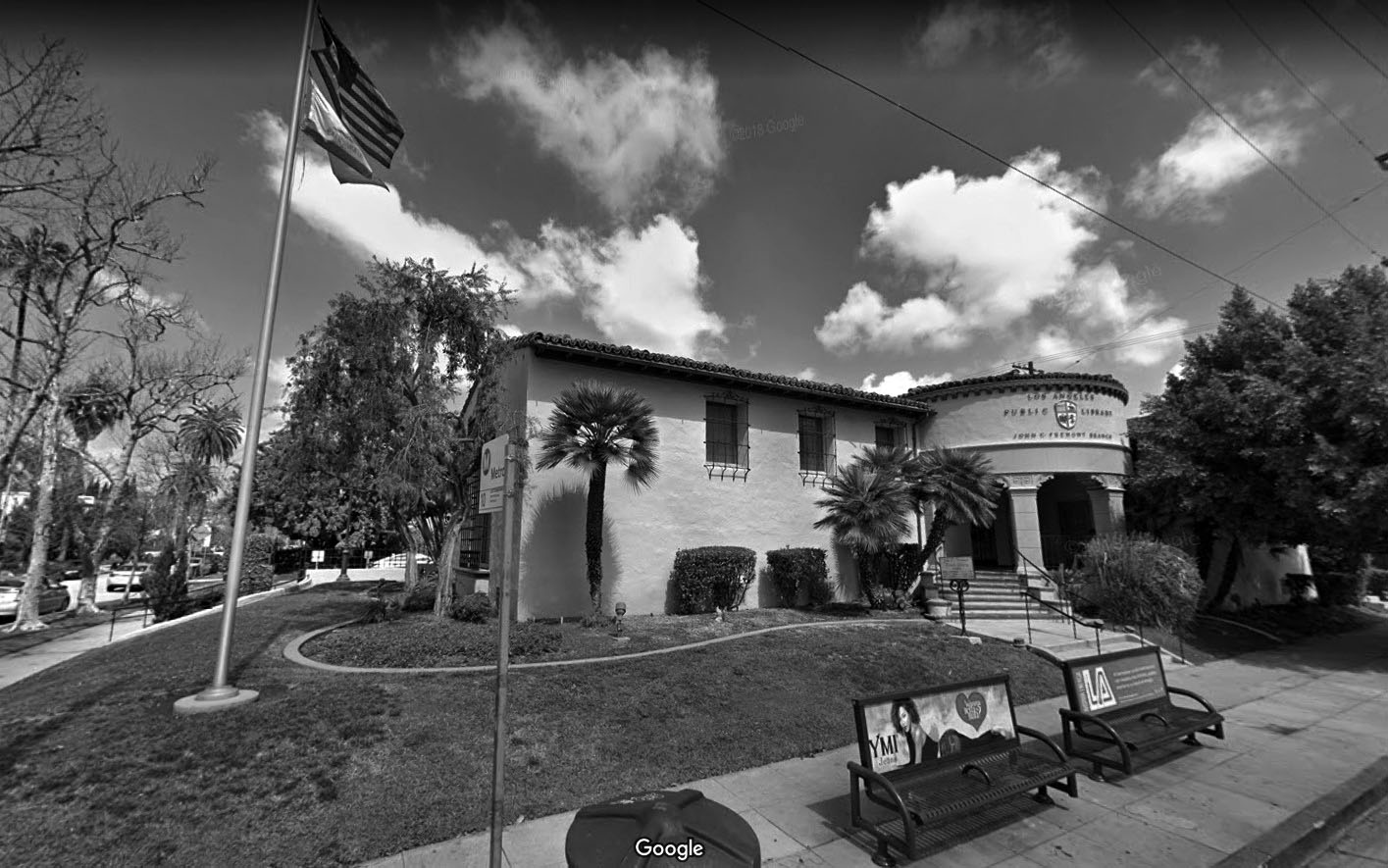 |
|
| (2018)^.^ – Google street view showing the John C. Fremont Branch Library as it appears today. |
Historical Notes On June 27, 1986, John C. Fremont Branch Library was declared Los Angeles Historic-Cultural Monument #303. In 1987, the Fremont Branch and several other branch libraries in Los Angeles were also added to the National Register of Historic Places as part of a thematic group submission. The application noted that the branch libraries had been constructed in a variety of period revival styles to house the initial branch library system of the City of Los Angeles.^ |
* * * * * |
Ralphs Market (Hollywood)
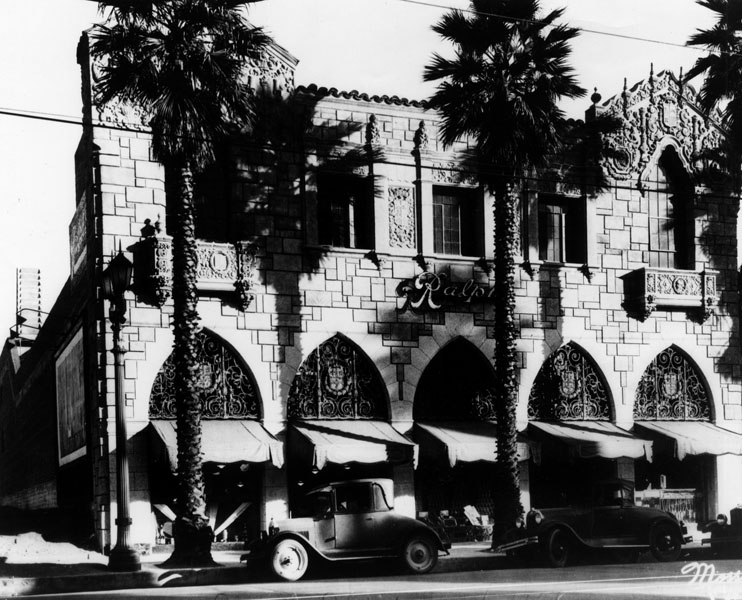 |
|
| (1929)* - View showing three early model cars parked in front of the Ralphs Grocery Store at 5711-17 Hollywood Boulevard, in Hollywood. |
Historical Notes This Ralphs Market was built in 1929 and designed by Morgan, Walls & Clements in a Gothic and Churrigueresque Revival design. Ralphs Grocery Company was founded in 1873 by George Albert Ralphs with the original store being located at Sixth and Spring Streets. Click HERE to see an 1886 photo of George Ralphs standing in front of his original store in downtown LA. By the twentieth century, Ralphs stores featured innovative self-service aisles and included a wide variety of foods and services under one roof. As Ralphs' business grew along with the city, he hired the noted architectural firm of Morgan, Walls, and Clements to design a series of grocery stores promoting a clean and substantial image.^ |
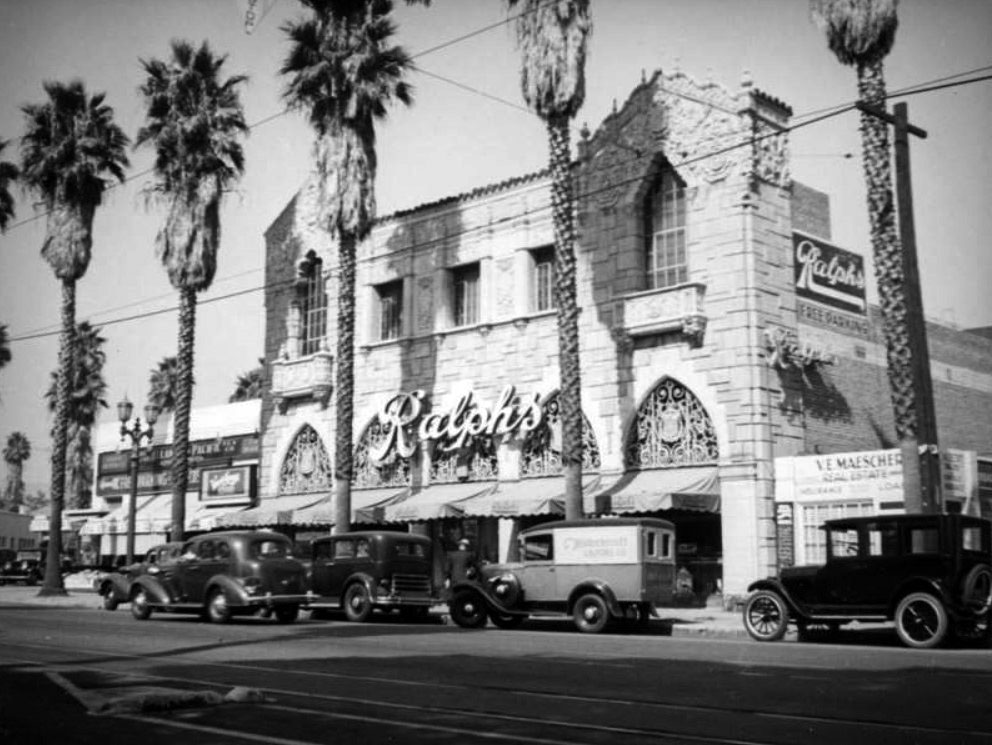 |
|
| (ca. 1937)* - Looking northwest across the street towards the Ralphs supermarket at 5711-17 Hollywood Boulevard. |
Historical Notes The building has since been razed and replaced with another commercial building. Today, a Piers 1 Imports stands at the site of the old Ralphs Market. Click HERE for contemporary view. |
Ralphs Market (Miracle Mile)
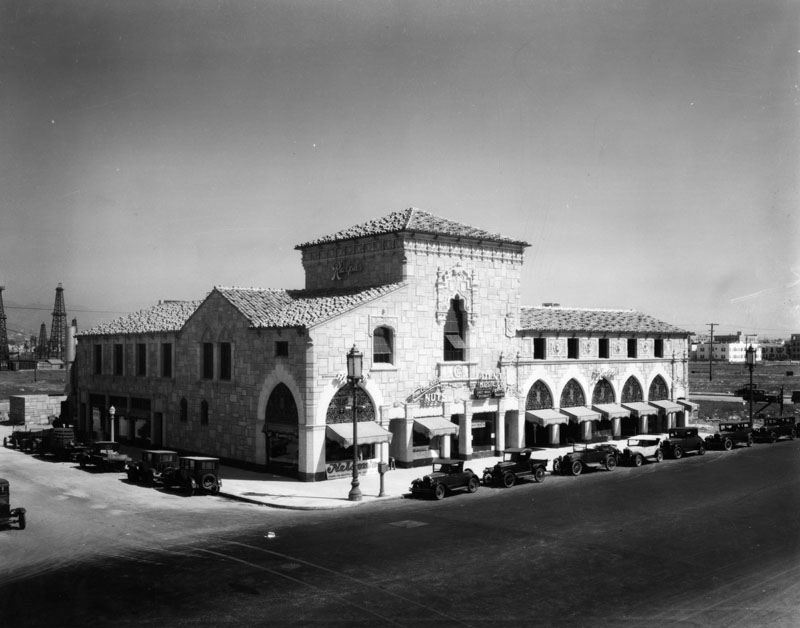 |
|
| (1928)* - View of the arcade-style Ralphs Market located on the NE corner of Wilshire and Hauser boulevards. Small shops in the building include Dent Music Company and Tom Campbell Nuts. Note the oil derricks in the background (left). |
Historical Notes When the Miracle Mile store was constructed in 1928, the neighborhood was full of fallow fields and oil derricks. Clements' design integrated separate commercial spaces into the grocery building for rental tenants, heralding a promising future for the area while giving Ralphs another source of income.^ In the 1980s, this Ralphs fell to the wrecking ball. It was replaced by a block-long Alpha Beta grocery store, which was eventually bought out by Ralphs, unintentionally bringing the property full circle.^ |
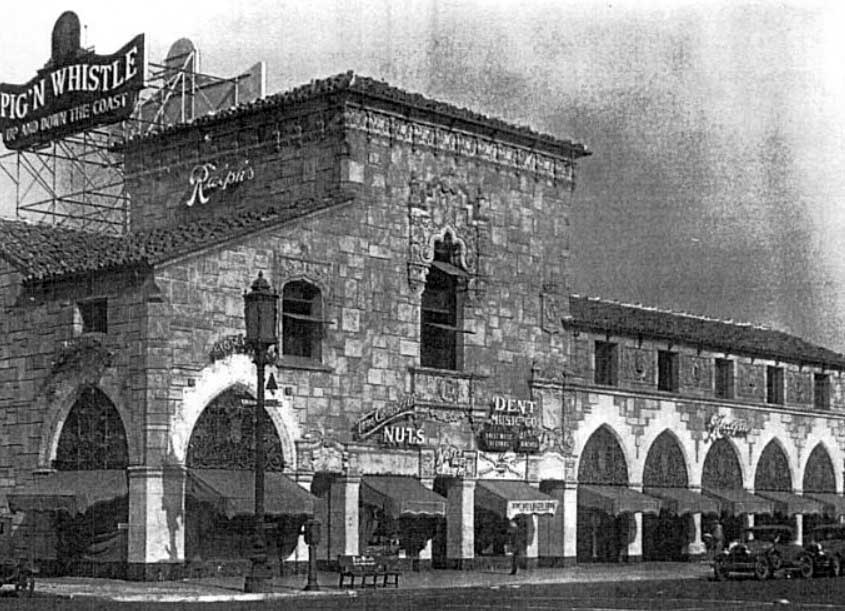 |
|
| (ca. 1929)**#* – View of Ralphs Market located on the northeast corner of Wilshire and Hauser on the Miracle Mile. Large sign on top of the rear of building reads: PIG’N WHISTLE – Up and Down the Coast |
Historical Notes The Spanish Colonial Revival building with a sidewalk arcade was designed by Morgan, Walls and Clements and constructed in 1928. A Pig’n Whistle restaurant was located in the Ralphs Market building from 1929 to 1938. The restaurant was closed when the Pig’n Whistle company opened its new upscale restaurant, Melody Lane, at Wilshire and Detroit. |
Ralphs Market (Westwood)
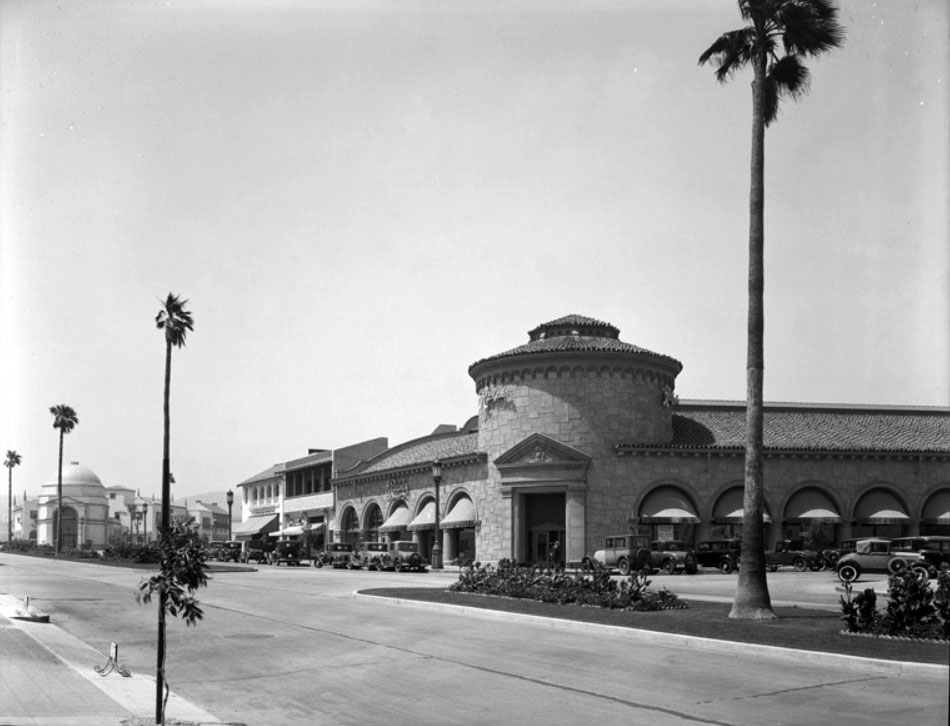 |
|
| (1930s)#^ - View showing the Westwood Ralphs Market designed by Russell E. Collins and S. N. Benjamin in Mission Revival/Spanish Colonial Revival style. |
Historical Notes When the new Westwood Village began to open in 1929, one of its original buildings was the Ralphs Grocery Store located on Westwood Boulevard, one block north of Wilshire Boulevard. The store's most prominent feature was its low rotunda, at the corner of Westwood Boulevard and Lindbrook Drive. The building's exterior walls were built with imitation stone, but were later covered with stucco. The building's style has been described as having Mission Revival, Spanish Colonial Revival, Romanesque Revival and Renaissance Revival elements, and is said to have served as a model for other low-rise commercial structures in the village. Early advertising materials for the Westwood Village development featured images of the Ralphs tower and the Janss dome, which became area landmarks. The opening of the store in the fall of 1929 was timed to coincide with the opening of the UCLA campus, and the Los Angeles Times proclaimed the store "one of the most beautiful exclusive grocery marts in the West." The opening was celebrated with a free food show, as Ralphs boasted a new feature at their Westwood store — "the employment of uniformed boys to wrap each purchase of merchandise while it is being paid for at the cashier's stand, and then carry it to the customer's car." *^ |
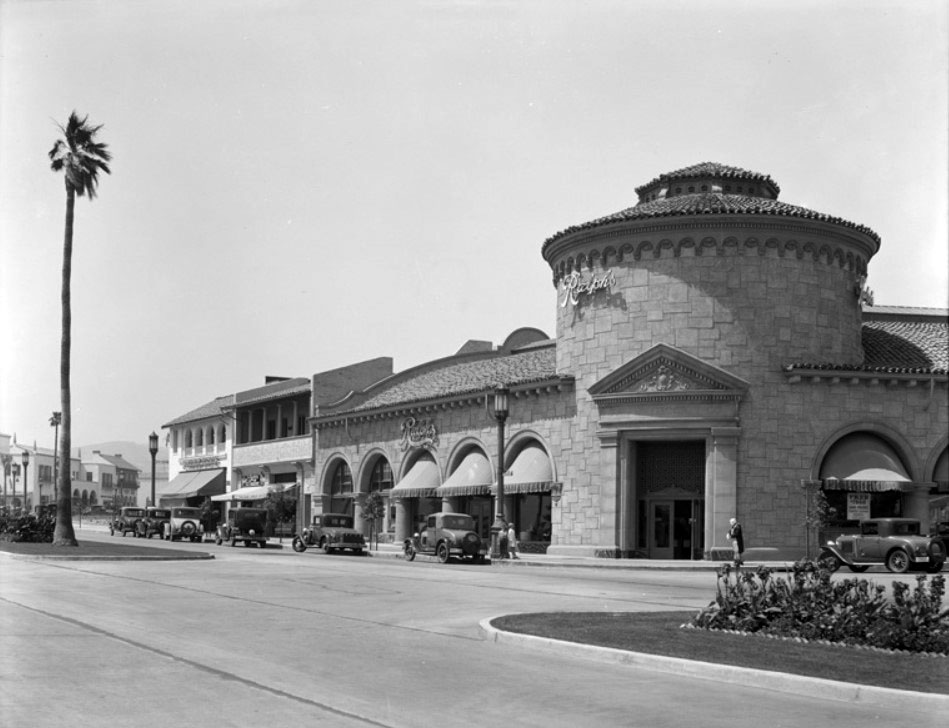 |
|
| (1930s)#^ – View looking north on Westwood Boulevard showing Ralphs Market located on the northeast corner of Westwood and Lindbrook Drive. |
Historical Notes Ralphs operated a grocery store on the site until the mid-1960s, when it left Westwood Village. Ralphs returned to Westwood Village nearly 40 years later, converting the old Bullock's department store into a grocery store (formerly sharing the space with a Best Buy and an Expo Home Design Center). Since Ralphs vacated the building in the mid-1960s, it has housed a number of different businesses. In 1970 a large portion of the space facing Lindbrook Drive was converted into a movie theater, which was known over the years as the United Artists Theater, the UA Egyptian, the Odeon Cinema and finally as the Mann Festival which closed on July 30, 2009. The Bratskeller restaurant, popular with UCLA students, also operated at the building from the late 1960s through the mid-1980s. In the late 1990s and early 2000s the prime corner space at the base of the tower was split between Daphne's Greek Cafe and Togo's Sandwich Restaurant. In late 2008, they were replaced with a Peet's Coffee & Tea, which remains currently. In early 2012, part of the shuttered movie theater was converted to 800 Degrees Neapolitan Pizzeria.*^ In 1988, the Ralphs Building was declared Historic-Cultural Monument No. 360. It was also listed on the National Register of Historic Places in 1992. |
* * * * * |
Fox Ritz Theatre (aka West Coast Ritz)
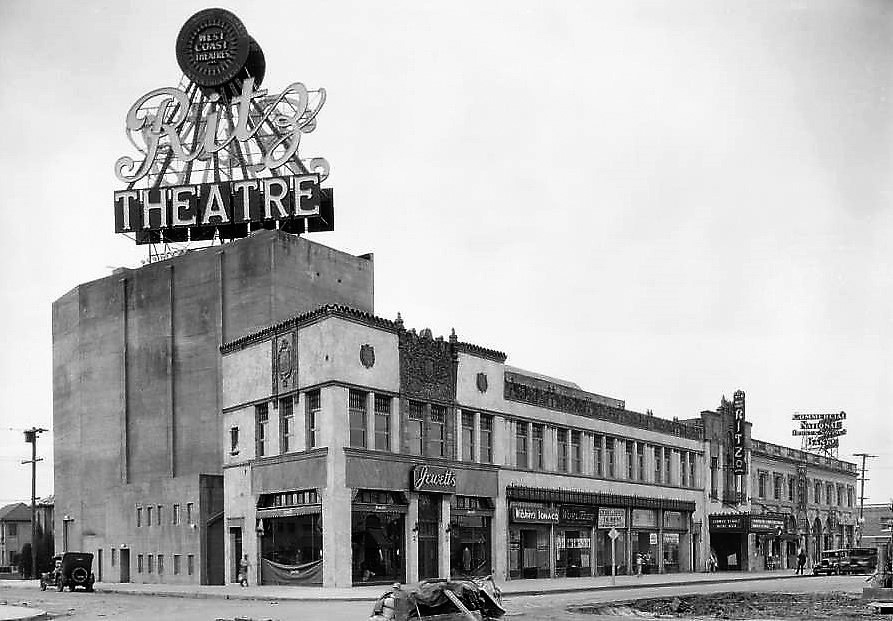 |
|
| (1926)^^ - View looking at the southwest corner of Wilshire and Sycamore showing the Ritz Theatre. Opened in 1926, it joined the Fox theatre chain soon thereafter. The theatre building was on the south side of Wilshire and occupied the block between La Brea and Sycamore. |
Historical Notes In the mid-1920s, anticipating development in what would become the Miracle Mile, West Coast Theatres commissioned architect L. A. Smith to build the Ritz as the 176th theatre in its chain. The building was also part of a block-long commercial development that included offices, stores, and "bachelor" apartments.*^# |
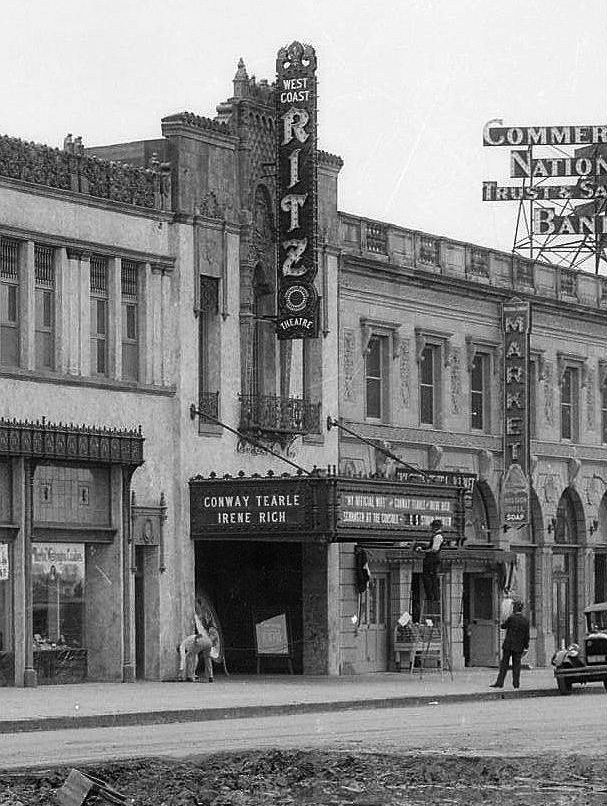 |
|
| (1926)^^ - Close-up detail view showing the entrance to the Fox Ritz. Note the guy up on the ladder putting the milk glass letters on the marquee. "My Official Wife," the theatre's opening attraction, is on the marquee. |
Historical Notes The West Coast Ritz opened October 15, 1926. It became the Fox Ritz when William Fox bought a controlling interest in the circuit in 1929. It was operated for decades by the Fox circuit and its successor companies. The theater was located on the south side of Wilshire with the entrance just east of La Brea. |
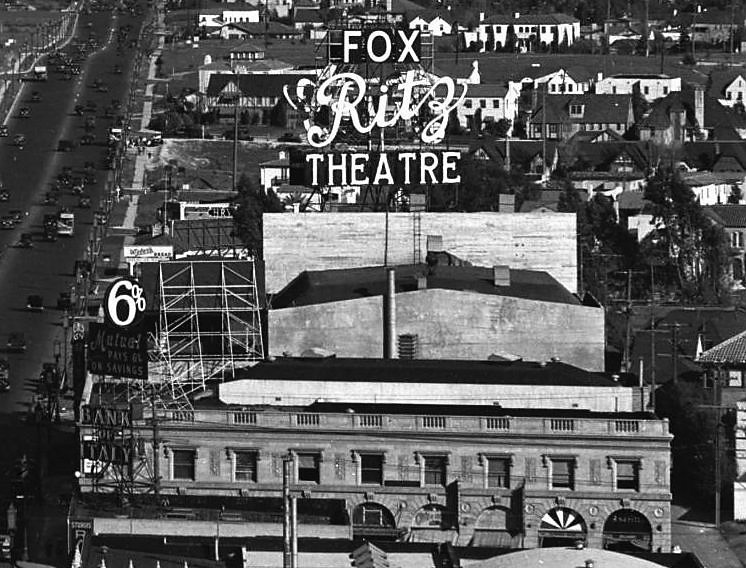 |
|
| (1930)^^ - A roof sign detail of the Fox Ritz Theatre. The sign had been redone in 1929 to get the Fox name up there. |
Historical Notes When United Artists was having a feud with Fox West Coast in the early 30s they built the Four Star Theatre nearby as competition. But when the theatre opened the dispute was settled and Fox ended up running the theatre for them. Also nearby is the El Rey, later it too ended up being run by the Fox circuit. |
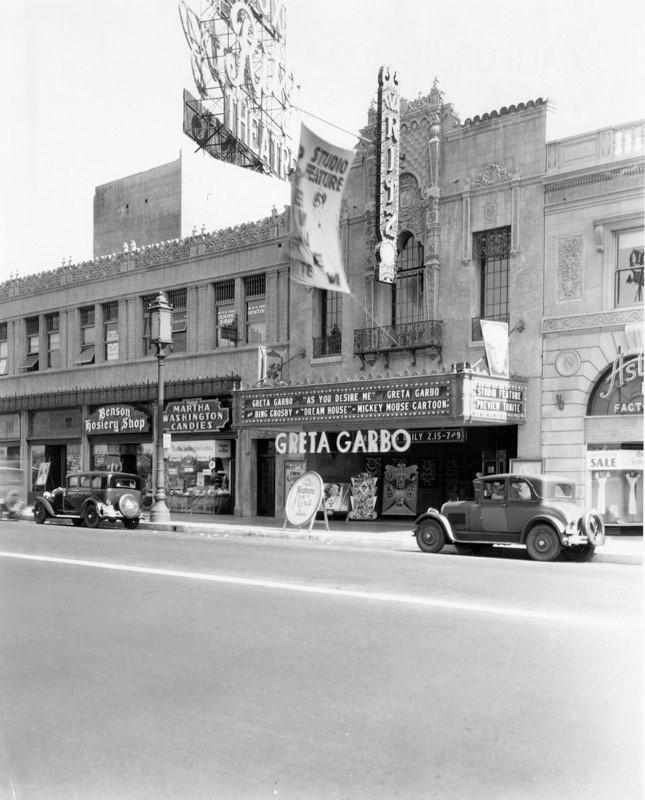 |
|
| (1932)* – View showing the front of the Fox Ritz Theatre as seen from across Wilshire Boulevard. Other businesses to the left of the theater entrance can also be seen including Martha Washington Candies and Benson Hosier Shop. The name GRETA GARBO hangs in large letters from the front of the marquee. Now playing: Greta Garbo’s “As You Desire Me”, supported by a 19-minute Bing Crosby short, “Dream House” and a Mickey Mouse cartoon. |
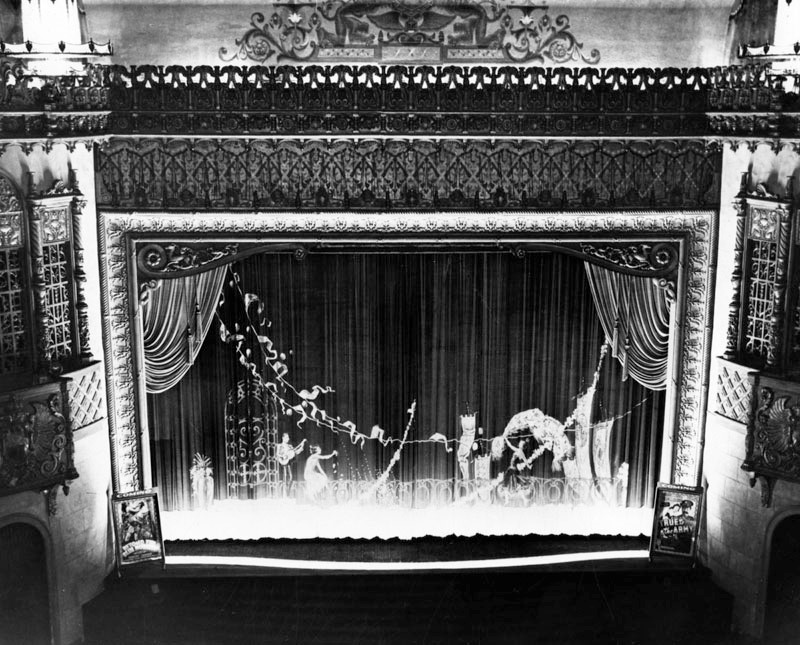 |
|
| (1937)* - View of the Grand Drape of the Ritz Theatre, located at 5214 Wilshire Blvd., and the surrounding proscenium. On each side of the stage are advertising placards: on the left: "Beyond the Blue Horizon" and on the right: "True to the Army". |
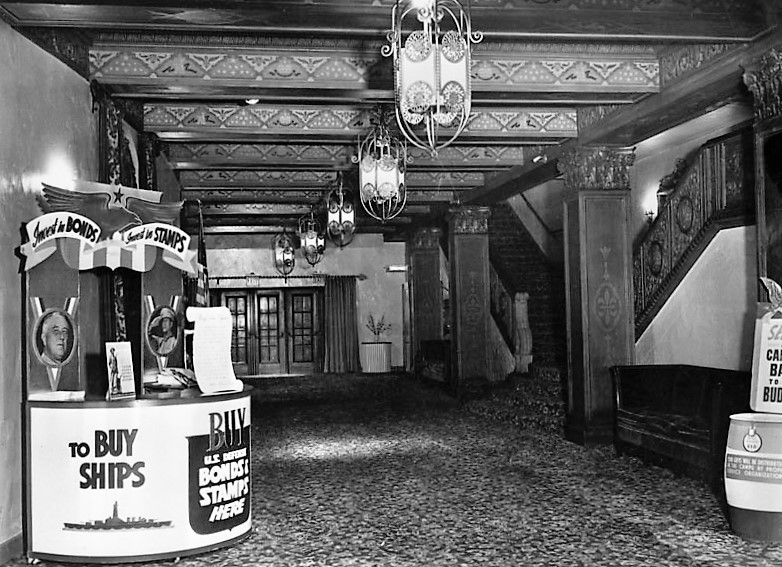 |
|
| (1940s)* – View showing the Fox Ritz Theatre lobby with a booth on the left advertising War Bonds. |
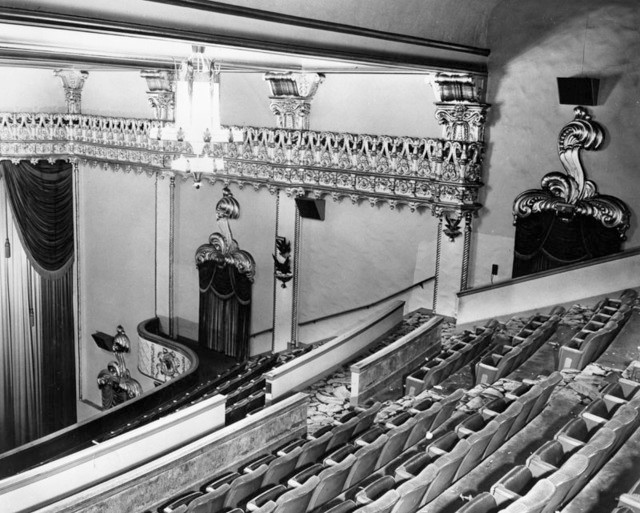 |
|
| (1942)* - Interior side wall of the auditorium, looking across balcony seating from the upper middle of the balcony. |
Historical Notes Architect: Lewis A. Smith. Seating: 1,660 originally, reseated down to 1,402 |
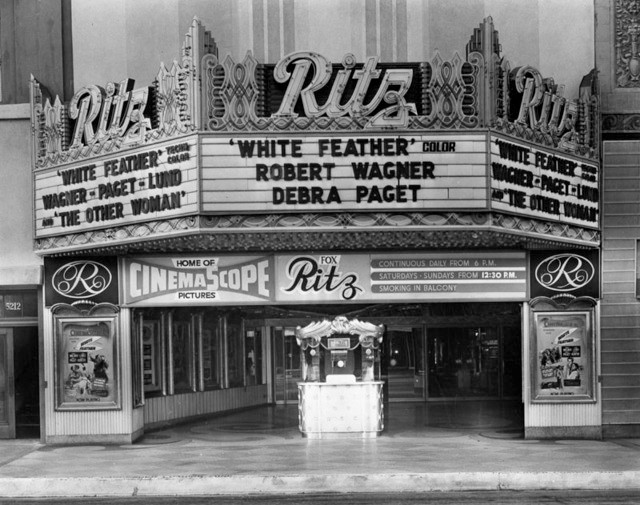 |
|
| (1950)* – Front entrance view of the Fox Ritz Theatre. On the marquee reads, "White Feather, Robert Wagner – Debra Paget - Lund, and The Other Woman." |
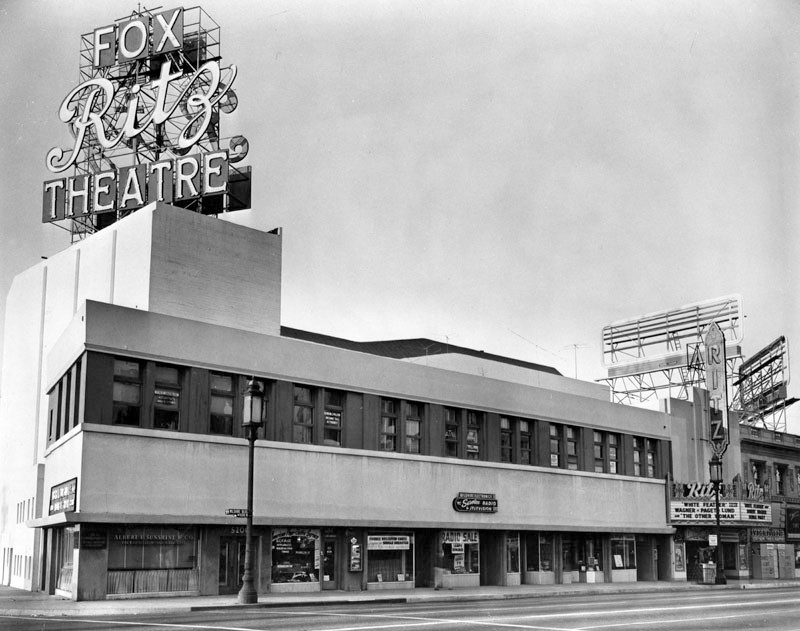 |
|
| (1950)* - The Ritz Theatre, 5214 Wilshire Blvd, can be seen from the corner down half a street to the box office and marquee. A huge sign is on top of the corner with: “Fox Ritz Theatre" |
Historical Notes In its later years, the theater was closed to the public and was used as a reserved film house by Michael Todd. It was also later used as a venue for live theatre and second run films as the Lindy Opera House. A last gasp effort to show vintage films and renamed American Theatre sadly failed and it was closed and converted into a Korean church.^ In 1977 the structure, designed by Lewis A. Smith, was demolished and replaced with a parking lot. |
* * * * * |
Dyas-Carleton Café
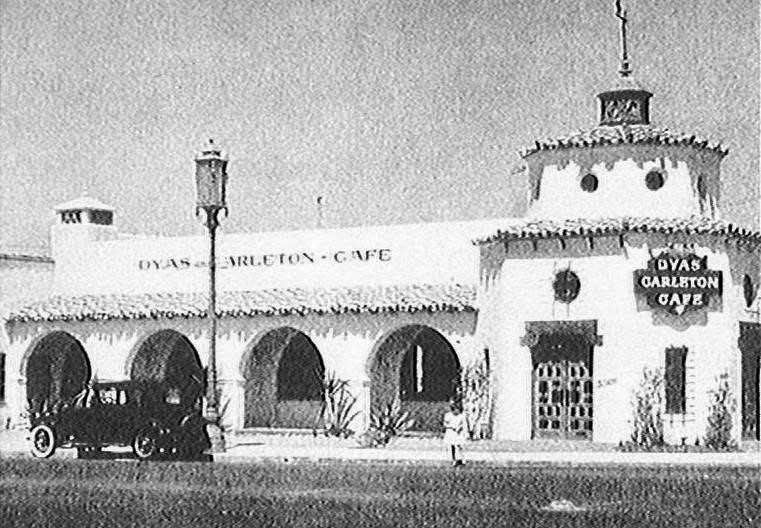 |
|
| (ca. 1928)**#* – View showing the Dyas-Carleton Café located on the northwest corner of Wilshire Boulevard and La Brea Avenue. |
Historical Notes Built in 1928, the restaurant featured a large dining room accommodating 250 patrons and an adjoining coffee shop with booths and a U-shaped counter. It was designed by the architect team of George Elmore Gable and C. Stanley Wyant, who were well known for their work in the Spanish Colonial Revival style. In 1929 they designed Hanger No. 1, the first structure built at Mines Field airport – now known as LAX. **#* By 1949, Dyas-Carleton Cafe would be torn down and replaced by the Welton Becket-designed Tilford's Restaurant and Coffee Shop. |
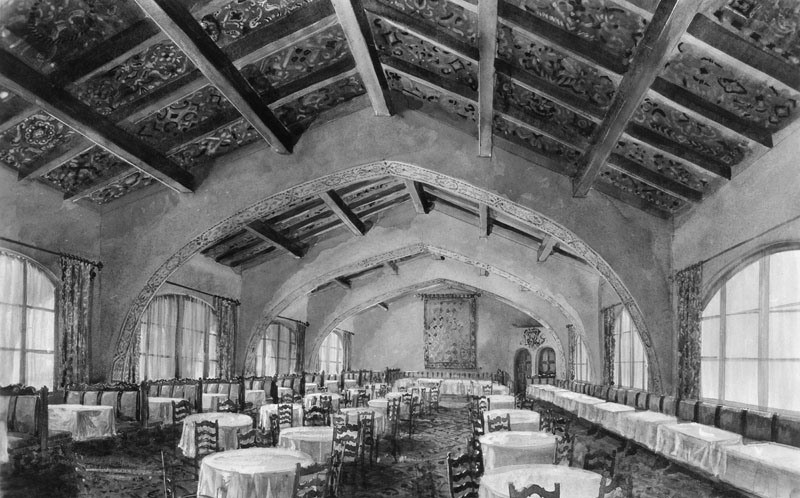 |
|
| (1928)* - Interior view of the Dyas-Carlton Café showing a dining area large enough to accommodate 250 people. Note the Spanish-style architectural design. |
* * * * * |
Fine Arts Building (aka the Signal Oil Building, the Havenstrite Building, and Global Marine House)
.jpg) |
|
| (ca. 1927)* - View looking at the Fine Arts Building located on the NE corner of 7th and Lebanon streets. At lower-right can be seen a Pig N Whistle sign. |
Historical Notes The Fine Arts Building dates back to the construction boom of the 1920's. Built in 1927, the 12-story building was envisioned as a cultural mecca for Los Angeles. The floors above the ornate exhibition hall would be devoted to artist studios and workshops. Here, gifted tenants could create and display their wares in a building which would be, in itself, a work of art. |
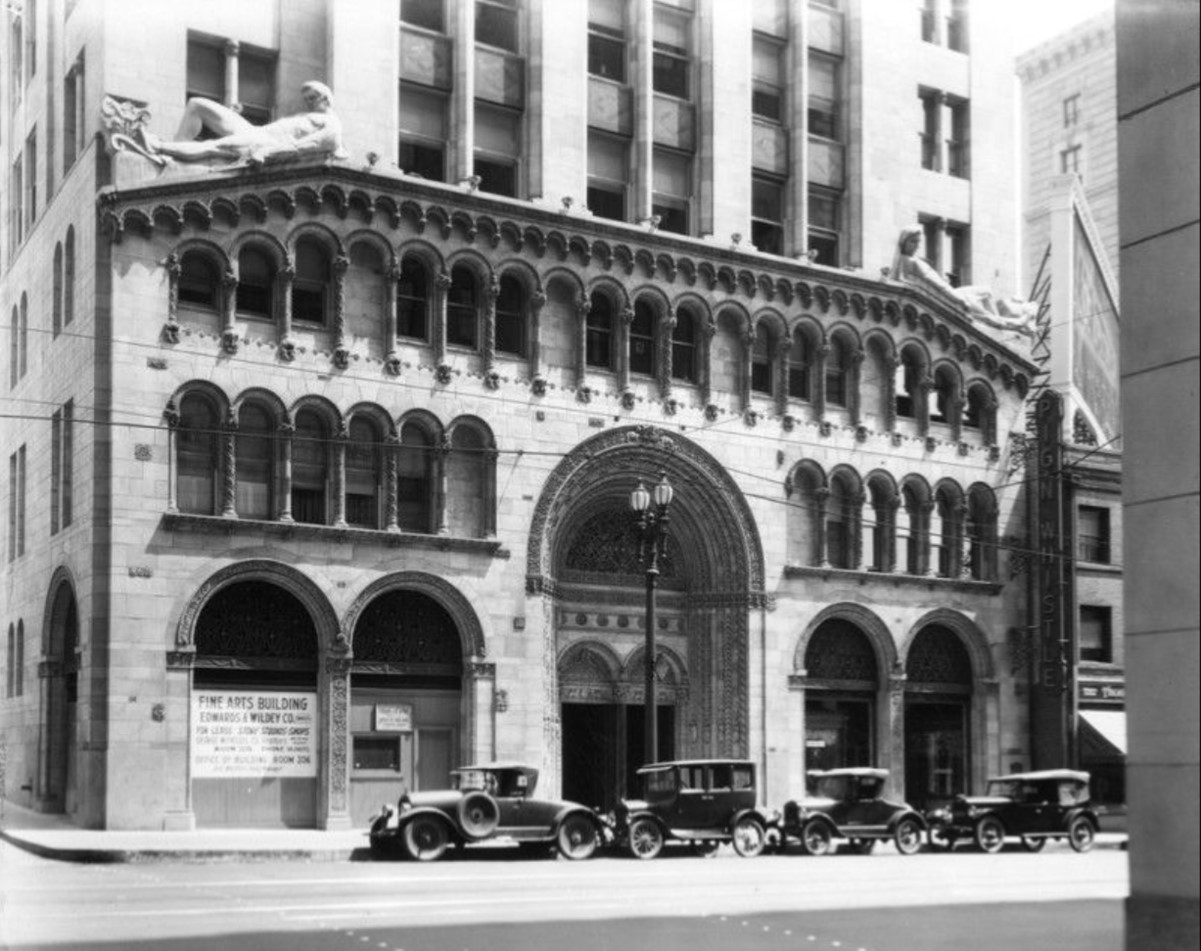 |
|
| (1928)* - Close-up view showing the street facade of the Fine Arts Building, located at 811 W. 7th Street. |
Historical Notes Designed in Romanesque style, the Fine Arts Building has sculptured corbeling, heavy arched windows and elongated windows. The figures of sculpture and architecture recline atop the neo-gothic base, designed by Walker and Eisen. |
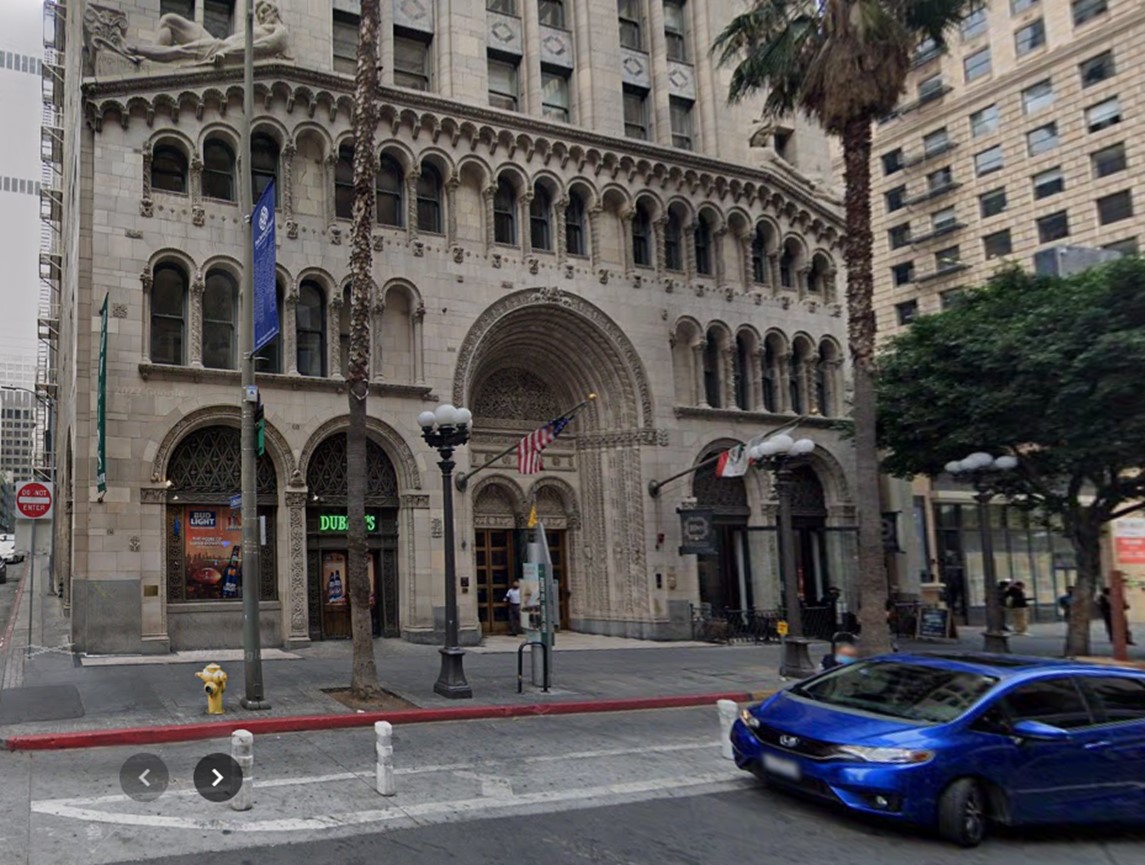 |
|
| (2022)* - Contemporary view of the Fine Arts Building located on the northeast corner of 7th and Lebanon Streets in Downtown Los Angeles. |
Historical Notes Today, the Fine Arts Building is home to coworking spaces, with WeWork and Spaces occupying several floors and offering office solutions for a variety of professionals. Spaces leases the top floors and penthouse, providing workspaces for businesses and individuals. The ground level features restaurants, including 10E and Dublin's Irish Pub. While no longer focused solely on the arts, the building continues to function as a commercial property in downtown Los Angeles, maintaining its architectural significance. |
Then and Now
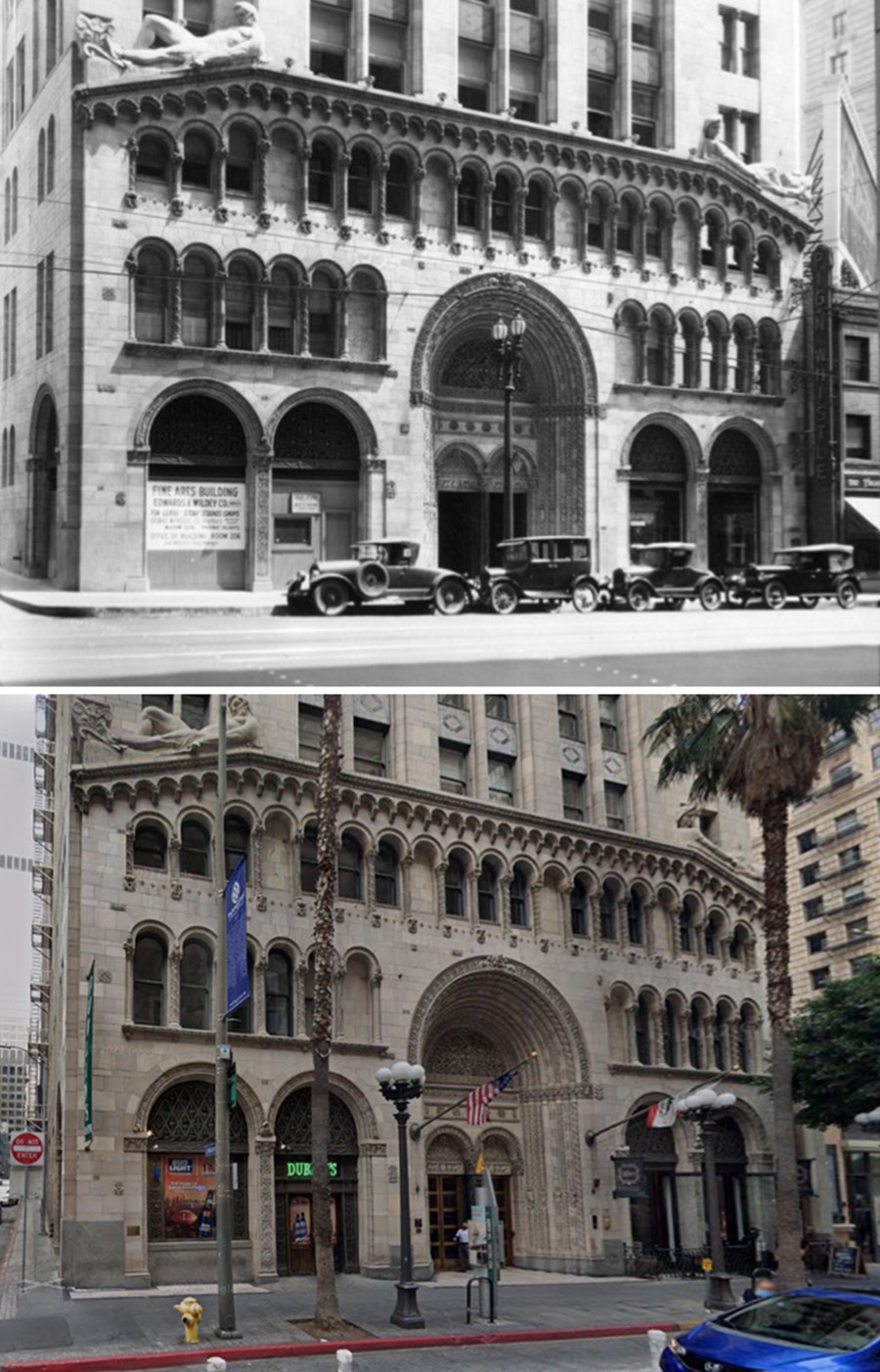 |
|
| (1927 vs. 2022)* – The Fine Arts Building, located at the northeast corner of 7th and Lebanon Streets in Downtown Los Angeles. |
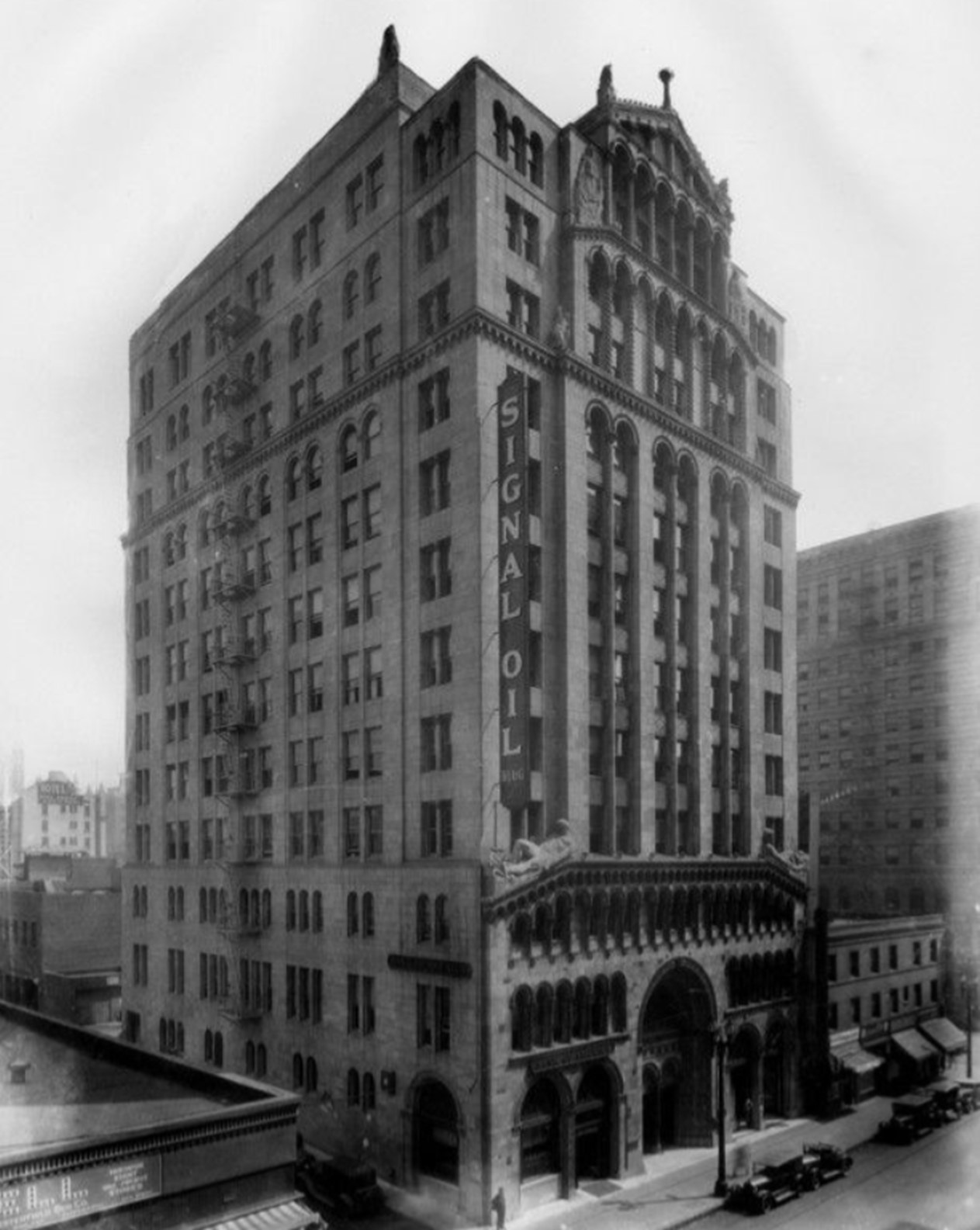 |
|
| (1930s)* - View showing the Signal Oil Building (previously the Fine Arts Building). A large Signal Oil sign extends from the corner edge of the building. Bank of America has a branch office located at the front of the building. |
Historical Notes The Fine Arts Building was completed in 1927. Perhaps due to the Depression, the building was sold four years later. Through the years it has been renamed for its successive owners: The Signal Oil Building, the Havenstrite Building, and Global Marine House. |
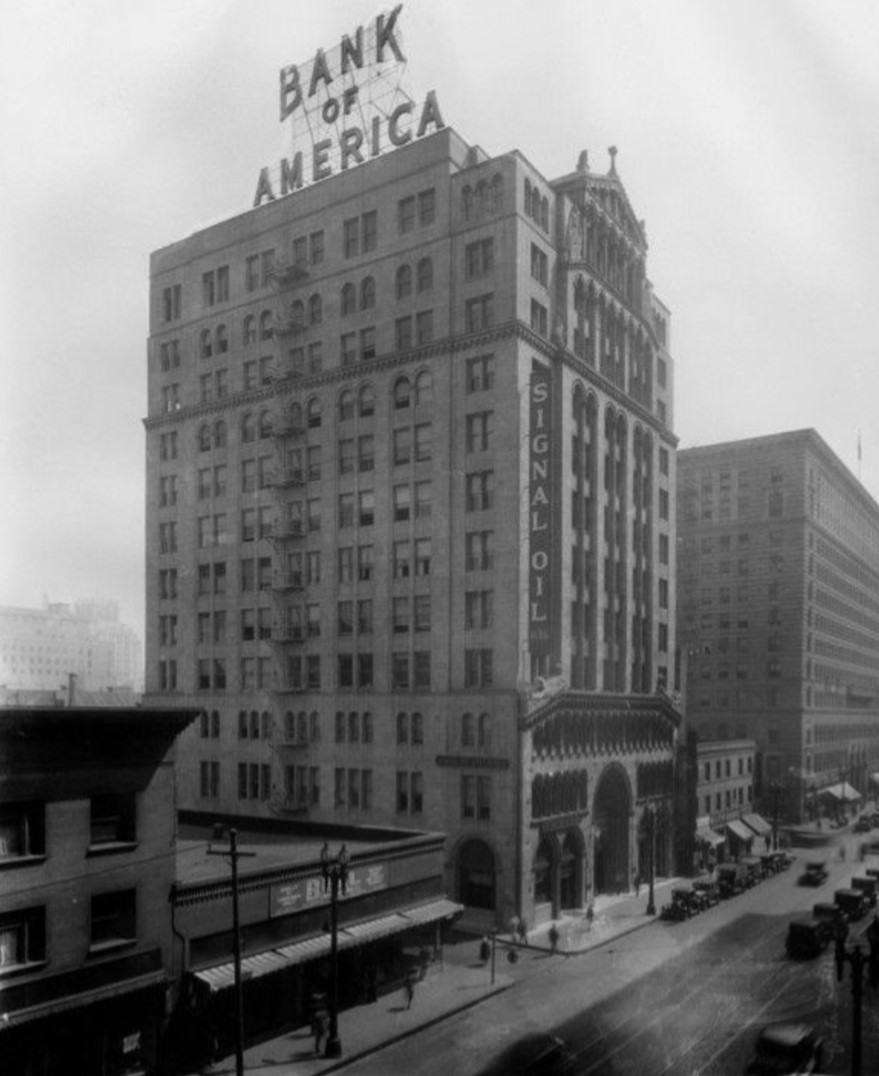 |
|
| (1930s)* - View looking northeast showing the Signal Oil Building (previously Fine Arts Building). Note the architectural designs at the top of the building. A large sign on top the building reads "Bank of America," which is located at the front of the building. |
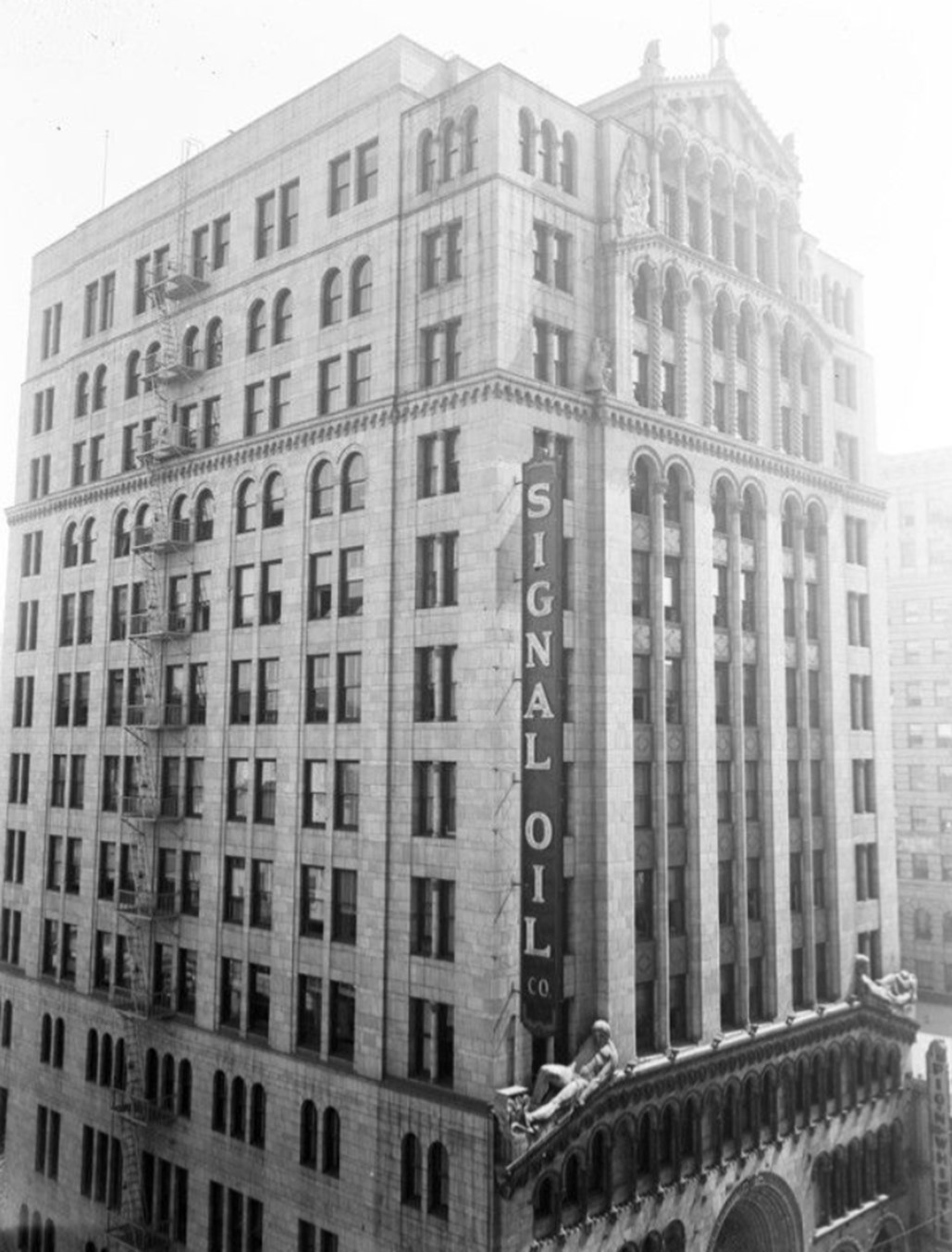 |
|
| (1930s)* - Exterior front view of the lower facade of the Fine Arts Building at 811 W. 7th Street, housing the Signal Oil Company and a Bank of America branch. Note the figure "Sculptures" reclining atop the base. |
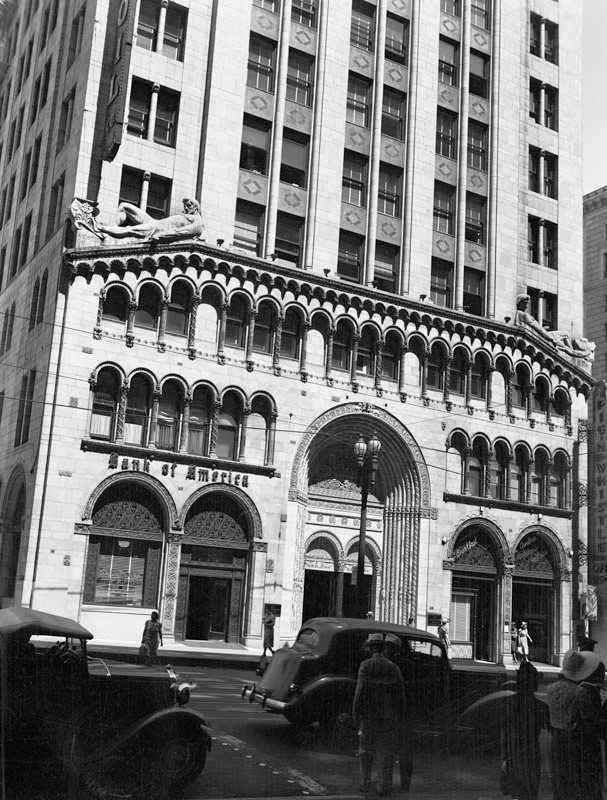 |
|
| (1939)* - Street view showing the lower facade of the Fine Arts Building at 811 W. 7th Street, housing the Signal Oil Company and a Bank of America branch. |
Historical Notes The Fine Arts Building is famous for its detailed sculptures, which add beauty to both the outside and inside. On the outside, there are nude statues created by Burt Johnson. The façade also includes decorative features like animal heads carved into keystones and detailed plant designs on the capitals, all in the Romanesque Revival architectural style. Inside, the lobby has a shallow pool with bronze sculptures made by Johnson. There are also seventeen glass and bronze showcases that display the work of the building's tenants. These artistic details show the building’s original purpose as a place for artists and craftsmen to celebrate creativity and skill in a beautifully designed space. |
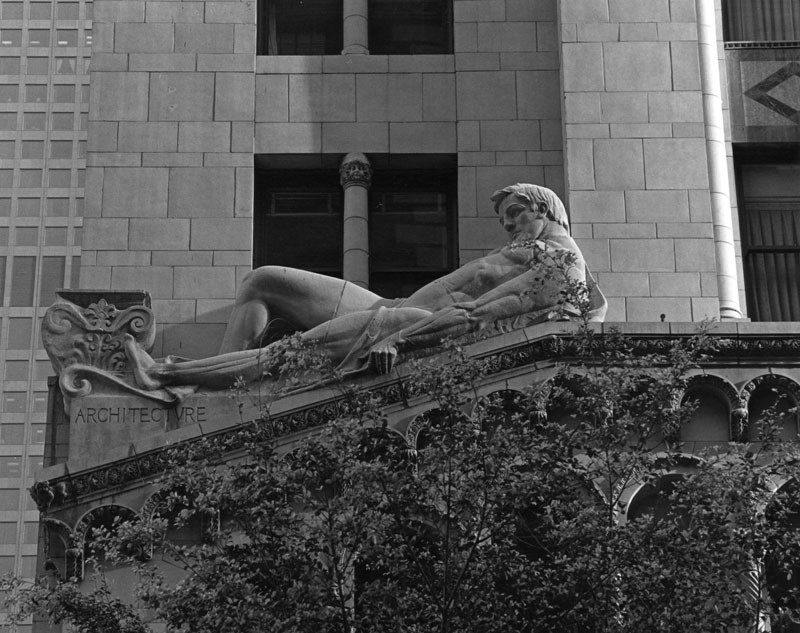 |
|
| (1979)* - Close-up view of the figure "Architecture" reclining atop the base. Photo by William Reagh. |
Historical Notes The sculptures on the outside of the Fine Arts Building were designed by Burt William Johnson. Johnson, a well-known Southern California sculptor, created two large statues called "Architectvre" and "Scvlptvre" that can be seen lounging outside the fourth floor of the building. He also crafted other decorative elements for the building's exterior, including two large outdoor panels and several smaller pieces. Tragically, Johnson died of a heart attack while working on one of the Hermae statues for the Fine Arts Building, using his daughter Cynthia Mae as a model. |
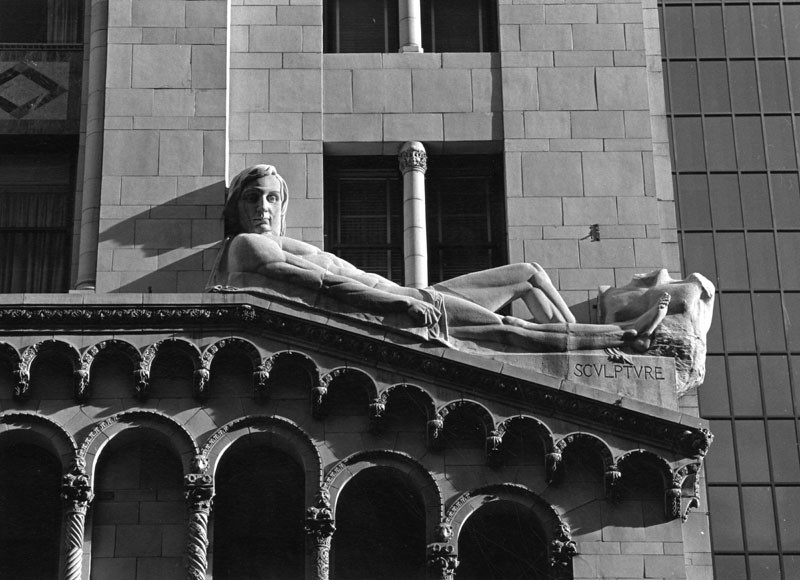 |
|
| (1979)* - Close-up view of the figure "Sculpture" reclining atop the base. Photo by William Reagh. |
Historical Notes Created by sculptor Burt Johnson, the sculptures are part of the building's original artistic vision, reflecting the cultural aesthetic of Los Angeles when the structure was constructed. |
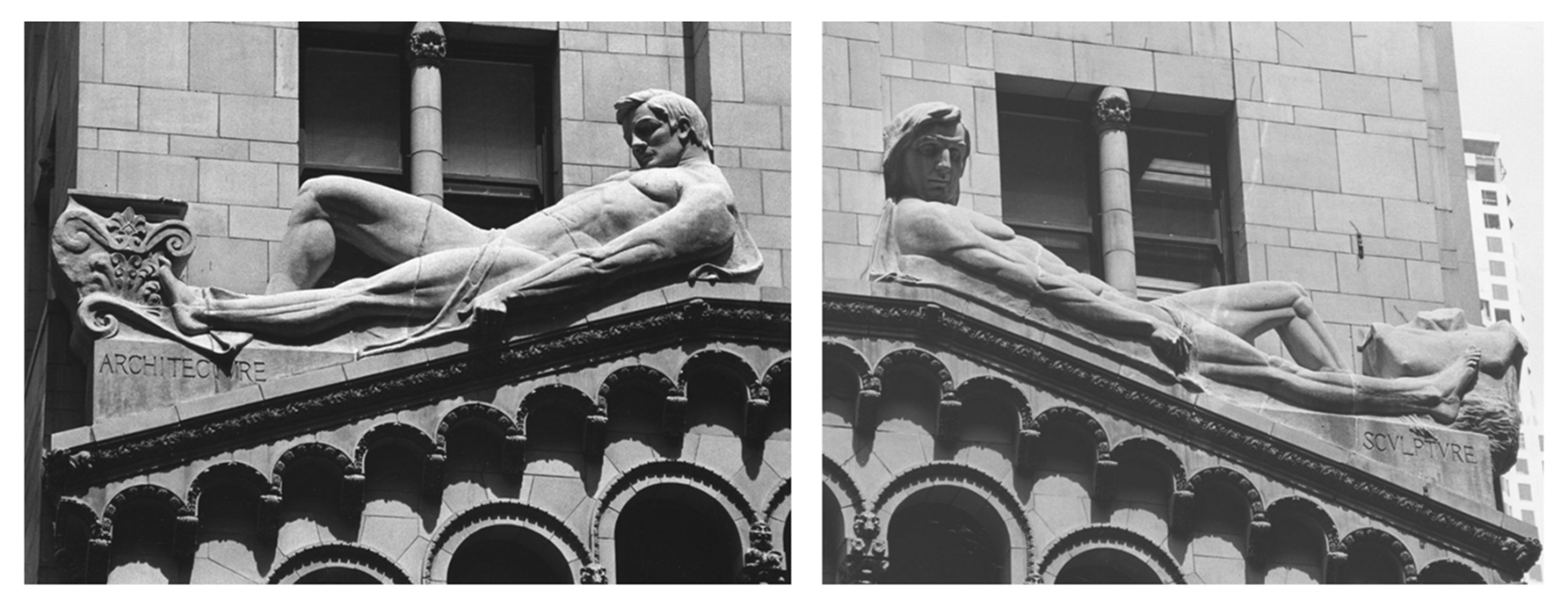 |
|
| (1989)* - The Fine Arts Building features two notable nude sculptures designed by Burt Johnson located between the 3rd and 4th floors of its facade. These male figures are positioned on an architectural extension at the third story level, creating a distinctive artistic element of the building's design. Photos by William Reagh. |
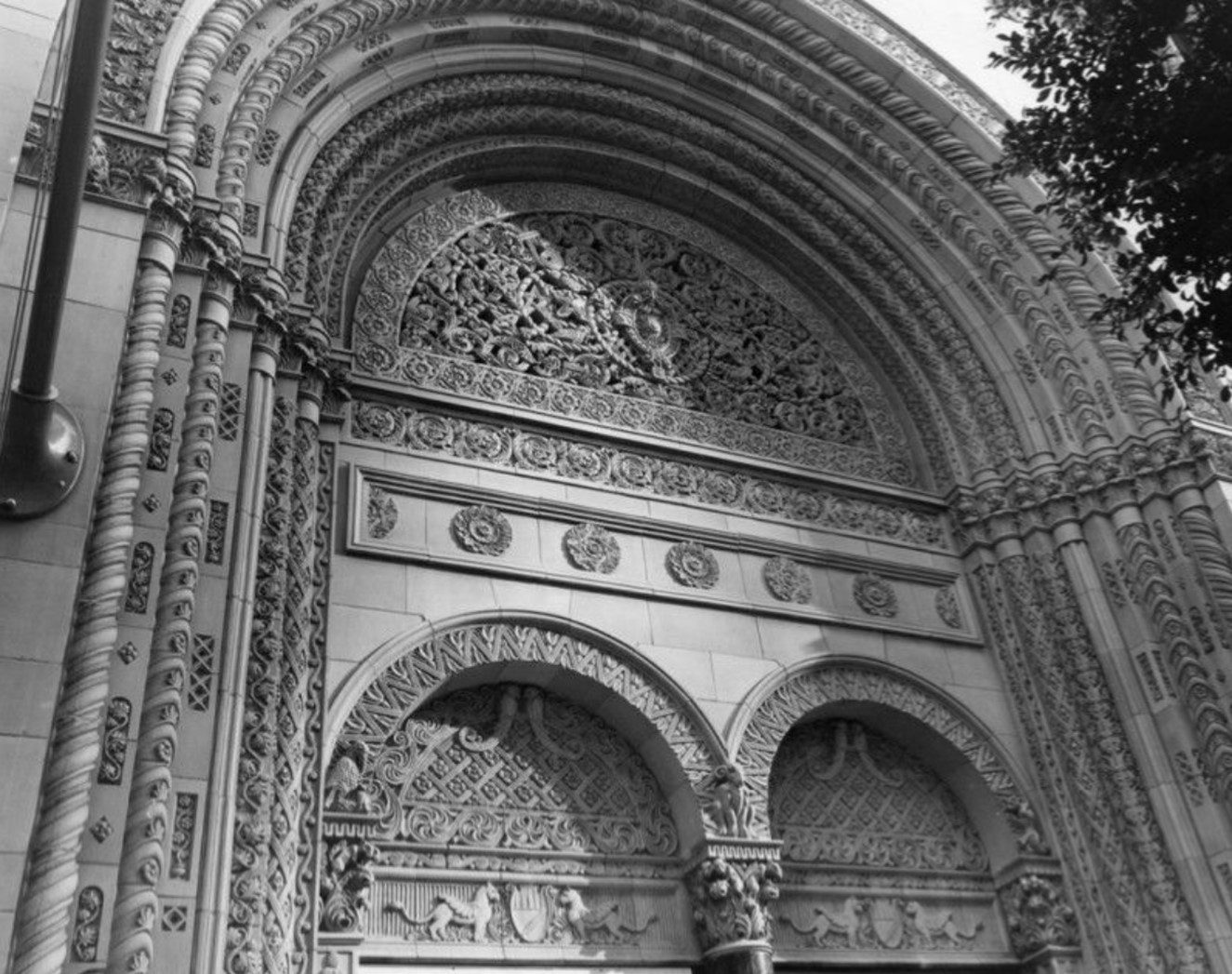 |
|
| (1983)* - Detail of terra cotta Romanesque Revival style arch above entrance doors of the Fine Arts Building. The building's exterior was patterned after early Christian churches. Photo by William Reagh. |
Historical Notes The building was completed in 1927 by Walker and Eisen, architects; renovated by Ratkovich and Bowers, and architect Brenda Levin, and rededicated in 1983. Acquired in 1983 by Ratkovich Bowers and Perez, the building underwent a complete renovation, restoring the Fine Arts Building to its original beauty, while bringing the structure to modern office standards. The lobby area was refurbished under the caring eye of Tony Heinsbergen, son of the original artist, whose firm continues to specialize in the decoration and restoration of quality buildings. Brenda Levin Associates, officed in the Fine Arts Building, was design consultant for all the common areas of the building. |
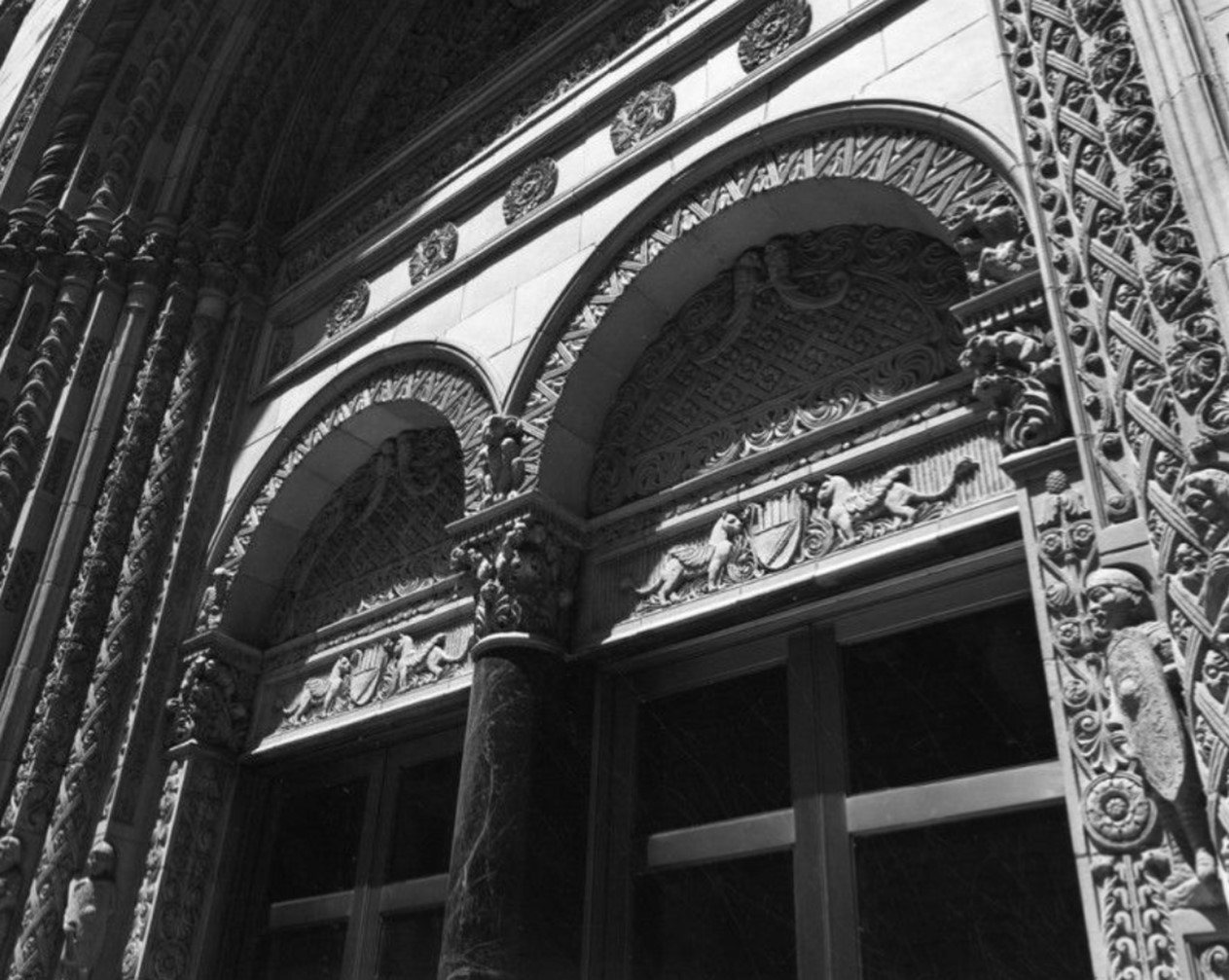 |
|
| (1989)* - Fine Arts Building entry showing sculpture in a closeup view. Photo by William Reagh. |
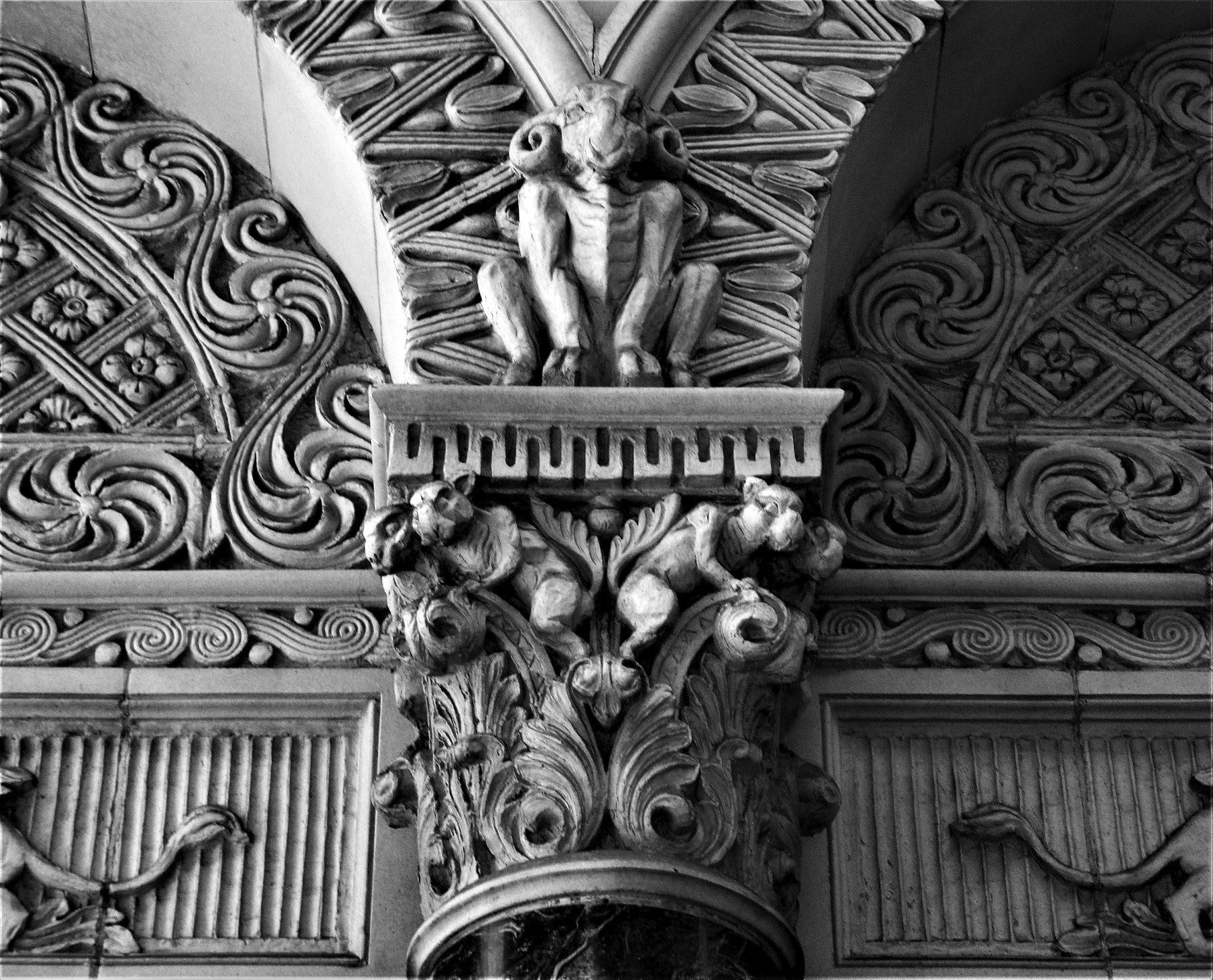 |
|
| (2019)* - Closer detail view of entrance to the Fine Arts Building. Photo by Howard Gray |
Historical Notes Original plans called for the building face to be constructed in stone, but terra-cotta was ultimately chosen as it would allow for more intricate ornamentation. |
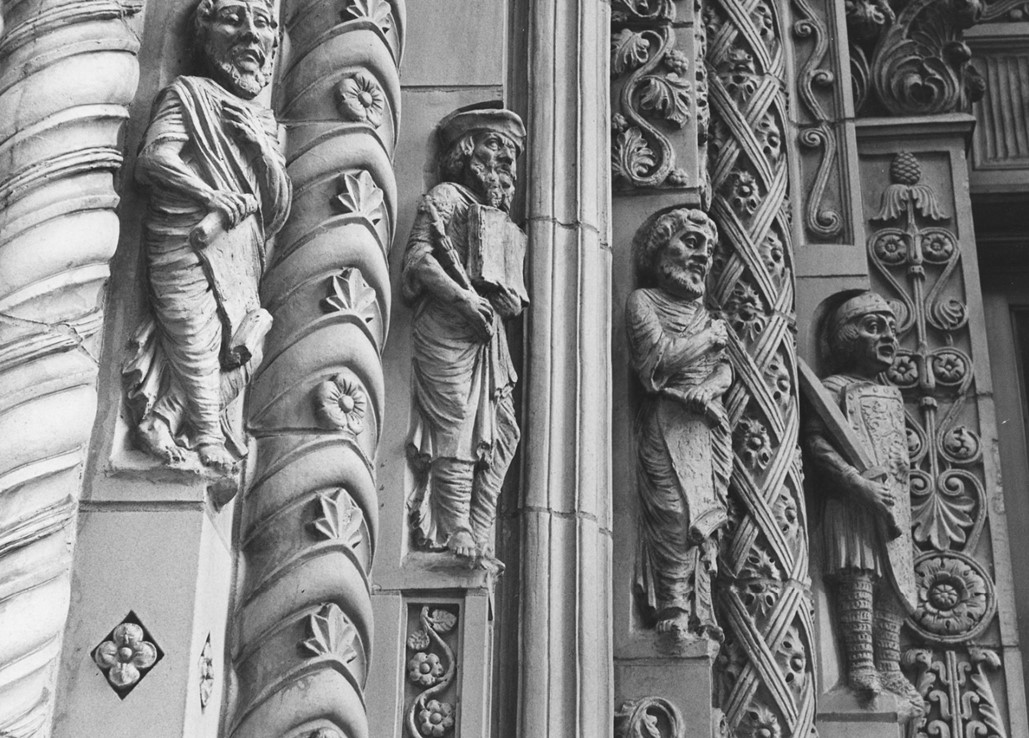 |
|
| (1976)* - Detail of entrance to Fine Arts Building showing decorative sculptures. Photo by William Reagh. |
Historical Notes In 1974, the Fine Arts Building (also known as Global Marine House) was designated Historic Cultural Monument No. 125 (Click HERE to see complete listing). |
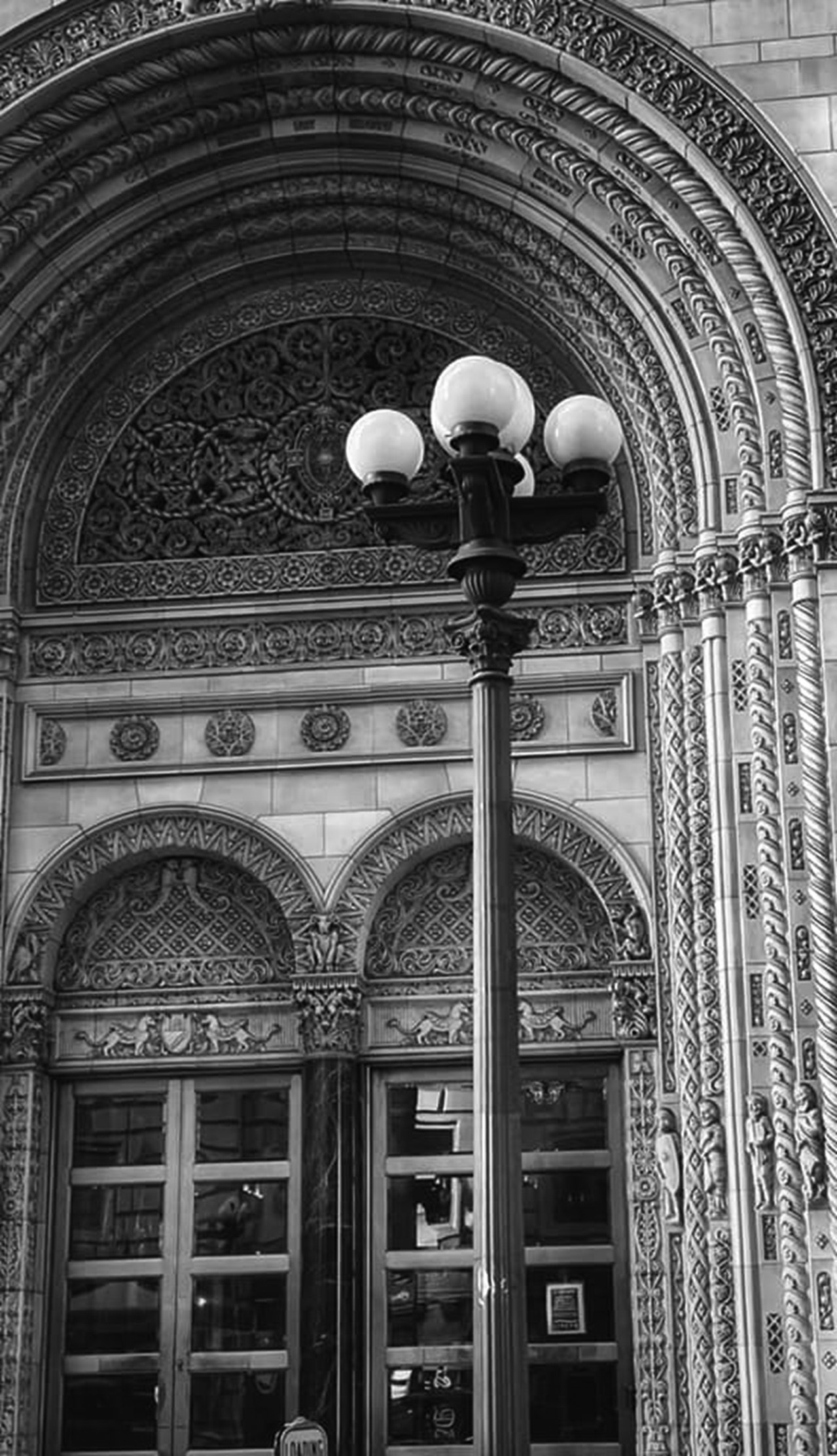 |
|
| (2021)* - Close-up contemporary view showing an ornate streetlight (5-Globe Llewellyn) standing in front of an even more ornate Fine Arts Building, 811 W. 7th Street. Photo by Carlos G. Lucero |
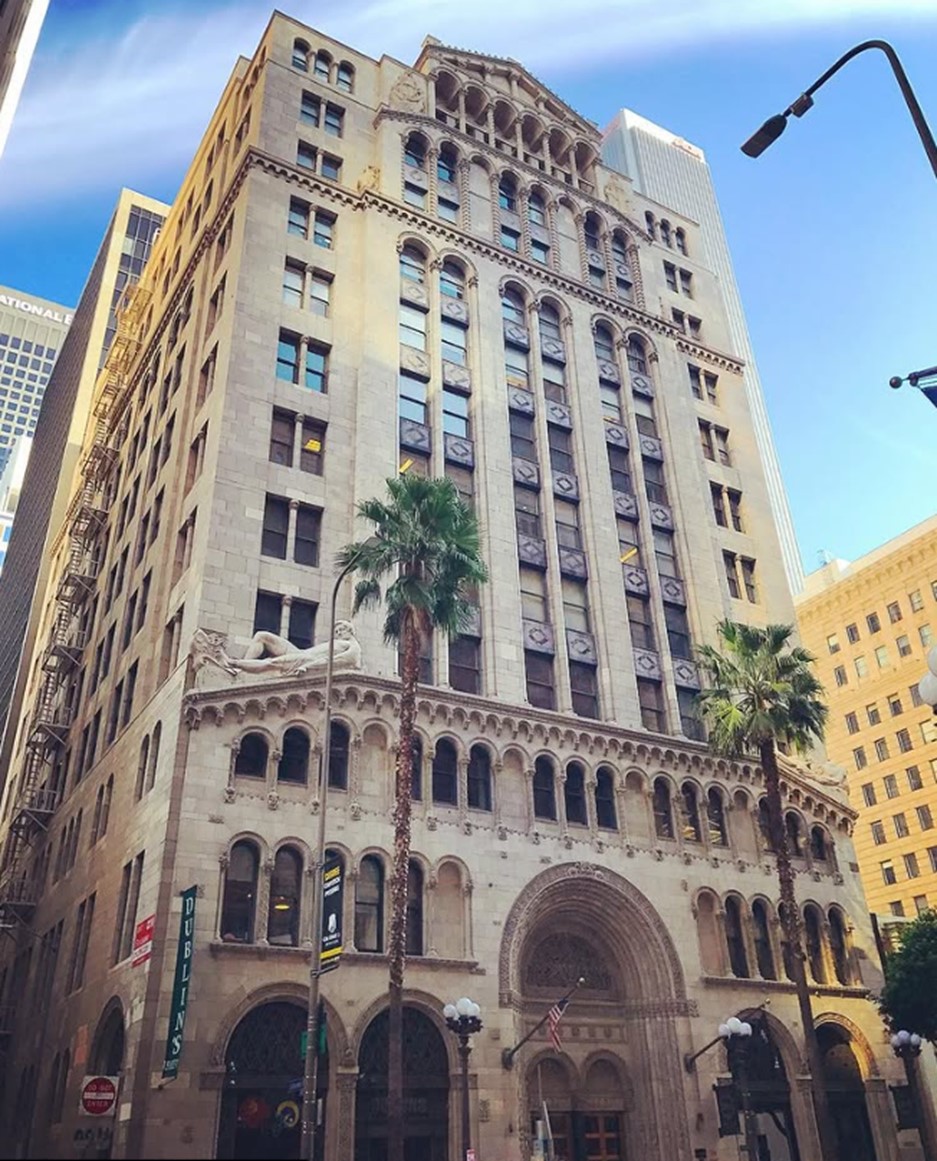 |
|
| (2017)* - Contemporary view of the front of the Fine Arts Building. Photo Courtesy of Curbed L.A. |
Historical Notes The Fine Arts Bulding experienced several name changes under different ownership, but was finally renamed the Fine Arts Building in 1982 by Wayne Ratkovich and Don E. Bowers. In 2017, the elaborately decorated Fine Arts Building in Downtown’s Financial District was sold for the “premium price” of $43 million. The buyer was a Santa Barbara investment firm that purchased the structure “on behalf of a wealthy family,” says the LA Times. Today, the Fine Arts Building is home to coworking spaces, with WeWork and Spaces occupying several floors and offering office solutions for a variety of professionals. Spaces leases the top floors and penthouse, providing workspaces for businesses and individuals. The ground level features restaurants, including 10E and Dublin's Irish Pub. While no longer focused solely on the arts, the building continues to function as a commercial property in downtown Los Angeles, maintaining its architectural significance. |
* * * * * |
Central Library
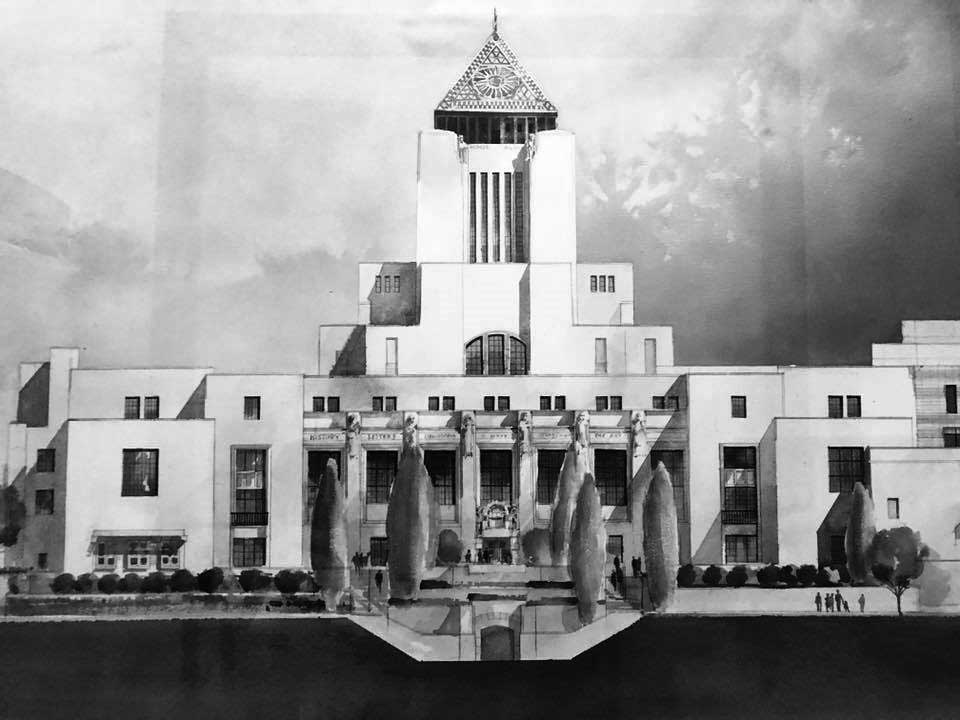 |
|
| (n.d.)^ - Central Library rendering looking North from Hope Street. |
Historical Notes Architect Bertram Grosvenor Goodhue designed the original Los Angeles Central Library with influences of ancient Egyptian and Mediterranean Revival architecture. The central tower is topped with a tiled mosaic pyramid with suns on the sides with a hand holding a torch representing the "Light of Learning" at the apex. Other elements include sphinxes, snakes, and celestial mosaics. It has sculptural elements by the preeminent American architectural sculptor Lee Lawrie, similar to the Nebraska State Capitol in Lincoln, Nebraska, also designed by Goodhue.*^ |
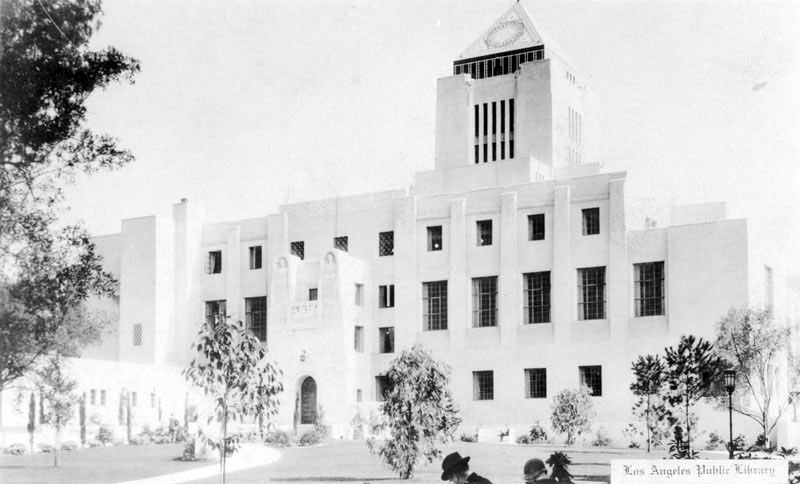 |
|
| (1929)* - Postcard view of the exterior of Central Library, 630 West Fifth Street. This entrance to the library is facing Flower Street. |
Historical Notes The Central Library Goodhue building was constructed between 1922 and 1926 on the site once occupied by the State Normal School (later to evolve into UCLA). |
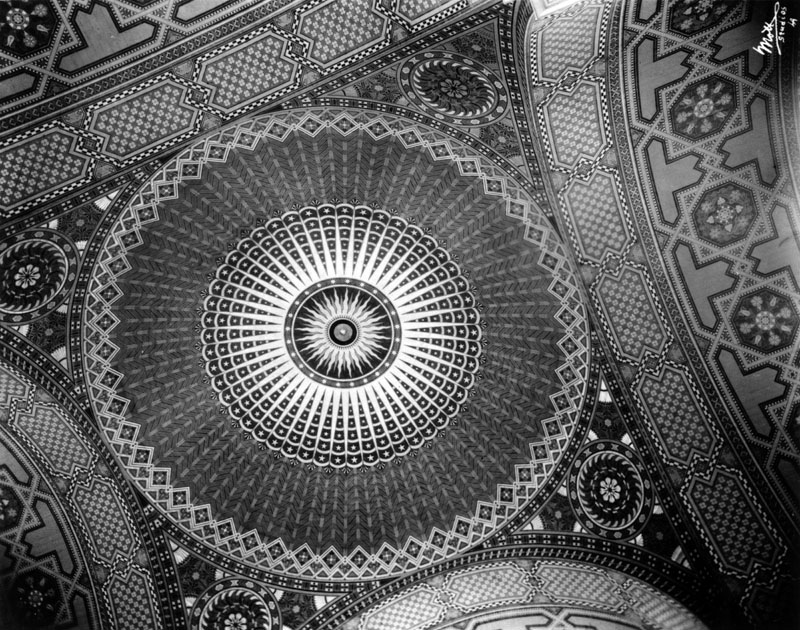 |
|
| (ca. 1929)* - The ornate mosaic-like dome of the Central Library's rotunda was designed by Julian C. Garnsey. |
Historical Notes The sunburst image located directly above the globe chandelier mirrors the sunburst design of the pyramid on top of the building, a further illustration of the building's theme: "the light of learning".* |
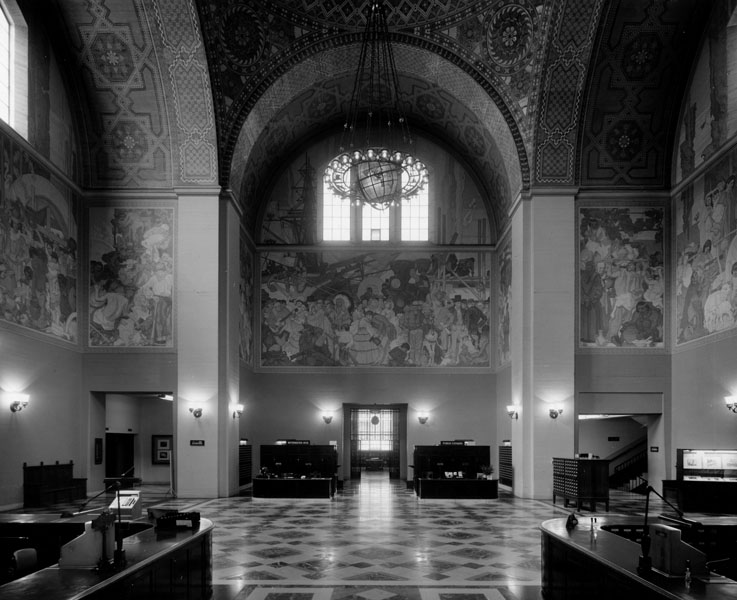 |
|
| (ca. 1929)* - A view of the rotunda of Central Library, showing the check-out desks, reference desks, card catalog files, and murals on all the upper walls and ceiling. |
Historical Notes The Central Library's murals were painted by Dean Cornwell, and the mosaic-like painted dome was done by Julian C. Garnsey. This entire area sustained some smoke damage during the fire that ravaged the upper levels of Central Library, April 29, 1986.* |
 |
|
| (ca. 1929)* - A unique look at the Los Angeles Public Library Rotunda, as seen through the photographer's special effects lens. |
Historical Notes The murals on the rotunda walls depict four great eras of California history. These are: "Discovery" (north wall); "Mission building" (east wall); "Americanization" (south wall), and "The Founding of Los Angeles" (west wall). Distinguished muralist and illustrator, Dean Cornwell was awarded the contract for the Los Angeles Public Library murals in 1927, and spent the next five years researching and painting the final canvases, which he completed in 1932. Julian C. Garnsey designed the ornate mosaic-like dome of the Library's rotunda.* |
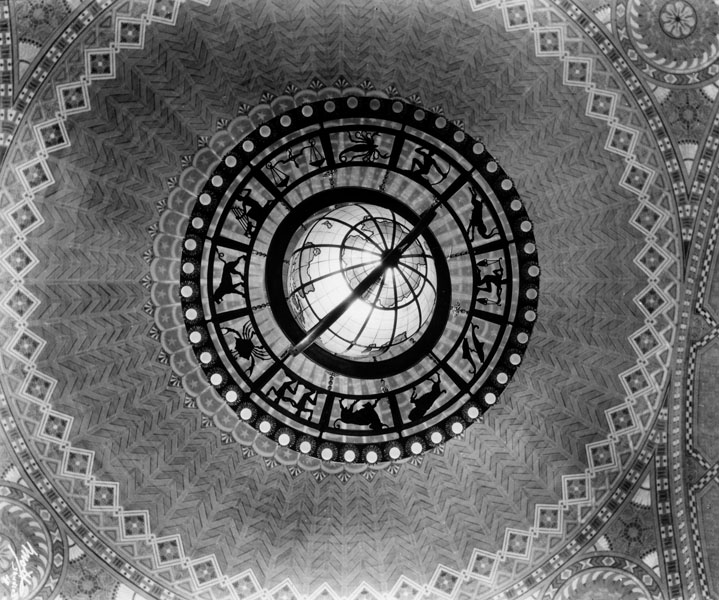 |
|
| (ca. 1929)* - View of the chandelier that hangs from the Central Library's rotunda ceiling. |
Historical Notes Designed by Goodhue Associates, the chandelier measures 9 feet in diameter, is composed of cast bronze, weighs one ton, and is part of a model of the solar system.* |
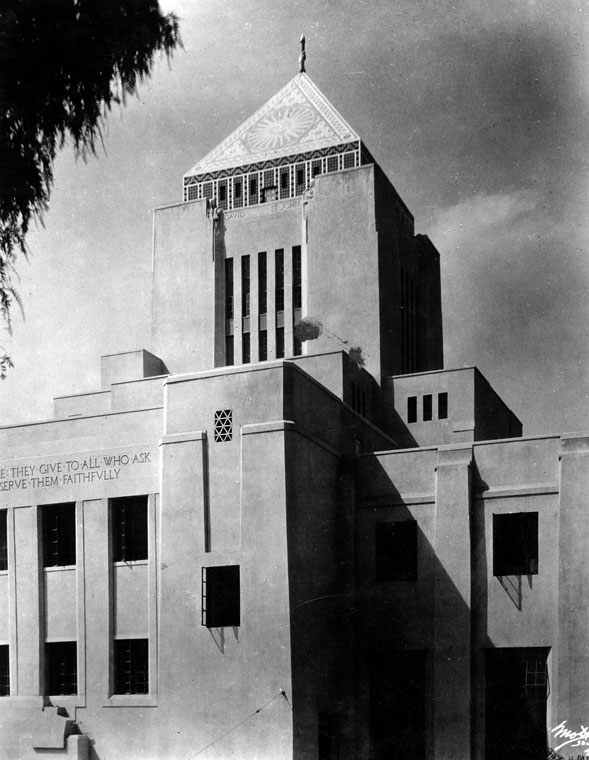 |
|
| (ca. 1930)* - A photo of the exterior of the L.A. Central Library showing a portion of the building and the tower as seen from 5th Street. |
Historical Notes On the wall under the tower are the words "David .. St. John". Part of the printing lower on the building reads: "They Give To All Who Ask ... Serve Them Faithfully." * |
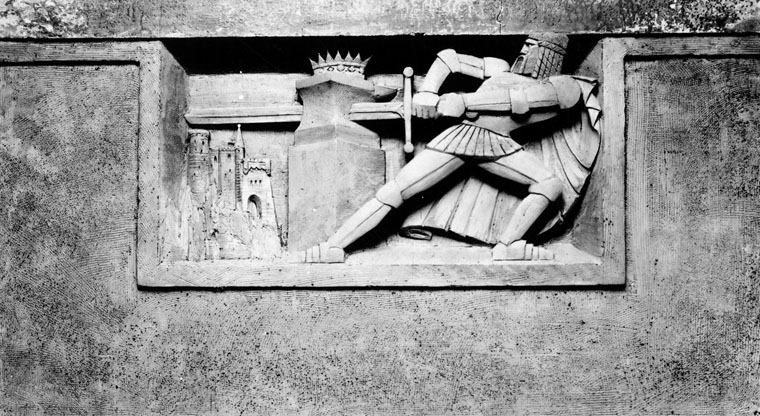 |
|
| (ca. 1930s)* - View of a swordsman pulling his sword from a stone on the exterior wall in the original Children's Court of the library. |
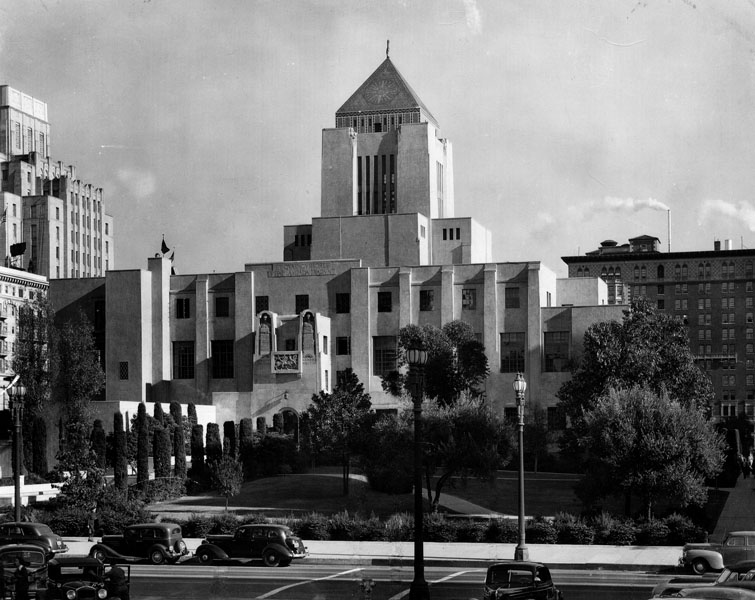 |
|
| (ca. 1935)* - An exterior view of the west side of Central Library, with lawn and sidewalks extending in several directions across the lawn. Cars of 1930's vintage are parked on the street |
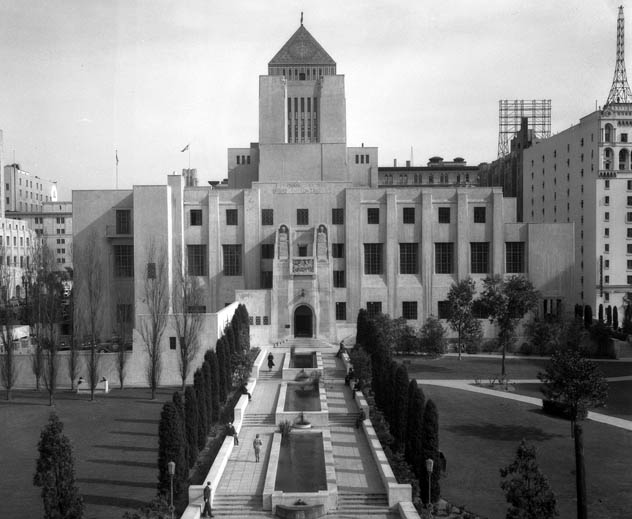 |
|
| (ca. 1935)* - Walkway and front facade of Los Angeles Public Library's Central Library, located at 630 W. 5th Street. |
Historical Notes Originally named the Central Library, the building was first renamed in honor of the longtime president of the Board of Library Commissioners and President of the University of Southern California, Rufus B. von KleinSmid. The new wing of Central Library, completed in 1993, was named in honor of former mayor Tom Bradley. The complex (i.e., the original Goodhue building and the Bradley wing) was subsequently renamed in 2001 for former Los Angeles Mayor Richard Riordan, as the Richard Riordan Central Library.*^ |
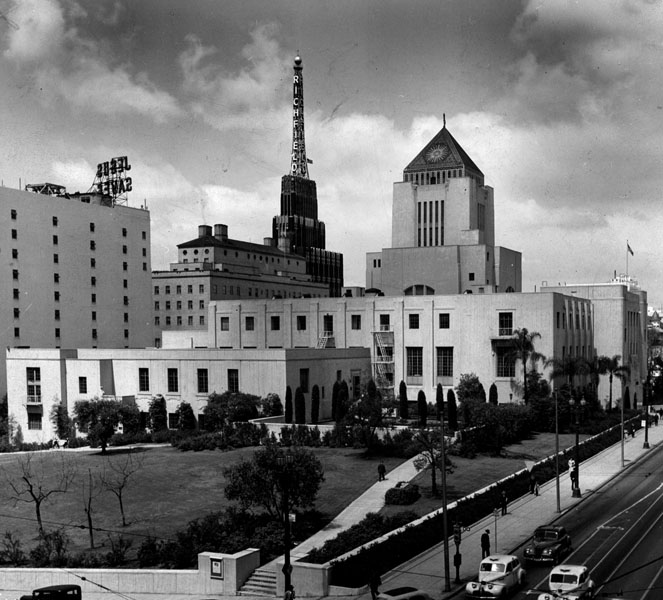 |
|
| (1949)* - View looking southwest showing the Central Library as seen from the corner of 5th and Grand streets. Behind the library stands a tall tower with the name Richfield on it and to the left another sign which reads "Jesus Saves." The California Club can also be seen on the left. |
Historical Notes On March 1, 1967 the Central Library Building was designated Los Angeles Historic-Cultural Monument No. 46 (Click HERE to see listing). It is also listed on the National Register of Historic Places.*^ |
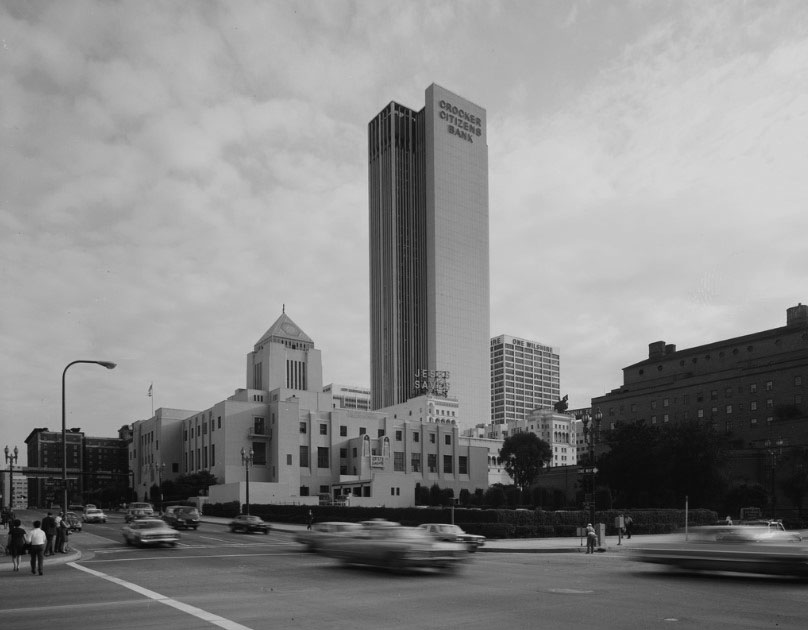 |
|
| (1971)* – View looking southeast at the intersection of Flower and 5th streets showing the Central Library with the high-rise Crocker-Citizens Bank building in the background and the California Club to the right. Photo: Library of Congress |
Then and Now
.jpg) |
|
| (1971 vs 2022)* – Looking toward Central Library on the southeast corner of Flower and 5th streets in downtown Los Angeles. |
 |
|
| (1971)* – Close-up view showing the west elevation of the Los Angeles Central Library. To the left can be seen the Edison Building. Photo: Library of Congress |
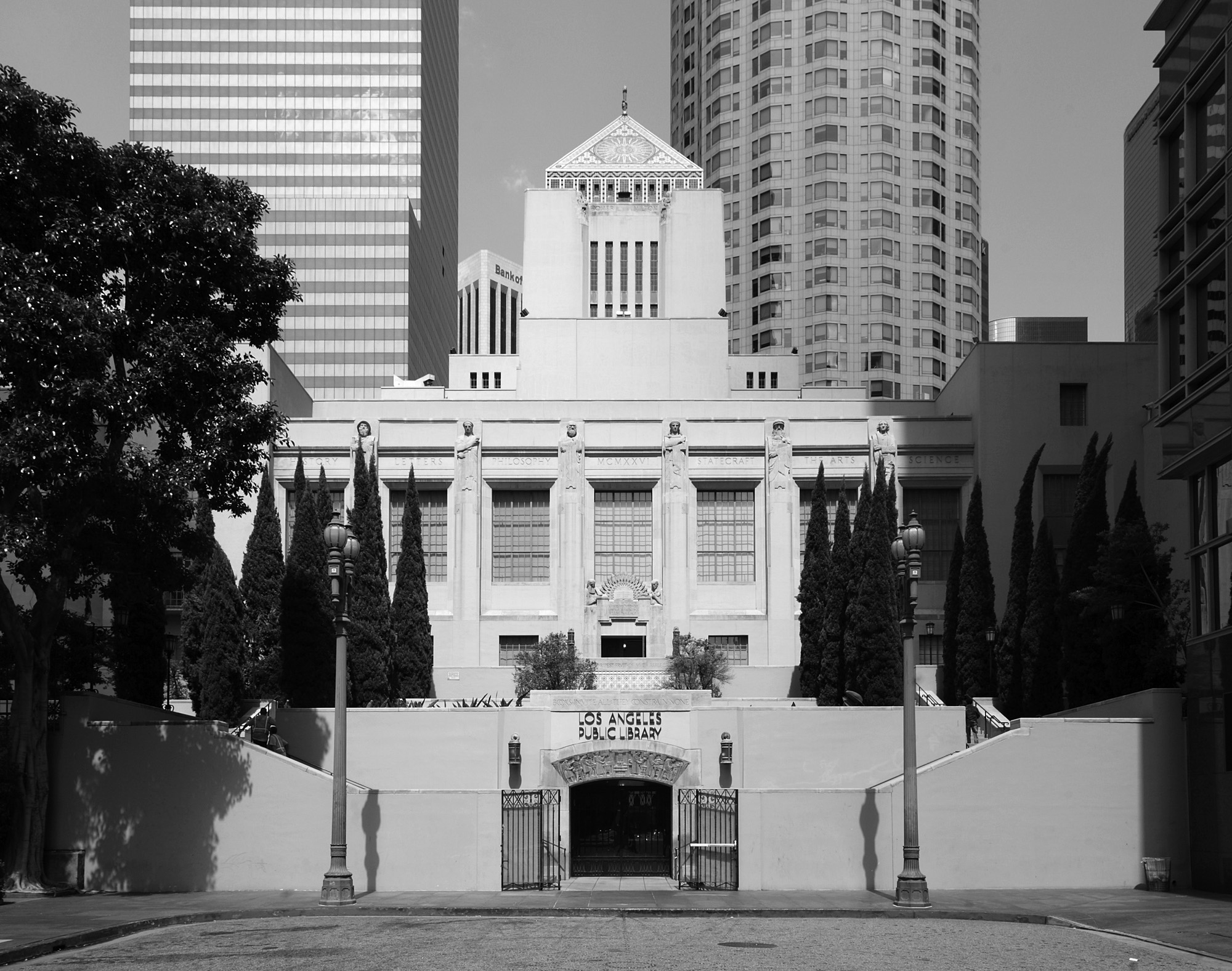 |
|
| (2009)* – View showing the South Hope Street entrance of the Los Angeles Central Library. Photo by Matthew Field via Wikipedia |
Historical Notes The proposed demolition of the Central Library in the 1970s led to the formation of the Los Angeles Conservancy in 1978. It was the first victory of the Conservancy. |
.jpg) |
|
| (2013)* – Close-up view showing the Los Angeles Central Library tower. Photo by Carol Highsmith, Library of Congress |
Historical Notes It's hard to imagine downtown Los Angeles without the Central Library. It remains a prime example of how vulnerable our treasured landmarks can become, and why their preservation is worth the effort.^ Atop the pyramid a hand holding a torch functions as a beacon; at its base is incised the ancient Greek for “lamp” surmounting a coiled snake that represents wisdom. (This ceramic finial is a replica. The original is now displayed on the library’s main floor). Surrounding the tower, Alexander used allegorical representations of eight great thinkers and writers to expand and particularize his Light of Learning theme. Each holding an attribute and presented in pairs, he called these men the Seers of Light: David the Psalmist and Saint John of the Apocalyptic Vision; Homer and Milton; Shakespeare and Goethe; and Plato and Dante.^ |
* * * * * |
California Club (2nd Building)
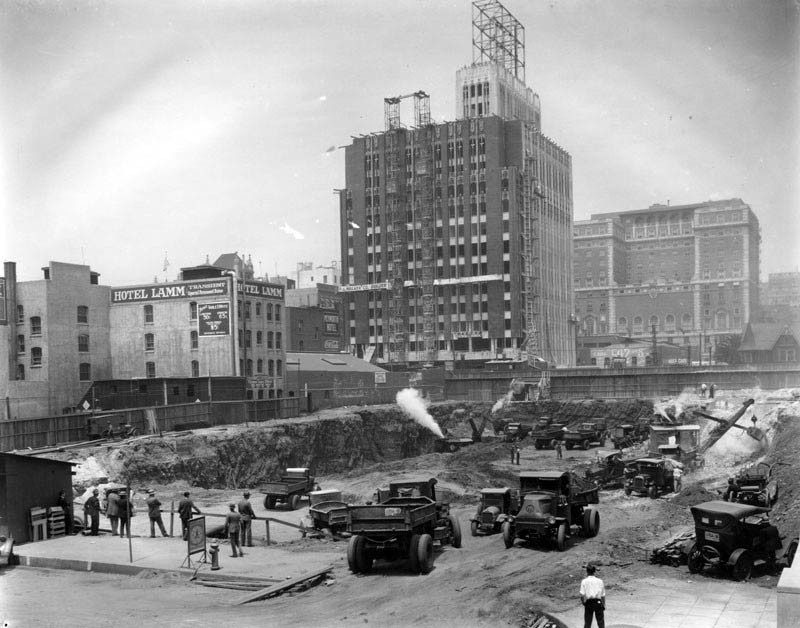 |
|
| (ca. 1929)* - Excavating at the site of the new California Club building at 538 South Flower Street. Across the street at rear is the Richfield Building, behind which is the Jonathan Club. |
Historical Notes In the late 1920s, purchase of land at 538 South Flower Street was negotiated, and in 1929 the present structure was begun. Construction on the current clubhouse at 538 South Flower Street, Los Angeles, California, began in late 1928 and was formally completed on August 25, 1930. The building was designed Robert D. Farquhar, an architect trained at the Ecole Nationale des Beaux Arts in Paris. The American Institute of Architects awarded Farquhar its Distinguished Honor Award for the design of the California Club building.*^ |
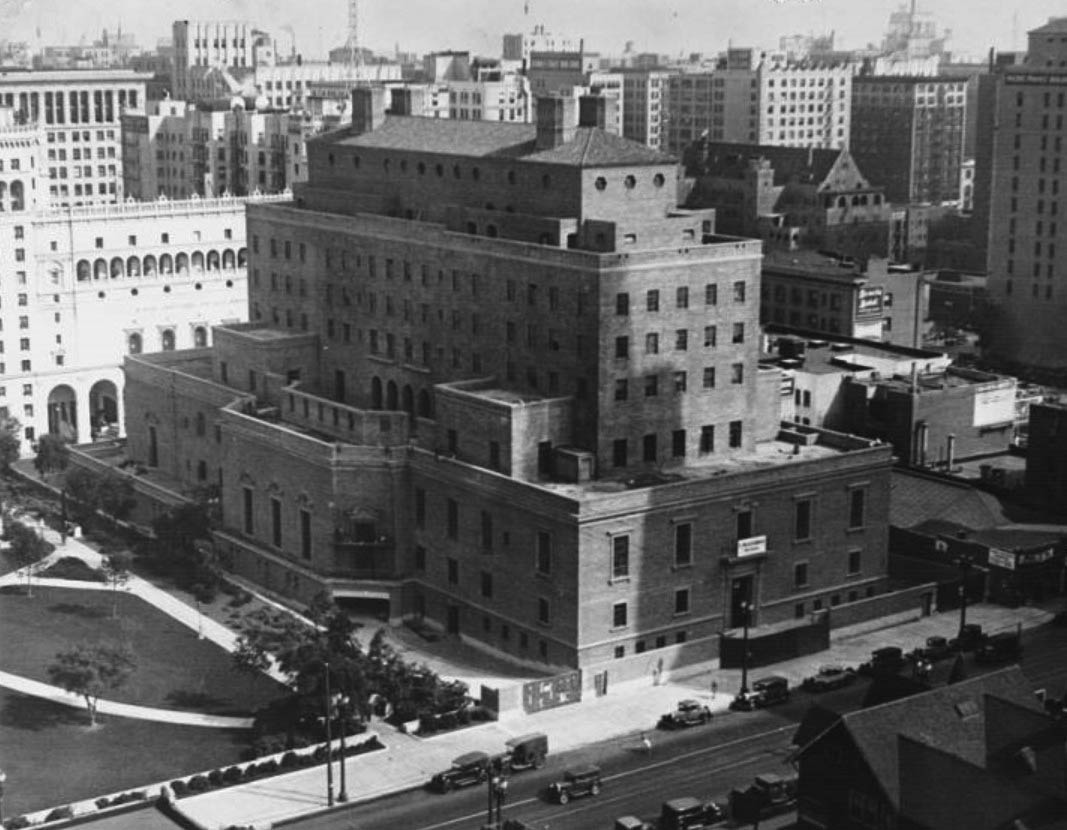 |
|
| (1930)^^ - Close aerial view of the California Club Building shortly after it was completed. |
Historical Notes Examiner clipping attached to verso reads: "Symbol of progress and comfort -- California Club's magnificent new home costing $3,300,000, adjacent to Los Angeles Public Library. It will open to members September 1. The building, with one hundred and eight foot frontage on Hope and on Flower streets, is an artistic addition to the downtown architectural beauty." |
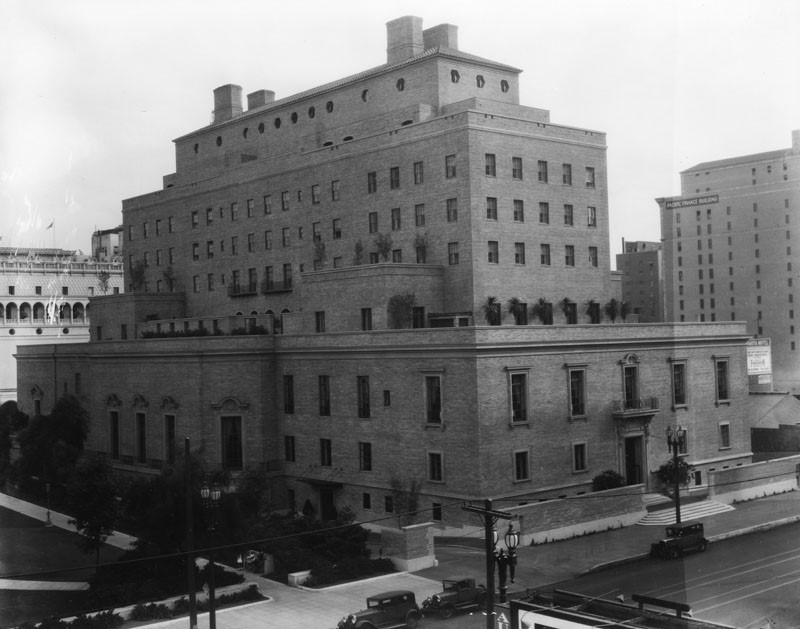 |
|
| (ca. 1930)* - Exterior view of the California Club building at 538 South Flower Street. |
Historical Notes The club's first location was in the second-floor rooms over the Tally-Ho Stables on the northwest corner of First and Fort (Broadway) streets, where the Los Angeles County Law Library now stands. It moved to the Wilcox Building on the southeast corner of Second and Spring streets in 1895, occupying the two top floors, the fourth and fifth. The building was distinguished as the first in Los Angeles to have two elevators — one for the public and the other for members. The men's dining room, reading room, bar and lounge were on the top floor. On the floor below was the ladies' dining room. The club remained at the Wilcox Building for ten years. Increased membership impelled the club to seek a new location in the southward and westward direction of the expansion of the city. In 1904 the club's headquarters were moved to a new five-story building with a basement and a roof garden on the northwest corner of Fifth and Hill streets across from Pershing Square. In 1929 they would outgrow this building as well. Click HERE to see California Club's headquarters between 1904 and 1930. In 1930, the California Club moved into its new building (still used today) located at 538 S. Flower Street and has been*^ |
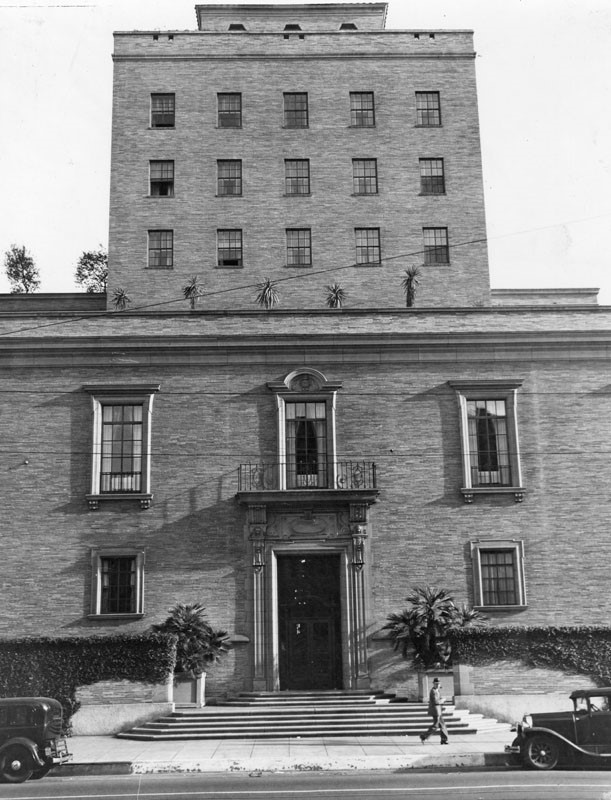 |
|
| (1938)* - Entrance to the California Club building at 538 South Flower Street on January 26, 1938. |
Historical Notes In addition to fine antiques and handcrafted furniture, the clubhouse is decorated with a collection of Western-themed, plein air paintings by such American landscape painters as J. Bond Francisco, Elmer Wachtel, Franz A. Bischoff, George Kennedy Brandriff, William Wendt and Paul Lauritz.*^ |
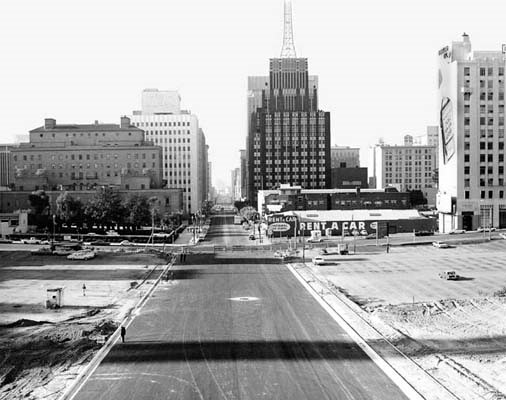 |
|
| (1968)* - View looking south on Flower Street toward 5th Street. The California Club stands on the left. The Richfield Building can be seen (the tallest, in the center). Empty parking lots are in the foreground. |
Historical Notes Beginning in the 1920s, blacks, Jews and women were barred from membership. Finally in 1987 the city of Los Angeles made discriminatory clubs illegal. Some members of the California Club then sought to maintain discriminatory membership policies, but their efforts were defeated by a majority of the members. Indeed, in the vote taken in June 1987, 90 percent of the voting members favored admitting women.*^ |
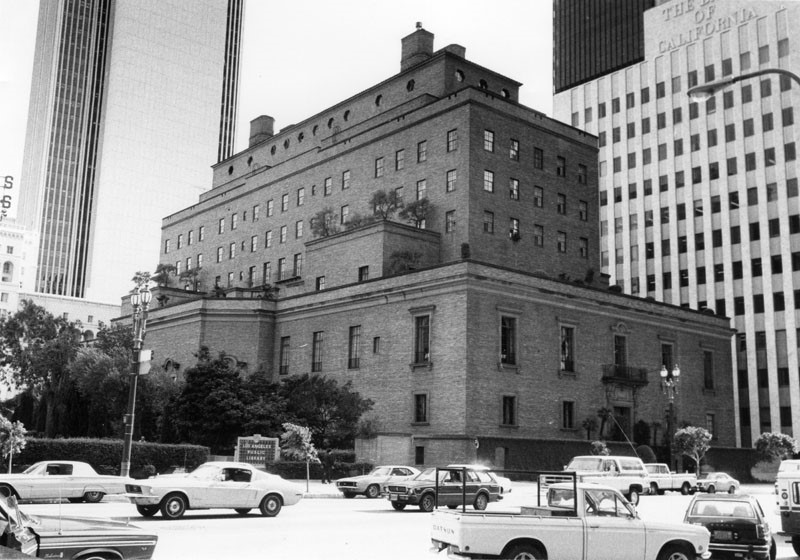 |
|
| (1977)* - Exterior view of the California Club building at 538 South Flower Street showing a busy stream of traffic in front. |
Historical Notes The California Club Building was designated LA Historic-Cultural Monument No. 43 in 1966 (Click HERE for listing). The building was also listed on the U.S. National Register of Historic Places in 2010.*^ |
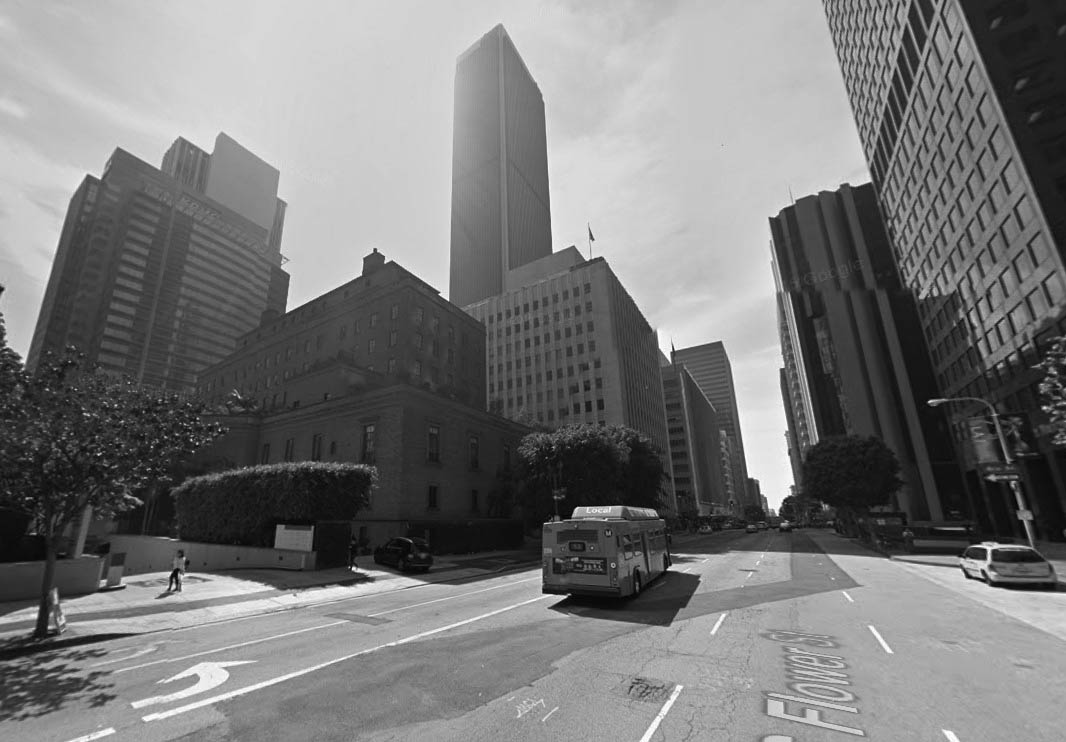 |
|
| (2015)^ - Google street view looking southeast on Flower Street showing the California Club Building as it appears today. |
Click HERE to see California Club's headquarters between 1904 and 1930, located at 5th and Hill. |
* * * * * |
Engstrum Hotel Apartments
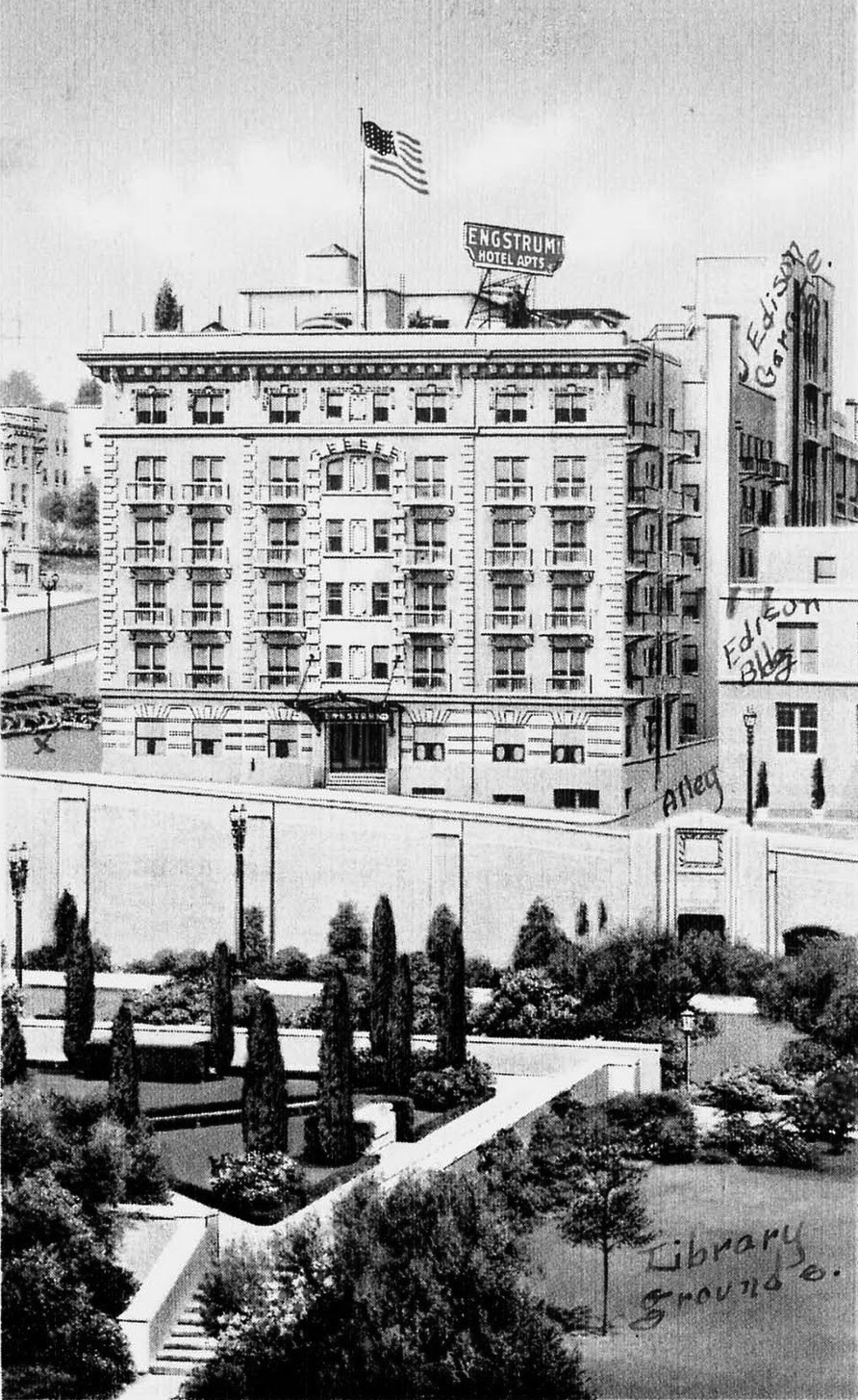 |
|
| (1930s)^ – Postcard view looking north showing the Engstrum Hotel Apartments located at 623 W. 5th Street as seen from the Central Library. Part of the Edison Building is seen on the right. To the left of the Engstrum is a parking lot and then Hope Street which dead ends high above 5th Street. |
Historical Notes Owner Fred E. Engstrum built the 220-room, six-story Engstrum Hotel at 623 Fifth Street. Its dedication in 1914 was reported as an evening of continual music and dancing without intermission. Residents of the hotel included film stars Charlie Chaplin and Rudolph Valentino. |
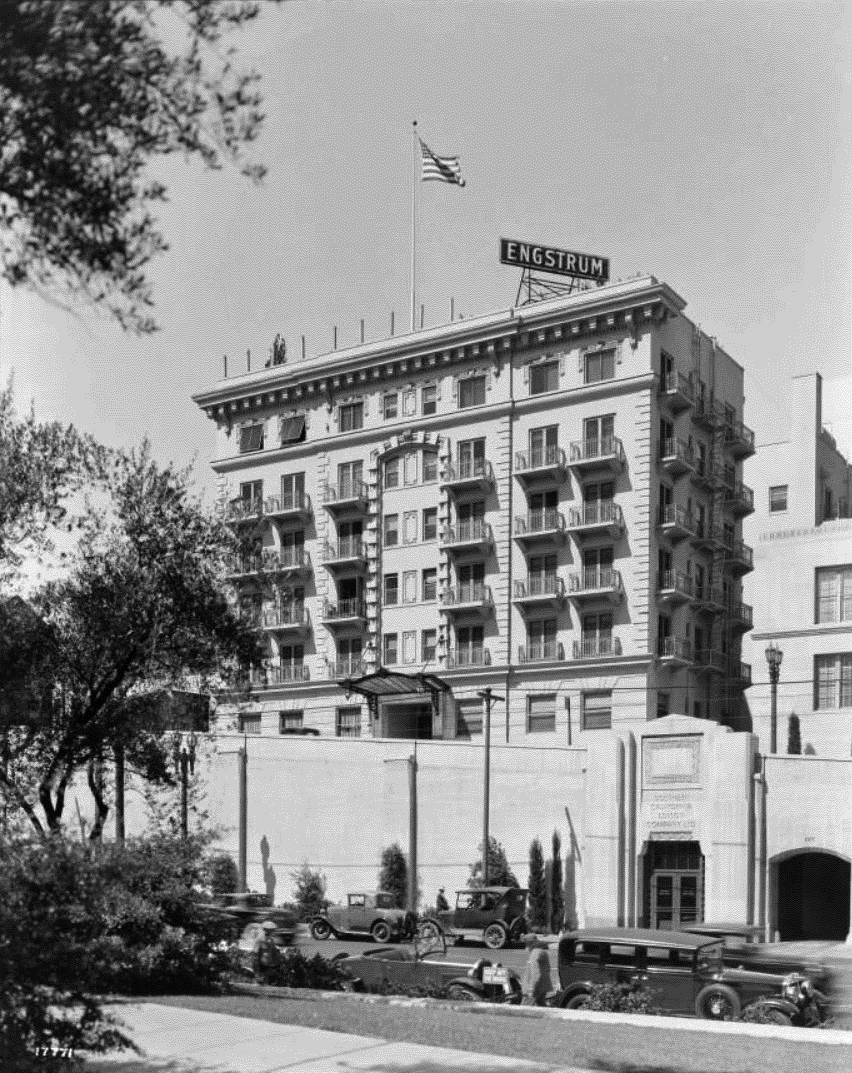 |
|
| (ca. 1932)^^ – Ground view of the Engstrum Hotel Apartments with cars seen parked in on both side of 5th Street. |
Historical Notes Franz Otto Engstrum was born in Stockholm, Sweden on January 4, 1848, the son of a builder. After completing his education, he worked in the stone-cutting business. Engstrum moved to the United States in 1871, living for a short time in New York and Louisiana before relocating to Houston, Texas. There he set up his construction business and was responsible for the completion of many large buildings in both Houston and Fort Worth, including the J. H. Brown warehouse and the First National Bank. In 1886, he moved to San Diego with his wife Elizabeth C. Engstrum They subsequently moved to Escondido where Mr. Engstrum constructed a number of residences, churches, schools, and commercial buildings. Mr. Engstrum moved to Los Angeles in 1892, where he set up a business office downtown. The F. O. Engstrum Company, incorporated in 1904, had up to two hundred employees, all “skilled and independent workmen.” Although it first specialized in large carpentry projects, the Engstrum company soon became well-known as one of the most prominent general building-contracting firms west of Chicago, specializing in reinforced-concrete construction of large institutional and commercial buildings. (The firm was said to have built the first cast-in-place concrete structure.) These included the Court Houses in Riverside and Ventura, the Security National and Citizens National Banks on Spring Street in Los Angeles, the Los Angeles Polytechnic High School, the County and California Hospitals, Fire Station No. 23, the seven-story Elks Hall, the Ocean Park Bathhouse, the Agnews State Hospital, and Tower Hall at what is now San Jose State University.* |
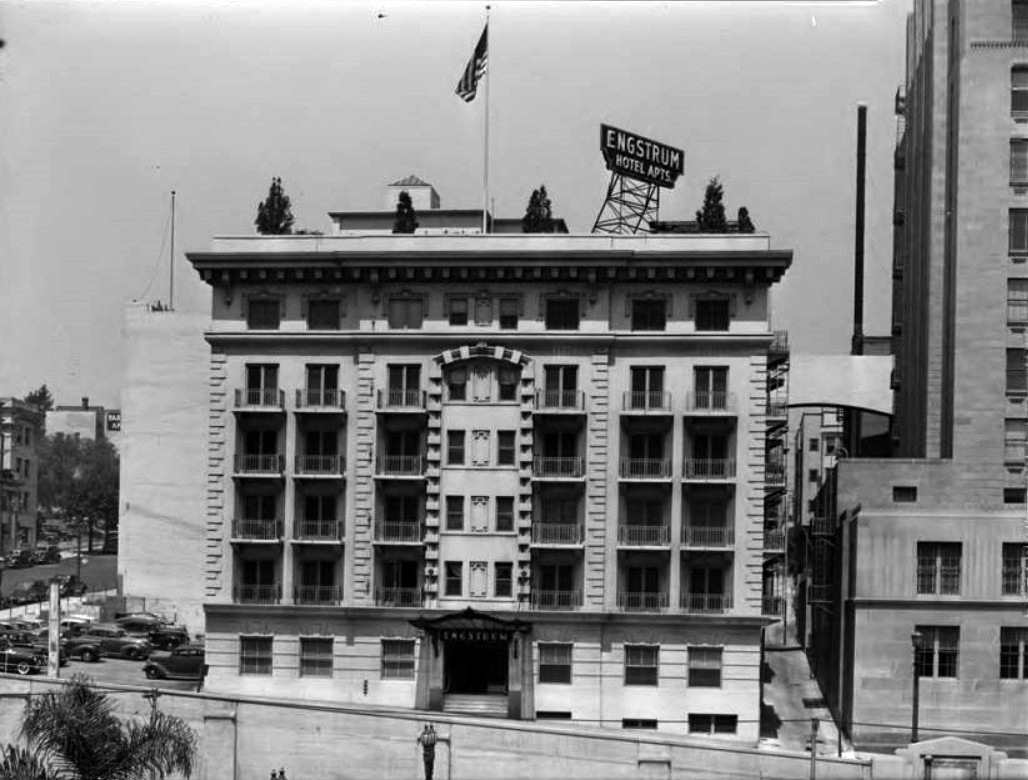 |
|
| (Closer view of the Engstrum Hotel Apartments from the Central Library grounds. Note the bridge connecting the Edison Building (on the right) to a garage building directly behind the Engstrum. |
Historical Notes Engstrum also built large multi-unit residential buildings, such as the Engstrum (seen above), Rampart, and Bryson Apartments and the 750-room Rosslyn Hotel in Los Angeles. The Rex Arms at 945 Orange Street was declared “the finest apartment house built in Los Angeles up to that time.” The firm also was said to have built all the concrete bridges from Los Angeles to Pomona for the Salt Lake Railroad, installed the street-lighting system in Newport Beach, and constructed numerous other buildings in Monrovia, Colton, San Diego, El Paso, and Oxnard (where the Engstrum family owned land). ### |
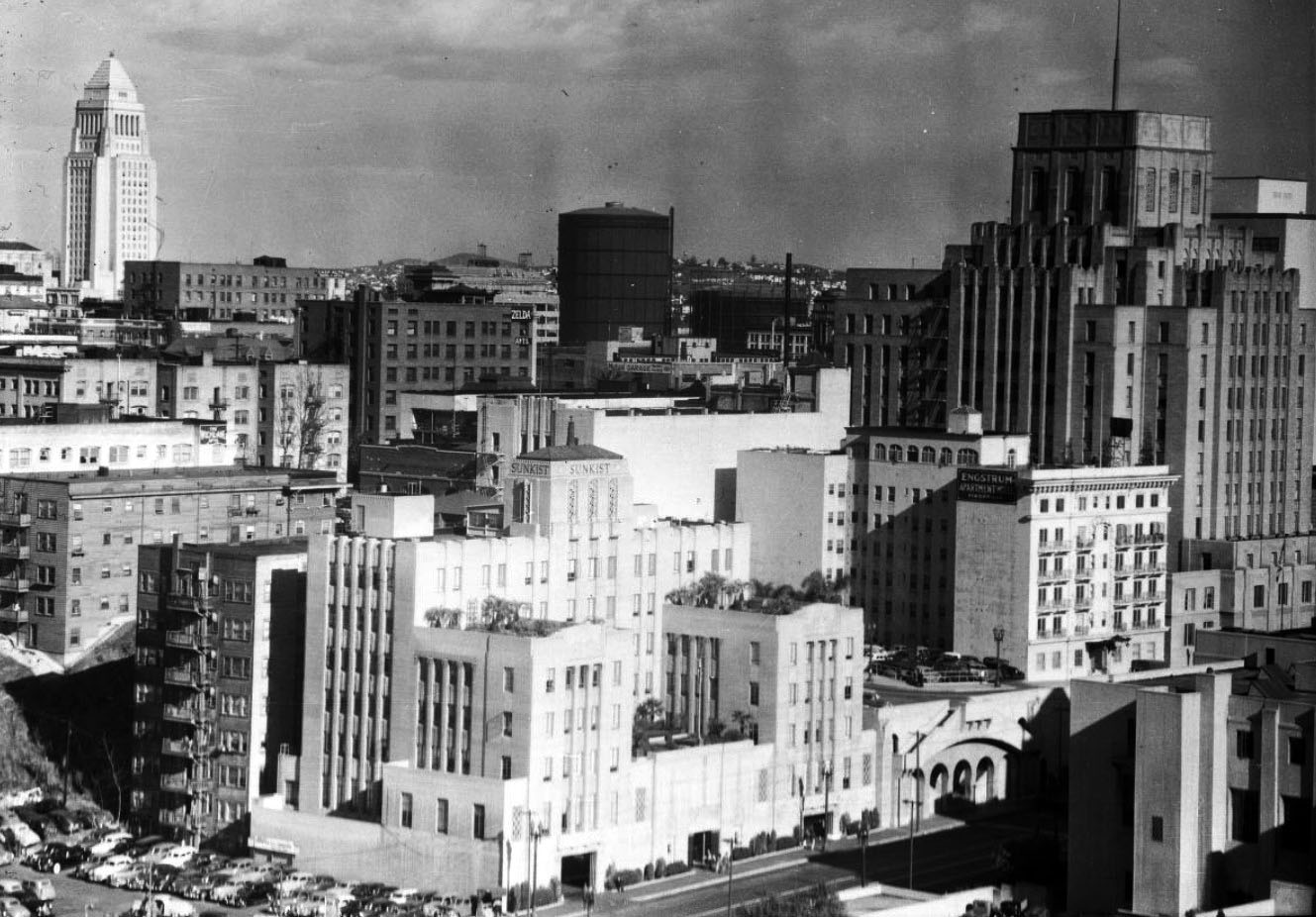 |
|
| (ca. 1945)^^ - View looking NE from over the intersection of 5th and Flower streets with part of the Central Library seen at lower right. On the north side of 5th Street can be seen (from l to r): Sunkist Building, Engstrum Apartments and Edison Building. In the distance stands City Hall and a couple of large gas holders (“Gasometers”). Note: Hope Street dead ends above 5th Street, between the Sunkist Building and the Engstrum Apartments. |
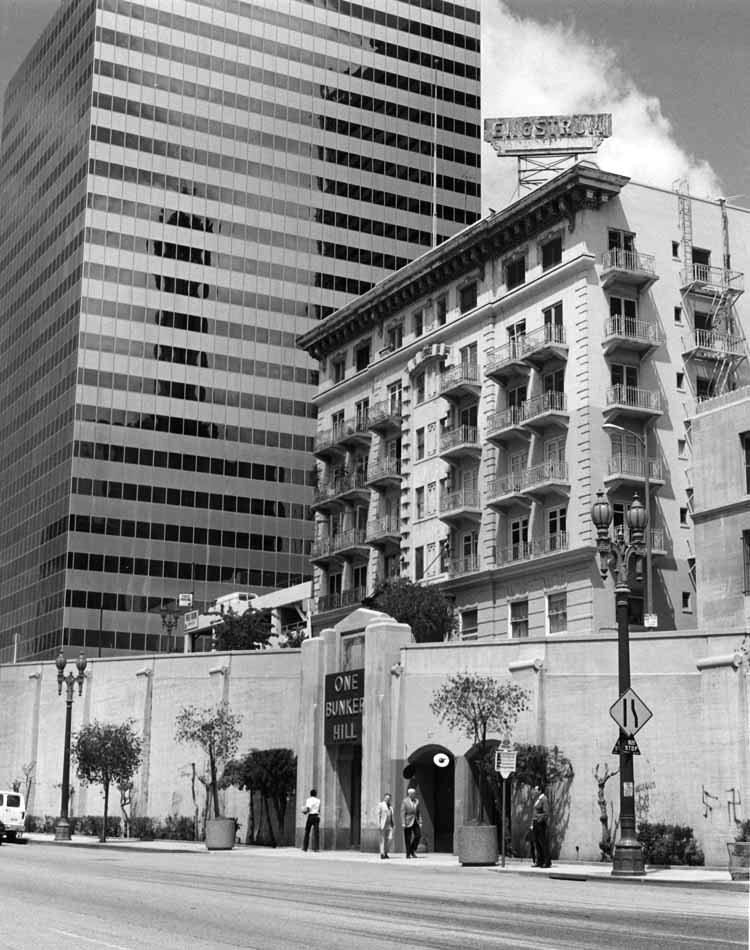 |
|
| (1976)^*# – View looking west on 5th Street showing the Engstrum Hotel Apartments with the Wells Fargo Bank Building in the background (SE corner of 5th and Flower). Sign over the entry way in the foreground reads "One Bunker Hill" which is the name of the old Edison Building to the right and out of view. |
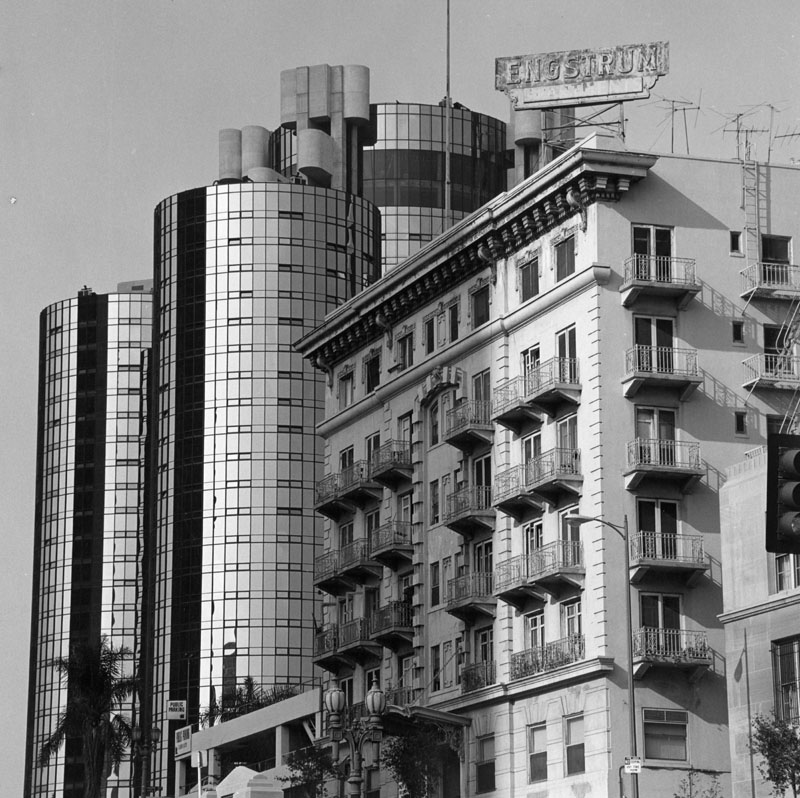 |
|
| (1980)* - The old and the new. The 1976-built Bonaventure Hotel towers above the 1914-built Engstrum Hotel Apartments which will soon be demolished to make way for the 73-story Library Tower (1989). |
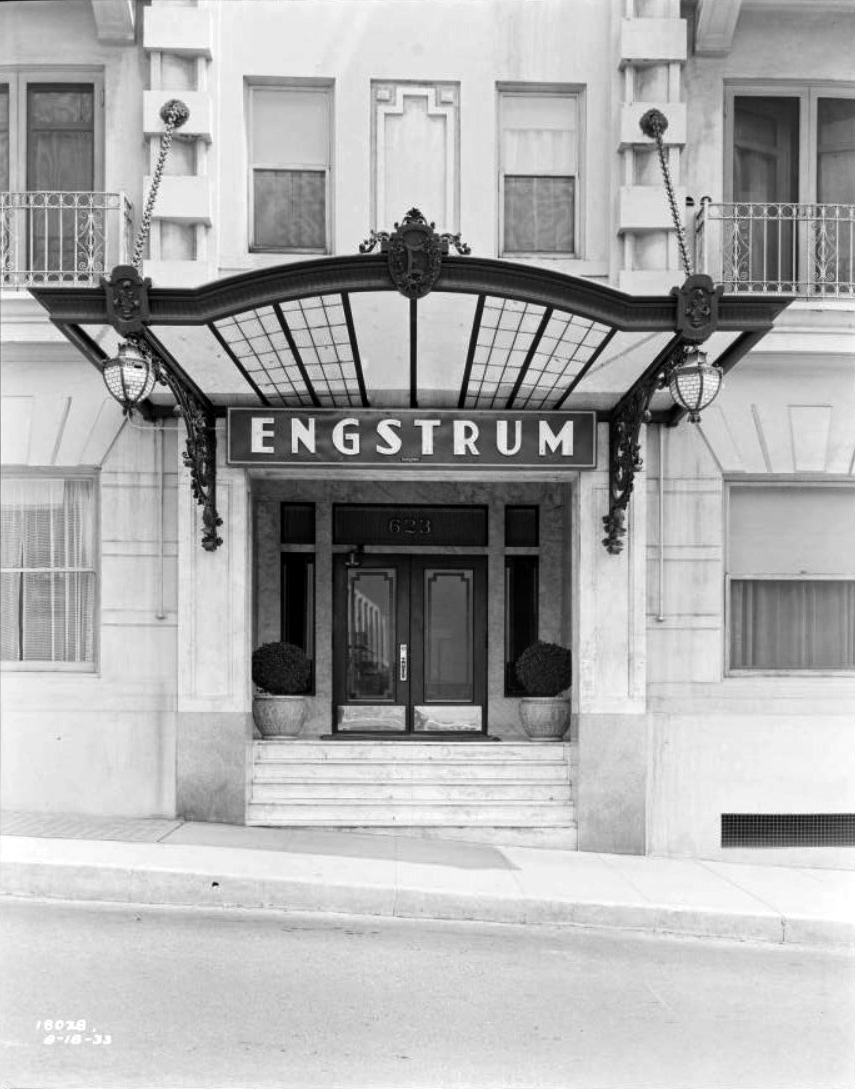 |
|
| (n.d.)^ – Close-up view of the entrance to the Engstrum at 623 W. 5th Street. |
Historical Notes One of the last hotels to be razed as part of the redevelopment project, the Engstrum was replaced by the 73-story Library Tower (1989). |
* * * * * |
Please Support Our CauseWater and Power Associates, Inc. is a non-profit, public service organization dedicated to preserving historical records and photos. Your generosity allows us to continue to disseminate knowledge of the rich and diverse multicultural history of the greater Los Angeles area; to serve as a resource of historical information; and to assist in the preservation of the city's historic records. |
For more Historical Los Angeles Views click one of the following:
For Other Historical Views click one of the following:
See Our Newest Sections:
To see how Water and Electricity shaped the history of Los Angeles click one of the following:
Water:
Power:
* * * * * |
References and Credits
* LA Public Library Image Archive
** DWP - LA Public Library Image Archive
^* Oviatt Library Digital Archives
*# Blogdownton: State Building
^# Online Archive of California: Barlow Library
#* Flickr.com: Michael Ryerson
#^ Historic Hotels of Los Angeles and Hollywood (USC - California Historic Society)
**#UCLA Library Digital Archive
^^#Cinema Treasures: Academy Theatre; Mayan Theatre; Warner Bros.Theatre; Ricardo Montabaln Theater; Belmont Theatre; United Artists Theatre
^**Flicker:: Disney Hall: Jeffrey Bass; Steel and Sky: alanek4; Staples Center: jaubele1
^*#California State Library Image Archive
^#^Los Angeles Conservancy: LA Stock Exchange Building; Downtown Jewelry Exchange/Warner Bros. Theatre; Los Angeles City Hall
*#*Project Restore: Van Nuys City Hall
+#+Facebook.com: Garden of Allah Novels
*^#Historical Los Angeles Theatres: Downtown Theatres; Mayan Theatre; Warner Bros.Theatre
^^*LA Times: Easter at the Hollywood Bowl; Hollywood American Legion Post 43; The Los Angeles Philharmonic Through the Years
*#^historylosangeles.blogspot.com: Ice Skating in Westwood; Hattem's Supermaket
*##LA Weekly - Warner Bros. Theatre; Orpheum Theatre
#*#Everything2.com: Hattem's Market
##^Pinterest.com: Hollywood History
###Artemesia: Frederick E. Engstrum
#^*Facebook.com: Vintage Los Angeles
#**LA Curbed: Fine Arts Building
**^Noirish Los Angeles - forum.skyscraperpage.com
*^^Nuestra Señora la Reina de los Ángeles: losangelespast.com
***Los Angeles Historic - Cultural Monuments Listing
*^*California Historical Landmarks Listing (Los Angeles)
^#*Historic Hotels of Los Angeles and Hollywood (USC - California Historic Society): St. Charles Hotel
^^^The Drive-In, the Supermarket, and the Transformation of Commercial Space in Los Angeles, Richard Longstreth
*^#^Paradiseleased.com: Lighting Up the Coast
*#^*MartinTurnbul.com: Hollywood-Western Building
^*^^Los Angeles Past: Temple and Main Streets, Los Angeles - Then and Now
^*#*Library of Congress Image Archive
^^#* Huntington Digital Library Archive
^^++LA Tourist
^*^#Facebook.com - Bizzare Los Angeles
^##*LAheyday.blogspot.com: American Storage Building
^#**Facebook.com - City of Angels: Hotel Somerville
#*#*Facebook.com - Los Angeles Theatres: Warner Bros. Downtown
***#Pinterest: Art Deco - Sears Building; Vintage L.A. - Mayan Theatre
**^*MTA Transportation and Research Library Archives
#^*^Calisphere: University of California Image Archive
#*^^Hollywood Chamber of Commerce History
#**^Starlinetours.com: TLC Chinese Theatre
#^*#Pinterest.com: Old Hollywood
#^^#The Eastsider: Sparkletts Bottling Plant
#^##Timeout.com: Ricardo Montalban Theatre
##**Martin Turnbull: Mirror Theatre
##*^GlamAmour.com: Orpheum Theatre
##^^Los Angeles Revisited: Engstrum Hotel Apartments
###+Facebook.com: Photos of Los Angeles
##^^^Google Street View
#**^#Historic Hollywood Theatres: Grauman's Chinese Theatre
**^^ Big Orange Landmarks: Los Angeles City Hall; Automobile Club Building; Sinai Temple/Korean Philadelphia Presbyterian Church
*^Wikipedia - Leonis. Adobe; Carthay Circle Theatre; Drive-in Theatres; Staples Center; Dorothy Chandler Pavilion; Hollywood Bowl; Los Angeles City Hall; Los Angeles Central Library; Ralphs; Hollywood Pacific Theatre; Hollywood Pantages Theatre; Pellissier Building and Wiltern Theatre; Adamson House and Adohr; Greek Theatre; Farmers Market; Hollywood Palladium; FOX Theatre, Westwood Village; Union Station; Westwood Village; Brown Derby; Big Boy Restaurant; CBS Television City; Spring Street Financial District; Gaylord Wilshire; Mark Taper Forum; Van de Kamp Bakery Building; Egyptian Theatre; Phineas Banning; Safeway Markets; Janss Investment Company; Los Angeles Memorial Sports Arena; University of Southern California; Janss Investment Company; Westwood; Bullocks Wilshire; Terminal Annex; US Courthouse - Los Angeles; Shrine Auditorium; Walt Disney Concert Hall; LA Times Building; Westin Bonaventure Hotel; Wilshire Boulevard Temple; Hermosa Beach; Downtown, Los Angeles; Cinerama Dome; Broadway Theatre District - Los Angeles; S. Charles Lee; Los Angeles County Art Museum; Mayan Theatre; Sears, Roebuck & Company Mail Order Building; Tower Theater; Holmby Hall; USC School of Law; International Savings & Exchange Bank Building; Fine Arts Building; International Savings & Exchange Bank Building; Maddux Air Lines; See's Candies; Janss Dome; Grauman's Chinese Theatre; Hollywood Playhouse (Avalon Hollywood); Lux Radio Theatre; American Legion; Bank of Italy; Security Pacific Bank
< Back
Menu
- Home
- Mission
- Museum
- Major Efforts
- Recent Newsletters
- Historical Op Ed Pieces
- Board Officers and Directors
- Mulholland/McCarthy Service Awards
- Positions on Owens Valley and the City of Los Angeles Issues
- Legislative Positions on
Water Issues
- Legislative Positions on
Energy Issues
- Membership
- Contact Us
- Search Index